Acer Aspire 7315, 7715Z Series Sevice Guide. Www.s Manuals.com. Service Guide
User Manual: Notebook Acer Aspire 7715Z - Service manuals and Schematics, Disassembly / Assembly. Free.
Open the PDF directly: View PDF ![]() .
.
Page Count: 200 [warning: Documents this large are best viewed by clicking the View PDF Link!]
- System Specifications
- System Utilities
- Machine Disassembly and Replacement
- Disassembly Requirements
- External Module Disassembly Process
- Main Unit Disassembly Process
- Main Unit Disassembly Flowchart
- Removing the Switch Cover
- Removing the Keyboard
- Removing the LCD Module
- Removing the Upper Cover
- Removing the Power Board
- Removing the Left Speaker Module
- Removing the Right Speaker Module
- Removing the TouchPad Bracket
- Removing the Mainboard
- Removing the RTC Battery
- Removing the Thermal Module
- Removing the CPU Fan
- Removing the CPU
- LCD Module Disassembly Process
- LCD Module Reassembly Procedure
- Main Module Reassembly Procedure
- Replacing the CPU
- Replacing the CPU Fan
- Replacing the Thermal Module
- Replacing the Mainboard
- Replacing the TouchPad Bracket
- Replacing the Right Speaker Module
- Replacing the Left Speaker Module
- Replacing the Power Board
- Replacing the Upper Cover
- Replacing the LCD Module
- Replacing the Keyboard
- Replacing the Switch Cover
- Replacing the Hard Disk Drive Module
- Replacing the WLAN Module
- Replacing the DIMM Modules
- Replacing the ODD Module
- Replacing the Lower Covers
- Replacing the SD Dummy Card
- Replacing the Battery
- Troubleshooting
- Jumper and Connector Locations
- FRU (Field Replaceable Unit) List
- Model Definition and Configuration
- Test Compatible Components
- Online Support Information
- Index

Aspire 7715Z/7315 Series
Service Guide
PRINTED IN TAIWAN
Service guide files and updates are available
on the ACER/CSD web; for more information,
please refer to http://csd.acer.com.tw

II
Revision History
Please refer to the table below for the updates made on Aspire 7715Z/7315 service guides.
Date Chapter Updates

III
Copyright
Copyright © 2009 by Acer Incorporated. All rights reserved. No part of this publication may be reproduced,
transmitted, transcribed, stored in a retrieval system, or translated into any language or computer language, in
any form or by any means, electronic, mechanical, magnetic, optical, chemical, manual or otherwise, without
the prior written permission of Acer Incorporated.
Disclaimer
The information in this guide is subject to change without notice.
Acer Incorporated makes no representations or warranties, either expressed or implied, with respect to the
contents hereof and specifically disclaims any warranties of merchantability or fitness for any particular
purpose. Any Acer Incorporated software described in this manual is sold or licensed "as is". Should the
programs prove defective following their purchase, the buyer (and not Acer Incorporated, its distributor, or its
dealer) assumes the entire cost of all necessary servicing, repair, and any incidental or consequential
damages resulting from any defect in the software.
Acer is a registered trademark of Acer Corporation.
Intel is a registered trademark of Intel Corporation.
Pentium and Pentium II/III are trademarks of Intel Corporation.
Other brand and product names are trademarks and/or registered trademarks of their respective holders.

IV
Conventions
The following conventions are used in this manual:
SCREEN MESSAGES Denotes actual messages that appear
on screen.
NOTE Gives bits and pieces of additional
information related to the current
topic.
WARNING Alerts you to any damage that might
result from doing or not doing specific
actions.
CAUTION Gives precautionary measures to
avoid possible hardware or software
problems.
IMPORTANT Reminds you to do specific actions
relevant to the accomplishment of
procedures.

V
Preface
Before using this information and the product it supports, please read the following general information.
1. This Service Guide provides you with all technical information relating to the BASIC CONFIGURATION
decided for Acer's "global" product offering. To better fit local market requirements and enhance product
competitiveness, your regional office MAY have decided to extend the functionality of a machine (e.g.
add-on card, modem, or extra memory capability). These LOCALIZED FEATURES will NOT be covered
in this generic service guide. In such cases, please contact your regional offices or the responsible
personnel/channel to provide you with further technical details.
2. Please note WHEN ORDERING FRU PARTS, that you should check the most up-to-date information
available on your regional web or channel. If, for whatever reason, a part number change is made, it will
not be noted in the printed Service Guide. For ACER-AUTHORIZED SERVICE PROVIDERS, your Acer
office may have a DIFFERENT part number code to those given in the FRU list of this printed Service
Guide. You MUST use the list provided by your regional Acer office to order FRU parts for repair and
service of customer machines.

VI

VII
Table of Contents
System Specifications 1
Features . . . . . . . . . . . . . . . . . . . . . . . . . . . . . . . . . . . . . . . . . . . . . . . . . . . . . . . . . . . .1
System Block Diagram . . . . . . . . . . . . . . . . . . . . . . . . . . . . . . . . . . . . . . . . . . . . . . . . .3
Your Acer Notebook tour . . . . . . . . . . . . . . . . . . . . . . . . . . . . . . . . . . . . . . . . . . . . . . .4
Front View . . . . . . . . . . . . . . . . . . . . . . . . . . . . . . . . . . . . . . . . . . . . . . . . . . . . . . .4
Closed Front View . . . . . . . . . . . . . . . . . . . . . . . . . . . . . . . . . . . . . . . . . . . . . . . . .5
Rear View . . . . . . . . . . . . . . . . . . . . . . . . . . . . . . . . . . . . . . . . . . . . . . . . . . . . . . .6
Left View . . . . . . . . . . . . . . . . . . . . . . . . . . . . . . . . . . . . . . . . . . . . . . . . . . . . . . . .6
Right View . . . . . . . . . . . . . . . . . . . . . . . . . . . . . . . . . . . . . . . . . . . . . . . . . . . . . . .7
Bottom View . . . . . . . . . . . . . . . . . . . . . . . . . . . . . . . . . . . . . . . . . . . . . . . . . . . . .7
Indicators . . . . . . . . . . . . . . . . . . . . . . . . . . . . . . . . . . . . . . . . . . . . . . . . . . . . . . .8
TouchPad Basics . . . . . . . . . . . . . . . . . . . . . . . . . . . . . . . . . . . . . . . . . . . . . . . . .9
Using the Keyboard . . . . . . . . . . . . . . . . . . . . . . . . . . . . . . . . . . . . . . . . . . . . . . . . . .10
Lock Keys and embedded numeric keypad . . . . . . . . . . . . . . . . . . . . . . . . . . . .10
Windows Keys . . . . . . . . . . . . . . . . . . . . . . . . . . . . . . . . . . . . . . . . . . . . . . . . . .11
Hot Keys . . . . . . . . . . . . . . . . . . . . . . . . . . . . . . . . . . . . . . . . . . . . . . . . . . . . . . .12
Hardware Specifications and Configurations . . . . . . . . . . . . . . . . . . . . . . . . . . . . . . .13
System Utilities 21
BIOS Setup Utility . . . . . . . . . . . . . . . . . . . . . . . . . . . . . . . . . . . . . . . . . . . . . . . . . . . .21
Navigating the BIOS Utility . . . . . . . . . . . . . . . . . . . . . . . . . . . . . . . . . . . . . . . . .21
HM70-MV Intel BIOS . . . . . . . . . . . . . . . . . . . . . . . . . . . . . . . . . . . . . . . . . . . . . . . . .22
Information . . . . . . . . . . . . . . . . . . . . . . . . . . . . . . . . . . . . . . . . . . . . . . . . . . . . .22
Main . . . . . . . . . . . . . . . . . . . . . . . . . . . . . . . . . . . . . . . . . . . . . . . . . . . . . . . . . .23
Advanced . . . . . . . . . . . . . . . . . . . . . . . . . . . . . . . . . . . . . . . . . . . . . . . . . . . . . .24
Security . . . . . . . . . . . . . . . . . . . . . . . . . . . . . . . . . . . . . . . . . . . . . . . . . . . . . . . .26
Power . . . . . . . . . . . . . . . . . . . . . . . . . . . . . . . . . . . . . . . . . . . . . . . . . . . . . . . . .29
Boot . . . . . . . . . . . . . . . . . . . . . . . . . . . . . . . . . . . . . . . . . . . . . . . . . . . . . . . . . . .31
Exit . . . . . . . . . . . . . . . . . . . . . . . . . . . . . . . . . . . . . . . . . . . . . . . . . . . . . . . . . . .32
BIOS Flash Utilities . . . . . . . . . . . . . . . . . . . . . . . . . . . . . . . . . . . . . . . . . . . . . . . . . . .33
DOS Flash Utility . . . . . . . . . . . . . . . . . . . . . . . . . . . . . . . . . . . . . . . . . . . . . . . . .34
WinFlash Utility . . . . . . . . . . . . . . . . . . . . . . . . . . . . . . . . . . . . . . . . . . . . . . . . . .36
Remove HDD/BIOS Password Utilities . . . . . . . . . . . . . . . . . . . . . . . . . . . . . . . . . . . .37
Machine Disassembly and Replacement 43
Disassembly Requirements . . . . . . . . . . . . . . . . . . . . . . . . . . . . . . . . . . . . . . . . . . . .43
Pre-disassembly Instructions . . . . . . . . . . . . . . . . . . . . . . . . . . . . . . . . . . . . . . .44
Disassembly Process . . . . . . . . . . . . . . . . . . . . . . . . . . . . . . . . . . . . . . . . . . . . .44
External Module Disassembly Process . . . . . . . . . . . . . . . . . . . . . . . . . . . . . . . . . . .45
External Modules Disassembly Flowchart . . . . . . . . . . . . . . . . . . . . . . . . . . . . .45
Removing the Battery Pack . . . . . . . . . . . . . . . . . . . . . . . . . . . . . . . . . . . . . . . .46
Removing the SD Dummy Card . . . . . . . . . . . . . . . . . . . . . . . . . . . . . . . . . . . . .47
Removing the Lower Covers . . . . . . . . . . . . . . . . . . . . . . . . . . . . . . . . . . . . . . . .48
Removing the Optical Drive Module . . . . . . . . . . . . . . . . . . . . . . . . . . . . . . . . . .49
Removing the DIMM Modules . . . . . . . . . . . . . . . . . . . . . . . . . . . . . . . . . . . . . . .51
Removing the WLAN Module . . . . . . . . . . . . . . . . . . . . . . . . . . . . . . . . . . . . . . .52
Removing the Hard Disk Drive Module . . . . . . . . . . . . . . . . . . . . . . . . . . . . . . . .54
Main Unit Disassembly Process . . . . . . . . . . . . . . . . . . . . . . . . . . . . . . . . . . . . . . . . .56
Main Unit Disassembly Flowchart . . . . . . . . . . . . . . . . . . . . . . . . . . . . . . . . . . . .56
Removing the Switch Cover . . . . . . . . . . . . . . . . . . . . . . . . . . . . . . . . . . . . . . . .57
Removing the Keyboard . . . . . . . . . . . . . . . . . . . . . . . . . . . . . . . . . . . . . . . . . . .58
Removing the LCD Module . . . . . . . . . . . . . . . . . . . . . . . . . . . . . . . . . . . . . . . . .59
Removing the Upper Cover . . . . . . . . . . . . . . . . . . . . . . . . . . . . . . . . . . . . . . . .63
Removing the Power Board . . . . . . . . . . . . . . . . . . . . . . . . . . . . . . . . . . . . . . . .67

VIII
Table of Contents
Removing the Left Speaker Module . . . . . . . . . . . . . . . . . . . . . . . . . . . . . . . . . .68
Removing the Right Speaker Module . . . . . . . . . . . . . . . . . . . . . . . . . . . . . . . . .70
Removing the TouchPad Bracket . . . . . . . . . . . . . . . . . . . . . . . . . . . . . . . . . . . .72
Removing the Mainboard . . . . . . . . . . . . . . . . . . . . . . . . . . . . . . . . . . . . . . . . . .74
Removing the RTC Battery . . . . . . . . . . . . . . . . . . . . . . . . . . . . . . . . . . . . . . . . .75
Removing the Thermal Module . . . . . . . . . . . . . . . . . . . . . . . . . . . . . . . . . . . . . .76
Removing the CPU Fan . . . . . . . . . . . . . . . . . . . . . . . . . . . . . . . . . . . . . . . . . . .78
Removing the CPU . . . . . . . . . . . . . . . . . . . . . . . . . . . . . . . . . . . . . . . . . . . . . . .80
LCD Module Disassembly Process . . . . . . . . . . . . . . . . . . . . . . . . . . . . . . . . . . . . . .81
LCD Module Disassembly Flowchart . . . . . . . . . . . . . . . . . . . . . . . . . . . . . . . . .81
Removing the LCD Bezel . . . . . . . . . . . . . . . . . . . . . . . . . . . . . . . . . . . . . . . . . .82
Removing the Camera Module . . . . . . . . . . . . . . . . . . . . . . . . . . . . . . . . . . . . . .83
Removing the LCD Panel . . . . . . . . . . . . . . . . . . . . . . . . . . . . . . . . . . . . . . . . . .84
Removing the LCD Brackets and FPC Cable . . . . . . . . . . . . . . . . . . . . . . . . . . .86
Removing the Antennas . . . . . . . . . . . . . . . . . . . . . . . . . . . . . . . . . . . . . . . . . . .88
LCD Module Reassembly Procedure . . . . . . . . . . . . . . . . . . . . . . . . . . . . . . . . . . . . .91
Replacing the Antennas . . . . . . . . . . . . . . . . . . . . . . . . . . . . . . . . . . . . . . . . . . .91
Replacing the LCD Panel . . . . . . . . . . . . . . . . . . . . . . . . . . . . . . . . . . . . . . . . . .94
Replacing the Camera Module . . . . . . . . . . . . . . . . . . . . . . . . . . . . . . . . . . . . . .96
Replacing the LCD Bezel . . . . . . . . . . . . . . . . . . . . . . . . . . . . . . . . . . . . . . . . . .97
Main Module Reassembly Procedure . . . . . . . . . . . . . . . . . . . . . . . . . . . . . . . . . . . . .99
Replacing the CPU . . . . . . . . . . . . . . . . . . . . . . . . . . . . . . . . . . . . . . . . . . . . . . .99
Replacing the CPU Fan . . . . . . . . . . . . . . . . . . . . . . . . . . . . . . . . . . . . . . . . . .100
Replacing the Thermal Module . . . . . . . . . . . . . . . . . . . . . . . . . . . . . . . . . . . . .100
Replacing the Mainboard . . . . . . . . . . . . . . . . . . . . . . . . . . . . . . . . . . . . . . . . .101
Replacing the TouchPad Bracket . . . . . . . . . . . . . . . . . . . . . . . . . . . . . . . . . . .102
Replacing the Right Speaker Module . . . . . . . . . . . . . . . . . . . . . . . . . . . . . . . .104
Replacing the Left Speaker Module . . . . . . . . . . . . . . . . . . . . . . . . . . . . . . . . .105
Replacing the Power Board . . . . . . . . . . . . . . . . . . . . . . . . . . . . . . . . . . . . . . .106
Replacing the Upper Cover . . . . . . . . . . . . . . . . . . . . . . . . . . . . . . . . . . . . . . . .106
Replacing the LCD Module . . . . . . . . . . . . . . . . . . . . . . . . . . . . . . . . . . . . . . . .110
Replacing the Keyboard . . . . . . . . . . . . . . . . . . . . . . . . . . . . . . . . . . . . . . . . . .115
Replacing the Switch Cover . . . . . . . . . . . . . . . . . . . . . . . . . . . . . . . . . . . . . . .116
Replacing the Hard Disk Drive Module . . . . . . . . . . . . . . . . . . . . . . . . . . . . . . .116
Replacing the WLAN Module . . . . . . . . . . . . . . . . . . . . . . . . . . . . . . . . . . . . . .118
Replacing the DIMM Modules . . . . . . . . . . . . . . . . . . . . . . . . . . . . . . . . . . . . . .118
Replacing the ODD Module . . . . . . . . . . . . . . . . . . . . . . . . . . . . . . . . . . . . . . .119
Replacing the Lower Covers . . . . . . . . . . . . . . . . . . . . . . . . . . . . . . . . . . . . . . .119
Replacing the SD Dummy Card . . . . . . . . . . . . . . . . . . . . . . . . . . . . . . . . . . . .120
Replacing the Battery . . . . . . . . . . . . . . . . . . . . . . . . . . . . . . . . . . . . . . . . . . . .121
Troubleshooting 123
Common Problems . . . . . . . . . . . . . . . . . . . . . . . . . . . . . . . . . . . . . . . . . . . . . . . . . .123
Power On Issue . . . . . . . . . . . . . . . . . . . . . . . . . . . . . . . . . . . . . . . . . . . . . . . .124
No Display Issue . . . . . . . . . . . . . . . . . . . . . . . . . . . . . . . . . . . . . . . . . . . . . . . .125
Random Loss of BIOS Settings . . . . . . . . . . . . . . . . . . . . . . . . . . . . . . . . . . . .126
LCD Failure . . . . . . . . . . . . . . . . . . . . . . . . . . . . . . . . . . . . . . . . . . . . . . . . . . . .127
Built-In Keyboard Failure . . . . . . . . . . . . . . . . . . . . . . . . . . . . . . . . . . . . . . . . .127
TouchPad Failure . . . . . . . . . . . . . . . . . . . . . . . . . . . . . . . . . . . . . . . . . . . . . . .128
Internal Speaker Failure . . . . . . . . . . . . . . . . . . . . . . . . . . . . . . . . . . . . . . . . . .128
HDD Not Operating Correctly . . . . . . . . . . . . . . . . . . . . . . . . . . . . . . . . . . . . . .130
ODD Failure . . . . . . . . . . . . . . . . . . . . . . . . . . . . . . . . . . . . . . . . . . . . . . . . . . .131
Wireless Function Failure . . . . . . . . . . . . . . . . . . . . . . . . . . . . . . . . . . . . . . . . .134
Thermal Unit Failure . . . . . . . . . . . . . . . . . . . . . . . . . . . . . . . . . . . . . . . . . . . . .134
External Mouse Failure . . . . . . . . . . . . . . . . . . . . . . . . . . . . . . . . . . . . . . . . . . .135

IX
Table of Contents
Other Failures . . . . . . . . . . . . . . . . . . . . . . . . . . . . . . . . . . . . . . . . . . . . . . . . . .135
Intermittent Problems . . . . . . . . . . . . . . . . . . . . . . . . . . . . . . . . . . . . . . . . . . . . . . . .136
Undetermined Problems . . . . . . . . . . . . . . . . . . . . . . . . . . . . . . . . . . . . . . . . . . . . . .136
Post Codes . . . . . . . . . . . . . . . . . . . . . . . . . . . . . . . . . . . . . . . . . . . . . . . . . . . . . . . .137
Sec: . . . . . . . . . . . . . . . . . . . . . . . . . . . . . . . . . . . . . . . . . . . . . . . . . . . . . . . . . .137
Memory: . . . . . . . . . . . . . . . . . . . . . . . . . . . . . . . . . . . . . . . . . . . . . . . . . . . . . .137
BDS & Specific action: . . . . . . . . . . . . . . . . . . . . . . . . . . . . . . . . . . . . . . . . . . .138
Each PEIM entry point used in 80_PORT . . . . . . . . . . . . . . . . . . . . . . . . . . . . .140
Each Driver entry point used in 80_PORT . . . . . . . . . . . . . . . . . . . . . . . . . . . .140
Each SmmDriver entry point used in 80_PORT . . . . . . . . . . . . . . . . . . . . . . . .144
Jumper and Connector Locations 145
Top View . . . . . . . . . . . . . . . . . . . . . . . . . . . . . . . . . . . . . . . . . . . . . . . . . . . . . .145
Bottom View . . . . . . . . . . . . . . . . . . . . . . . . . . . . . . . . . . . . . . . . . . . . . . . . . . .146
Power Board . . . . . . . . . . . . . . . . . . . . . . . . . . . . . . . . . . . . . . . . . . . . . . . . . . .147
LS-4852P ODD Board . . . . . . . . . . . . . . . . . . . . . . . . . . . . . . . . . . . . . . . . . . .147
LS-4853P Battery Board . . . . . . . . . . . . . . . . . . . . . . . . . . . . . . . . . . . . . . . . . .148
LS-4854P Lid Board . . . . . . . . . . . . . . . . . . . . . . . . . . . . . . . . . . . . . . . . . . . . .148
Clearing Password Check and BIOS Recovery . . . . . . . . . . . . . . . . . . . . . . . . . . . .149
Clearing Password Check . . . . . . . . . . . . . . . . . . . . . . . . . . . . . . . . . . . . . . . . .149
Clear CMOS Jumper . . . . . . . . . . . . . . . . . . . . . . . . . . . . . . . . . . . . . . . . . . . . .149
BIOS Recovery by Crisis Disk . . . . . . . . . . . . . . . . . . . . . . . . . . . . . . . . . . . . .150
FRU (Field Replaceable Unit) List 151
Aspire 7715Z/7315 Exploded Diagrams . . . . . . . . . . . . . . . . . . . . . . . . . . . . . . . . . .152
Main Assembly . . . . . . . . . . . . . . . . . . . . . . . . . . . . . . . . . . . . . . . . . . . . . . . . .152
Base Assembly . . . . . . . . . . . . . . . . . . . . . . . . . . . . . . . . . . . . . . . . . . . . . . . . .153
Rear Assembly . . . . . . . . . . . . . . . . . . . . . . . . . . . . . . . . . . . . . . . . . . . . . . . . .154
Aspire 7715Z/7315 FRU List . . . . . . . . . . . . . . . . . . . . . . . . . . . . . . . . . . . . . . . . . .155
Screw List . . . . . . . . . . . . . . . . . . . . . . . . . . . . . . . . . . . . . . . . . . . . . . . . . . . . . . . . .163
Model Definition and Configuration 164
Aspire 7315 . . . . . . . . . . . . . . . . . . . . . . . . . . . . . . . . . . . . . . . . . . . . . . . . . . . . . . . .165
Aspire 7715Z . . . . . . . . . . . . . . . . . . . . . . . . . . . . . . . . . . . . . . . . . . . . . . . . . . . . . .167
Test Compatible Components 181
Microsoft® Windows® 7 Environment Test . . . . . . . . . . . . . . . . . . . . . . . . . . . . . . .182
Online Support Information 185
Index 187

X
Table of Contents

Chapter 1 1
System Specifications
Features
Below is a brief summary of the computer’s many features:
NOTE: Items denoted with an (*) are only available for selected models.
Operating System
• Genuine Windows® 7™
Platform
• Intel® Pentium® mobile processor*
• Intel® Celeron® mobile processor*
• Mobile Intel® GL40 Express Chipset
System Memory
• Dual-channel support
• Up to 2 GB of DDR2 667 MHz memory, upgradeable to 4 GB using two soDIMM modules*
• Up to 2 GB of DDR3 1066 MHz memory, upgradeable to 4 GB using two soDIMM modules*
Display
• 17" HD+ 1600 x 900
• 16:9 aspect ratio
Graphics
• Mobile Intel® GL40 Express Chipset
Storage subsystem
• 2.5" hard disk drive
• DVD-Super Multi double-layer drive
• Multi-in-1 card reader
Audio
• Two built-in stereo speakers
• High-definition audio support
• MS-Sound compatible
Dimensions and Weight
• 410.5 (W) x 268 (D) x 26.8/39.6 (H) mm (16 x 10.45 x 1.04/1.54 inches)
Chapter 1

2Chapter 1
• 3.30 kg (7.29 lbs.) with one HDD and 6-cell battery pack
Communication
• Integrated Acer Crystal Eye webcam*
•WLAN:
• Acer InviLink™ 802.11b/g/Draft-N*
• Acer InviLink™ 802.11b/g*
• LAN: Fast Ethernet; Wake-on-LAN ready
Privacy control
• BIOS user, supervisor, HDD passwords
• Kensington lock slot
Power subsystem
•ACPI 3.0
• 48.8 W 4400 mAh
• 3-pin 65 W AC adapter
• ENERGY STAR®*
Special keys and controls
• 99-/100-/103-key keyboard
• Touchpad pointing device
I/O interface
• USB 2.0 port
• External display (VGA) port
• Headphones/speaker/line-out jack
• Microphone-in jack
• Ethernet (RJ-45) port
• DC-in jack for AC adapter
Environment
• Temperature:
• Operating: 5 °C to 35 °C
• Non-operating: -20 °C to 65 °C
• Humidity (non-condensing):
• Operating: 20% to 80%
• Non-operating: 20% to 80%
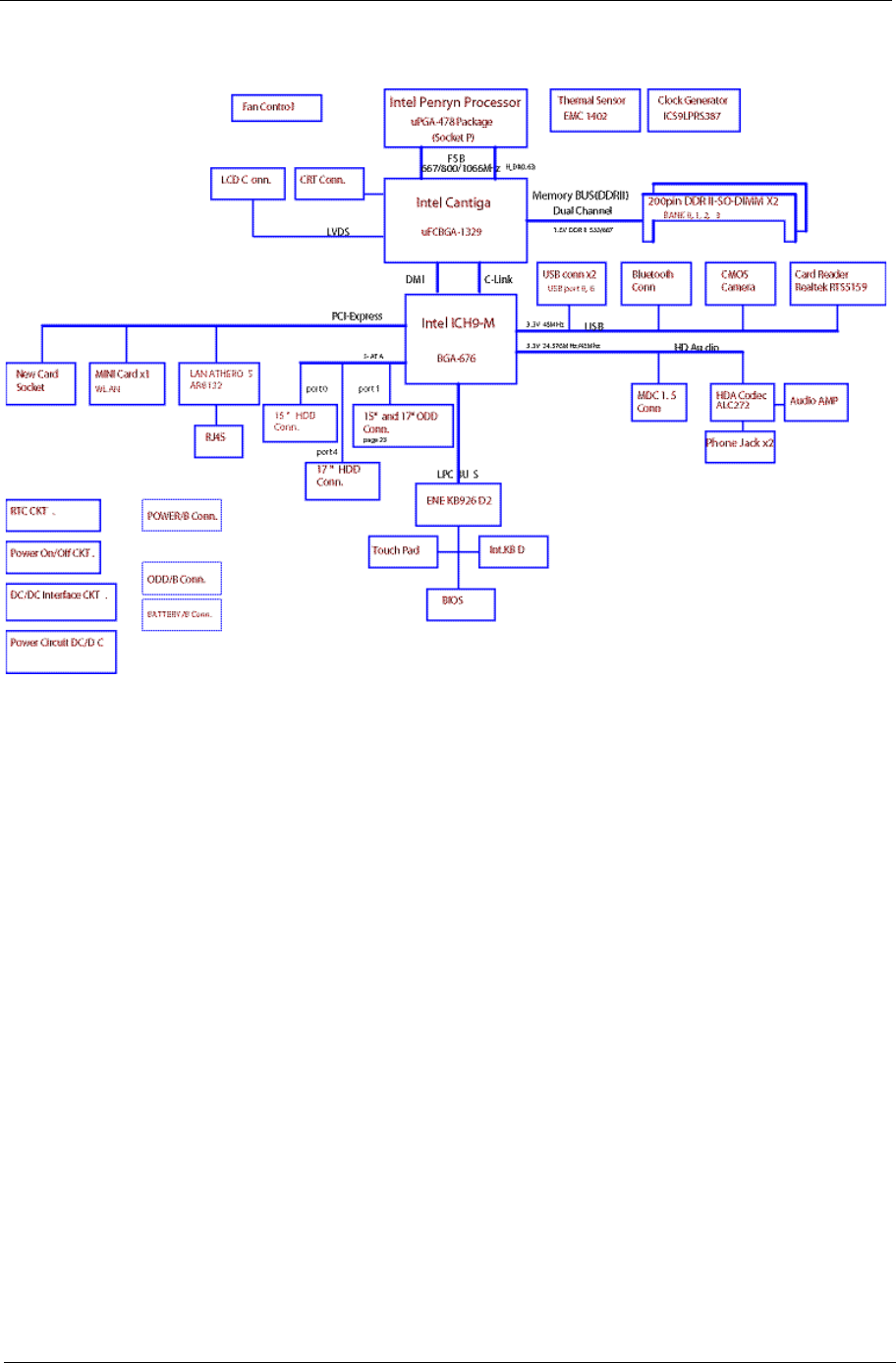
Chapter 1 3
System Block Diagram
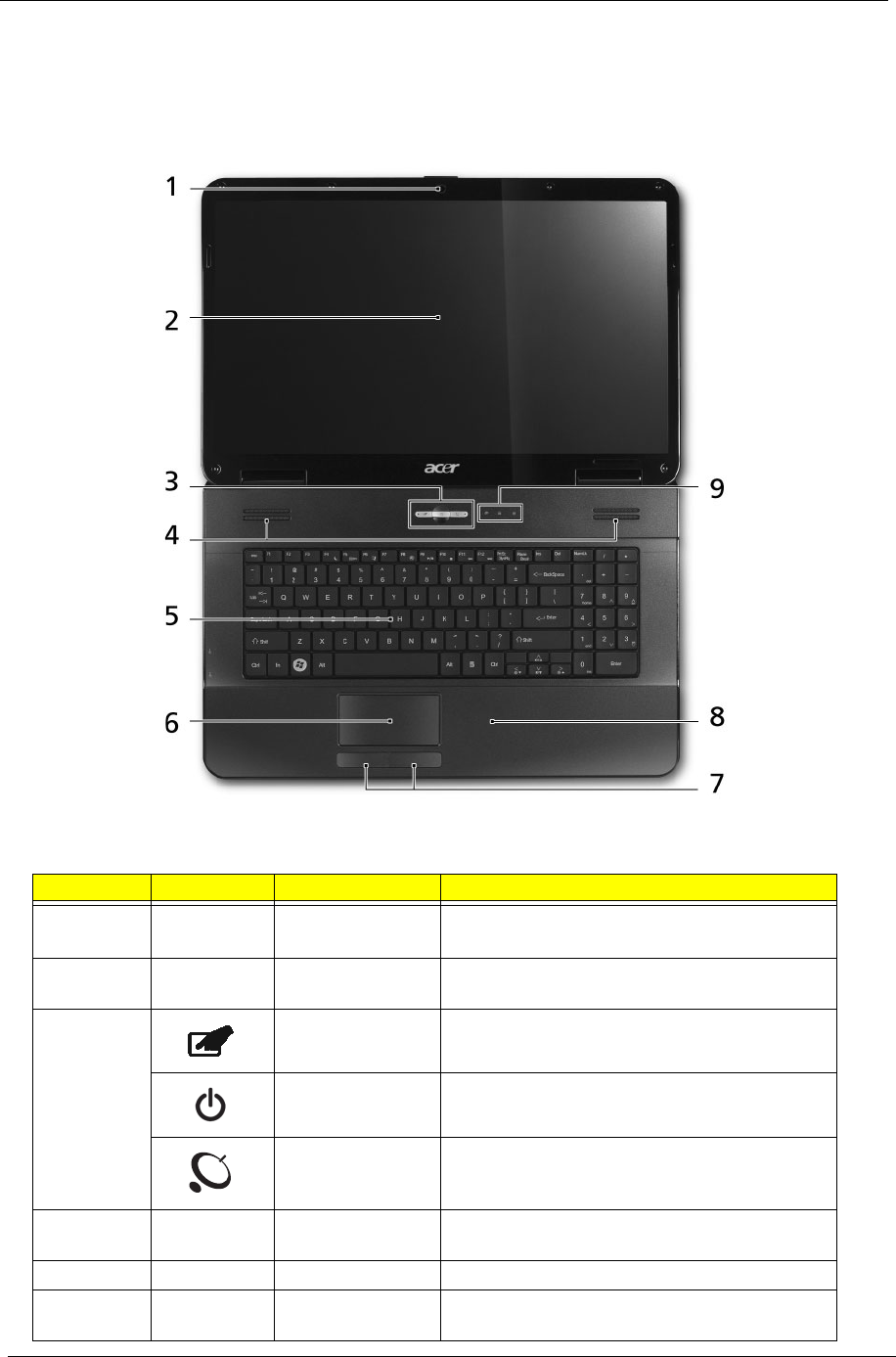
4Chapter 1
Your Acer Notebook tour
Front View
No. Icon Item Description
1 Acer Crystal Eye
webcam
Web camera for video communication
(for selected models).
2 Display screen Also called Liquid-Crystal Display (LCD),
displays computer output.
3 Touchpad toggle Turns the internal touchpad on and off.
Power button Turns the computer on and off.
Wireless LAN
communication
button/indicator
Enables/disables the wireless LAN function.
Indicates the status of wireless LAN
communication.
4 Speakers Left and right speakers deliver stereo audio
output.
5 Keyboard For entering data into your computer.
6 TouchPad Touch-sensitive pointing device which functions
like a computer mouse.
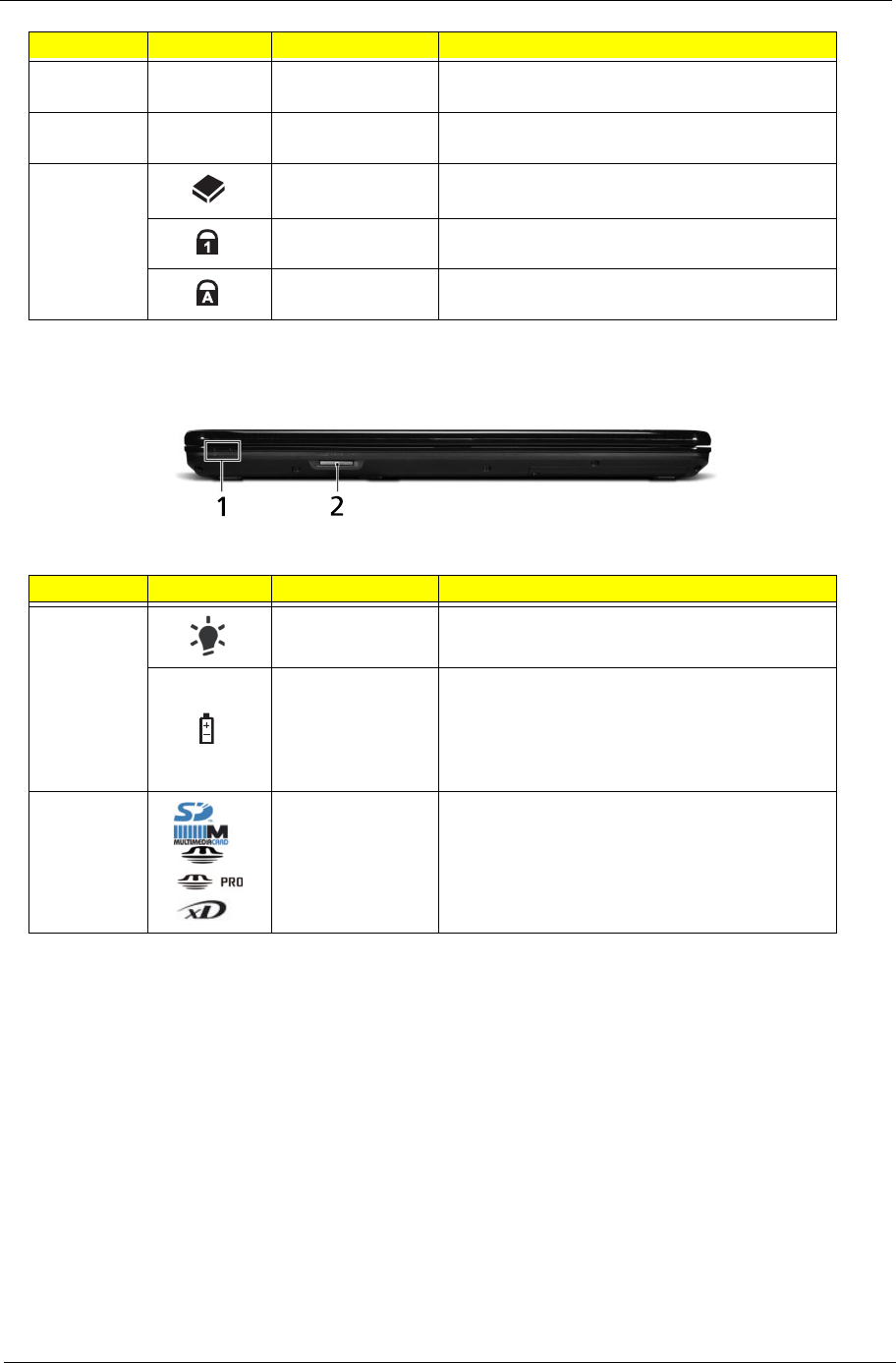
Chapter 1 5
Closed Front View
NOTE: 1 The front panel indicators are visible even when the computer cover is closed
7 Click buttons (left
and right)
The left and right buttons function like the left
and right mouse buttons.
8 Palmrest Comfortable support area for your hands when
you use the computer.
9 HDD Indicates when the hard disk drive is active.
Num Lock Lights up when Num Lock is activated.
Caps Lock Lights up when Caps Lock is activated.
No. Icon Item Description
1Power1Indicates the computer's power status.
Battery1Indicates the computer's battery status.
1. Charging: The light shows amber when the
battery is charging.
2. Fully charged: The light shows green when
in AC mode.
2 5-in-1 card
reader
Accepts Secure Digital (SD), MultiMediaCard
(MMC), Memory Stick (MS), Memory Stick
PRO (MS PRO), xDPicture Card (xD).
NOTE: Push to remove/install the card.
Only one card can operate at any
given time.
No. Icon Item Description
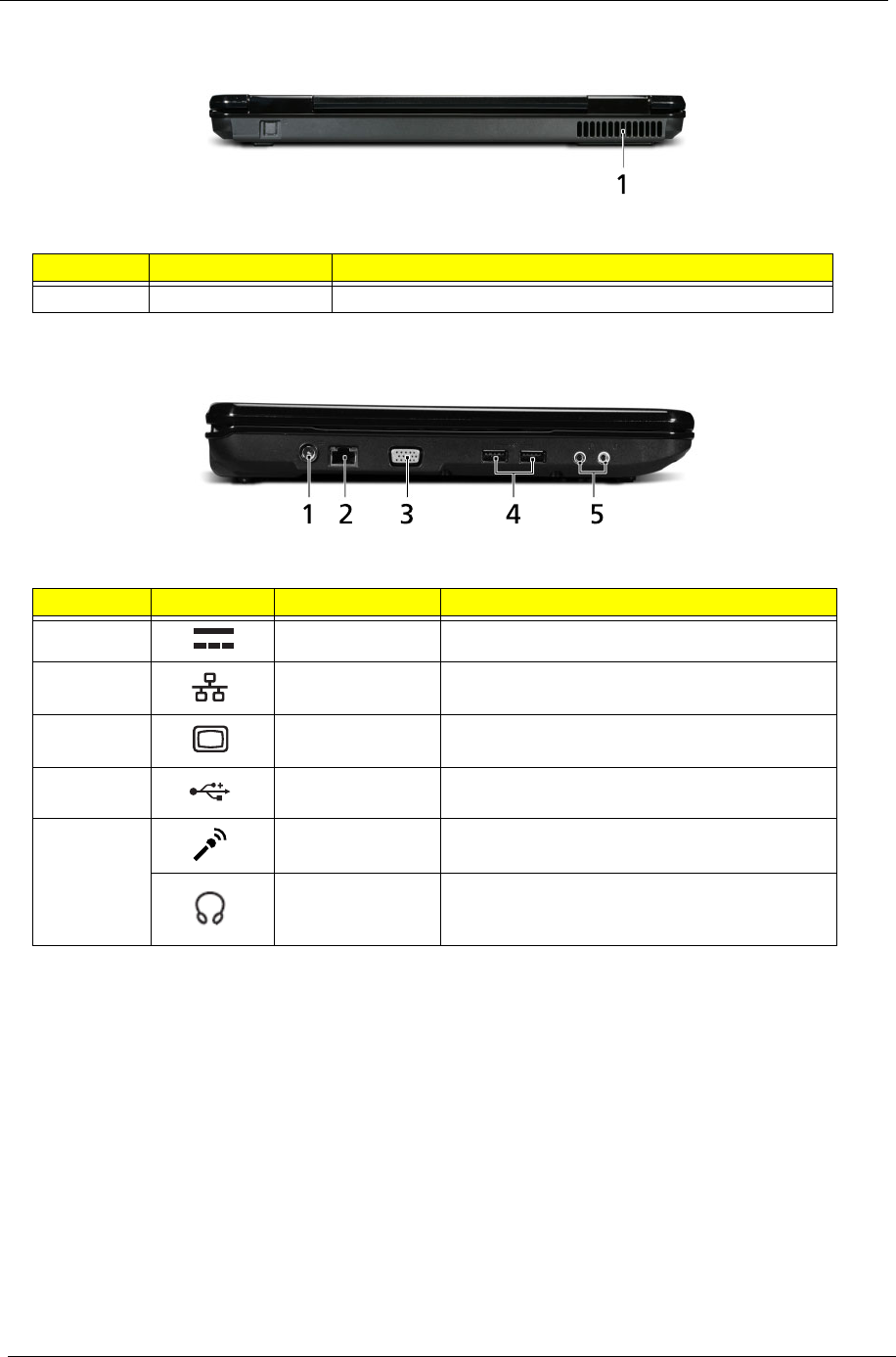
6Chapter 1
Rear View
Left View
No. Item Description
1 Ventilation slots Enable the computer to stay cool, even after prolonged use.
No. Icon Item Description
1 DC-in jack Connects to an AC adapter
2 Ethernet (RJ-45)
port
Connects to an Ethernet 10/100-based
network.
3 External display
(VGA) port
Connects to a display device
(e.g. external monitor, LCD projector).
4 USB 2.0 ports Connect to USB 2.0 devices (e.g. USB mouse,
USB camera).
5 Microphone-in
jack
Accepts input from external microphones.
Headphones/
speaker/line-out
jack
Connects to audio line-out devices
(e.g. speakers, headphones).
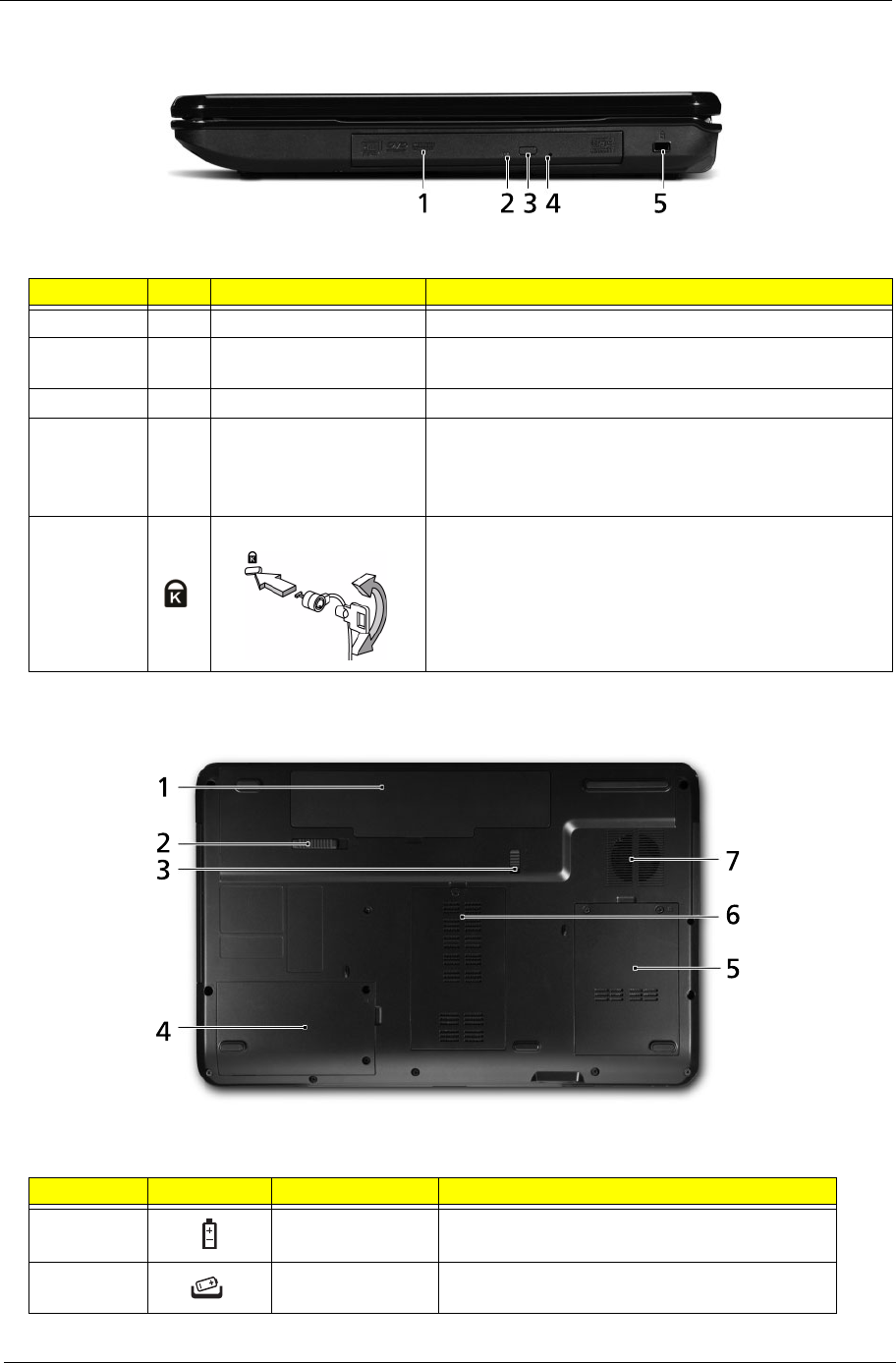
Chapter 1 7
Right View
Bottom View
No. Item Description
1 Optical drive Internal optical drive; accepts CDs or DVDs.
2 Optical disk access
indicator
Lights up when the optical drive is active.
3 Optical drive eject button Ejects the optical disk from the drive.
4 Emergency eject hole Ejects the optical drive tray when the computer is turned
off.
Note: Insert a paper clip into the emergency eject hole to
eject the optical drive tray when the computer is off.
5 Kensington lock slot Connects to a Kensington-compatible computer security
lock.
Note: Wrap the computer security lock cable around an
immovable object such as a table or handle of a locked
drawer. Insert the lock into the notch and turn the key to
secure the lock. Some keyless models are also available.
No. Icon Item Description
1 Battery bay Houses the computer's battery pack.
2 Battery release
latch
Releases the battery for removal.
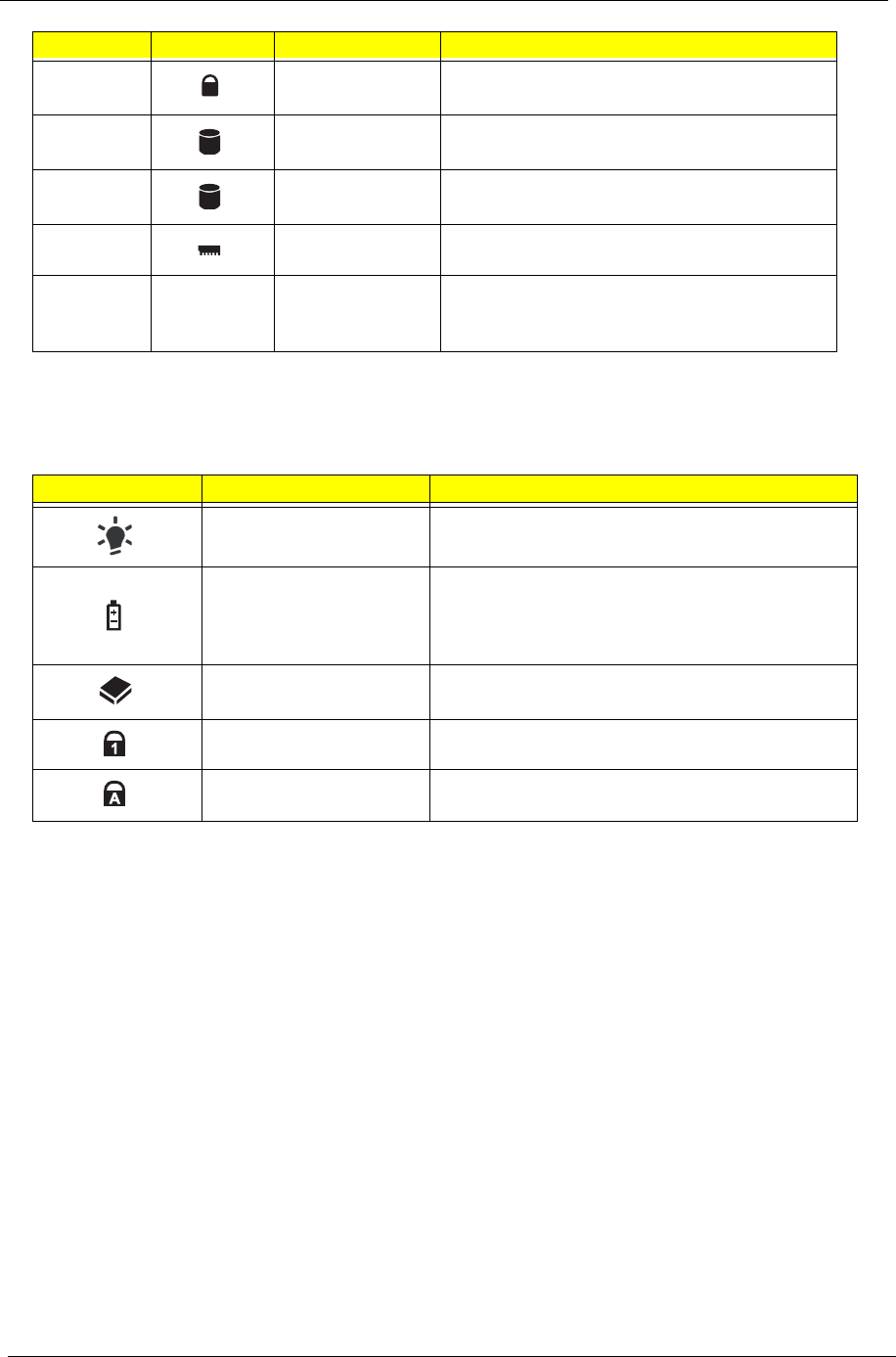
8Chapter 1
Indicators
The computer has several easy-to-read status indicators. The front panel indicators are visible even when the
computer cover is closed.
3 Battery lock Locks the battery in position.
4 Hard disk bay-
Secondary
Houses the computer's hard disk (secured
with screws) (for certain models only).
5 Hard disk bay-
Main
Houses the computer's hard disk (secured
with screws).
6 Memory
compartment
Houses the computer's main memory.
7 Ventilation slots
and cooling fan
Enable the computer to stay cool, even after
prolonged use.
Note: Do not cover or obstruct the fan opening.
Icon Function Description
Power Indicates the computer's power status.
Battery Indicates the computer's battery status.
NOTE: 1. Charging: The light shows amber when
the battery is charging. 2. Fully charged: The light
shows green when in AC mode.
HDD Indicates when the hard disk drive is active.
Num Lock Lights up when Num Lock is activated.
Caps Lock Lights up when Caps Lock is activated.
No. Icon Item Description
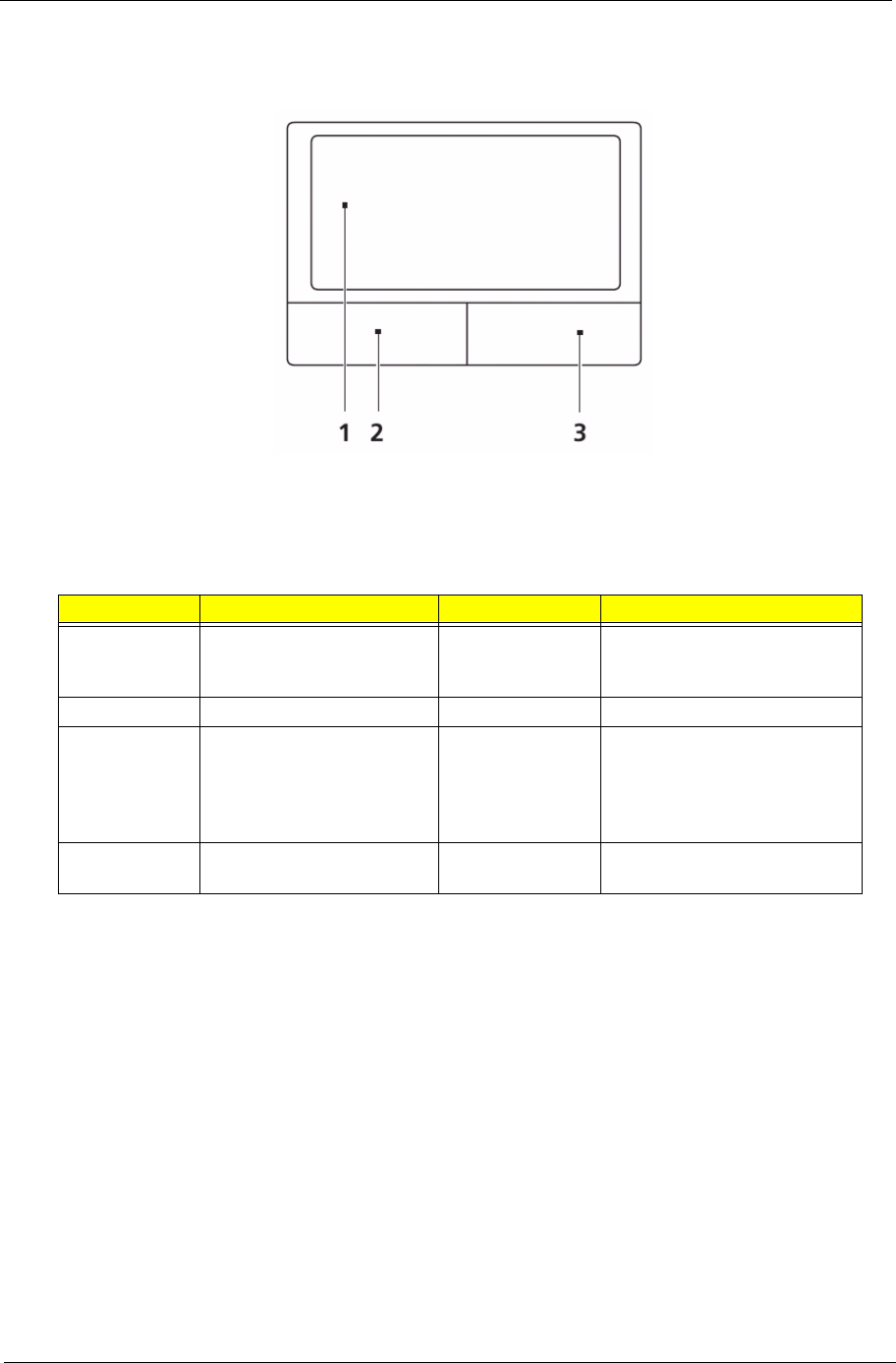
Chapter 1 9
TouchPad Basics
The following items show you how to use the TouchPad:
• Move your finger across the TouchPad (1) to move the cursor.
• Press the left (2) and right (3) buttons located beneath the TouchPad to perform selection and
execution functions. These two buttons are similar to the left and right buttons on a mouse.
Tapping on the TouchPad is the same as clicking the left button.
NOTE: When using the TouchPad, keep it - and your fingers - dry and clean. The TouchPad is sensitive to
finger movement; hence, the lighter the touch, the better the response. Tapping too hard will not
increase the TouchPad’s responsiveness.
Function Left Button (2) Right Button (3) Main TouchPad (1)
Execute Quickly click twice. Tap twice (at the same speed
as double-clicking a mouse
button).
Select Click once. Tap once.
Drag Click and hold, then use
finger on the TouchPad to
drag the cursor.
Tap twice (at the same speed
as double-clicking a mouse
button); rest your finger on
the TouchPad on the second
tap and drag the cursor.
Access
context menu
Click once.
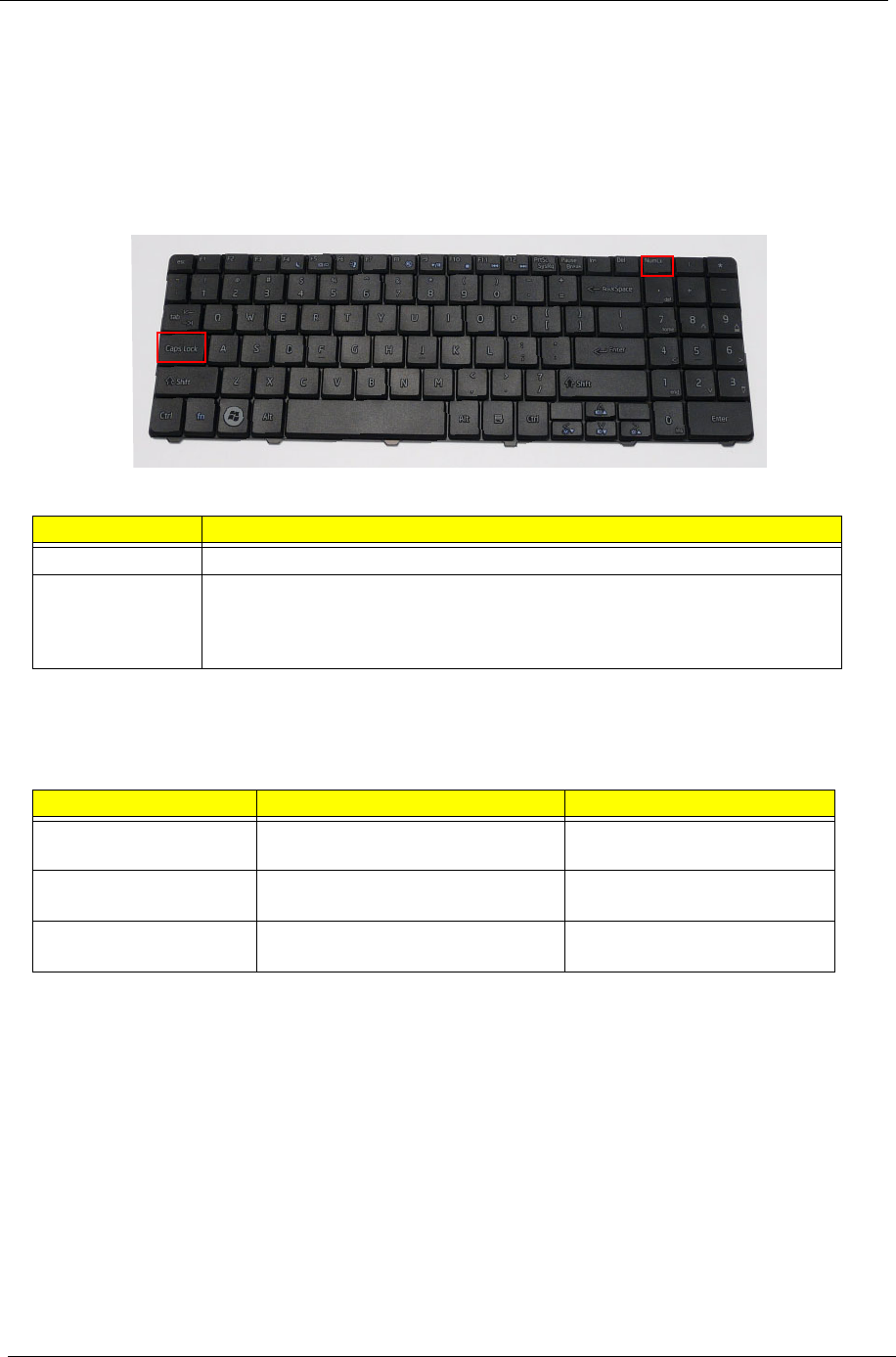
10 Chapter 1
Using the Keyboard
The keyboard has full-sized keys and an embedded numeric keypad, separate cursor, lock, Windows, function
and special keys.
Lock Keys and embedded numeric keypad
The keyboard has three lock keys which you can toggle on and off.
The embedded numeric keypad functions like a desktop numeric keypad. It is indicated by small characters
located on the upper right corner of the keycaps. To simplify the keyboard legend, cursor-control key symbols
are not printed on the keys.
Lock key Description
Caps Lock When Caps Lock is on, all alphabetic characters typed are in uppercase.
Num Lock When Num Lock is on, the embedded keypad is in numeric mode. The keys
function as a calculator (complete with the arithmetic operators +, -, *, and /). Use
this mode when you need to do a lot of numeric data entry. A better solution
would be to connect an external keypad.
Desired access Num Lock on Num Lock off
Number keys on
embedded keypad
Type numbers in a normal manner.
Cursor-control keys on
embedded keypad
Hold <Shift> while using cursor-
control keys.
Hold <Fn> while using cursor-
control keys.
Main keyboard keys Hold <Fn> while typing letters on
embedded keypad.
Type the letters in a normal
manner.
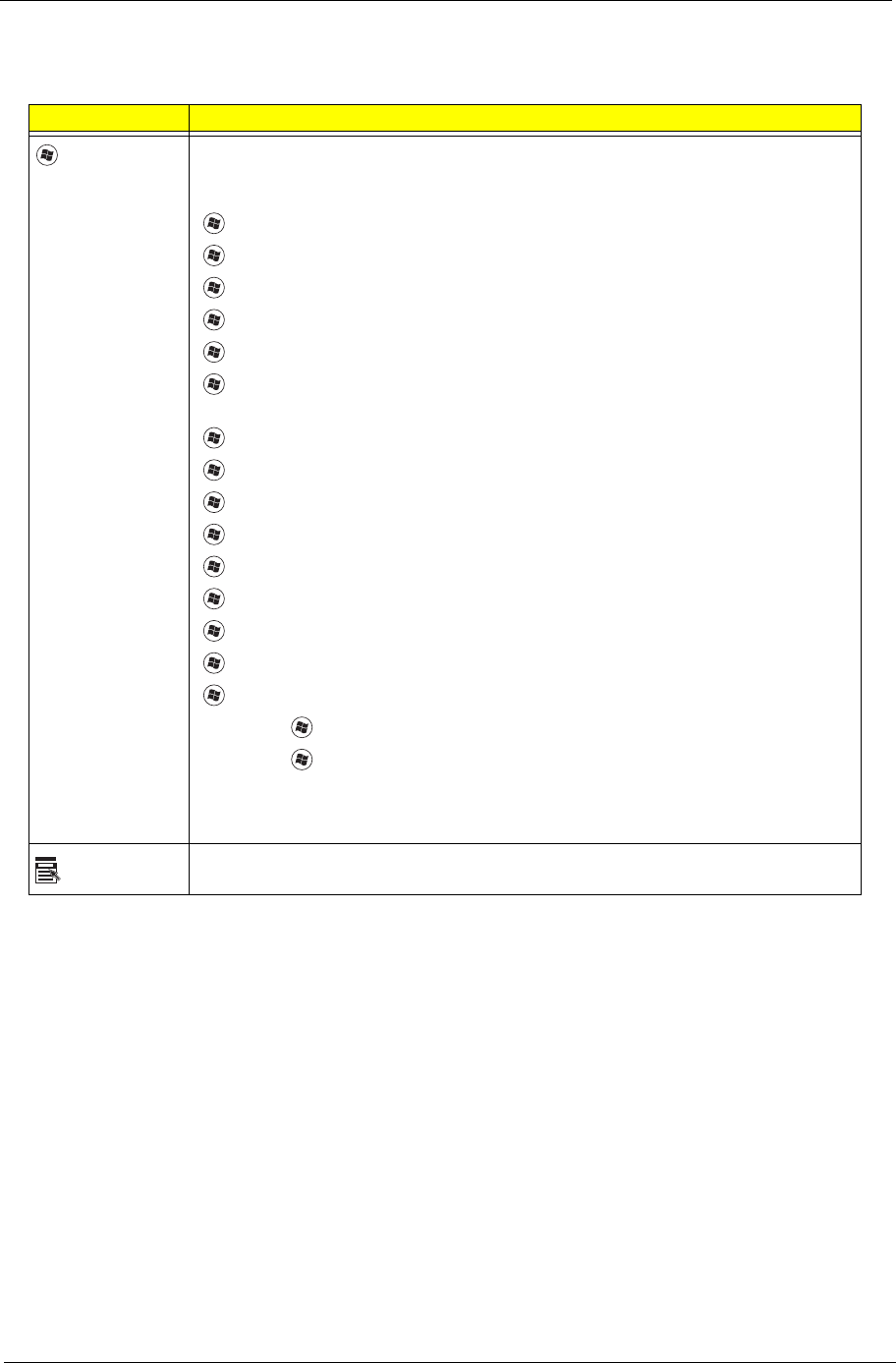
Chapter 1 11
Windows Keys
The keyboard has two keys that perform Windows-specific functions.
Key Description
Windows key Pressed alone, this key has the same effect as clicking on the Windows Start button;
it launches the Start menu. It can also be used with other keys to provide a variety of
functions:
<>: Open or close the Start menu
<> + <D>: Display the desktop
<> + <E>: Open Windows Explore
<> + <F>: Search for a file or folder
<> + <G>: Cycle through Sidebar gadgets
<> + <L>: Lock your computer (if you are connected to a network domain), or
switch users (if you're not connected to a network domain)
<> + <M>: Minimizes all windows
<> + <R>: Open the Run dialog box
<> + <T>: Cycle through programs on the taskbar
<> + <U>: Open Ease of Access Center
<> + <X>: Open Windows Mobility Center
<> + <BREAK>: Display the System Properties dialog box
<> + <SHIFT+M>: Restore minimized windows to the desktop
<> + <TAB>: Cycle through programs on the taskbar by using Windows Flip 3-D
<> + <SPACEBAR>: Bring all gadgets to the front and select Windows Sidebar
<CTRL> + <> + <F>: Search for computers (if you are on a network)
<CTRL> + <> + <TAB>: Use the arrow keys to cycle through programs on the
taskbar by using Windows Flip 3-D
Note: Depending on your edition of Windows 7, some shortcuts may not function as
described.
Application
key
This key has the same effect as clicking the right mouse button; it opens the
application's context menu.
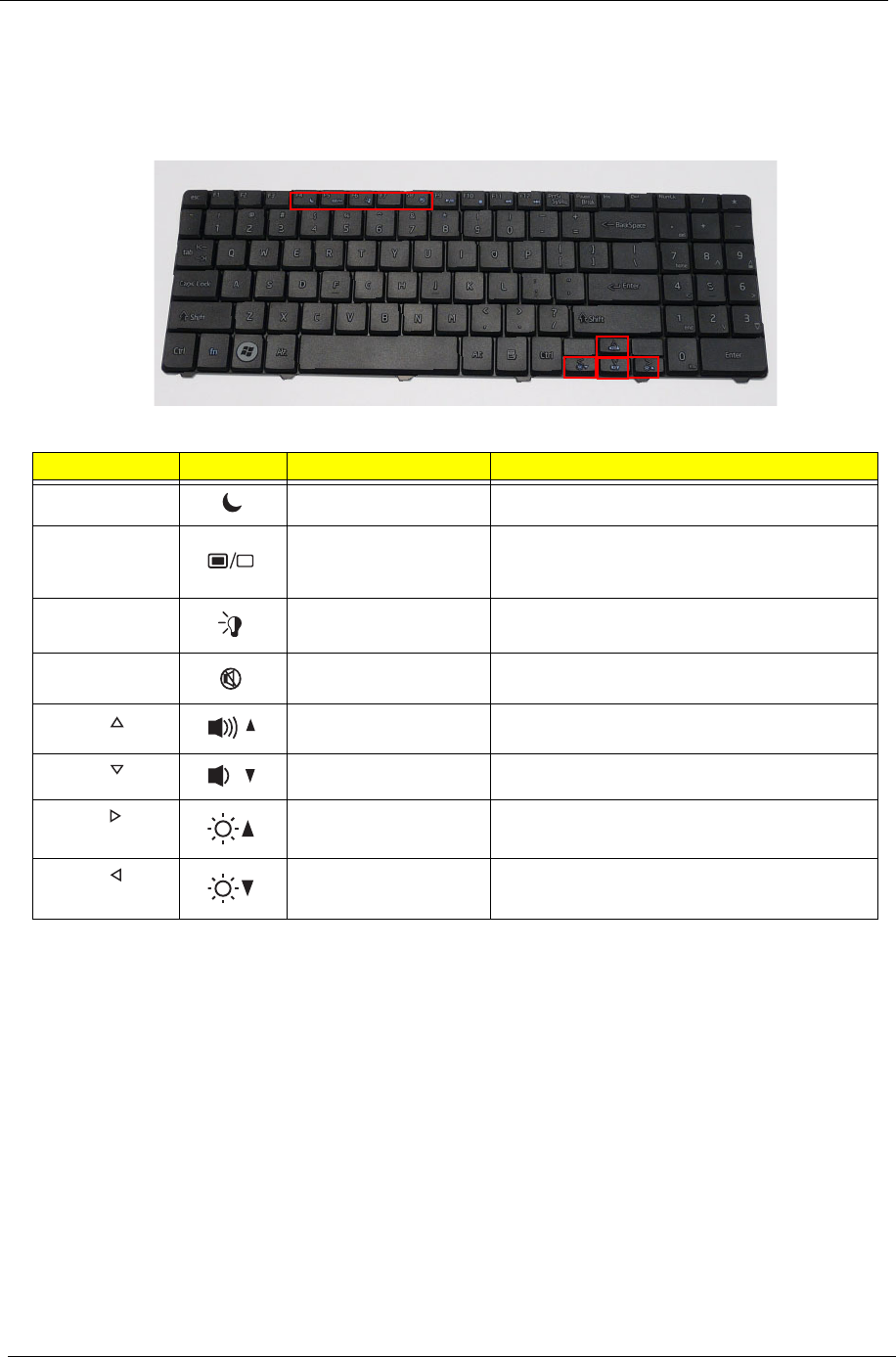
12 Chapter 1
Hot Keys
The computer employs hotkeys or key combinations to access most of the computer’s controls like screen
brightness, volume output and the BIOS utility.
To activate hot keys, press and hold the <Fn> key before pressing the other key in the hotkey combination.
Hotkey Icon Function Description
<Fn> + <F4> Sleep Puts the computer in Sleep mode.
<Fn> + <F5> Display toggle Switches display output between the display
screen, external monitor (if connected) and
both.
<Fn> + <F6> Screen blank Turns the display screen backlight off to save
power. Press any key to return.
<Fn> + <F8> Speaker toggle Turns the speakers on and off.
<Fn> + < > Volume up Increases the sound volume.
<Fn> + < > Volume down Decreases the sound volume.
<Fn> + < > Brightness up Increases the screen brightness.
<Fn> + < > Brightness down Decreases the screen brightness.
<Fn> + <F4>
<Fn> + <F5>
<Fn> + < >
<Fn> + < >
<Fn> + < >
<Fn> + < >
<Fn> + < >
<Fn> + < >

Chapter 1 13
Hardware Specifications and Configurations
Processor
Processor Specifications
CPU Fan True Value Table
• Throttling 50%: On=99°C, Off=96°C
• OS Shutdown: 105°C
• H/W Shutdown: 110°C
Northbridge
Item Specification
CPU • Intel® Pentium® mobile processor*
• Intel® Celeron® mobile processor*
Type Intel Mobile Memron uPGA
Core Logic Mobile Intel® GL40 Express Chipset
CPU Package Micro uPGA-478 Package
Power 65 Watts
On-die Cache 4MB L2 cache
Front Side Bus 667/800/1066MHz
Item CPU
Speed Cores Bus
Speed Mfg
Tech Cache
Size Package Core
Voltage Acer P/N
T1600 1.66 GHz 2 667 MHz 65 nm 1 MB PGA 1.075V-
1.175V
KC.16001.CMT
T1700 1.83 GHz 2 667 MHz 65 nm 1 MB PGA 1.075V-
1.175V
KC.17001.CMT
CM575 2.0 GHz 2 667 MHz 65 nm 1 MB PGA 0.95-
1.30V
KC.N0001.575
CM585 2.16 GHz 2 667 MHz 65 nm 1 MB PGA 0.95-
1.30V
KC.N0001.585
CM900 2.2 GHz 2 800 MHz N/A 1 MB PGA N/A KC.N0001.900
PMDT4300 2.16 GHz 2 667 MHz N/A 1 MB PGA N/A KC.34001.DT
P
PMDT4400 2.0 GHz 2 800 MHz N/A 1 MB PGA N/A KC.42001.DT
P
Fan On Temp (°C) Fan Speed (rpm) SPL Spec (dBA)
45 3000 28
50 3300 31
55 3700 34
65 4100 37
75 4500 40
80 4500 40
Item Specification
Chipset Intel Cantiga GM45/GL40
Package uFCBGA-1329

14 Chapter 1
Southbridge
BIOS
System Memory
Item Specification
Chipset ICH9-M
Package BGA-676
Item Specification
BIOS vendor Insyde BIOS
BIOS Version V0.06-T02
BIOS ROM type Flash
Features • Flash ROM 1MB
• Supports ISIPP
• Supports Acer UI
• Supports multi-boot
• Suspend to RAM (S3)/Disk (S4)
• Various hot-keys for system control
• Supports SMBUS 2.0, PCI2.3
• ACPI 2.0 compliance with Intel Speed Step support C1, C2,
C3, C4 and S3, S4 for mobile CPU
• DMI utility for BIOS serial number configurable/asset tag
• Supports PXE
• Supports Y2K solution
• Supports Win Flash Wake on LAN from S3
• Wake on LAN form S4 in AC mode
• System information
Item Specification
Memory controller ICH9-M
Memory size 4GB maximum
DIMM socket number 2
Supports memory size per socket 2GB
Supports maximum memory size 4GB (total)
Supports DIMM type 200-pin +1.8V DDRII
Supports DIMM Speed 667/800 MHz
Supports DIMM voltage 1.8V

Chapter 1 15
Memory Combinations
NOTE: Above table lists some system memory configurations. You may combine DIMMs with various
capacities to form other combinations. On above table, the configuration of slot 1 and slot 2 could be
reversed.
LAN Interface
Wireless Module 802.11b/g/Draft-N
Slot 1 Slot 2 Total Memory
0MB 512MB 512MB
0MB 1024MB 1024MB
0MB 2048MB 2048MB
512MB 512MB 1024MB
512MB 1024MB 1536MB
512MB 2048MB 2560MB
1024MB 0MB 1024MB
1024MB 512MB 1536MB
1024MB 1024MB 2048MB
1024MB 2048MB 3072MB
2048MB 0MB 2048MB
2048MB 512MB 2560MB
2048MB 1024MB 3072MB
2048MB 2048MB 4096MB
Item Specification
LAN Chipset Atheros AR8132L
LAN connector type RJ-45
LAN connector location Right side
Feature Support for 10/100
Item Specification
Manufacturer • Foxconn FOX_ATH_XB63 Foxconn Atheros XB63
minicard b/g
• Foxconn Wireless LAN Broadcom 4312 minicard b/g

16 Chapter 1
Hard Disk Drive Interface
Item Specification
Vendor & Model
Name
Seagate
ST9500325AS
ST9250315AS
Seagate
ST9320320AS
ST9160310AS
Toshiba
MK3255GSX
MK2555GSX
MK1655GSX
Western Digital
WD5000BEVT
WD3200BEVT
WD2500BEVT
WD1600BEVT
Capacity (MB) 500, 250 320, 160 320, 250, 160 500, 320, 250,
160
Bytes per sector 512 512 512 512
Data heads 4, 2 4, 2 4, 2, 2 4, 4, 3, 2
Drive Format
Disks 2, 1 2 or 1, 1 2, 1, 1 2, 2, 2, 1
Spindle speed
(RPM)
5400 5400 5400 5400
Performance Specifications
Buffer size 8 MB 8 MB 8 MB 8 MB
Interface SATA SATA SATA SATA
Internal transfer
rate (Mbits/sec,
max)
352 395~952
(typical)
850 Mbits/s
maximum
I/O data transfer
rate
(Mbytes/sec
max)
150 300 300 maximum
DC Power Requirements
Voltage
tolerance
5V ±5% 5V ±5% 5V ±5% 5V ±5%
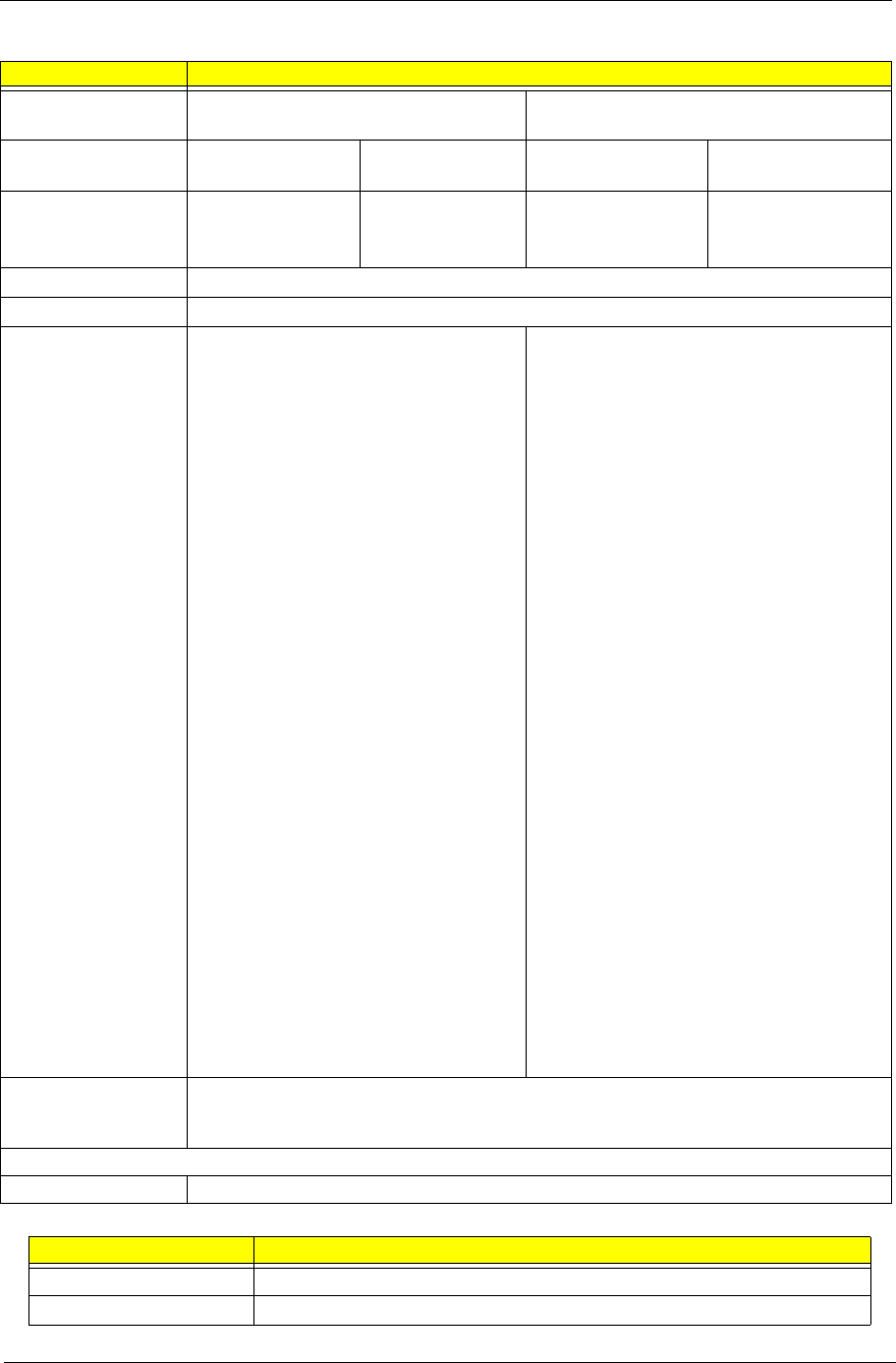
Chapter 1 17
Super-Multi Drive Module
Audio Interface
Item Specification
Vendor & model
name
HLDS GT20N Sony AD7580S
Performance
Specification
With CD Diskette With DVD Diskette With CD Diskette With DVD Diskette
Transfer rate (MB/
sec)
Sustained:
3,600 KB/s (24x)
max.
Sustained:
11.08 Mbytes/s
(8x) max.
Sustained:
1,571 (typical)
Sustained:
10,993 (typical)
Buffer Memory 2 MB
Interface SATA
Applicable disc
formats
DVD-ROM:
4.7GB (Single Layer)
8.5GB (Dual Layer)
DVD-R:
3.95GB (Ver. 1.0: read only)
4.7GB (Ver. 2.0 for Authoring: read only)
4.7GB (Ver. 2.1 for General: read & write)
(DL) 8.5GB (Ver. 3.0)
DVD-RW:
4.7GB (Ver. 1.2/ Rev 1.0, 2.0, 3.0)
DVD-RAM: 1.46GB/side, 4.7GB/side
(Ver. 2.2)
DVD+R: 4.7GB (Ver. 1.3)
(DL) 8.5GB (Ver. 1.1)
DVD+RW:
4.7GB (Vol.1 Ver.1.3)
CD-ROM Mode-1 data disc
CD-ROM Mode-2 data disc
CD-ROM XA, CD-I, Photo-CD Multi-
Session, Video CD
CD-Audio Disc
Mixed mode CD-ROM disc (data and
audio)
CD-Extra
CD-Text
CD-R (Conforming to “Orange Book Part
2”: read & write)
CD-RW (Conforming to “Orange Book
Part 3”: read & write)
DVD Read:
DVD-ROM (DVD-5, DVD-9, DVD-10, DVD-
18), DVD-Video, DVD-Audio, SACD (Hybrid),
UDF DVD, DVD-R, DVD-R DL, DVD-R 3.95
GB, DVD-R Authoring, DVD-R Multi-Border,
DVD-RW, DVD+R, DVD+R DL, DVD+R
Multi-Session, DVD+RW, DVD-RAM V1.0,
DVDRAM
V2.0 & 2.1 &2.2.
CD Read:
CD-DA, CD-ROM Mode-1, CD-ROM/XA
Mode-2 Form-1 and Mode-2 Form-2, CD-i,
CD-i
Bridge, Video-CD (MPEG-1), Karaoke CD,
Photo-CD, Enhanced CD, CD Plus, CD
Extra, itrax
CD, CD-Text, UDF CD, CD-R, and CD-RW
DVD Write:
DVD Data & Video
CD Read:
CD-DA, CD-ROM Mode-1, CD-ROM/XA
Mode-2 Form-1 and Mode-2 Form-2, CD-i,
Video-
CD, CD-Text
Loading mechanism Drawer (Solenoid Open)
Tact SW (Open)
Emergency Release (draw open hole)
Power Requirement
Input Voltage DC 5 V +/- 5%
Item Specification
Chipset Realtek ALC272X-GR
Features High Definition Audio Codec with Dolby Digital Live

18 Chapter 1
Power and Keyboard Controller
Battery
Item Specification
Controller ENE KB926
Total number of keypads 99-/100-/103-key keyboard
Windows logo key Yes
Hotkeys See “Hot Keys” on page 12.
Item Specification
6 Cell
Vendor & model name SANYO/SONY/PANASONIC/SAMSUNG/SIMPLO AS2009A
Battery Type Li-ion
Pack capacity 4400 mAh
Normal Voltage 2.2 Ah
Package configuration 3S2P

Chapter 1 19
LCD 17”
Card Reader
Item Specification
Vendor/model name CMO N173O6-L02
Screen Diagonal (mm) 439.4
Display Area (mm) 382.08 x 214.92
Display resolution (pixels) 1600 x 900
Pixel Pitch 0.2388
Display Mode Normal
Typical White Luminance (cd/m2)
(also called Brightness)
220
Contrast Ratio 600:1
Response Time (Optical Rise
Time/Fall Time) msec
8
Typical Power Consumption
(watt)
7
Weight 580 max.
Physical Size (mm) 398.1 x 232.8 x 5.5
Electrical Interface LVDS
Support Color 262K
Viewing Angle (up/down/right/
left)
20/45/45/45
Temperature Range (°C)
Operating
Storage (shipping)
0 to +50
-20 to +60
Item Specification
Part Name RealTek RT5159
Package 5-in-1 card reader
General Features • PCI-E interface
• Push-push type
•Dummy card

20 Chapter 1

Chapter 2 21
System Utilities
BIOS Setup Utility
The BIOS Setup Utility is a hardware configuration program built into your computer’s BIOS (Basic Input/
Output System).
Your computer is already properly configured and optimized, and you do not need to run this utility. However, if
you encounter configuration problems, you may need to run Setup. Please also refer to Chapter 4
Troubleshooting when problem arises.
To activate the BIOS Utility, press F2 during POST (when “Press <F2> to enter Setup” message is prompted
on the bottom of screen).
Press F2 to enter setup. The default parameter of F12 Boot Menu is set to “disabled”. If you want to change
boot device without entering BIOS Setup Utility, please set the parameter to “enabled”.
Press <F12> during POST to enter multi-boot menu. In this menu, user can change boot device without
entering BIOS SETUP Utility.
Navigating the BIOS Utility
There are six menu options: Information, Main, Advanced, Security, Boot, and Exit.
Follow these instructions:
• To choose a menu, use the left and right arrow keys.
• To choose an item, use the up and down arrow keys.
• To change the value of a parameter, press F5 or F6.
• A plus sign (+) indicates the item has sub-items. Press Enter to expand this item.
• Press Esc while you are in any of the menu options to go to the Exit menu.
• In any menu, you can load default settings by pressing F9. You can also press F10 to save any
changes made and exit the BIOS Setup Utility.
NOTE: You can change the value of a parameter if it is enclosed in square brackets. Navigation keys for a
particular menu are shown on the bottom of the screen. Help for parameters are found in the Item
Specific Help part of the screen. Read this carefully when making changes to parameter values. Please
note that system information is subject to different models.
Chapter 2
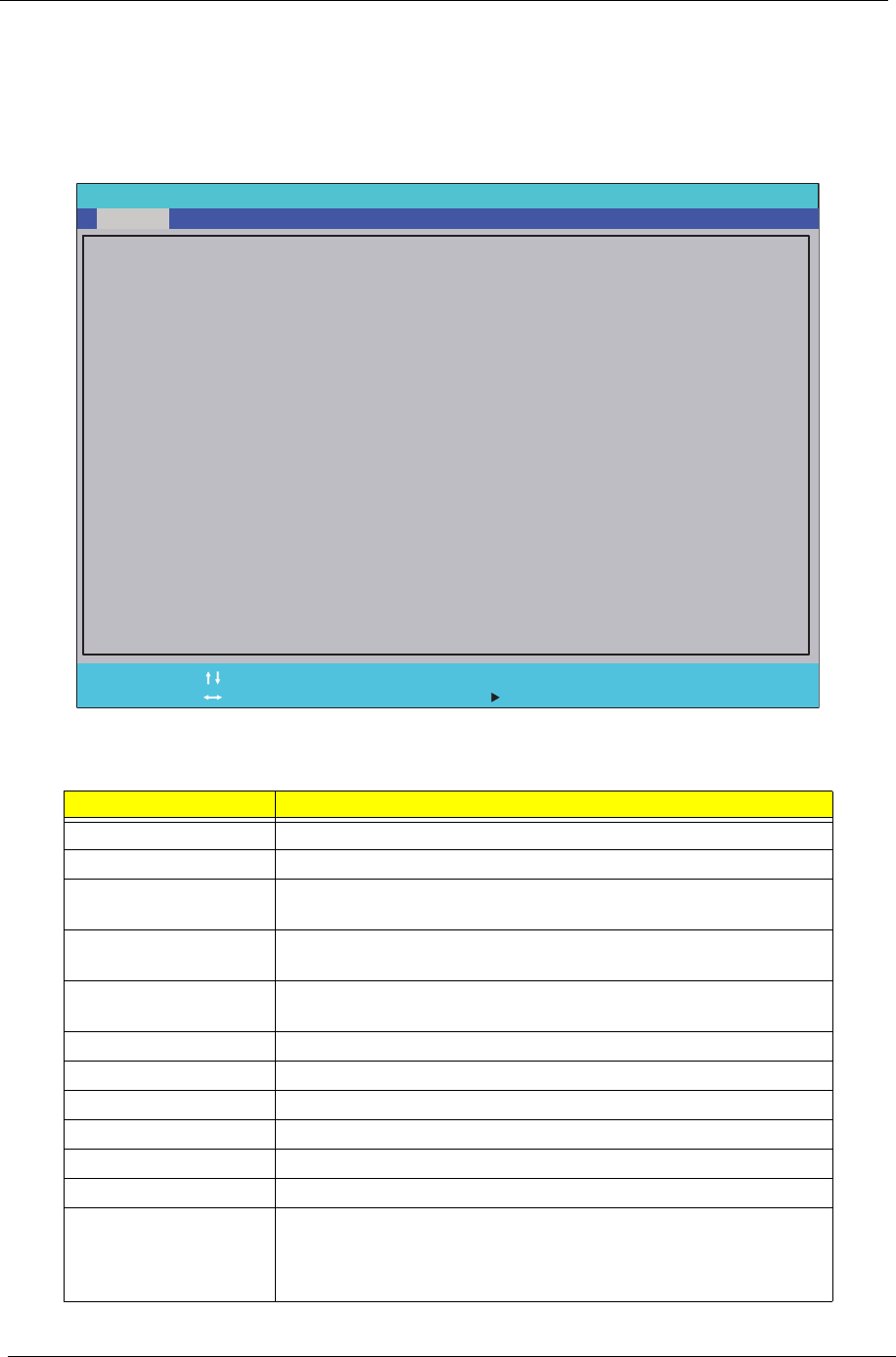
22 Chapter 2
HM70-MV Intel BIOS
Information
The Information screen displays a summary of your computer hardware information.
NOTE: The screen above is for your reference only. Actual values may differ according to model.
The table below describes the parameters in this screen.
Parameter Description
CPU Type This field shows the CPU type and speed of the system.
CPU Speed This field shows the speed of the CPU.
HDD Model Name This field shows the model name of HDD installed on primary IDE
master.
HDD Serial Number This field displays the serial number of HDD installed on primary IDE
master.
ATAPI Model Name This field shows the model name of the Optical device installed in
the system.
System BIOS Version Displays system BIOS version.
VGA BIOS Version This field displays the VGA firmware version of the system.
Serial Number This field displays the serial number of this unit.
Asset Tag Number This field displays the asset tag number of the system.
Product Name This field shows product name of the system.
Manufacturer Name This field displays the manufacturer of this system.
UUID Universally Unique Identifier (UUID) is an identifier standard used in
software construction, standardized by the Open Software
Foundation (OSF) as part of the Distributed Computing Environment
(DCE).
InsydeH20 Setup Utility Rev. 3.5
F1
ESC Help
Exit Select Item
Select Menu Change Values
Select SubMenu
Enter F9
F10 Setup Default
Save and Exit
Intel(R) Pentium(R) Dual CPU T3400 @ 2.16GHz
2.16GHz
WDC WD5000BEVT-22ZAT0
WD-WXNY08SP8652
None
MATSHITADVD-RAM UJ880AS
V0.09-T1
Intel V1704
Aspire 7715Z/7315
Acer
63623032-6261-3964-6338-00235A495964
Intel(R) Pentium(R) Dual CPU T3400 @ 2.16GHz
2.16GHz
WDC WD5000BEVT-22ZAT0
WD-WXNY08SP8652
None
MATSHITADVD-RAM UJ880AS
V0.09-T1
Intel V1704
Aspire 7715Z/7315
Acer
63623032-6261-3964-6338-00235A495964
CPU Type
CPU Speed
HDD Model Name:
HDD Serial Number:
HDD Model Name:
HDD Serial Name:
ATAPI Model Name:
System BIOS Version:
VGA BIOS Version:
Serial Number:
Asset Tag Number:
Product Name:
Manufacturer Name:
UUID:
CPU Type
CPU Speed
HDD Model Name:
HDD Serial Number:
HDD Model Name:
HDD Serial Name:
ATAPI Model Name:
System BIOS Version:
VGA BIOS Version:
Serial Number:
Asset Tag Number:
Product Name:
Manufacturer Name:
UUID:
F5/F6
Main Boot Exit
SecurityInformation Advanced Power
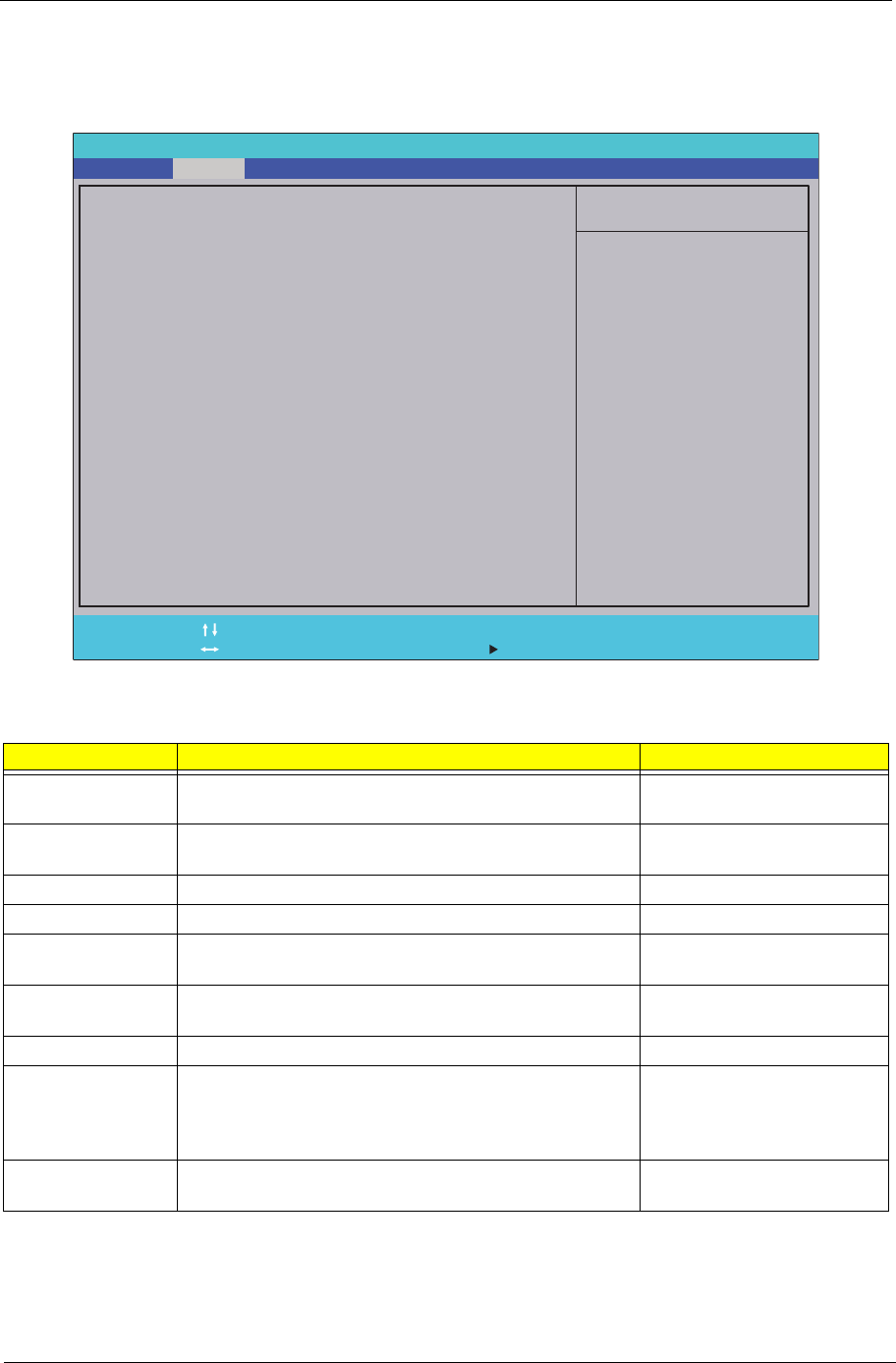
Chapter 2 23
Main
The Main screen allows the user to set the system time and date as well as enable and disable boot option
and recovery.
NOTE: The screen above is for your reference only. Actual values may differ.
The table below describes the parameters in this screen.
Parameter Description Format/Option
System Time Sets the system time. The hours are displayed with 24-
hour format.
Format: HH:MM:SS
(hour:minute:second)
System Date Sets the system date. Format MM/DD/YYYY
(month/day/year)
Total Memory
Displays the total memory available.
N/A
Video Memory
Displays the available memory for Video.
N/A
Quick Boot Allows startup to skip certain tests while booting,
decreasing the time needed to boot the system.
Option: Enabled or
Disabled
Network Boot Enables, disables the system boot from LAN (remote
server).
Option: Enabled or
Disabled
F12 Boot Menu Enables, disables Boot Menu during POST. Option: Enabled or Enabled
D2D Recovery Enables, disables D2D Recovery function. The function
allows the user to create a hidden partition on hard disc
drive to store operation system and restore the system
to factory defaults.
Option: Enabled or
Disabled
SATA Mode Control the mode in which the SATA controller should
operate.
Option: AHCI or IDE
Item Specific Help
This is the help for the
hour field. Valid range
is from 0 to 23.
INCREASE/REDUCE
: F5/F6
F1
ESC Help
Exit Select Item
Select Menu Change Values
Select SubMenu
Enter F9
F10 Setup Default
Save and Exit
[19:10:59]
[01/09/2009]
4095 MB
512 MB
[Enabled]
[Enabled]
[Disabled]
[Enabled]
[AHCI]
[19:10:59]
[01/09/2009]
4095 MB
512 MB
[Enabled]
[Enabled]
[Disabled]
[Enabled]
[AHCI]
System Time:
System Date:
Total Memory:
Video Memory:
Quick Boot
Network Boot
F12 Boot Menu
D2D Recovery
SATA Mode
System Time:
System Date:
Total Memory:
Video Memory:
Quick Boot
Network Boot
F12 Boot Menu
D2D Recovery
SATA Mode
F5/F6
InsydeH20 Setup Utility Rev. 3.5
Boot Exit
SecurityInformation Advanced PowerMain
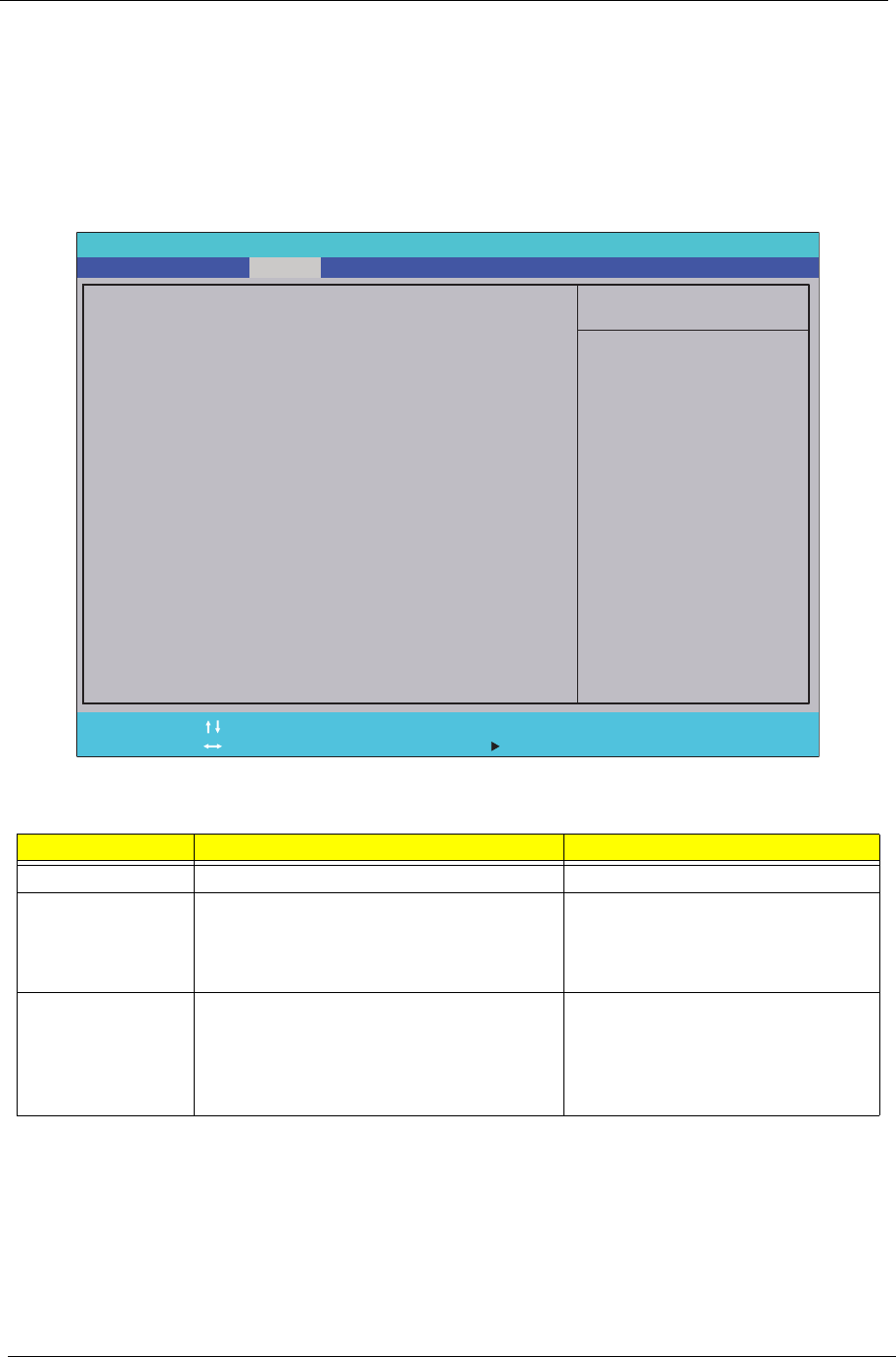
24 Chapter 2
Advanced
The Advanced screen allows the user to configure the various advanced BIOS options.
IMPORTANT:Making incorrect settings to items on these pages may cause the system to malfunction. Unless
you have experience adjusting these items, we recommend that you leave these settings at the
default values. If making settings to items on these pages causes your system to malfunction or
prevents the system from booting, open BIOS and choose Load Optimal Defaults in the Exit menu to
boot up normally.
The table below describes the items, menus, and submenus in this screen. Settings in boldface are the default
and suggested parameter settings.
Parameter Description Submenu Items
Boot Configuration Enter the Boot Configuration menu. • Numlock
Peripheral
Configuration
Enter the Peripheral Configuration menu. • Serial Port A
• Infrared Port
• Azalia
•Lan
IDE Configuration Enter the IDE Configuration menu. • IDE Controller
• HDC Configure as
• AHCI Option ROM Support
• SATA Port 0, 1, 4, 5 HotPlug
• Channel 1 to 4 Master and Slave
Item Specific Help
Configures Boot
Settings.
F1
ESC Help
Exit Select Item
Select Menu Change Values
Select SubMenu
Enter F9
F10 Setup Default
Save and Exit
[Disabled][Disabled]
XBoot Configuration
XPeripheral Configuration
XIDE Configuration
XThermal Configuration
XVideo Configuration
XUSB Configuration
XChipset Configuration
XACPI Table/Features Control
Express Card
XPCI Express Configuration
XASF Configuration
XBoot Configuration
XPeripheral Configuration
XIDE Configuration
XThermal Configuration
XVideo Configuration
XUSB Configuration
XChipset Configuration
XACPI Table/Features Control
Express Card
XPCI Express Configuration
XASF Configuration
F5/F6
InsydeH20 Setup Utility Rev. 3.5
Boot Exit
SecurityInformation Advanced PowerMain

Chapter 2 25
Video
Configuration
Enter the Video Configuration menu. • Render Standby
• IGD—Device2, Function1
• IGD—Pre-allocat Memory
• IGD—DVMT Size
• Clock Chip Initialize
• Enabled CK SSC
• IGD—Boot Type
• IGD—LCD Panel Type
• IGD—TV
• IGD—PAVP Mode
USB Configuration Enter the USB Configuration menu. • USB Legacy
•EHCI 1, 2
• UHCI 1 ~ 5
• Per-Port Control
• USB Port 0~7
Chipset
Configuration
Enter the Chipset Configuration menu. • Port 80h Cycles
• DMI Link ASPM Control
• Automatic ASPM
• PCI Latency Timer
•VT-d
•iTPM
ACPI Table/
Features Control
Enter the ACPI Table/Features Control
menu.
• FACP—C2 Latency Value
• FACP—C3 Latency Value
• FACP—RTC S4 Wakeup
• APIC—IO APIC Mode
• HPET—HPET Support
• Base Address select
Express Card • N/A
PCI EXpress Root
Port 1 ~ 6
• PCI Express Root Port 1
• VC1 Enable
• ASPM
• Automatic ASPM
•URR
•FER
•NFER
•CER
•CTO
• SEFE
• SENFE
• SECE
• PME Interrupt
•PMI SCI
• Hot Plug SCI
ASF Configuration • Mini WatchDog Timeout
• BIOS Boot Timeout
• OS Boot Timeout
• Power-on wait time
Parameter Description Submenu Items
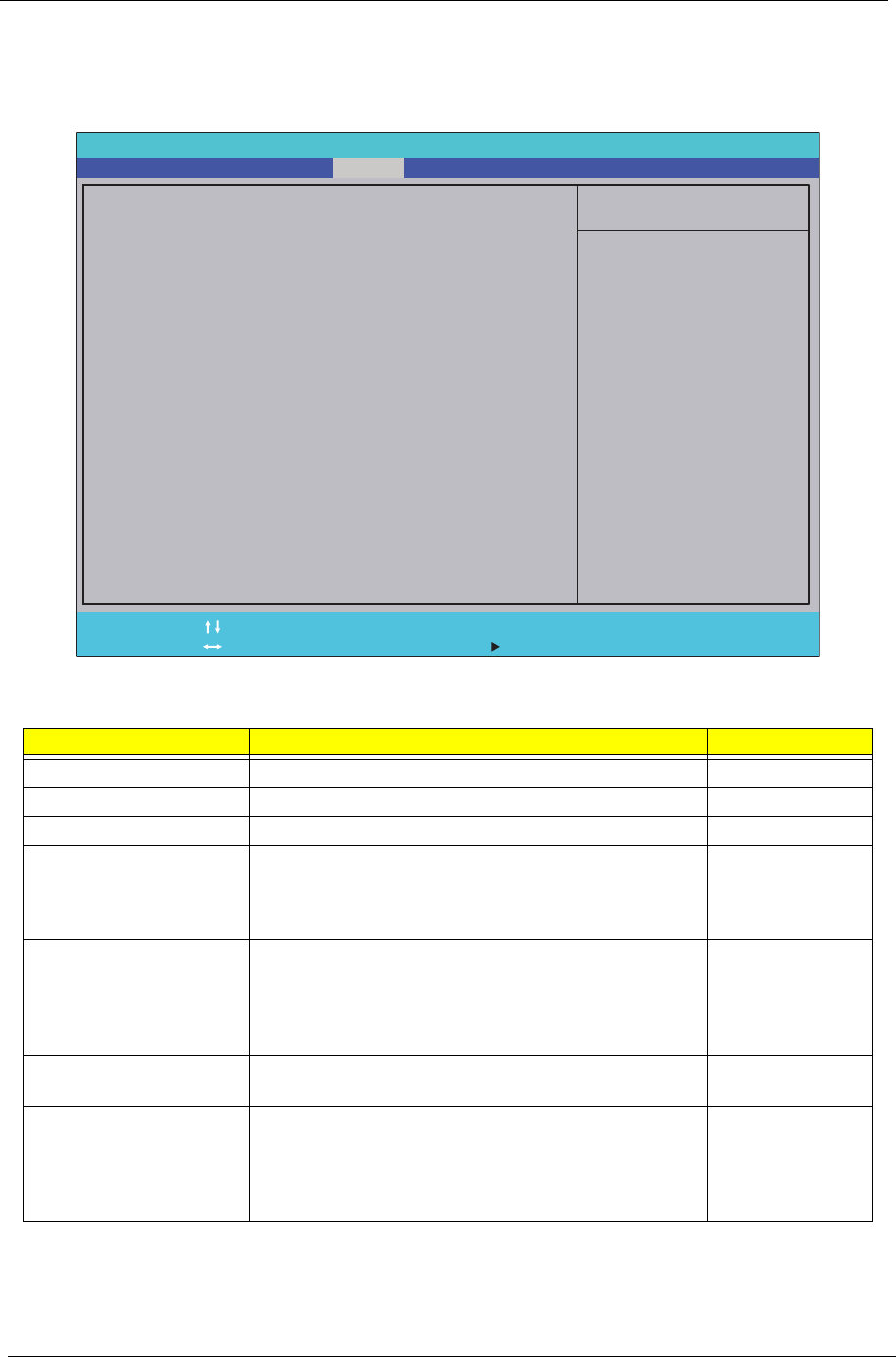
26 Chapter 2
Security
The Security screen contains parameters that help safeguard and protect your computer from unauthorized
use.
The table below describes the parameters in this screen. Settings in boldface are the default and suggested
parameter settings.
NOTE: When you are prompted to enter a password, you have three tries before the system halts. Don’t forget
your password. If you forget your password, you may have to return your notebook computer to your
dealer to reset it.
Parameter Description Option
Supervisor Password Is Shows the setting of the Supervisor password Clear or Set
User Password Is Shows the setting of the user password. Clear or Set
HDD Password Is Shows the setting of the hard disk password. Clear or Set
Set Supervisor Password Press Enter to set the supervisor password. When set,
this password protects the BIOS Setup Utility from
unauthorized access. The user can not either enter the
Setup menu nor change the value of parameters.
N/A
Set User Password Press Enter to set the user password. When user
password is set, this password protects the BIOS Setup
Utility from unauthorized access. The user can enter
Setup menu only and does not have right to change the
value of parameters.
N/A
Set SATA Port0 HDD
Password
Enter HDD Password. N/A
Password on Boot Defines whether a password is required or not while the
events defined in this group happened. The following
sub-options are all requires the Supervisor password
for changes and should be grayed out if the user
password was used to enter setup.
Disabled or
Enabled
Item Specific Help
Install or Change the
password and the length
of password must be less
than eight words.
F1
ESC Help
Exit Select Item
Select Menu Change Values
Select SubMenu
Enter F9
F10 Setup Default
Save and Exit
Clear
Clear
Clear
[Disabled]
Clear
Clear
Clear
[Disabled]
Supervisor Password Is:
User Password Is:
HDD Password Is:
Set Supervisor Password
Set User Password
Set SATA Port0 HDD Password
Password on Boot
Supervisor Password Is:
User Password Is:
HDD Password Is:
Set Supervisor Password
Set User Password
Set SATA Port0 HDD Password
Password on Boot
F5/F6
InsydeH20 Setup Utility Rev. 3.5
Information AdvancedMain Boot Exit
Security Power

Chapter 2 27
Setting a Password
Follow these steps as you set the user or the supervisor password:
1. Use the ↑ and ↓ keys to highlight the Set Supervisor Password parameter and press the Enter key. The
Set Supervisor Password box appears:
2. Type a password in the “Enter New Password” field. The password length can not exceed 8 alphanumeric
characters (A-Z, a-z, 0-9, not case sensitive). Retype the password in the “Confirm New Password” field.
IMPORTANT:Be very careful when typing your password because the characters do not appear on the screen.
3. Press Enter. After setting the password, the computer sets the User Password parameter to “Set”.
4. If desired, you can opt to enable the Password on boot parameter.
5. When you are done, press F10 to save the changes and exit the BIOS Setup Utility.
Removing a Password
Follow these steps:
1. Use the ↑ and ↓ keys to highlight the Set Supervisor Password parameter and press the Enter key. The
Set Password box appears:
2. Type the current password in the Enter Current Password field and press Enter.
3. Press Enter twice without typing anything in the Enter New Password and Confirm New Password fields.
The computer then sets the Supervisor Password parameter to “Clear”.
4. When you have changed the settings, press u to save the changes and exit the BIOS Setup Utility.
Set Supervisor Password
Enter New Password [ ][ ]
Confirm New Password [ ]
Set Supervisor Password
Enter Current Password [ ][ ]
Enter New Password [ ]
Confirm New Password [ ][ ]

28 Chapter 2
Changing a Password
1. Use the ↑ and ↓ keys to highlight the Set Supervisor Password parameter and press the Enter key. The
Set Password box appears.
2. Type the current password in the Enter Current Password field and press Enter.
3. Type a password in the Enter New Password field. Retype the password in the Confirm New Password
field.
4. Press Enter. After setting the password, the computer sets the User Password parameter to “Set”.
5. If desired, you can enable the Password on boot parameter.
6. When you are done, press F10 to save the changes and exit the BIOS Setup Utility.
If the verification is OK, the screen will display as following.
The password setting is complete after the user presses Enter.
If the current password entered does not match the actual current password, the screen will show you the
Setup Warning.
If the new password and confirm new password strings do not match, the screen will display the following
message.
Set Supervisor Password
Enter Current Password [ ][ ]
Enter New Password [ ]
Confirm New Password [ ][ ]
Setup Notice
Changes have been saved.
[Continue][Continue]
Setup Warning
Invalid Password.
[Continue][Continue]
Setup Warning
Passwords do not match.
Re-enter password.
[Continue][Continue]
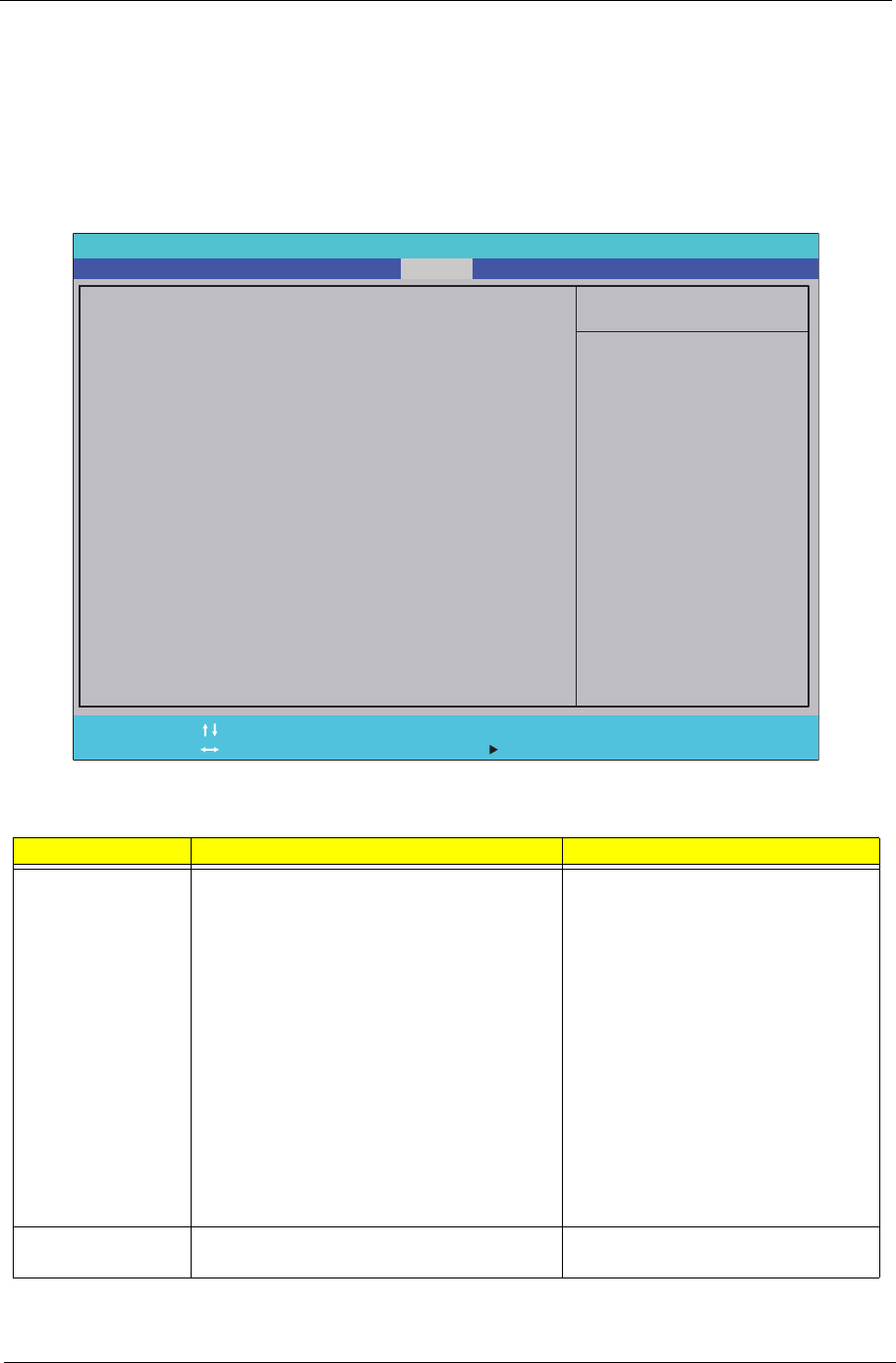
Chapter 2 29
Power
The Advanced screen allows the user to configure the various advanced BIOS options.
IMPORTANT:Making incorrect settings to items on these pages may cause the system to malfunction. Unless
you have experience adjusting these items, we recommend that you leave these settings at the
default values. If making settings to items on these pages causes your system to malfunction or
prevents the system from booting, open BIOS and choose Load Optimal Defaults in the Exit menu to
boot up normally.
The table below describes the items, menus, and submenus in this screen. Settings in boldface are the default
and suggested parameter settings.
Parameter Description Submenu Items
Advanced CPU
Control
Enter the Advanced CPU Control menu. • P-States (IST)
• Boot performance mode
• Thermal Mode
• CMP Support
• Use XD capability
• VT Support
• SMRR Support
•C-States
• Enhanced C-States
• C-State Pop Up Mode
• C-State Pop Down Mode
• C4 Exit Timing Mode
• Deep C4
• Hard C4E
• Enable C6
Platform Power
Management
Enter the Platform Power Management
menu.
• PCI Clock Run
Item Specific Help
These items control
various CPU parameters.
F1
ESC Help
Exit Select Item
Select Menu Change Values
Select SubMenu
Enter F9
F10 Setup Default
Save and Exit
[Enabled]
[Enabled]
[Enabled]
[Disabled]
[Disabled]
[Enabled]
[Enabled]
[Enabled]
[Disabled]
[Disabled]
XAdvanced CPU Control
XPlatform Power Management
XBreak Event
ACPI S3:
Wake on PME
Wake on Modem Ring
Quickly S4 Resume
Auto wake on S5
XAdvanced CPU Control
XPlatform Power Management
XBreak Event
ACPI S3:
Wake on PME
Wake on Modem Ring
Quickly S4 Resume
Auto wake on S5
F5/F6
InsydeH20 Setup Utility Rev. 3.5
Boot Exit
SecurityInformation Advanced PowerMain

30 Chapter 2
Break Event Enter the Break Event menu. • Storage Break Event
• PCIE Break Event
• PCI Break Event
• EHCI Break Event
• UHCI Break Event
• HDA Break Event
ACPI S3 Enable or Disable ACPI S1/S3 Sleep State. N/A
Wake on PME Disable or Enable wake up when the
system power is off and a PCI Power
Management Enable wake up event occurs.
N/A
Wake on Modem
Ring
Disable or Enable wake up when the
system power is off and a modem attached
to the serial port is ringing.
N/A
Quickly S4
Resume
Disable or Enable optional quick boot from
S4 Resume.
N/A
Auto wake on S5 Disable or Enable auto wake up by date
and time or at a fixed time everyday.
N/A
Parameter Description Submenu Items
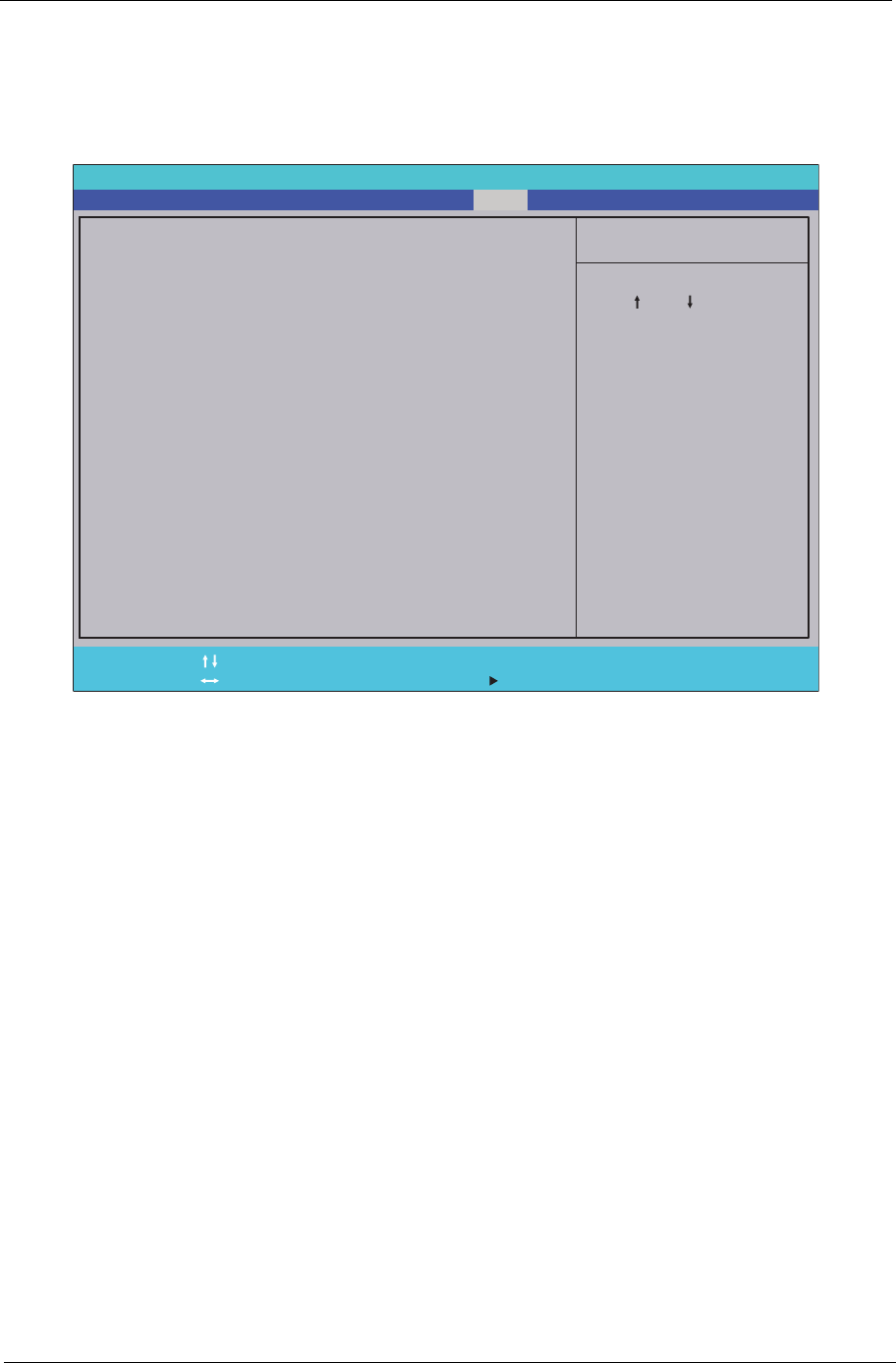
Chapter 2 31
Boot
This menu allows the user to decide the order of boot devices to load the operating system. Bootable devices
includes the USB diskette drives, the onboard hard disk drive and the DVD drive in the module bay.
Select Boot Devices to select specific devices to support boot.
Item Specific Help
Use < > or < > to select
a device, then press
<F5> to move it down the
list, or <F6> to move
it up the list. Press
<Esc> to escape the menu
F1
ESC Help
Exit Select Item
Select Menu Change Values
Select SubMenu
Enter F9
F10 Setup Default
Save and Exit
Boot priority order:
1. IDE0 : WDC WD5000BEVT-22ZAT0
2. IDE2 :
3. IDE1 : MATSHITADVD-RAM UJ880AS
3. USB FDD :
4. Network Boot : Atheros Boot Agent
5. USB HDD :
6. USB CDROM :
Boot priority order:
1. IDE0 : WDC WD5000BEVT-22ZAT0
2. IDE2 :
3. IDE1 : MATSHITADVD-RAM UJ880AS
3. USB FDD :
4. Network Boot : Atheros Boot Agent
5. USB HDD :
6. USB CDROM :
F5/F6
InsydeH20 Setup Utility Rev. 3.5
Information AdvancedMain Boot Exit
Security Power
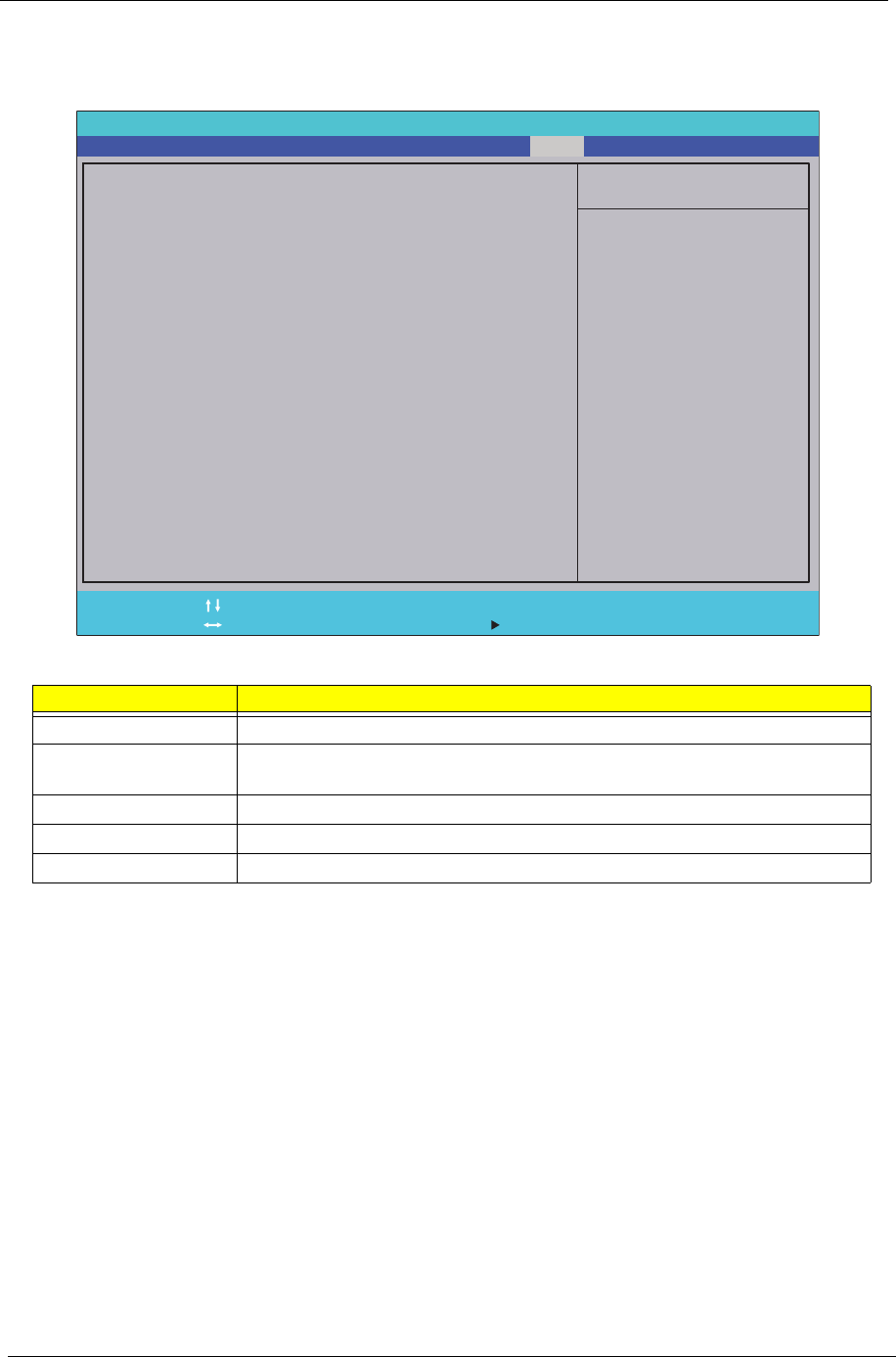
32 Chapter 2
Exit
The Exit screen allows you to save or discard any changes you made and quit the BIOS Utility.
The table below describes the parameters in this screen.
Parameter Description
Exit Saving Changes Exit System Setup and save your changes to CMOS.
Exit Discarding
Changes
Exit utility without saving setup data to CMOS.
Load Setup Default Load default values for all SETUP item.
Discard Changes Load previous values from CMOS for all SETUP items.
Save Changes Save Setup Data to CMOS.
Item Specific Help
Exit System Setup and
save your changes to
CMOS.
F1
ESC Help
Exit Select Item
Select Menu Change Values
Select SubMenu
Enter F9
F10 Setup Default
Save and Exit
Exit Saving Changes
Exit Discarding Changes
Load Setup Defaults
Discard Changes
Save Changes
Exit Saving Changes
Exit Discarding Changes
Load Setup Defaults
Discard Changes
Save Changes
F5/F6
InsydeH20 Setup Utility Rev. 3.5
Information AdvancedMain Boot Exit
Security Power

Chapter 2 33
BIOS Flash Utilities
The BIOS flash memory update is required for the following conditions:
• New versions of system programs
• New features or options
• Restore a BIOS when it becomes corrupted.
Use the Phlash utility to update the system BIOS flash ROM.
NOTE: If you do not have a crisis recovery diskette at hand, then you should create a Crisis Recovery
Diskette before you use the Phlash utility.
NOTE: Do not install memory-related drivers (XMS, EMS, DPMI) when you use the Phlash.
NOTE: Please use the AC adaptor power supply when you run the Phlash utility. If the battery pack does not
contain enough power to finish BIOS flash, you may not boot the system because the BIOS is not
completely loaded.
Fellow the steps below to run the Phlash.
1. Prepare a bootable diskette.
2. Copy the flash utilities to the bootable diskette.
3. Then boot the system from the bootable diskette. The flash utility has auto-execution function.
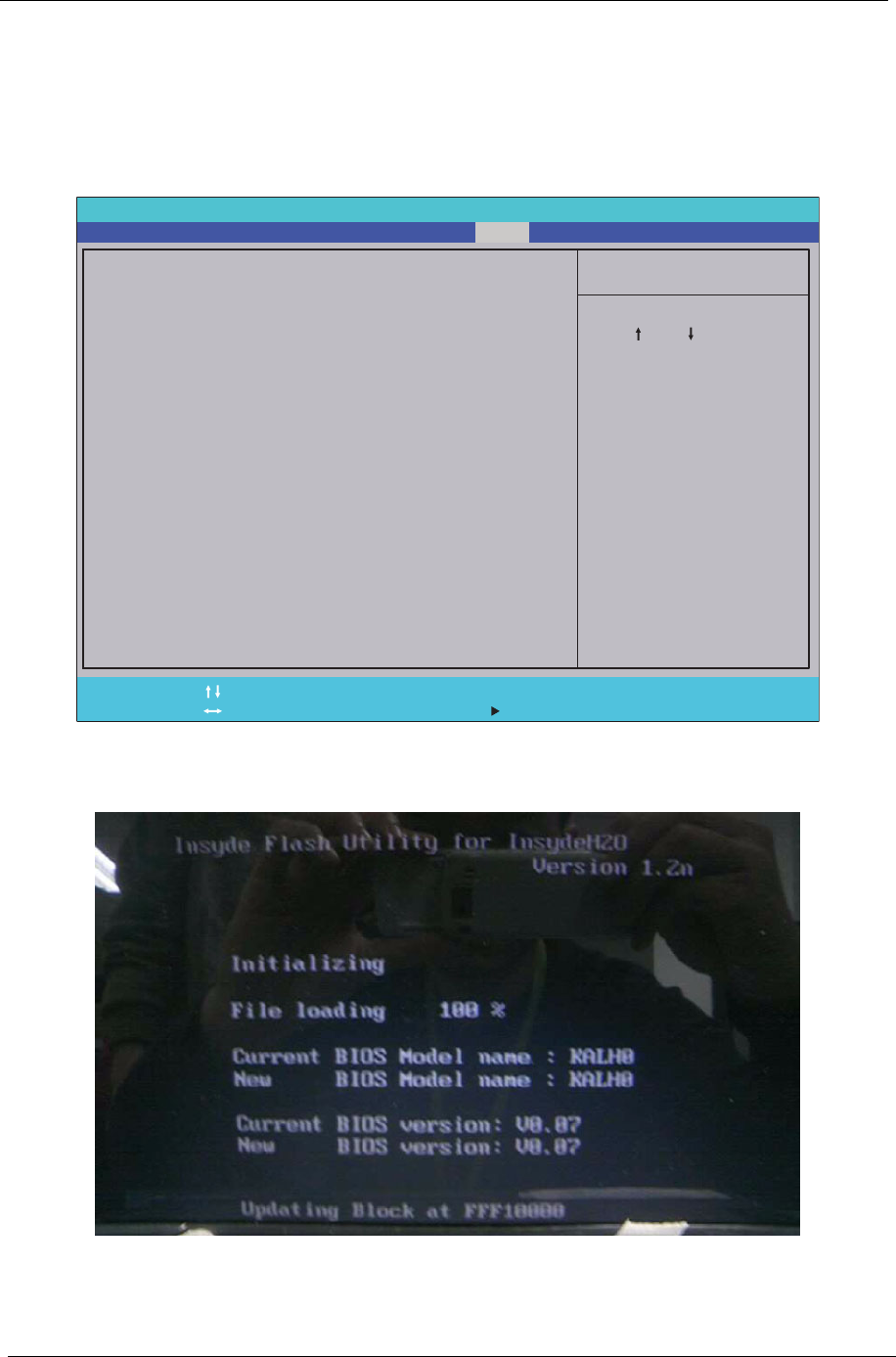
34 Chapter 2
DOS Flash Utility
Perform the following steps to use the DOS Flash Utility:
1. Press F2 during boot to enter the Setup Menu.
2. Select Boot Menu to modify the boot priority order, for example, if using USB HDD to Update BIOS, move
USB HDD to position 1.
3. Execute the FLASH.BAT batch file to update BIOS.
The flash process begins as shown.
Item Specific Help
Use < > or < > to select
a device, then press
<F5> to move it down the
list, or <F6> to move
it up the list. Press
<Esc> to escape the menu
F1
ESC Help
Exit Select Item
Select Menu Change Values
Select SubMenu
Enter F9
F10 Setup Default
Save and Exit
Boot priority order:
1. IDE0 : WDC WD5000BEVT-22ZAT0
2. IDE2 :
3. IDE1 : MATSHITADVD-RAM UJ880AS
3. USB FDD :
4. Network Boot : Atheros Boot Agent
5. USB HDD :
6. USB CDROM :
Boot priority order:
1. IDE0 : WDC WD5000BEVT-22ZAT0
2. IDE2 :
3. IDE1 : MATSHITADVD-RAM UJ880AS
3. USB FDD :
4. Network Boot : Atheros Boot Agent
5. USB HDD :
6. USB CDROM :
F5/F6
InsydeH20 Setup Utility Rev. 3.5
Information AdvancedMain Boot Exit
Security Power
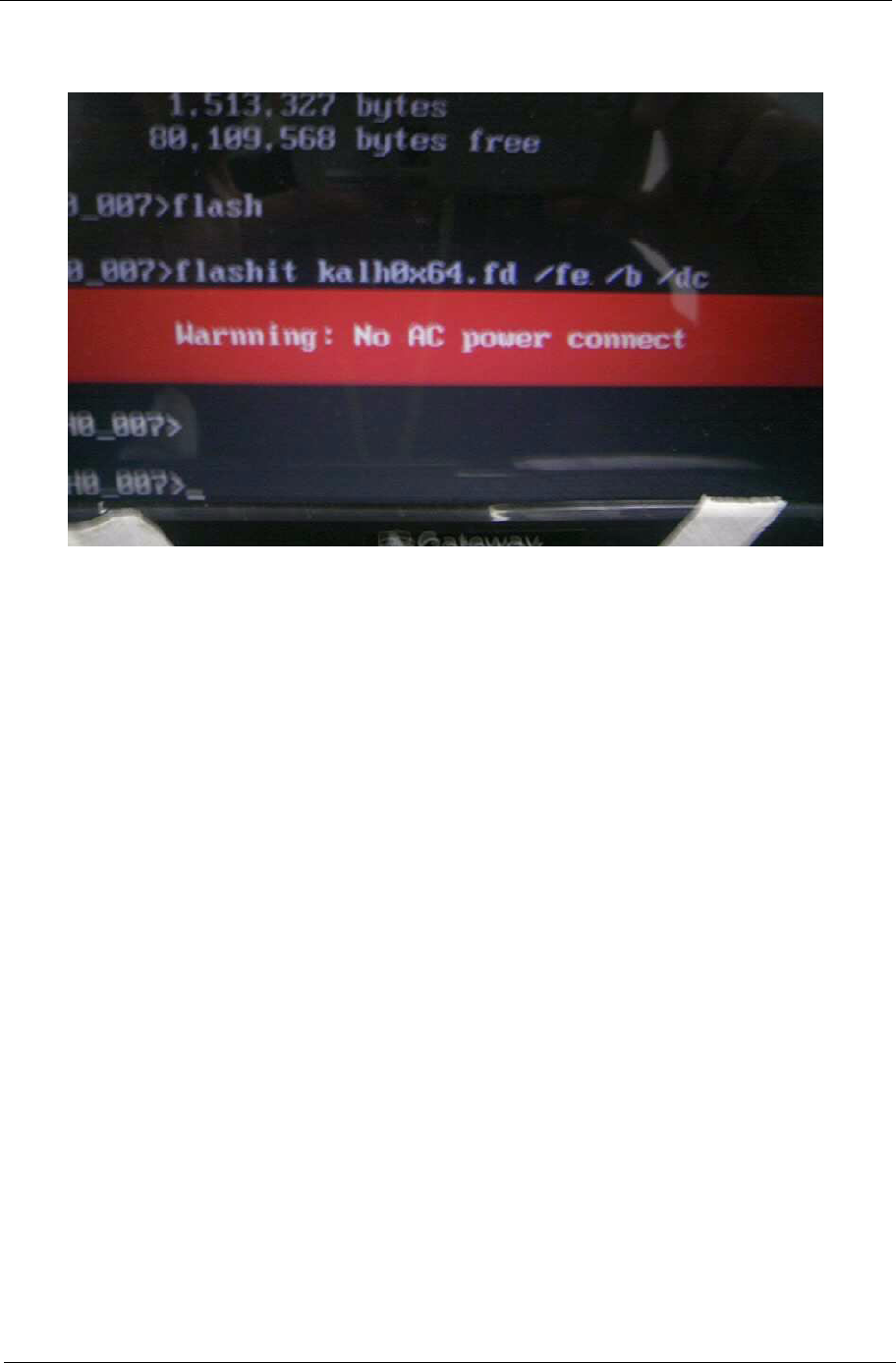
Chapter 2 35
4. In flash BIOS, the message Please do not remove AC Power Source displays.
NOTE: If the AC power is not connected, the following message displays.
Plug in the AC power to continue.
5. Flash is complete when the message Flash programming complete displays.
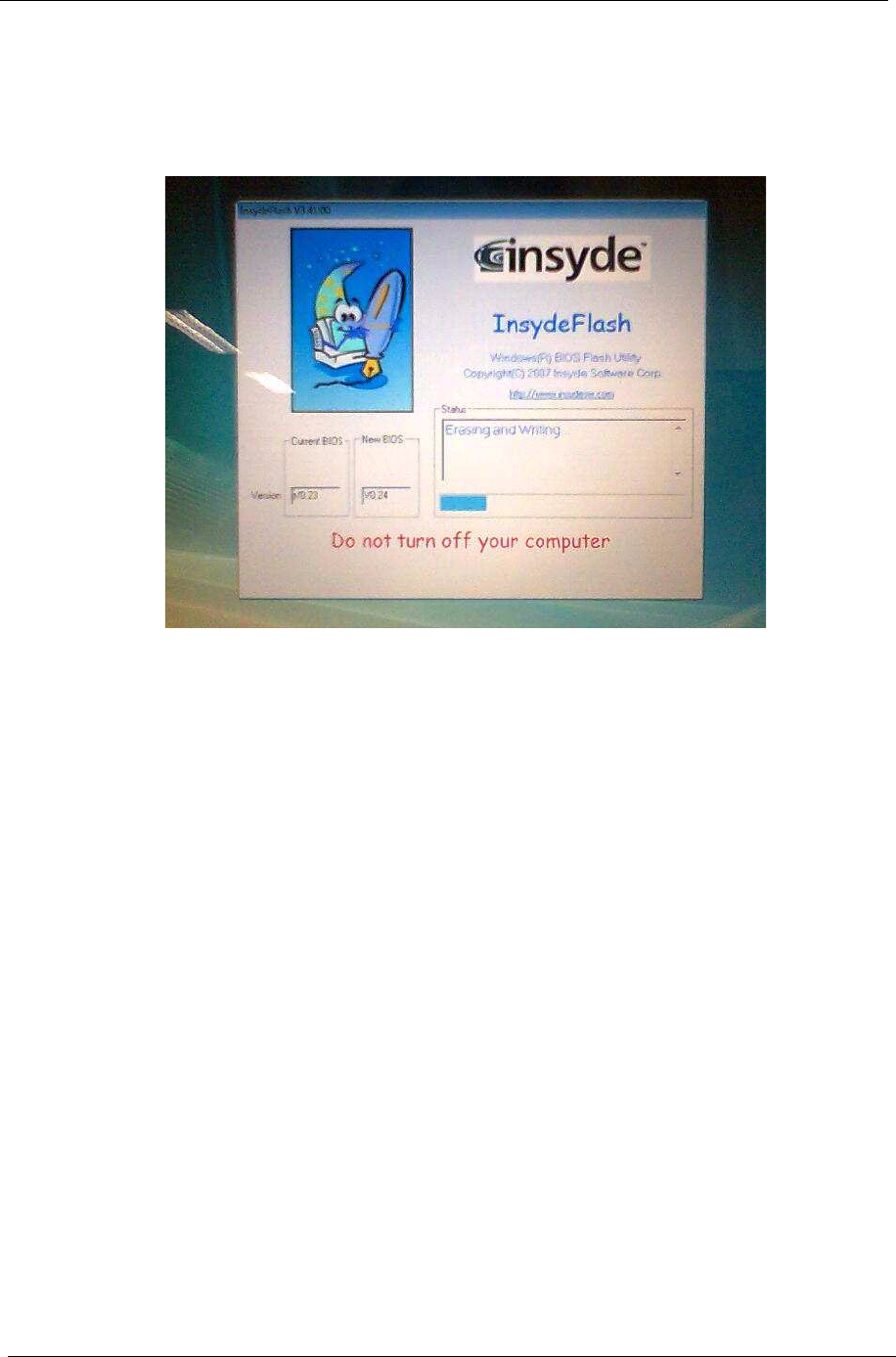
36 Chapter 2
WinFlash Utility
Perform the following steps to use the WinFlash Utility:
1. Double-click the WinFlash executable.
2. Click OK to begin the update. A progress screen displays.
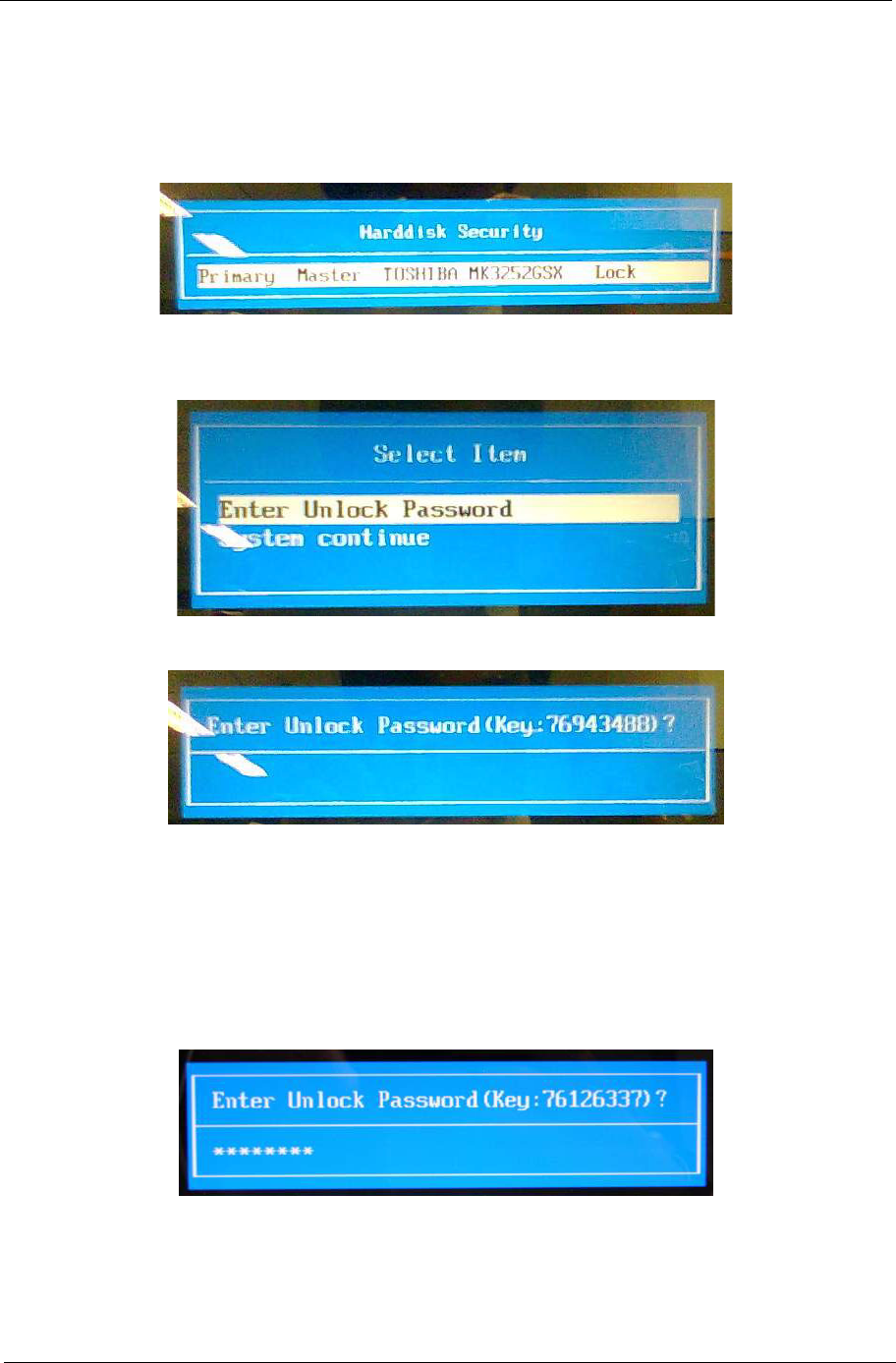
Chapter 2 37
Remove HDD/BIOS Password Utilities
This section provides you with details about removing HDD/BIOS password:
Remove HDD Password:
If you key in the wrong HDD password three times, an error is generated.
To reset the HDD password, perform the following steps:
1. After the error is displayed, select the Enter Unlock Password option on the screen.
2. An Encode key is generated for unlocking utilities. Note down this key.
3. Execute the UnlockHD.EXE file to create the unlock code in DOS Mode using the format UnlockHD
[Encode code] with the code noted in the previous step, as follows:
UnlockHD 76943488
4. The command generates a password which can be used for unlocking the HDD.
Password : 46548274
5. Key in the password from the previous step to unlock the HDD as shown.
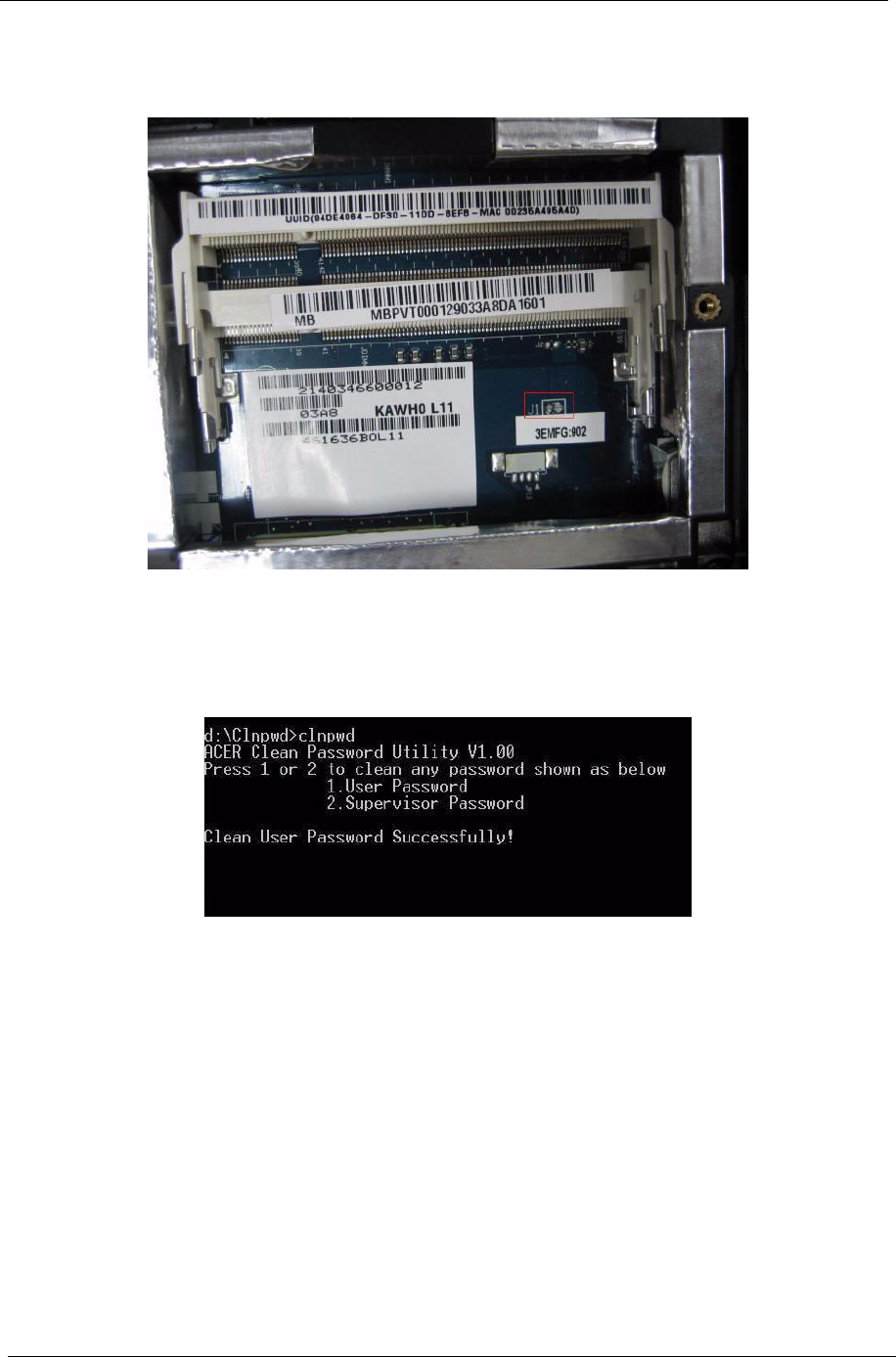
38 Chapter 2
Removing BIOS Passwords:
To clear the User or Supervisor passwords, open the RAM door and use a metal instrument to short the J1
jumper.
Cleaning BIOS Passwords
To clean the User or Supervisor passwords, perform the following steps:
1. From a DOS prompt, execute clnpwd.exe
2. Press 1 or 2 to clean the desired password shown on the screen.
The onscreen message determines whether the function is successful or not.
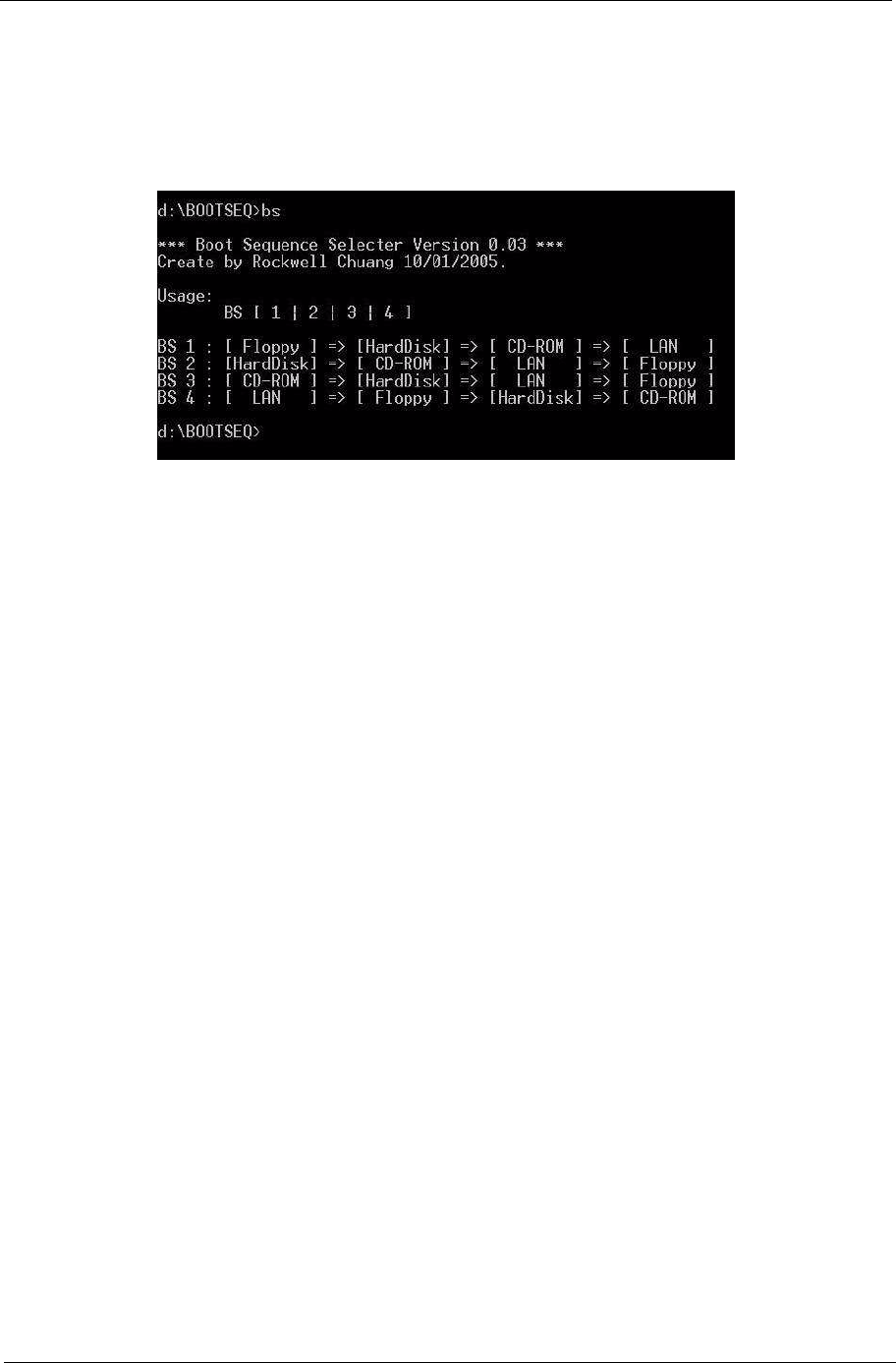
Chapter 2 39
Using Boot Sequence Selector
The Boot Sequence Selector allows the boot order to be changed without accessing the BIOS. To use Boot
Sequence Selector, perform the following steps:
1. Enter into DOS.
2. Execute BS.exe to display the usage screen.
3. Select the desired boot sequence by entering the corresponding sequence. For example, enter BS2 to
change the boot sequence to HDD | CD ROM | LAN | Floppy.

40 Chapter 2
Using DMITools
The DMI (Desktop Management Interface) Tool copies BIOS information to EEPROM to be used in the DMI
pool for hardware management.
When the BIOS displays Verifying DMI pool data it is checking that the table correlates with the hardware
before sending to the operating system (Windows, etc.).
To update the DMI Pool, perform the following steps:
1. Boot into DOS.
2. Execute dmitools. The following messages report to screen to confirm completion:
• dmitools /r ==> Read dmi string from bios
• dmitools /wm xxxx ==> Write manufacturer name to eeprom (max. 16 characters)
• dmitools /wp xxxx ==> Write product name to eeprom (max. 16 characters)
• dmitools /ws xxxx ==> Write serial number to eeprom (max. 22 characters)
• dmitools /wu xxxx ==> Write uuid to eeprom
• dmitools /wa xxxx ==> Write asset tag to eeprom (max. 32 characters)
The following examples show the commands and the corresponding output information.
Read DMI Information from Memory
Input:
dmitools /r
Output:
Manufacturer (Type1, Offset04h): Acer
Product Name (Type1, Offset05h): TravelMate xxxxx
Serial Number (Type1, Offset07h): 01234567890123456789
UUID String (Type1, Offset08h): xxxxxxxx-xxxx-xxxx-xxxx-xxxxxxxxxxxx
Asset Tag (Type3, Offset04h): Acet Asstag
Write Product Name to EEPROM
Input:
dmitools /wp Acer
Write Serial Number to EEPROM
Input:
dmitools /ws 01234567890123456789
4 ). Write UUID to EEPROM ( Create UUID from Intel WFM20.pdf )
Input:
dmitools /wu
5). Write Asset Tag to EEPROM
Input:
dmitools /wa Acet Asstag
NOTE: When using any of the Write options, restart the system to make the new DMI data effective.
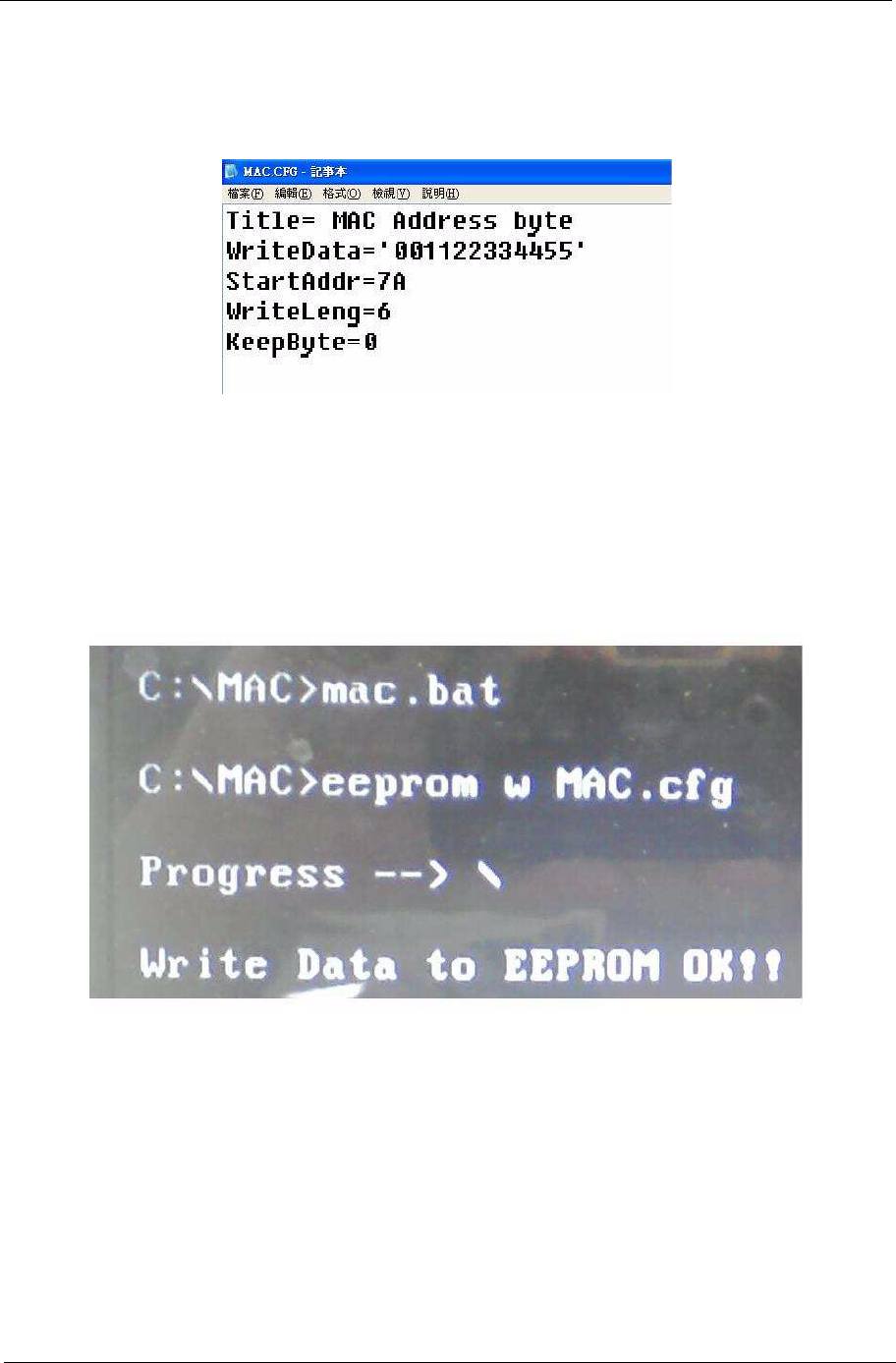
Chapter 2 41
Using the LAN MAC EEPROM Utility
You can use the MAC.BAT utility to write the MAC.CFG file to the EEPROM under DOS mode.
1. Use a text editor (for example: Notepad) to open the MAC.CFG file. You can see the MAC.CFG contents
as below:
2. In DOS mode, run the MAC.BAT file to write MAC values to eeprom.
WriteData = ‘001122334455' MAC value
StartAddr=7A MAC address
WriteLeng=6 MAC value length
KeepByte=0 don’t care

42 Chapter 2

Chapter 3 43
Machine Disassembly and Replacement
IMPORTANT: The outside housing and color may vary from the mass produced model.
This chapter contains step-by-step procedures on how to disassemble the notebook computer for
maintenance and troubleshooting.
Disassembly Requirements
To disassemble the computer, you need the following tools:
•Wrist grounding strap and conductive mat for preventing electrostatic discharge
•Flat screwdriver
•Philips screwdriver
•Plastic flat screwdriver
•Plastic tweezers
NOTE: The screws for the different components vary in size. During the disassembly process, group the
screws with the corresponding components to avoid mismatch when putting back the components.
Chapter 3
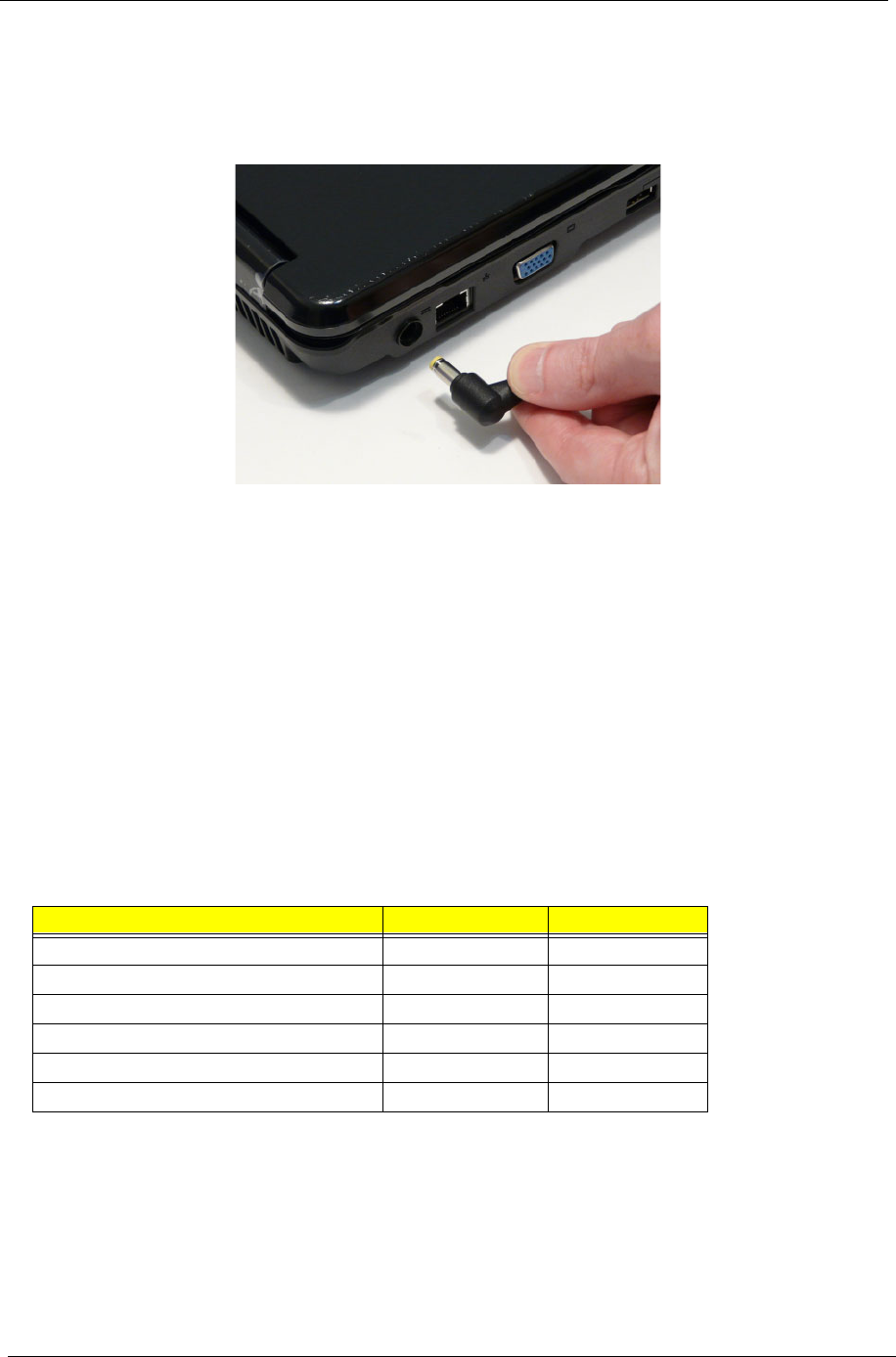
44 Chapter 3
Pre-disassembly Instructions
Before proceeding with the disassembly procedure, make sure that you do the following:
1. Turn off the power to the system and all peripherals.
2. Unplug the AC adapter and all power and signal cables from the system.
3. Place the system on a flat, stable surface.
4. Remove the battery pack.
Disassembly Process
IMPORTANT: The LCD Module cannot be disassembled outside of factory conditions. If any part of the LCD
Module is faulty, such as the camera, antenna or LCD panel, the whole module must be replaced.
The disassembly process is divided into the following stages:
•External module disassembly
•Main unit disassembly
•LCD module disassembly
The flowcharts provided in the succeeding disassembly sections illustrate the entire disassembly sequence.
Observe the order of the sequence to avoid damage to any of the hardware components. For example, if you
want to remove the mainboard, you must first remove the keyboard, then disassemble the inside assembly
frame in that order.
Main Screw List
Screw Quantity Part Number
SCREW M2.48D 4.0L K 5.5D 0.8T ZKNL 1 86.N2802.001
SCREW M2.48D 6.0L K 5.5D 0.8T ZKNL 6 86.N2802.002
SCREW M2.45D 8.0L K 5.5D 0.8T ZKNL 30 86.N2802.003
SCREW M1.98D 3.0L K 4.6D 0.8T ZKNL 4 86.N2802.004
SCREW M M 3.0D 3.0L K 4.9D NI + 4 86.N2802.005
SCREW M M 2.5D 3.2L K 6D NI + 17 86.N2802.006
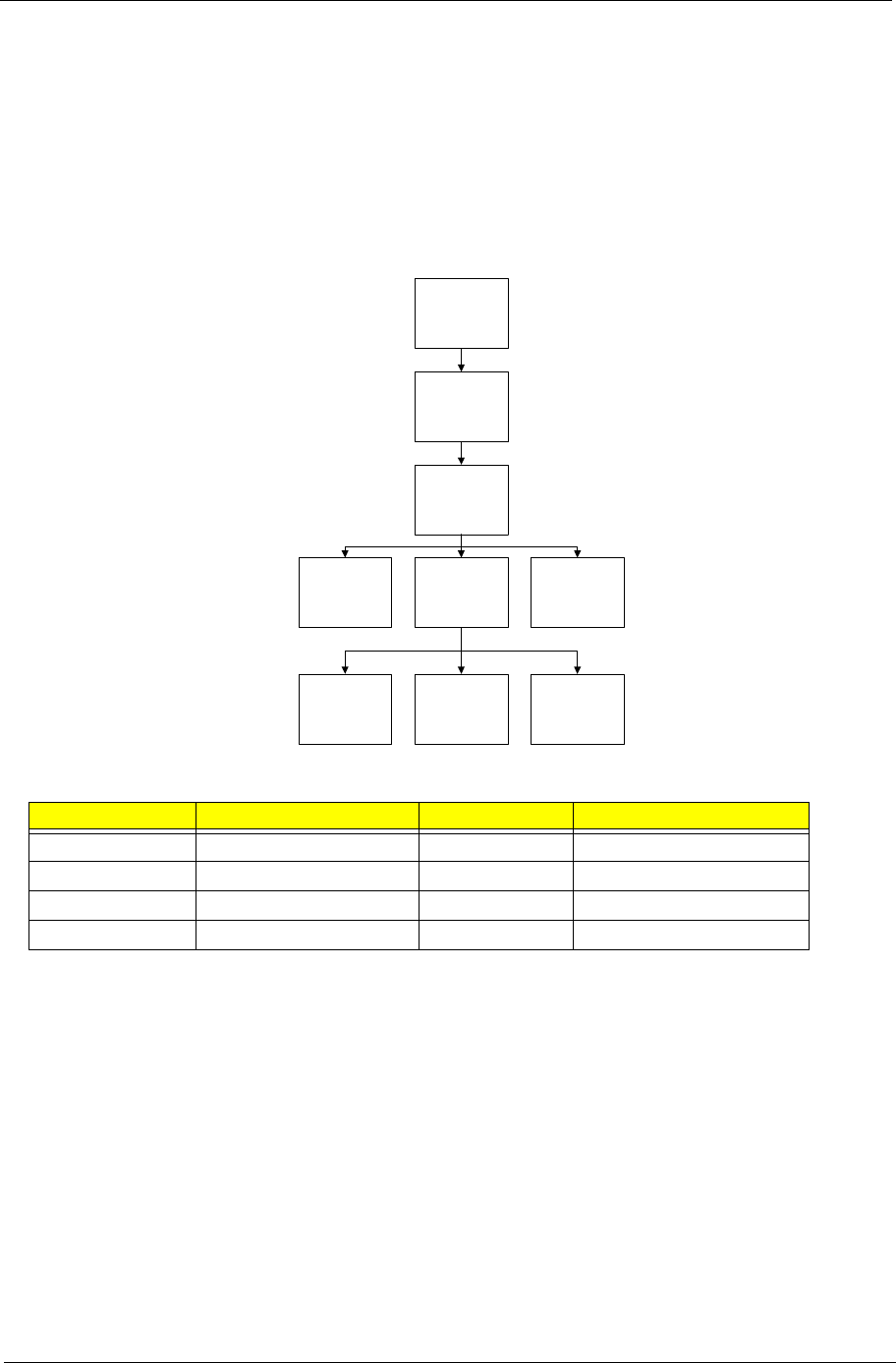
Chapter 3 45
External Module Disassembly Process
IMPORTANT: The outside housing and color may vary from the mass produced model.
External Modules Disassembly Flowchart
The flowchart below gives you a graphic representation of the external module disassembly sequence and
instructs you on the components that need to be removed during servicing. For example, if you want to remove
the keyboard, you must first remove the switch board.
Screw List
Step Screw Quantity Part No.
Lower Covers M2.5*8 3 86.N2802.003
ODD Module M2.5*8 1 86.N2802.003
WLAN Module M2*3 2 86.N2802.006
HDD Carrier M3*3 4 86.N2802.005
Disconnect power
and signal cables
from system
Remove
Battery
Turn off system
and peripherals
power
Remove
DIMMs
Remove
WLAN
Remove
HDD
Remove
ODD
Remove
Lower Covers
Remove
Dummy Card
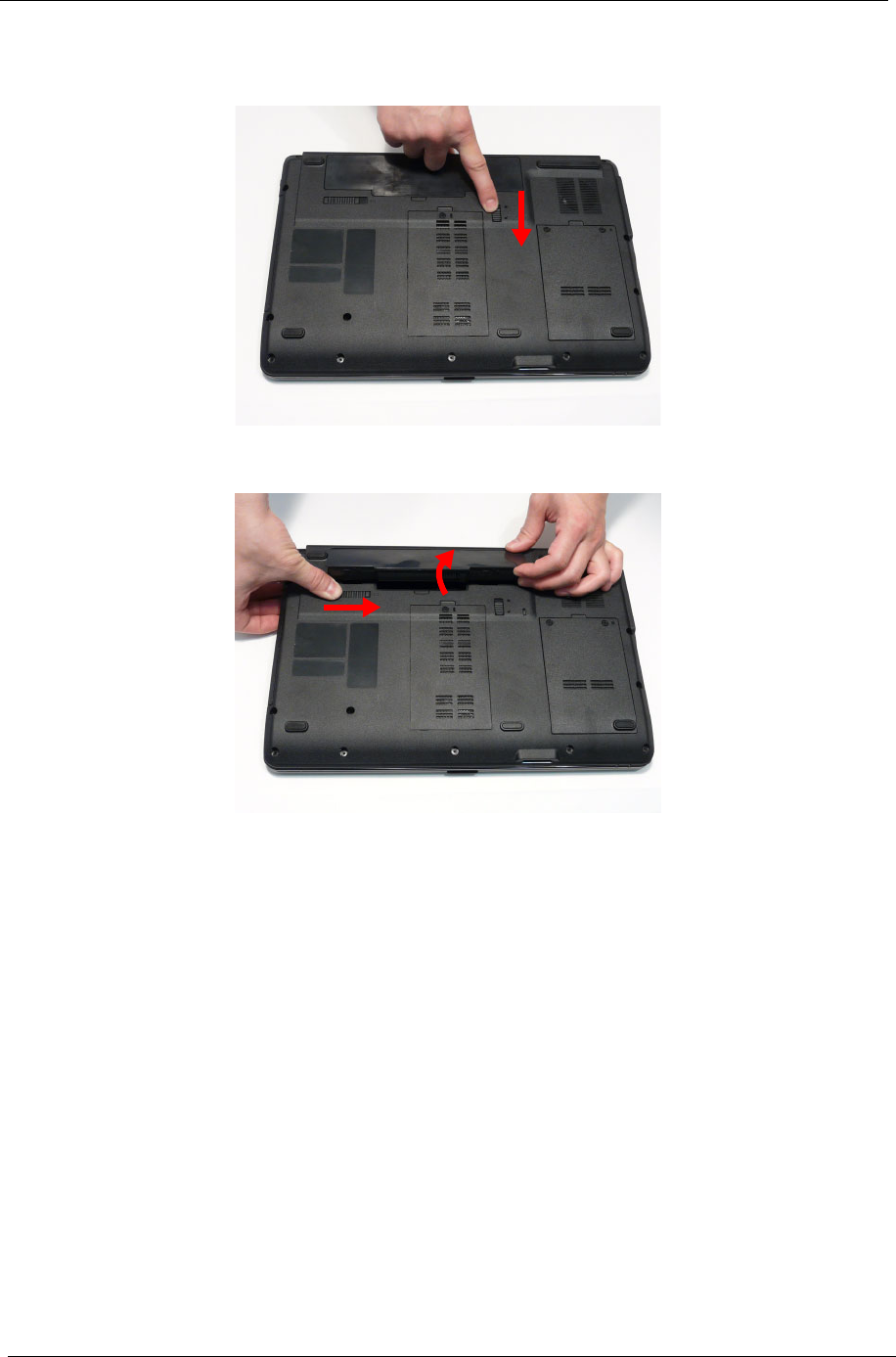
46 Chapter 3
Removing the Battery Pack
1. Turn computer over. Slide the battery lock in the direction shown.
2. Slide and hold the battery release latch to the release position (1), then lift out the battery pack from the main
unit (2).
1
2
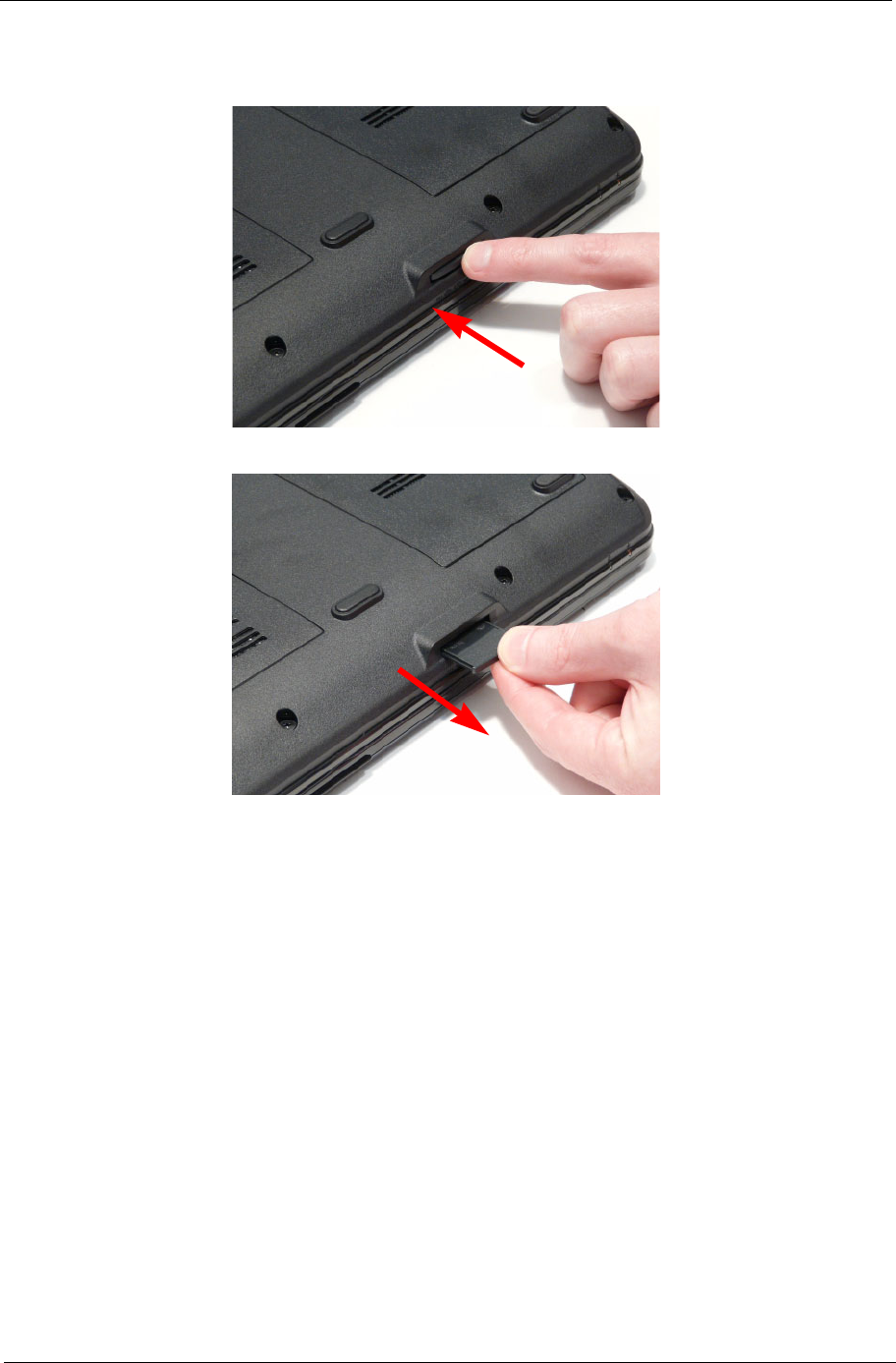
Chapter 3 47
Removing the SD Dummy Card
1. Push the SD dummy card all the way in to eject it.
2. Pull it out from the slot.
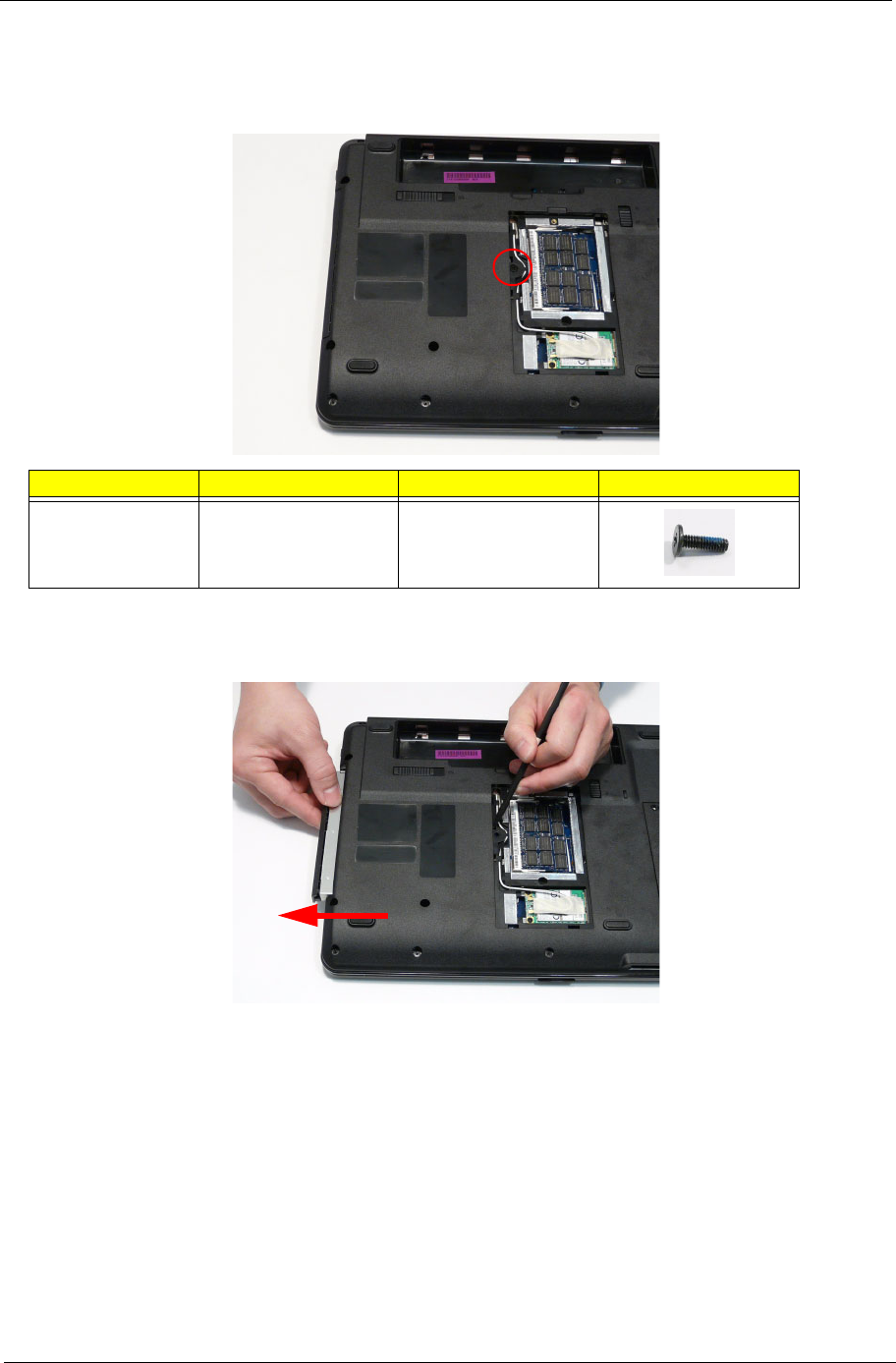
Chapter 3 49
Removing the Optical Drive Module
1. See “Removing the Battery Pack” on page 46.
2. Remove the screw securing the ODD module.
3. Insert a suitable tool into the access slot in the battery bay as shown. Gently lever the ODD module out of the
chassis.
4. Pull the optical drive module out from the chassis.
Step Size Quantity Screw Type
ODD Module M2.5*8 1
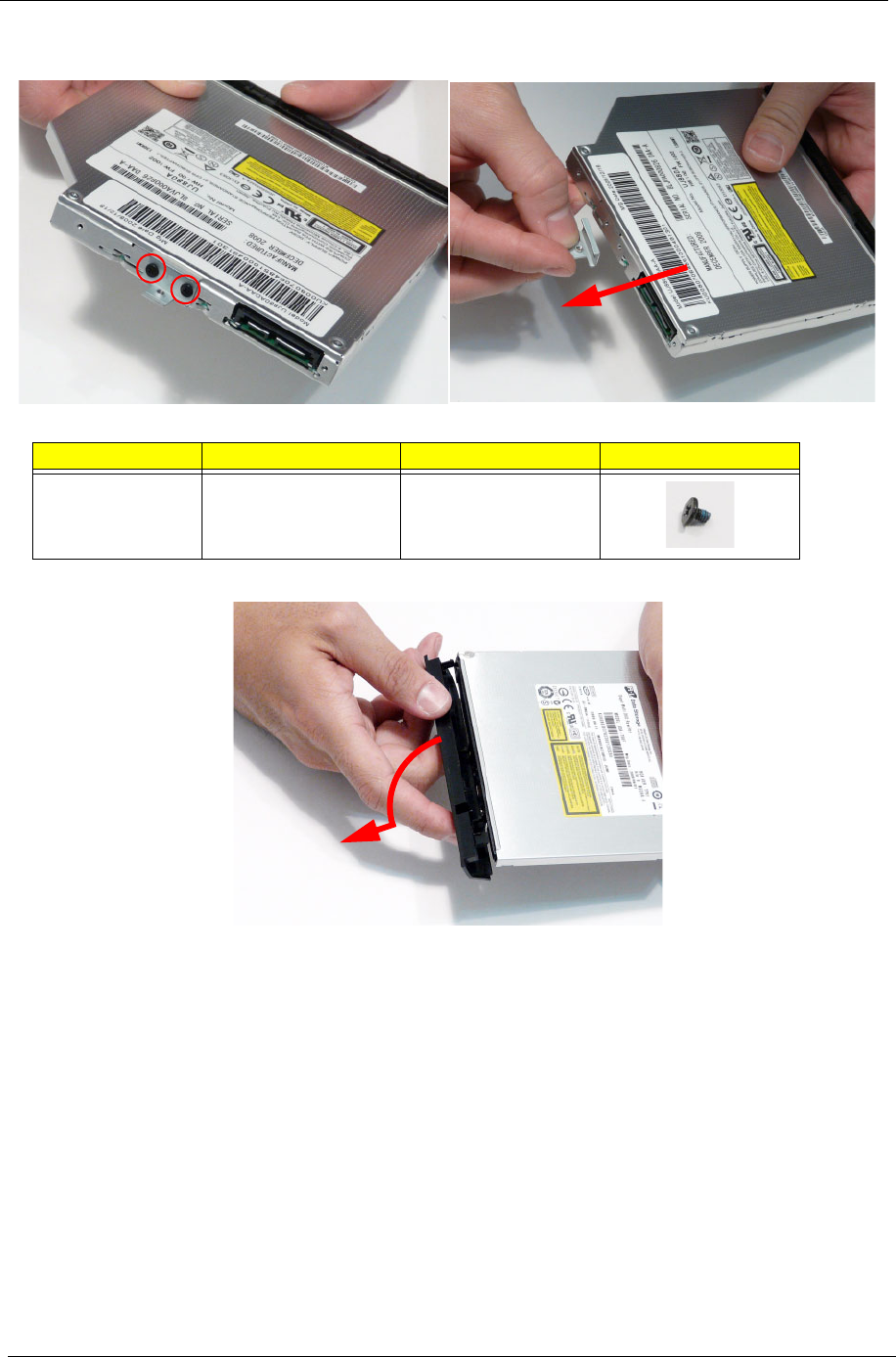
50 Chapter 3
5. Remove the two screws securing the ODD bracket and remove the ODD bracket from the optical disk drive
module.
6. Remove the ODD bezel by rotating the top edge downward and pulling it clear of the module.
Step Size Quantity Screw Type
ODD Bracket M2*3 2
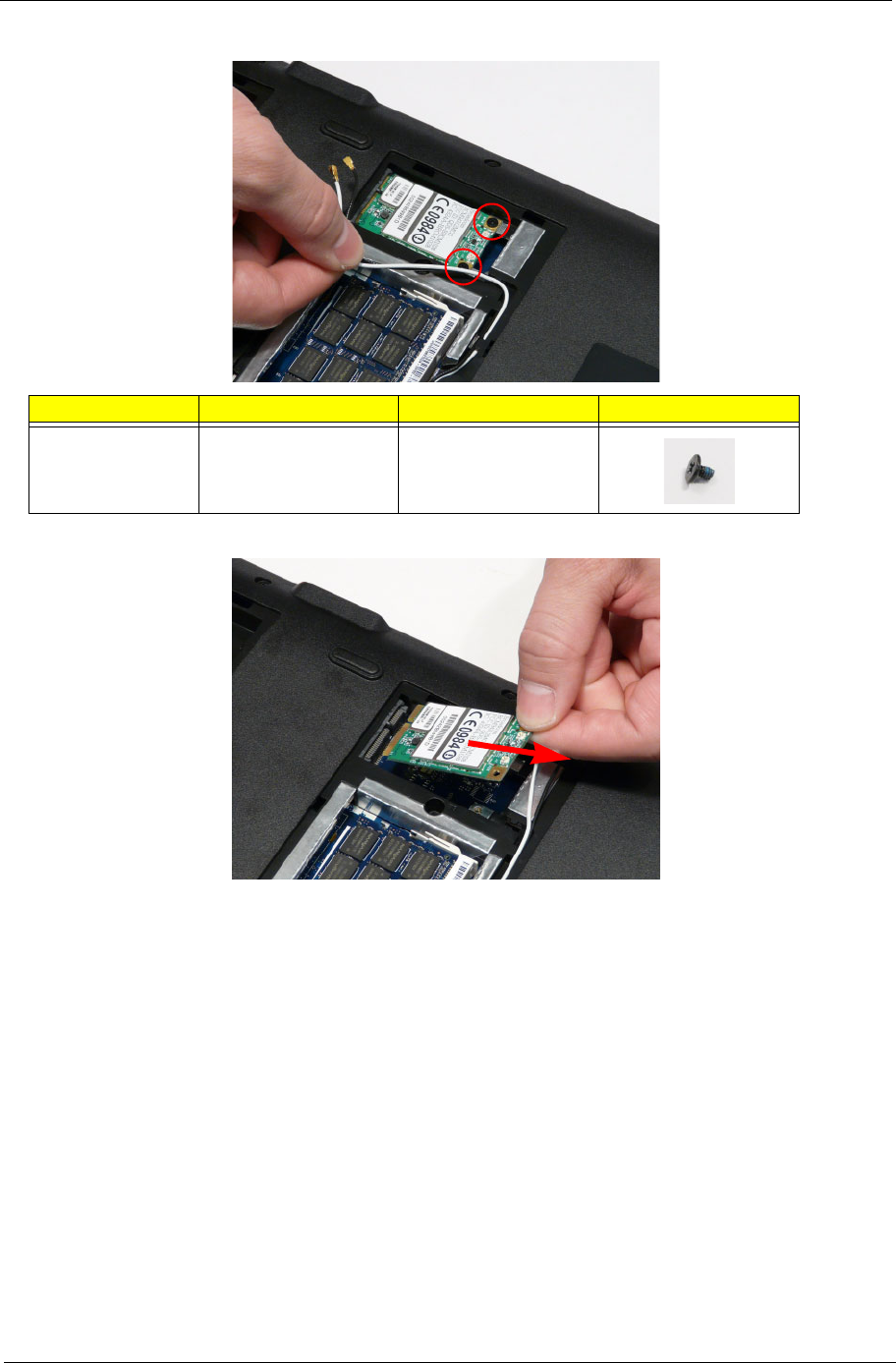
Chapter 3 53
4. Move the antenna away and remove the two screws to release the WLAN Board.
5. Detach the WLAN Board from the WLAN socket.
NOTE: When reattaching the antennas, ensure the cables are tucked into the chassis to prevent damage.
Step Size Quantity Screw Type
WLAN Module M2*3 2
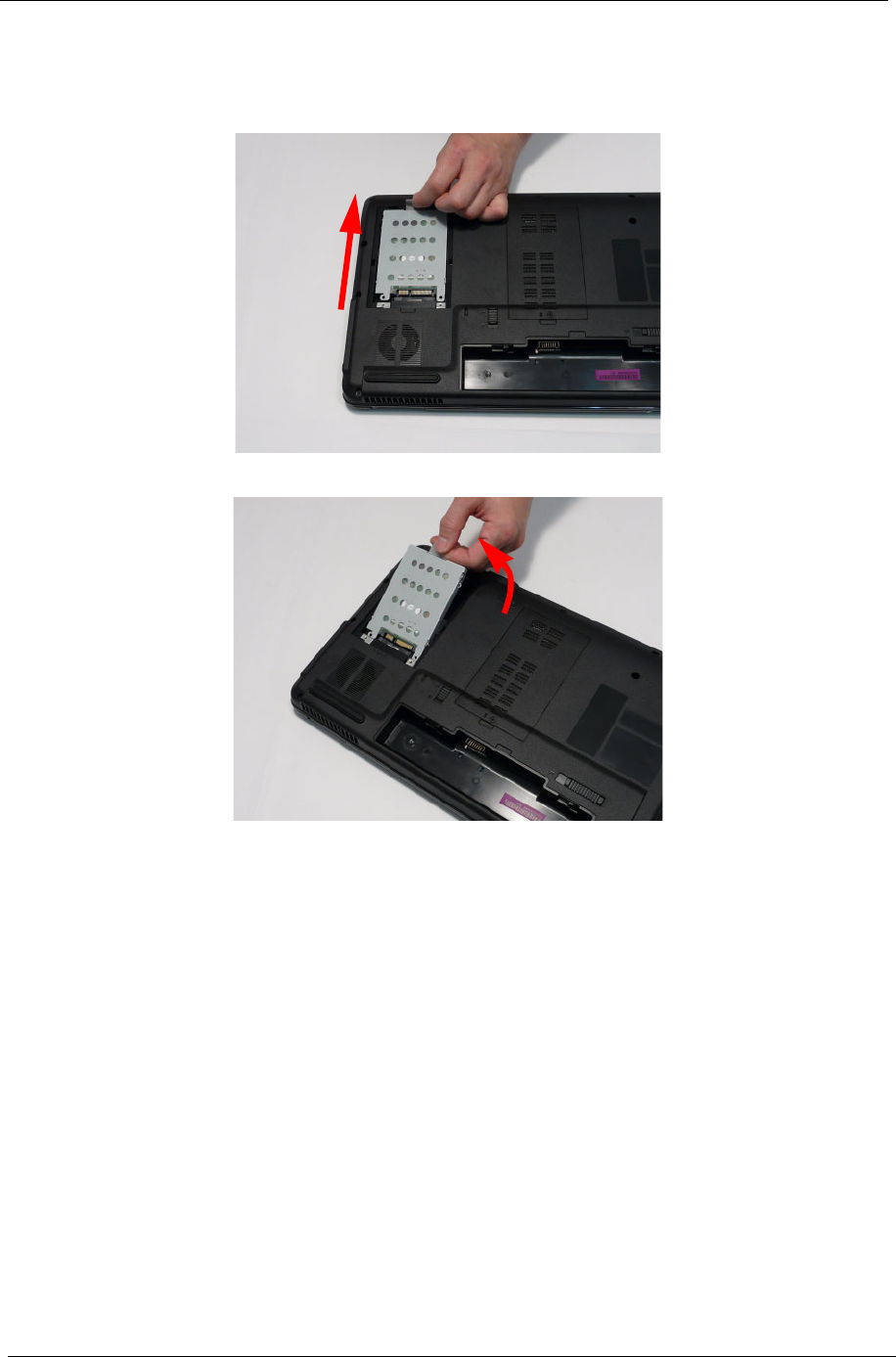
54 Chapter 3
Removing the Hard Disk Drive Module
1. See “Removing the Lower Covers” on page 48.
2. Using the pull-tab, slide the HDD Module in the direction of the arrow to disconnect the interface.
3. Lift the HDD Module clear of the HDD bay.
NOTE: To prevent damage to device, avoid pressing down on it or placing heavy objects on top of it.
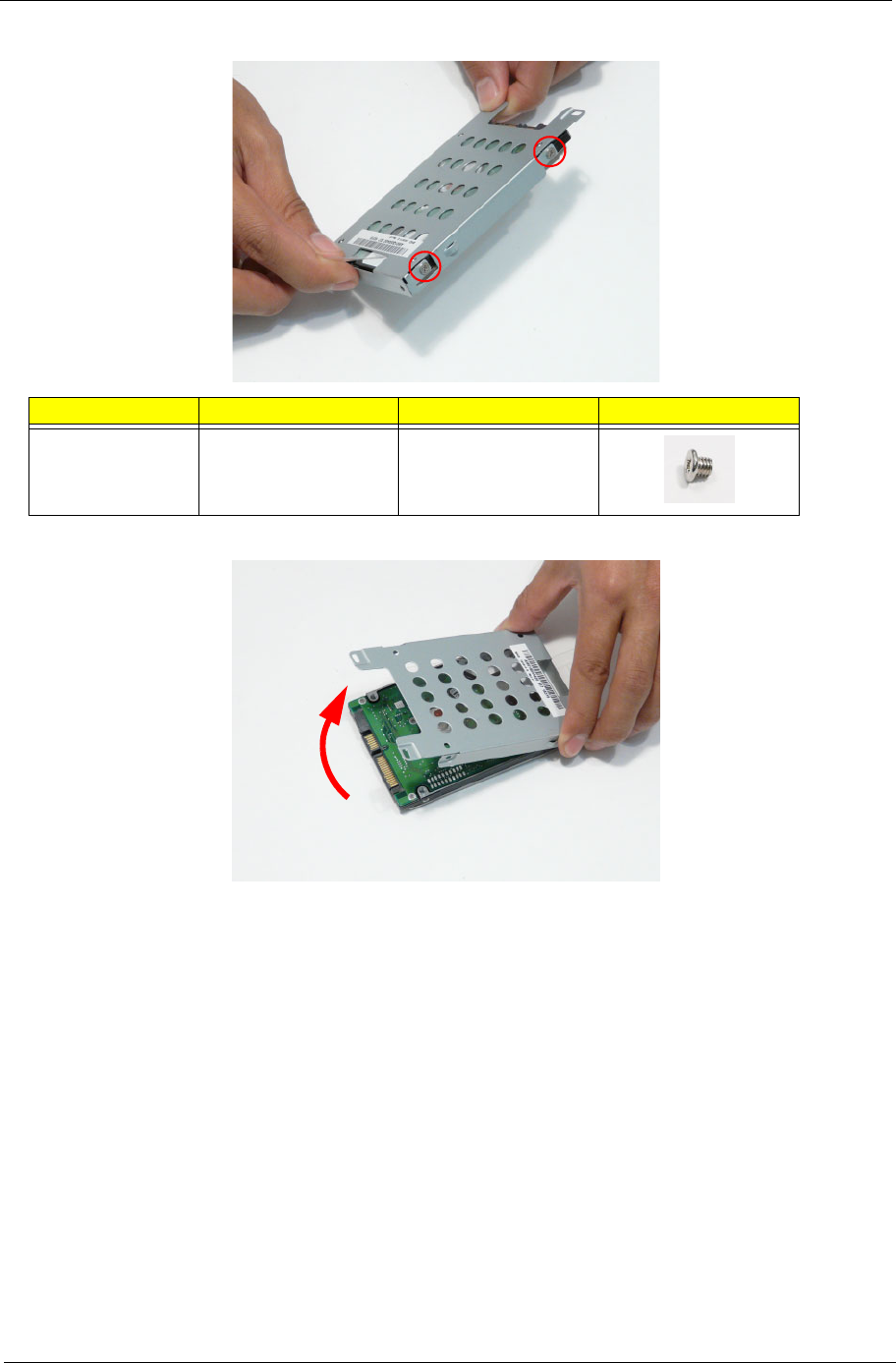
Chapter 3 55
4. Remove the four screws (two each side) securing the hard disk to the carrier.
5. Remove the HDD from the carrier.
Step Size Quantity Screw Type
HDD Carrier M3*3 4
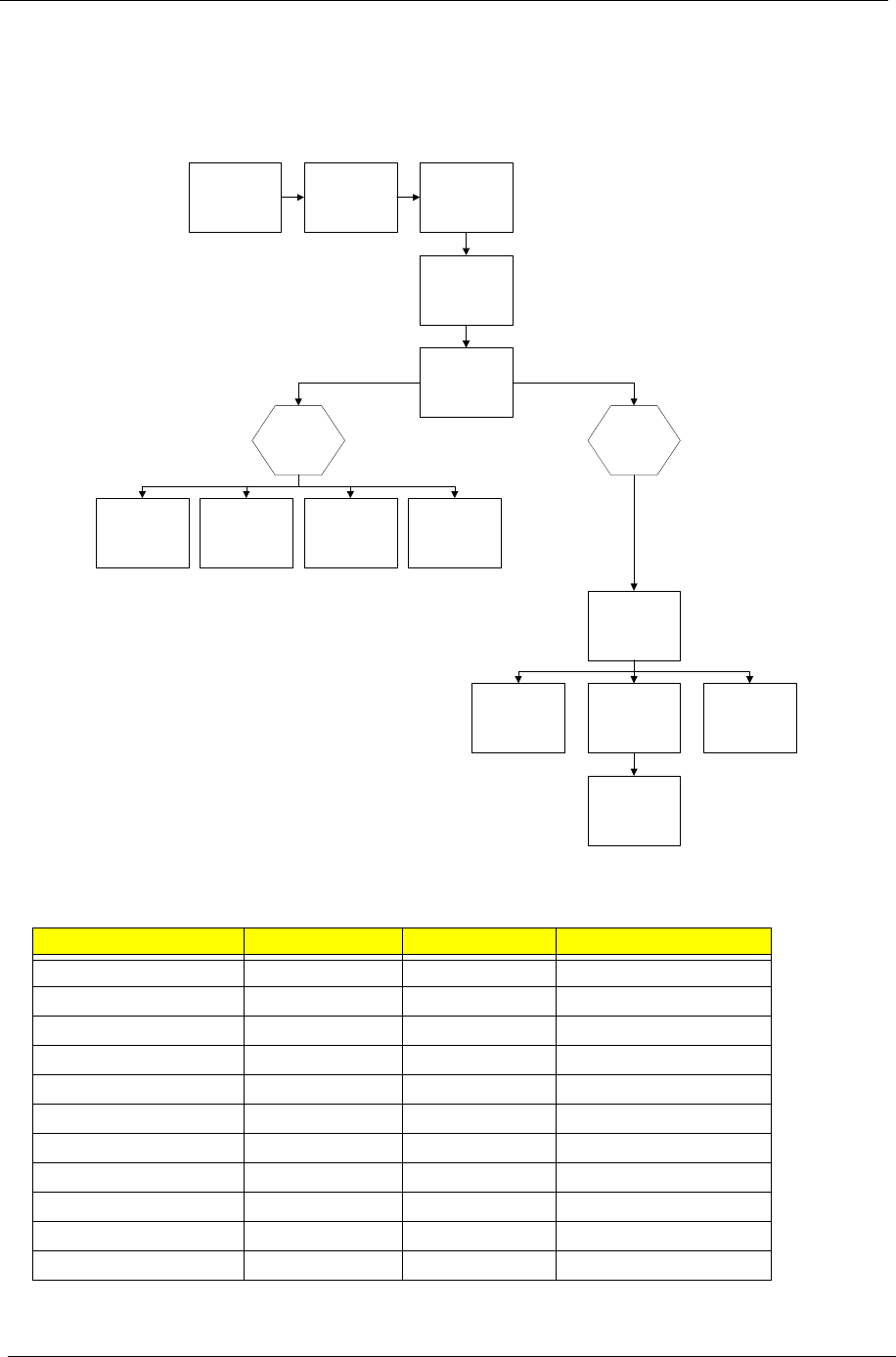
56 Chapter 3
Main Unit Disassembly Process
Main Unit Disassembly Flowchart
Screw List
Step Screw Quantity Part No.
LCD Module M2.5*8 2 86.N2802.003
LCD Module M2.5*8 4 86.N2802.003
Upper Cover M2.5*8 11 86.N2802.003
Upper Cover M2.5*8 9 86.N2802.003
Power Board M2*3 2 86.N2802.006
Left Speaker Module M2*3 1 86.N2802.006
Right Speaker Module M2*3 1 86.N2802.006
TouchPad Bracket M2*3 2 86.N2802.006
Mainboard M2.5*4 1 86.N2802.001
Thermal Module M1.98*3.0 4 86.N2802.004
CPU Fan M2*3 3 86.N2802.006
Remove
Mainboard
Remove
Switch Cover
Remove
Keyboard
Remove
Upper Cover
Remove
LCD Module
Remove
Power Board
Remove External
Modules before
proceeding
Remove
TouchPad
Bracket
Upper
Cover
Lower
Cover
Remove
Left Speaker
Module
Remove
CPU
Remove
RTC Battery
Remove
Thermal Module
Remove
Right Speaker
Module
Remove
CPU Fan
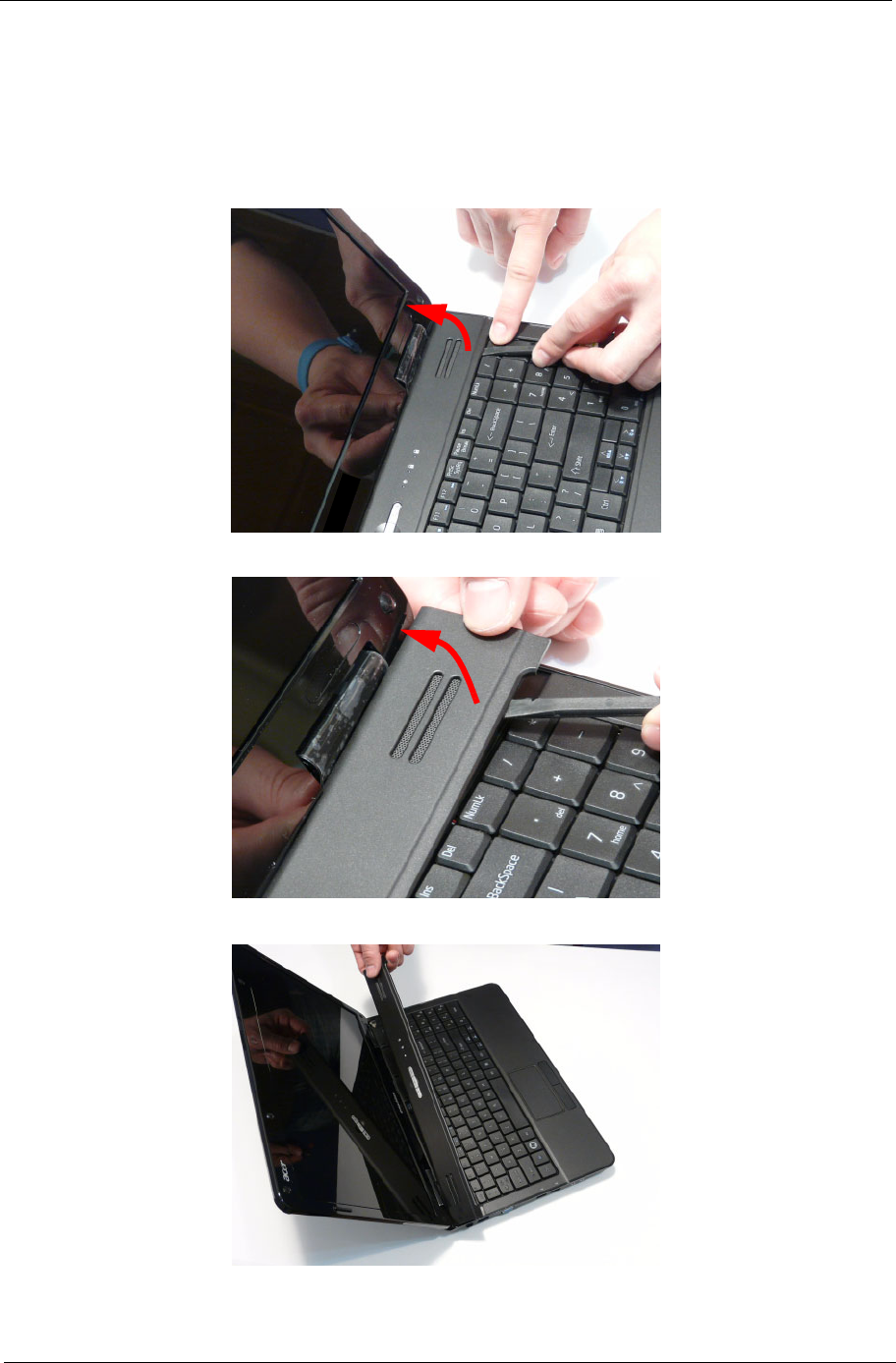
Chapter 3 57
Removing the Switch Cover
CAUTION: Using metal tools to remove the Switch Cover may cause damage to the outer casing. The use of
plastic tools or fingers is recommended to remove the Switch Cover.
1. See “Removing the Battery Pack” on page 46.
2. Turn the computer over. Press down the / and * keys on the right side of the Keyboard to expose the cutout.
Insert a suitable plastic tool (or finger) and pry the Switch Cover upward, away from the Upper Cover.
3. Work along the Switch Cover toward the left hinge, gently prying up the cover as shown.
4. Lift the Switch Cover clear of the computer.
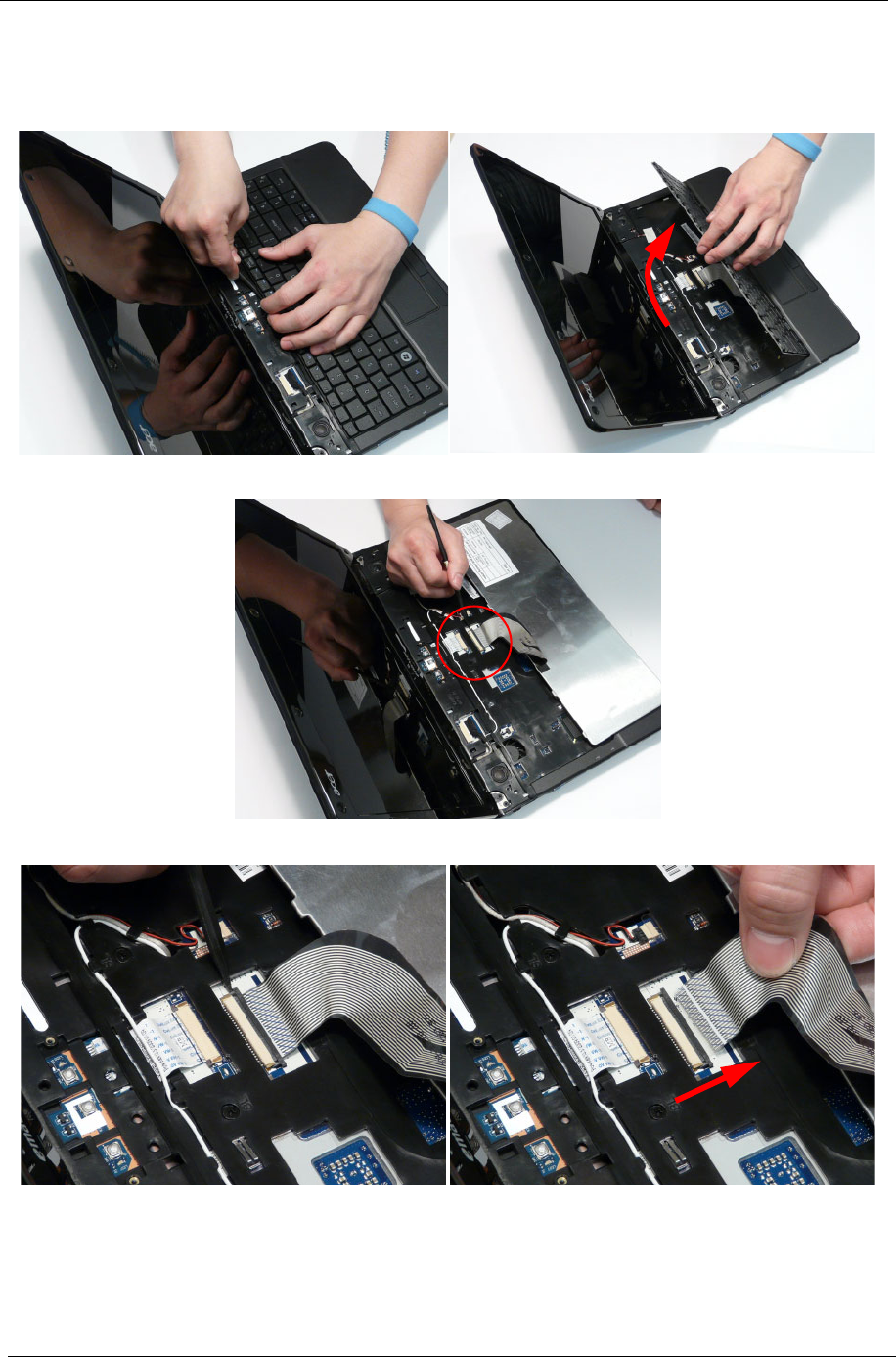
58 Chapter 3
Removing the Keyboard
1. See “Removing the Switch Cover” on page 57.
2. Pry up the centre of the Keyboard and rotate it upward away from the Upper Cover.
3. Turn the keyboard over on to the TouchPad area to expose the FFC connector.
4. Open the locking latch and disconnect the FFC from the mainboard.
5. Lift the keyboard clear of the Upper Cover.
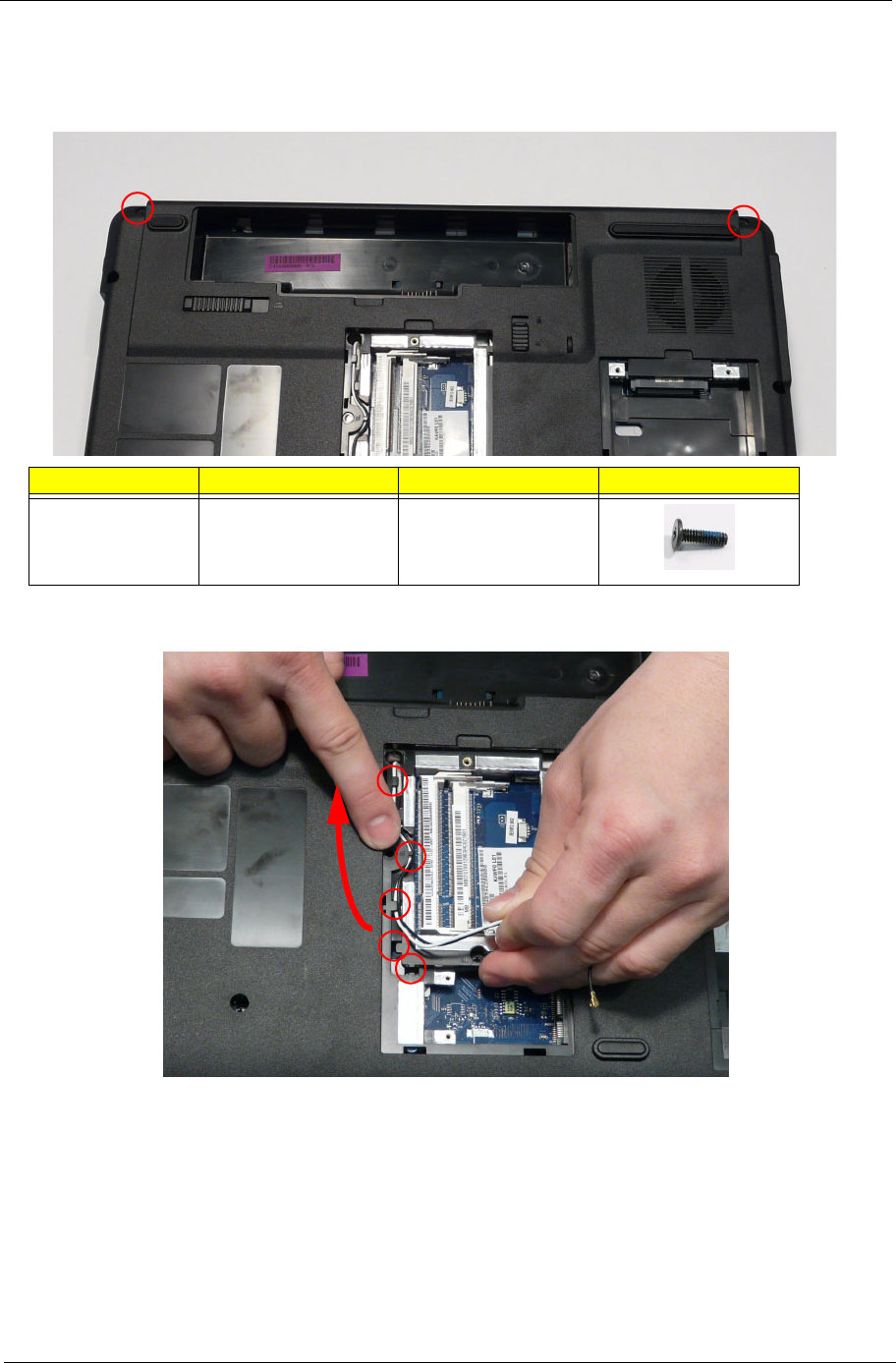
Chapter 3 59
Removing the LCD Module
1. See “Removing the Keyboard” on page 58.
2. Turn the computer over. Remove the two securing screws from the bottom of the chassis.
3. Remove the Antenna Cables from the cable channel as shown. Ensure that the cables are free from all cable
clips.
Step Size Quantity Screw Type
LCD Module M2.5*8 2
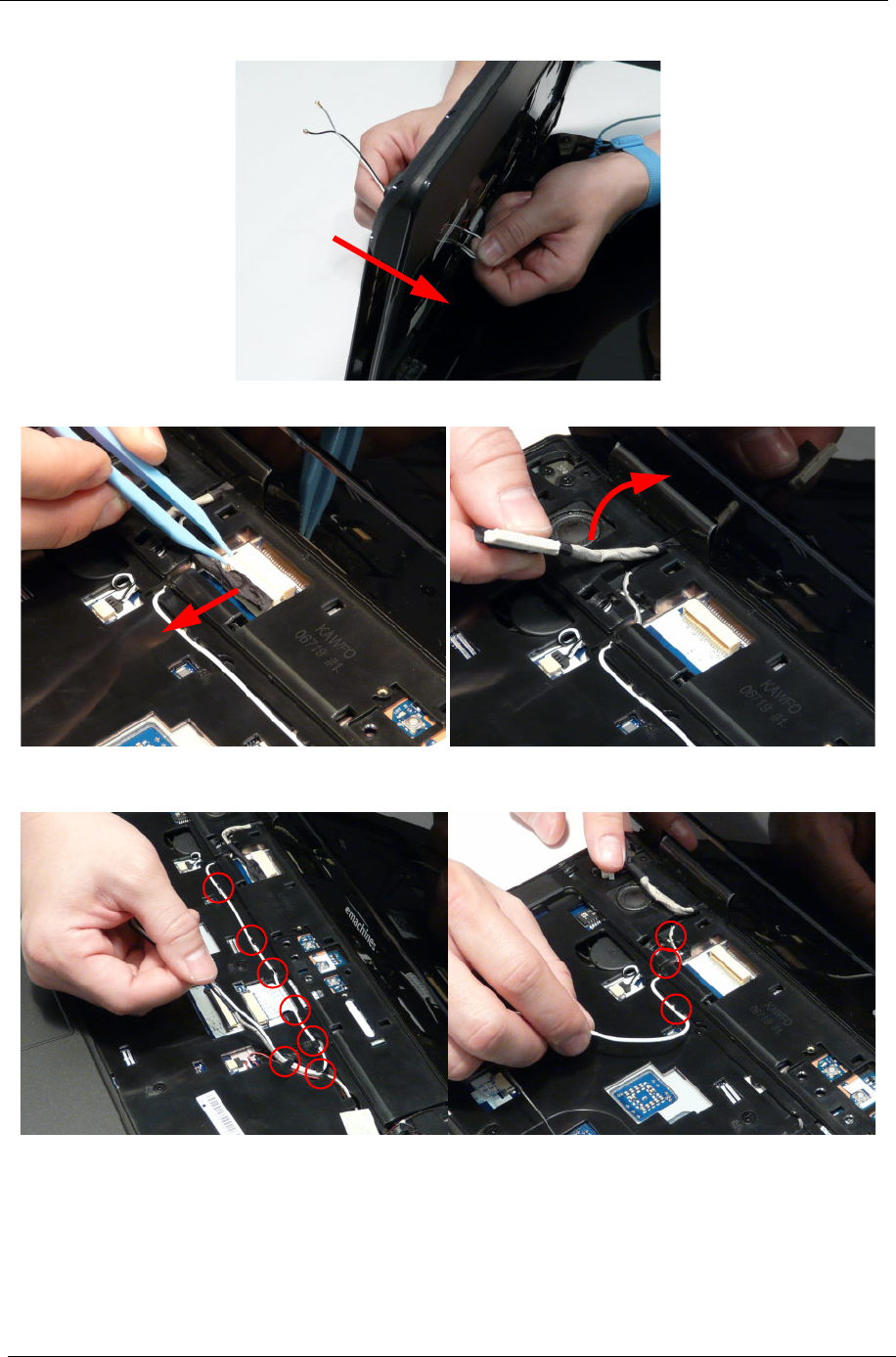
60 Chapter 3
4. Stand the computer on the LCD Panel and pull the Antenna cables completely through the chassis.
5. Disconnect the LCD cable from the Mainboard and remove the cable from the cable channel.
6. Remove the white Antenna cable from the cable channel. Ensure that the cable is completely free of the
retaining clips all the way to the hinge well.
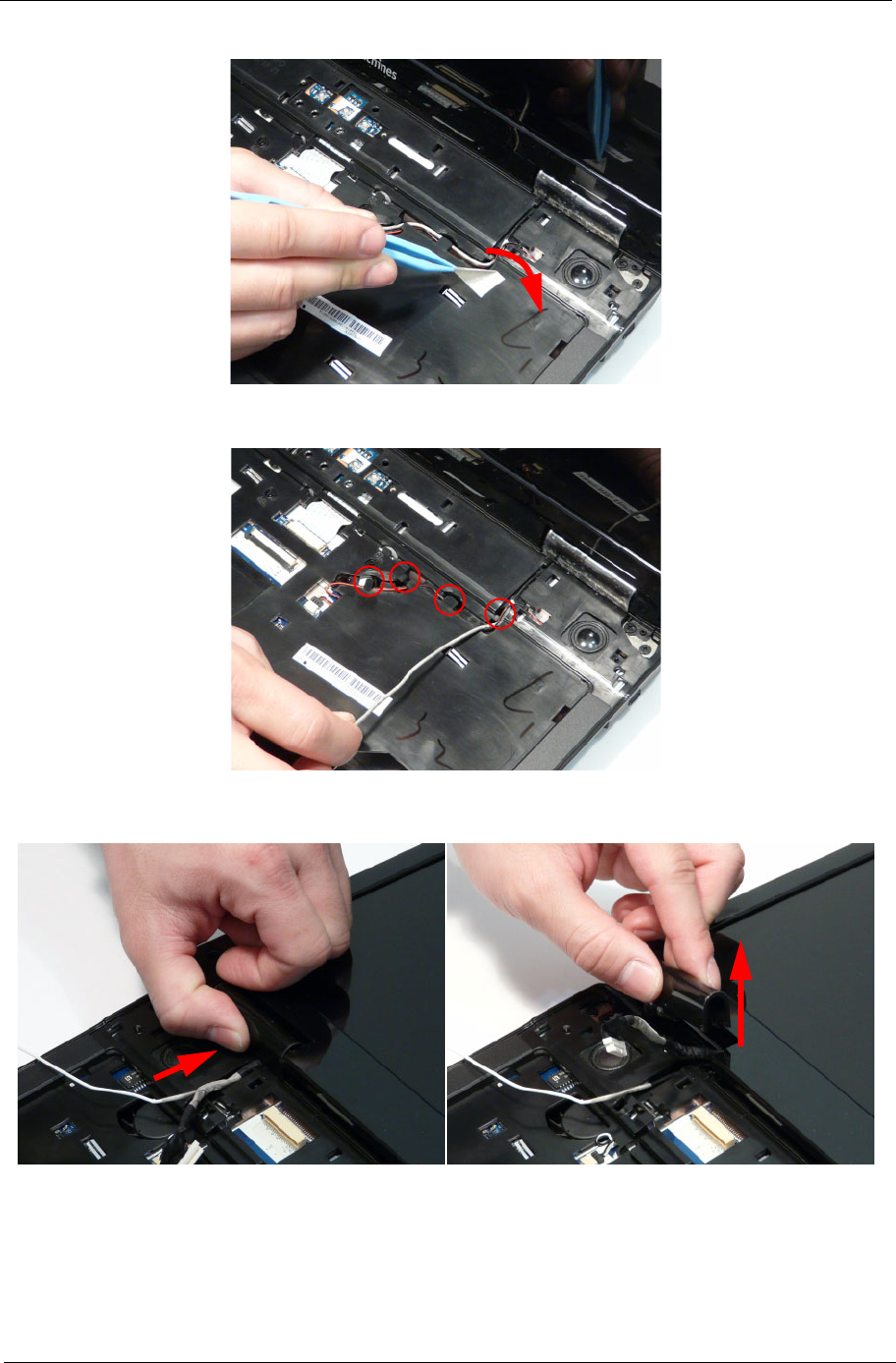
Chapter 3 61
7. Remove the adhesive tape securing the Antenna cable to the Upper Cover.
8. Remove the black Antenna cable from the cable channel as shown. Ensure that the cable is completely free of
the retaining clips all the way to the hinge well.
9. Open the LCD Panel to the full extent to expose the Hinge Covers.
10. Press the left side Hinge Cover inward, as shown, and lift to remove the cover from the chassis.
11. Repeat the process for the right side Hinge Cover.
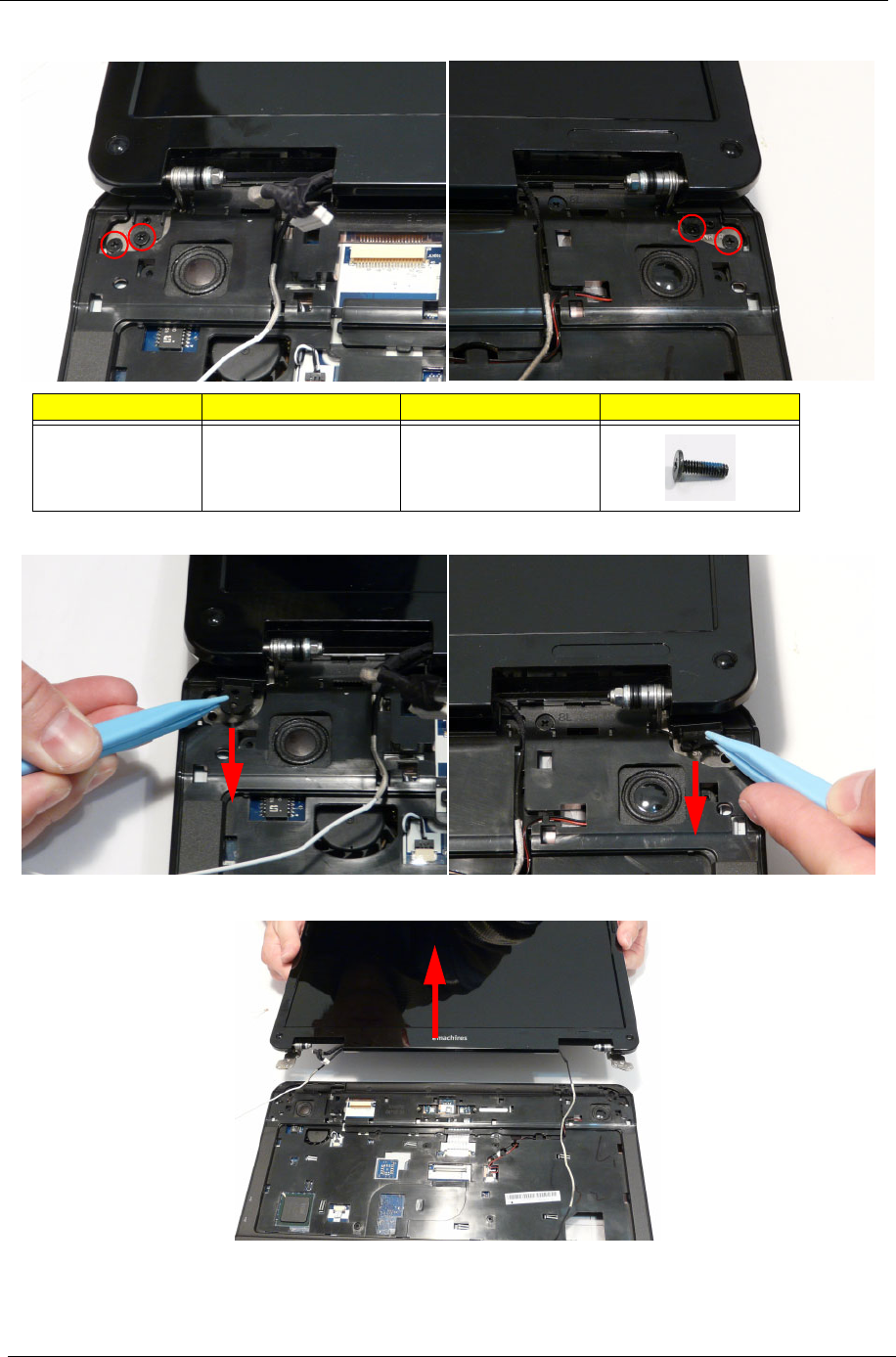
62 Chapter 3
12. Remove the four securing screws (two each side) from the LCD module.
13. Remove the left and right screw covers from on top of the hinges
14. Lift the LCD Module clear of the Upper Cover.
Step Size Quantity Screw Type
LCD Module M2.5*8 4
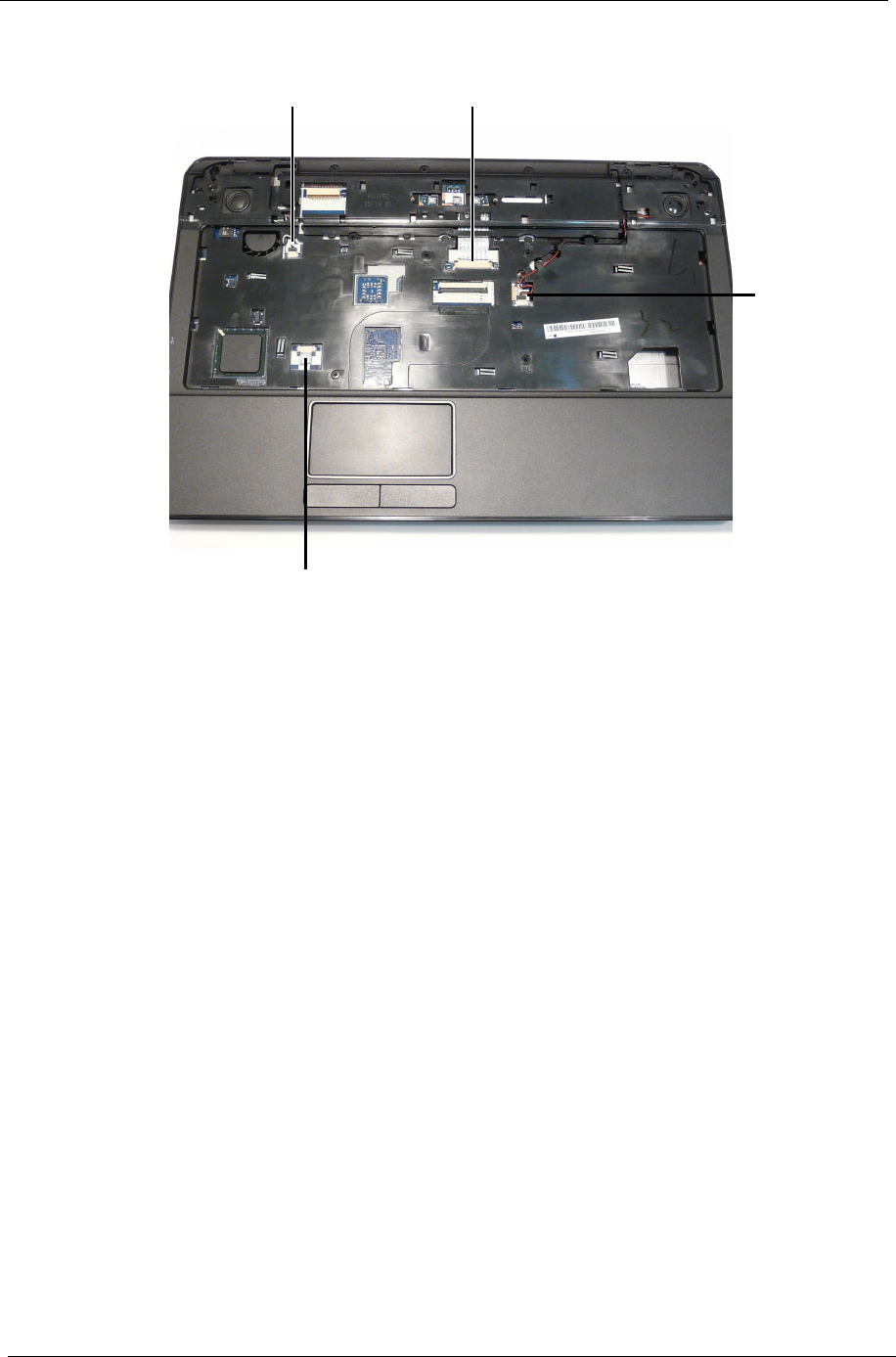
64 Chapter 3
4. Disconnect the following four cables from the Mainboard.
AB
C
D
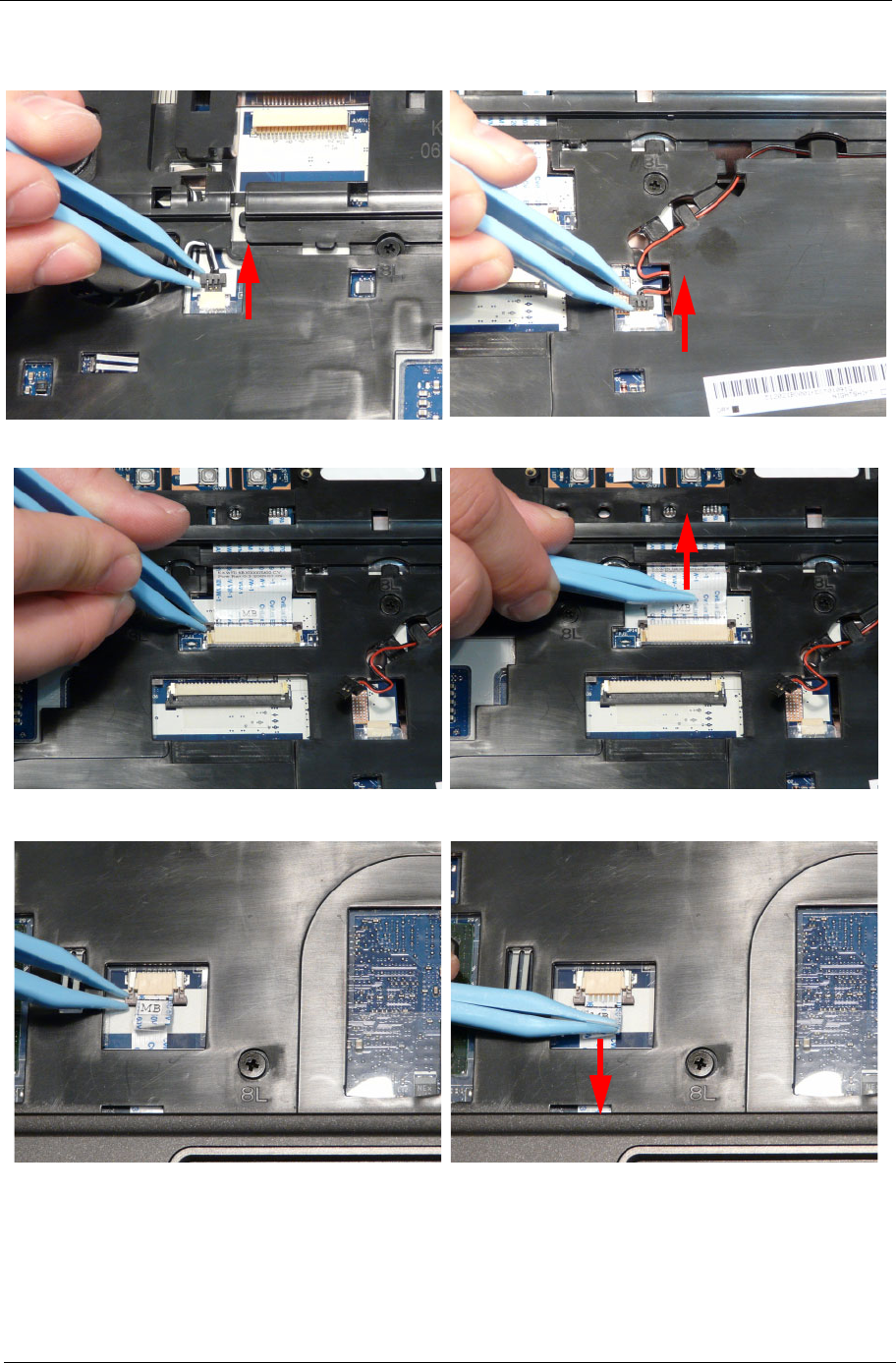
Chapter 3 65
NOTE: Avoid pulling on cables directly to prevent damage to the connectors.
NOTE: Use the pull-tabs on FFCs whenever available to prevent damage.
5. Disconnect A as shown. 6. Disconnect C as shown.
7. Release the locking latch on B and remove the FFC cable as shown.
8. Release the locking latch on D and remove the FFC cable as shown.
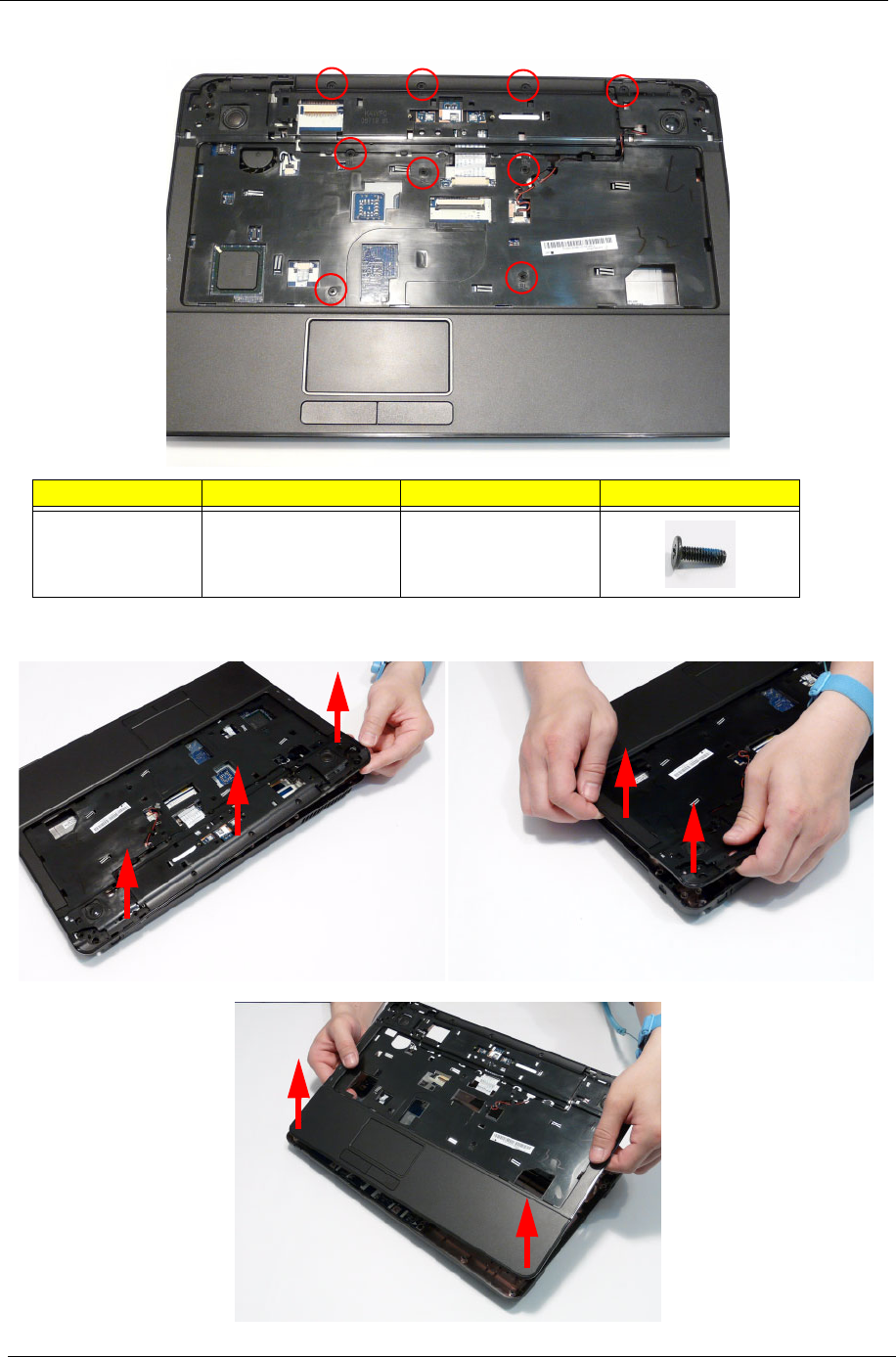
66 Chapter 3
9. Remove the nine screws on the top panel.
10. Starting at the rear left side of the cover, pry apart the Upper and Lower Covers as shown. Work along the back
edge of the casing to the right as shown, then lift the Upper Cover clear of the Lower Cover.
Step Size Quantity Screw Type
Upper Cover M2.5*8 9
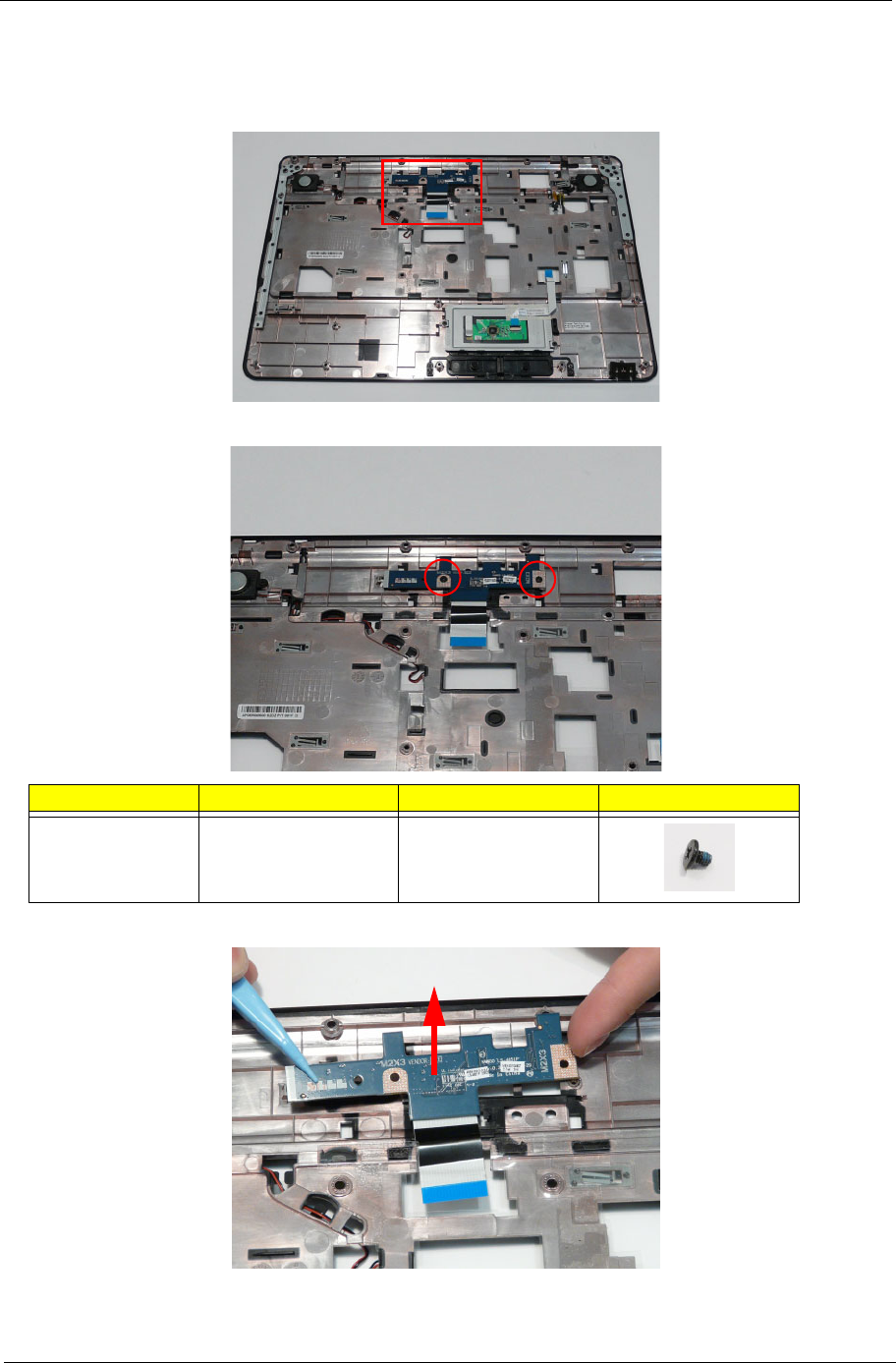
Chapter 3 67
Removing the Power Board
1. See “Removing the Upper Cover” on page 63.
2. Locate the Power Board on the Upper Cover as shown.
3. Remove the two screws securing the Power Board to the Upper Cover.
4. Lift the Power Board clear of the Upper Cover as shown.
Step Size Quantity Screw Type
Power Board M2*3 2
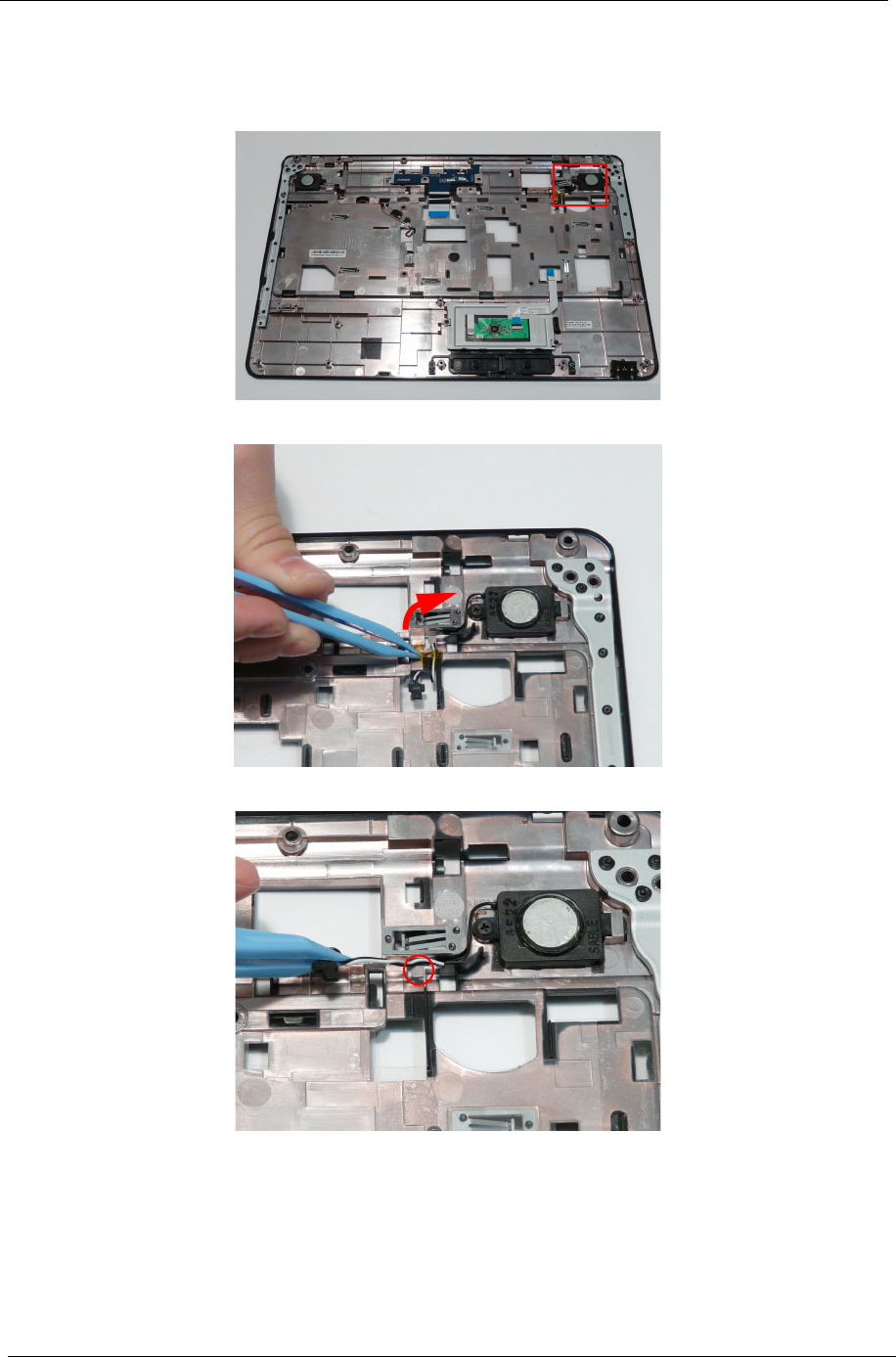
68 Chapter 3
Removing the Left Speaker Module
1. See “Removing the Upper Cover” on page 63.
2. Locate the Left Speaker Module on the Upper Cover as shown.
3. Remove the adhesive tape from the Speaker cable.
4. Remove the Speaker cable from the cable channel. Ensure that the cable is free from all cable clips.
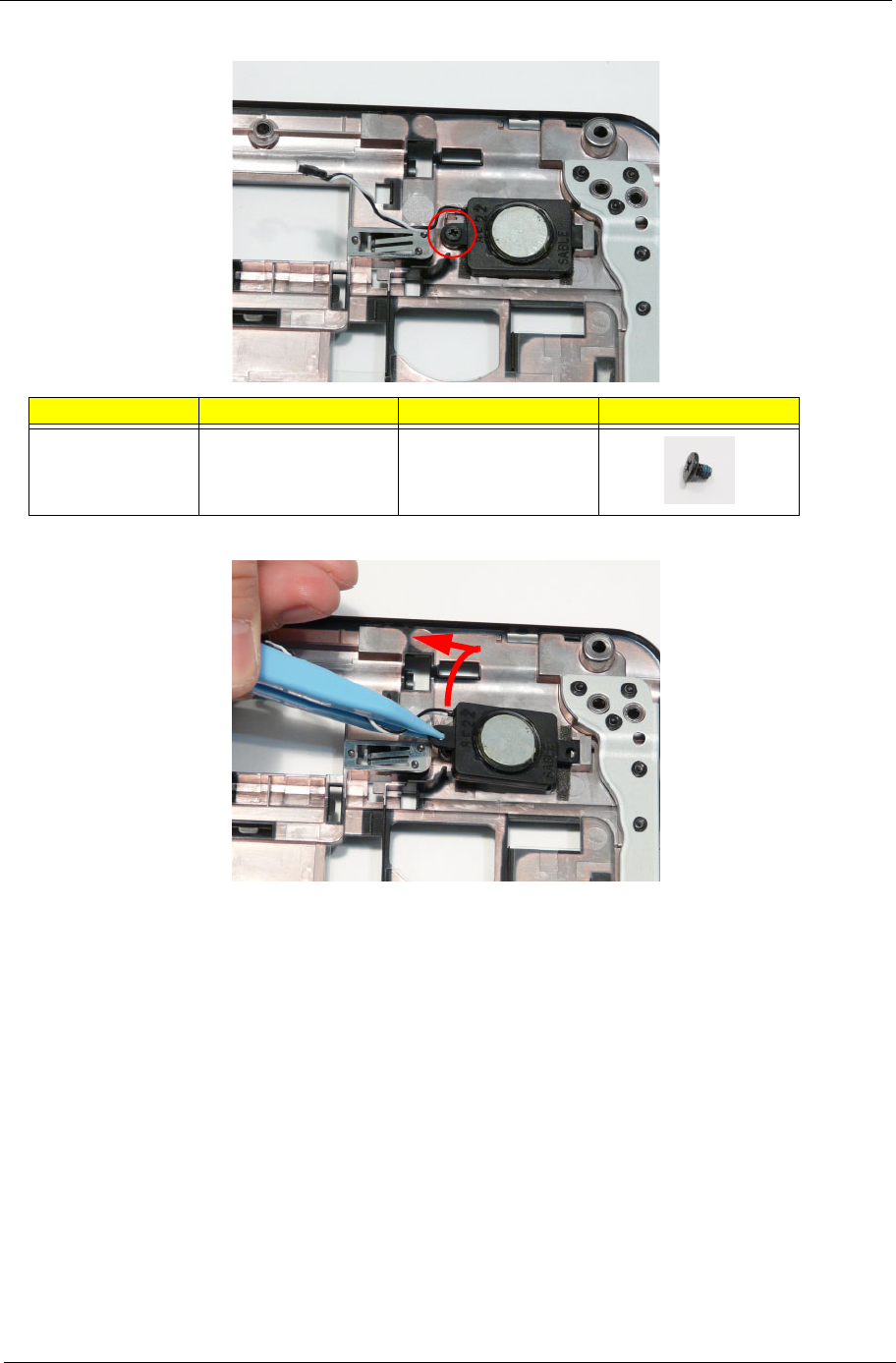
Chapter 3 69
5. Remove the single securing screw from the Left Speaker Module.
6. Lift the Speaker clear of the Upper Cover, left side first as shown.
Step Size Quantity Screw Type
Left Speaker
Module
M2*3 1
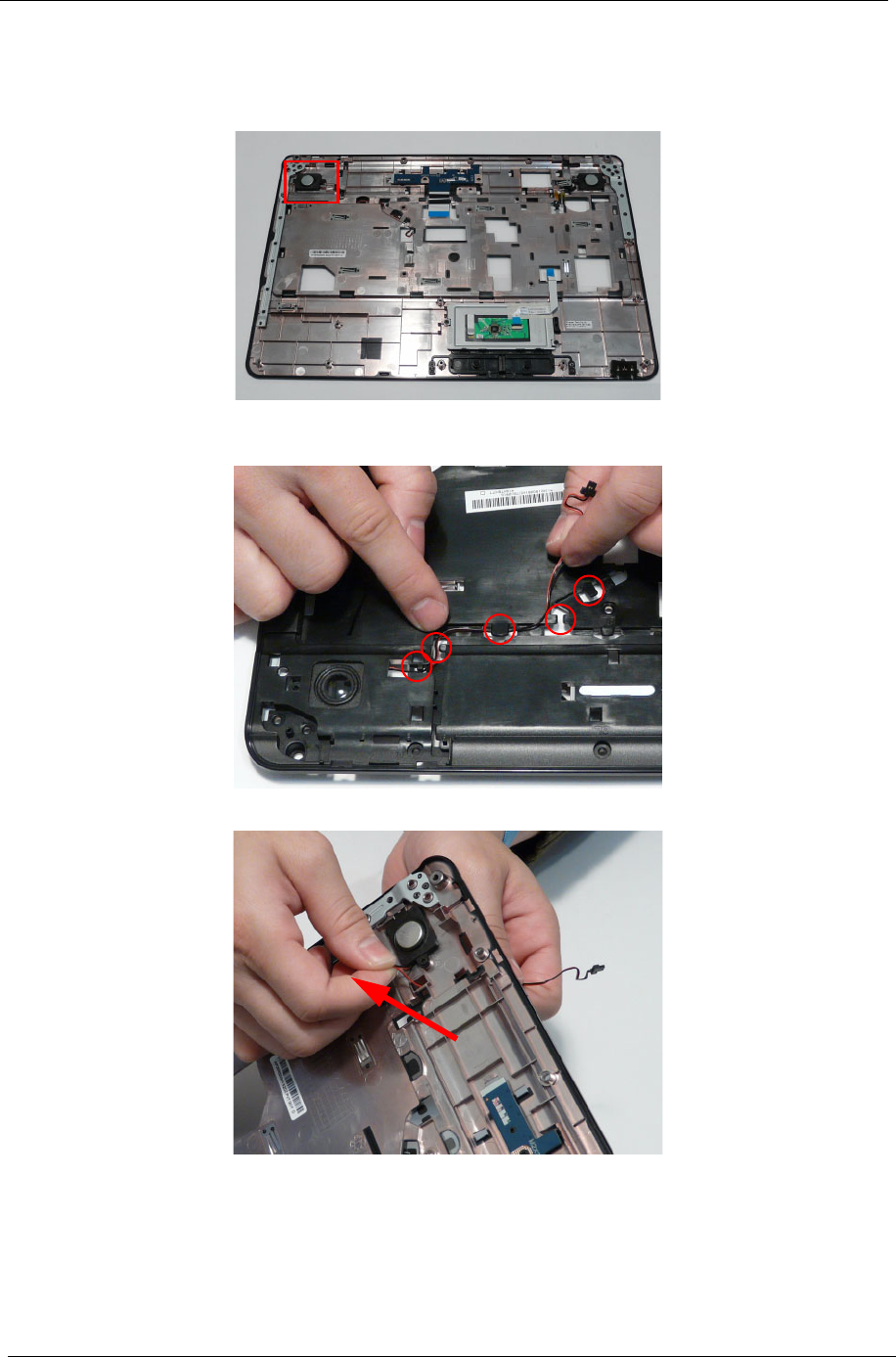
70 Chapter 3
Removing the Right Speaker Module
1. See “Removing the Upper Cover” on page 63.
2. Locate the Right Speaker Module on the Upper Cover as shown.
3. Turn the Upper Cover over and remove the Right Speaker Module cable from the cable channel. Ensure that
the cable is free from all cable clips.
4. Turn the Upper Cover over and pass the cable through the cover as shown.
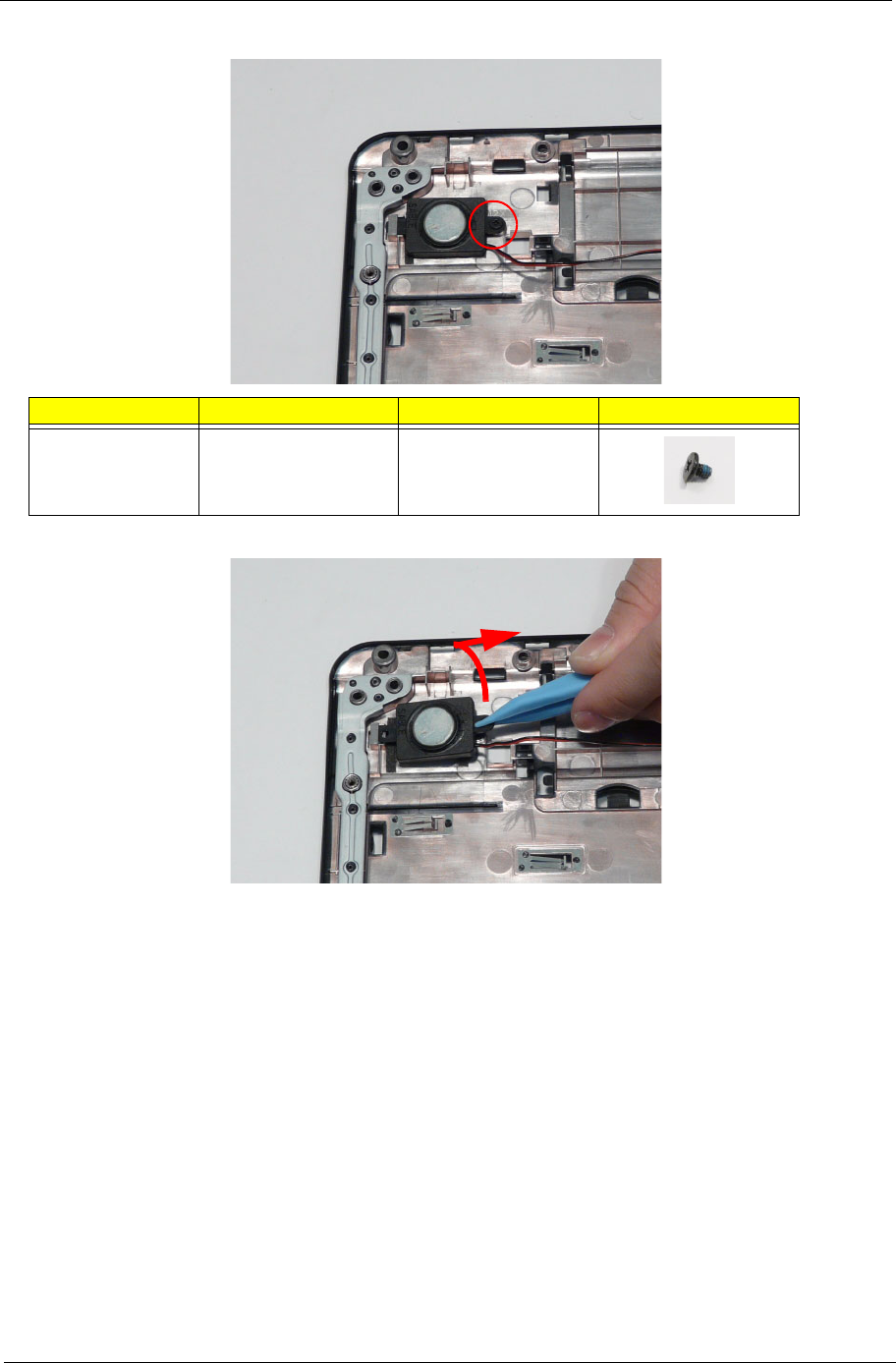
Chapter 3 71
5. Remove the single securing screw from the Right Speaker Module.
6. Lift the Speaker clear of the Upper Cover, right side first as shown.
Step Size Quantity Screw Type
Right Speaker
Module
M2*3 1
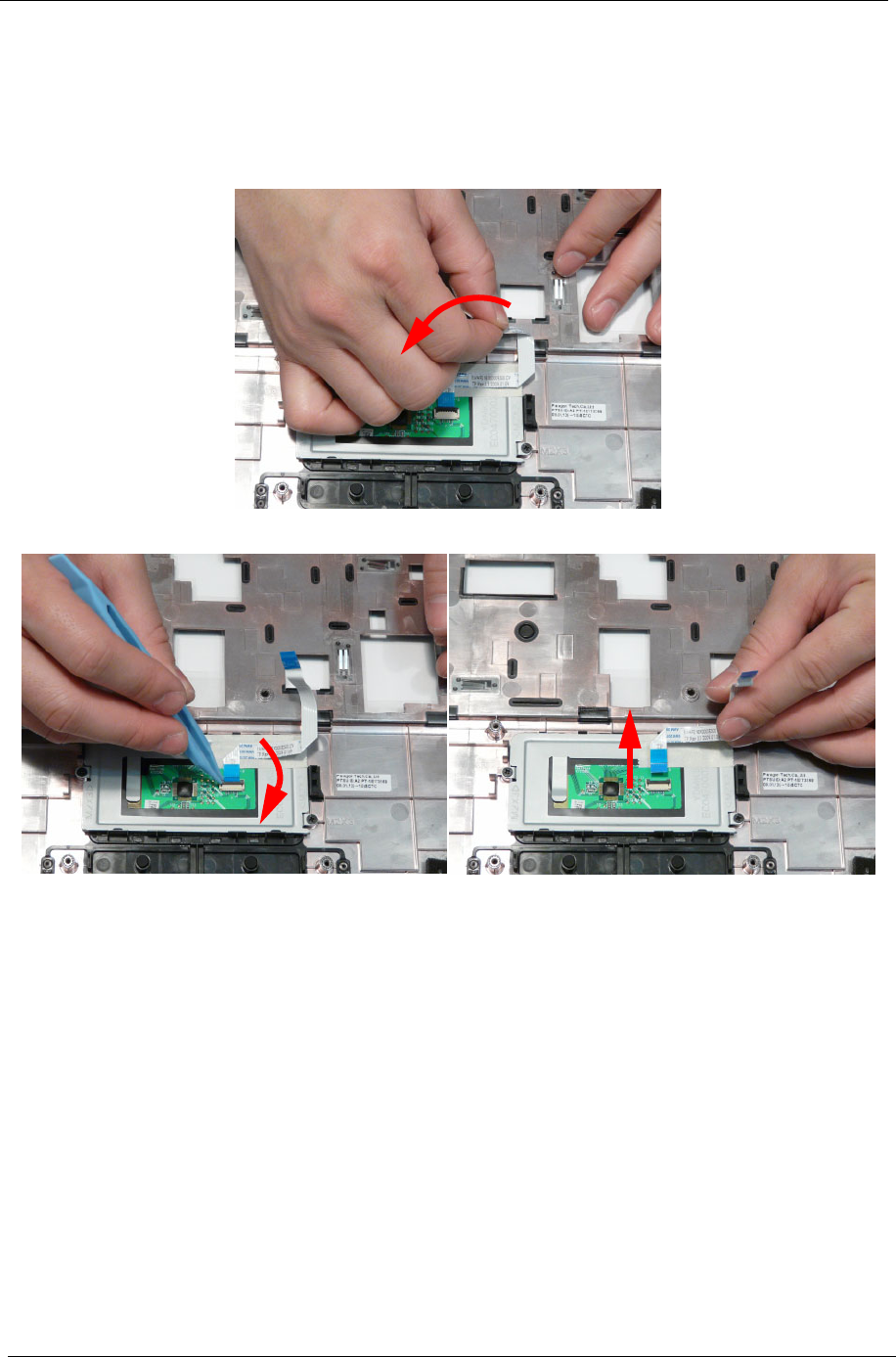
72 Chapter 3
Removing the TouchPad Bracket
IMPORTANT: The TouchPad Board cannot be removed individually. To replace the TouchPad Board, replace the
entire Upper Cover.
1. See “Removing the Upper Cover” on page 63.
2. Lift the FFC to detach the adhesive securing the cable to the Upper Cover.
3. Release the FFC locking latch and disconnect the TouchPad FFC from the cover.
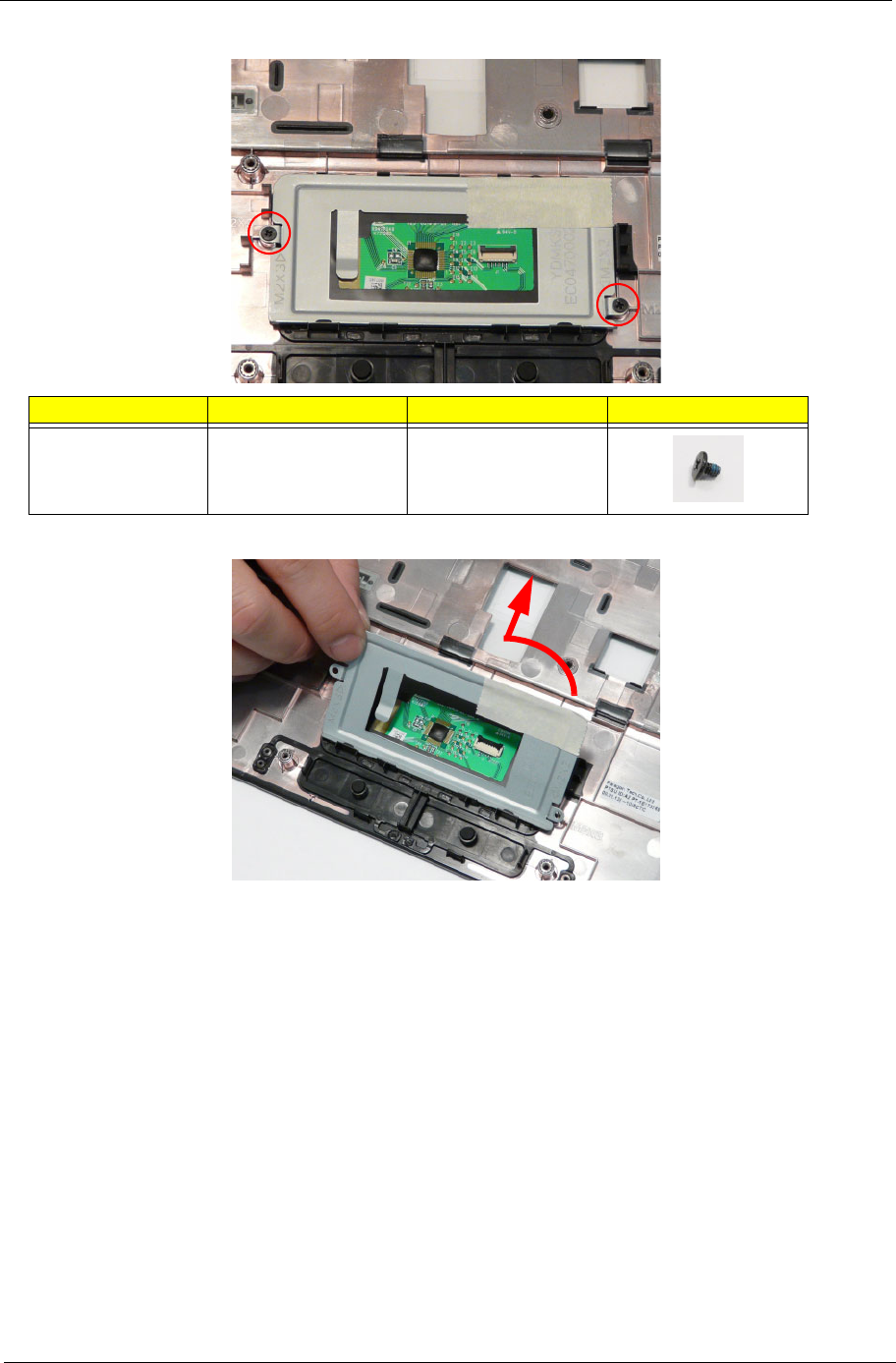
Chapter 3 73
4. Remove the two screws from TouchPad bracket.
5. Lift the rear edge of the TouchPad bracket first to clear the securing clips and remove it as shown.
Step Size Quantity Screw Type
TouchPad Bracket M2*3 2
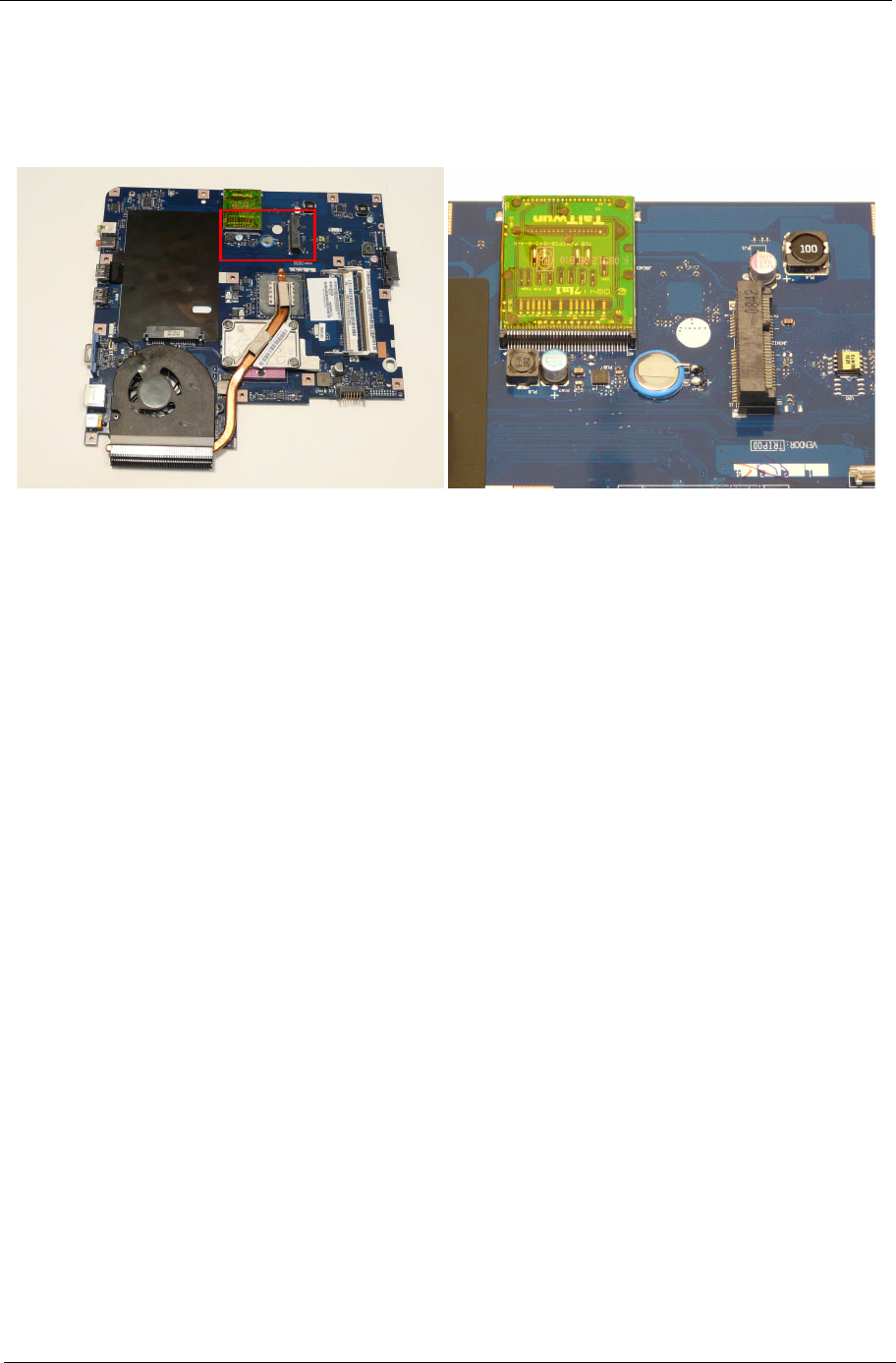
Chapter 3 75
Removing the RTC Battery
IMPORTANT:Follow local regulations for disposal of all batteries.
The RTC Battery is soldered to the Mainboard. To replace the battery, solder the new battery to the
connections shown.
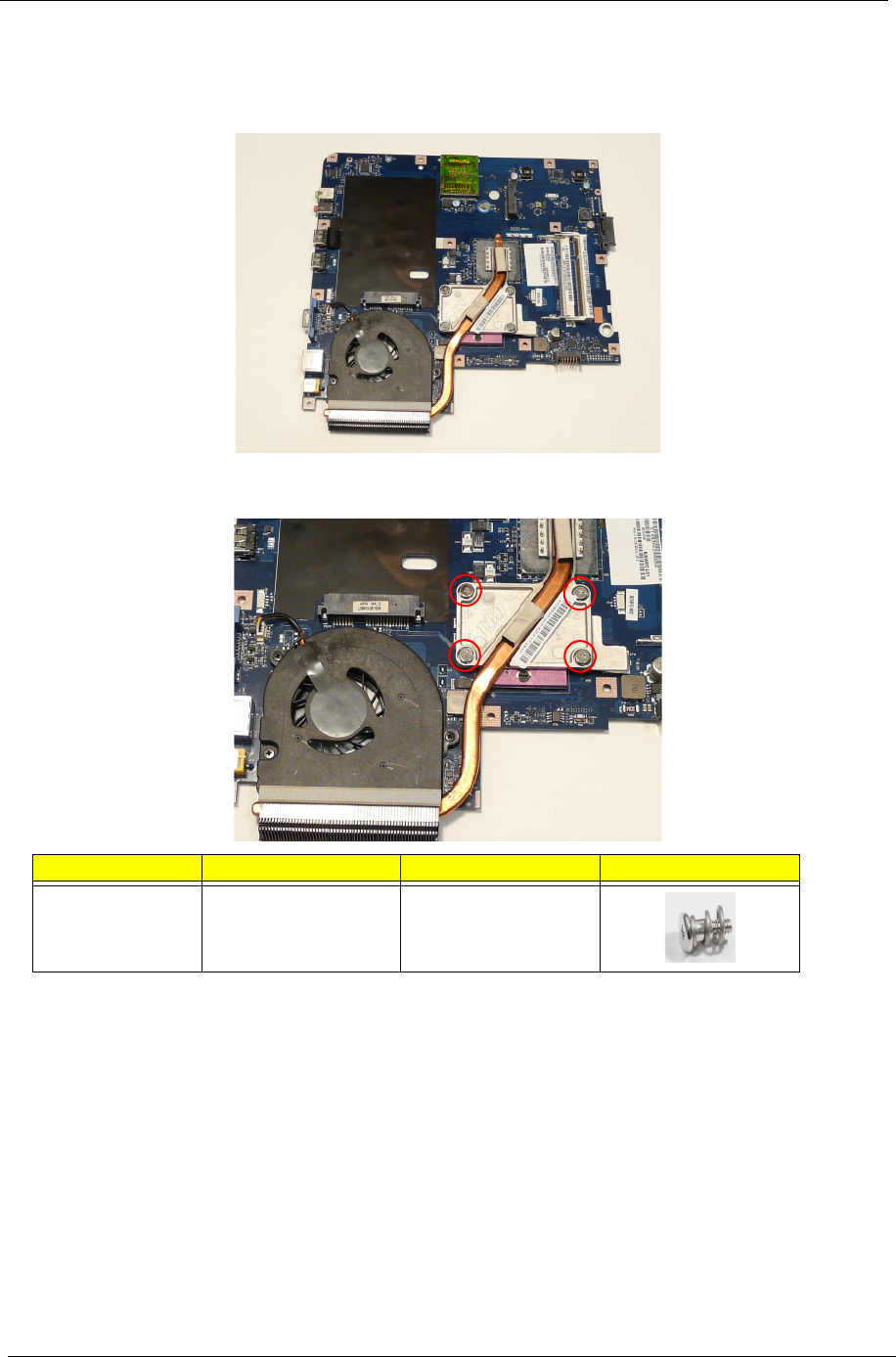
76 Chapter 3
Removing the Thermal Module
1. See “Removing the Lower Covers” on page 48.
2. Turn the Mainboard over to access the Thermal Module.
3. Remove the four securing screws (in reverse numerical order from screw 4 to screw 1) from the Thermal
Module.
Step Size Quantity Screw Type
Thermal Module 4
1
2
3
4
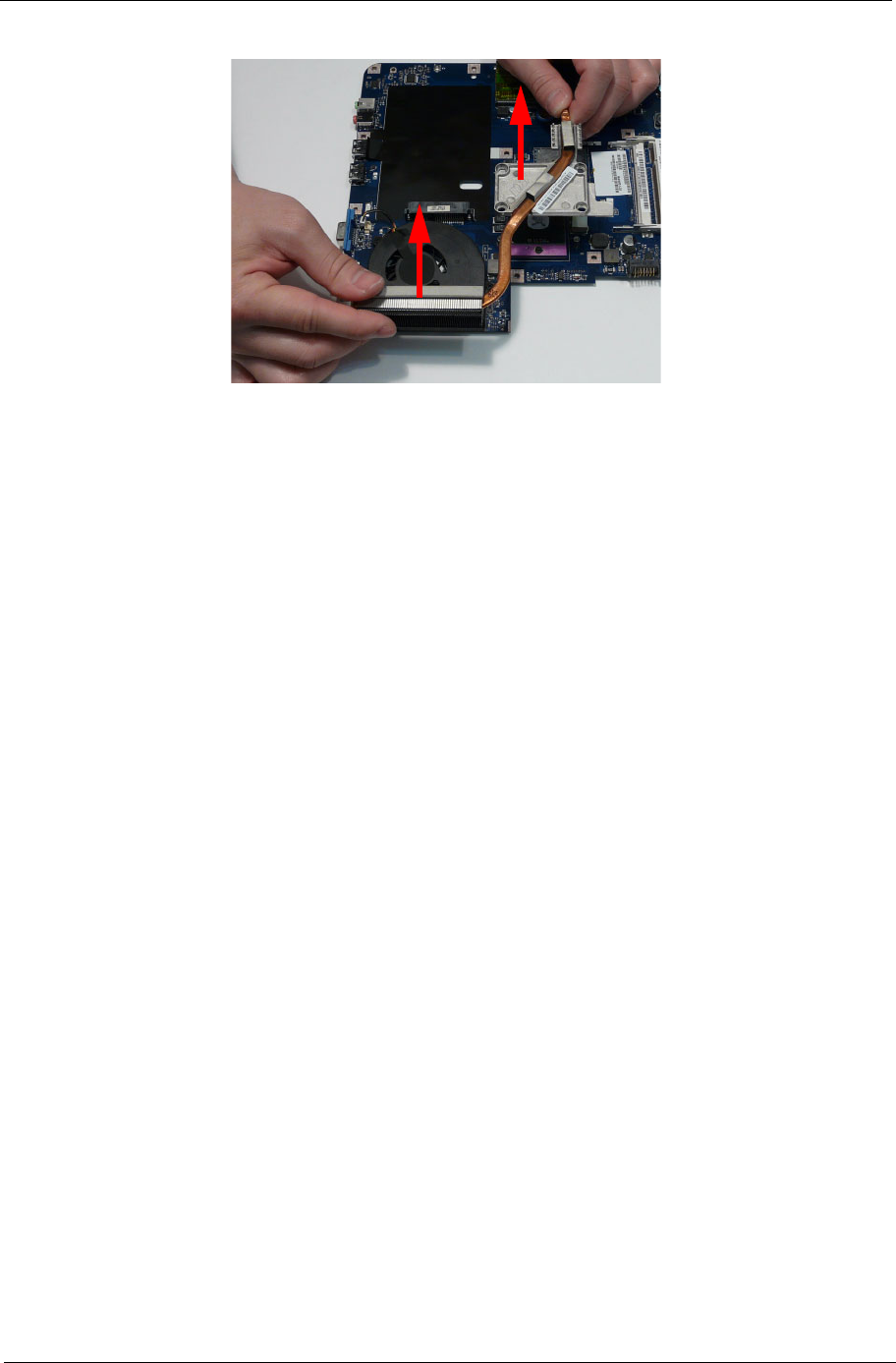
Chapter 3 77
4. Using both hands, lift the Thermal Module clear of the Mainboard.
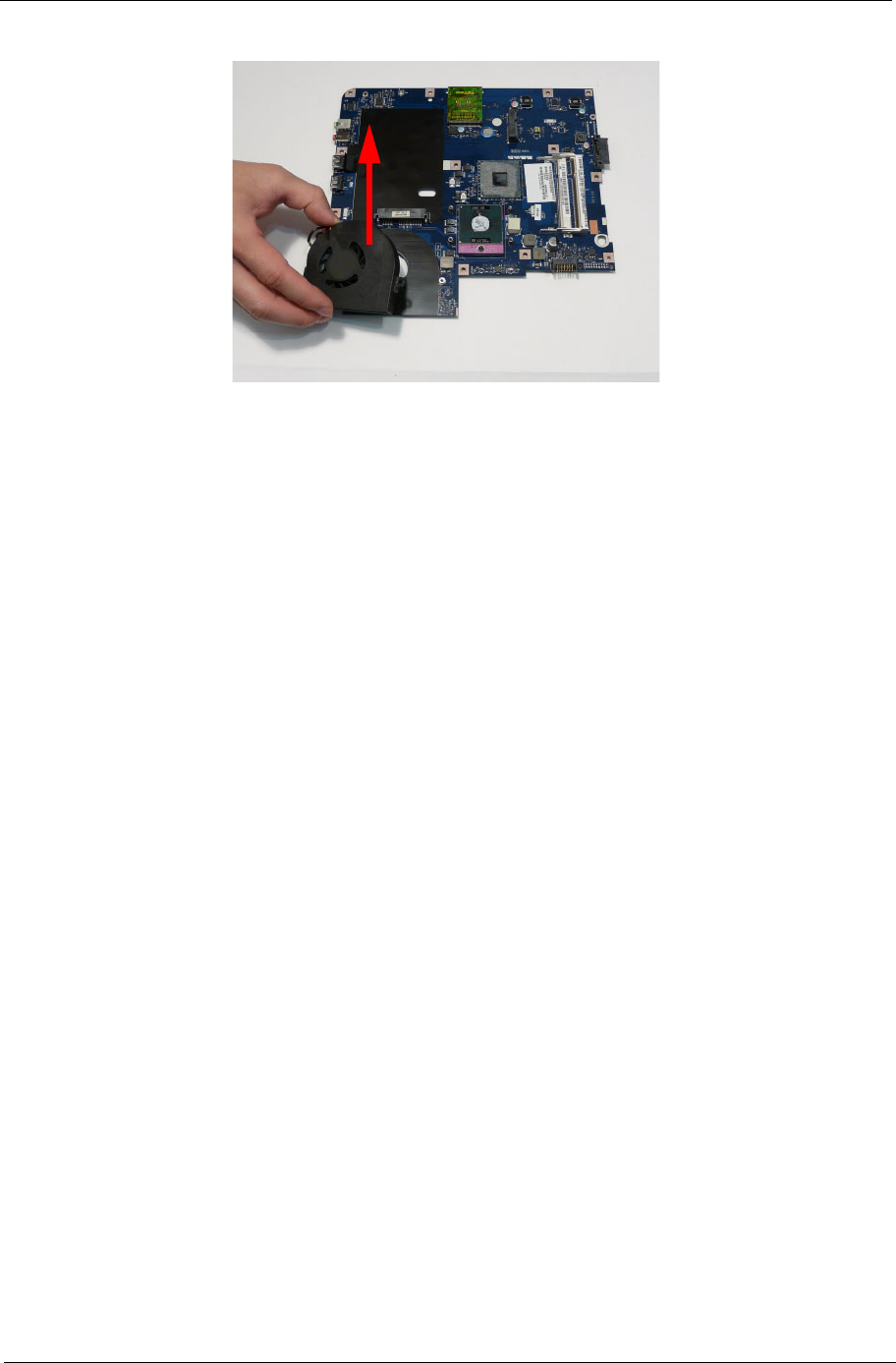
Chapter 3 79
4. Lift the CPU Fan clear of the Mainboard as shown.
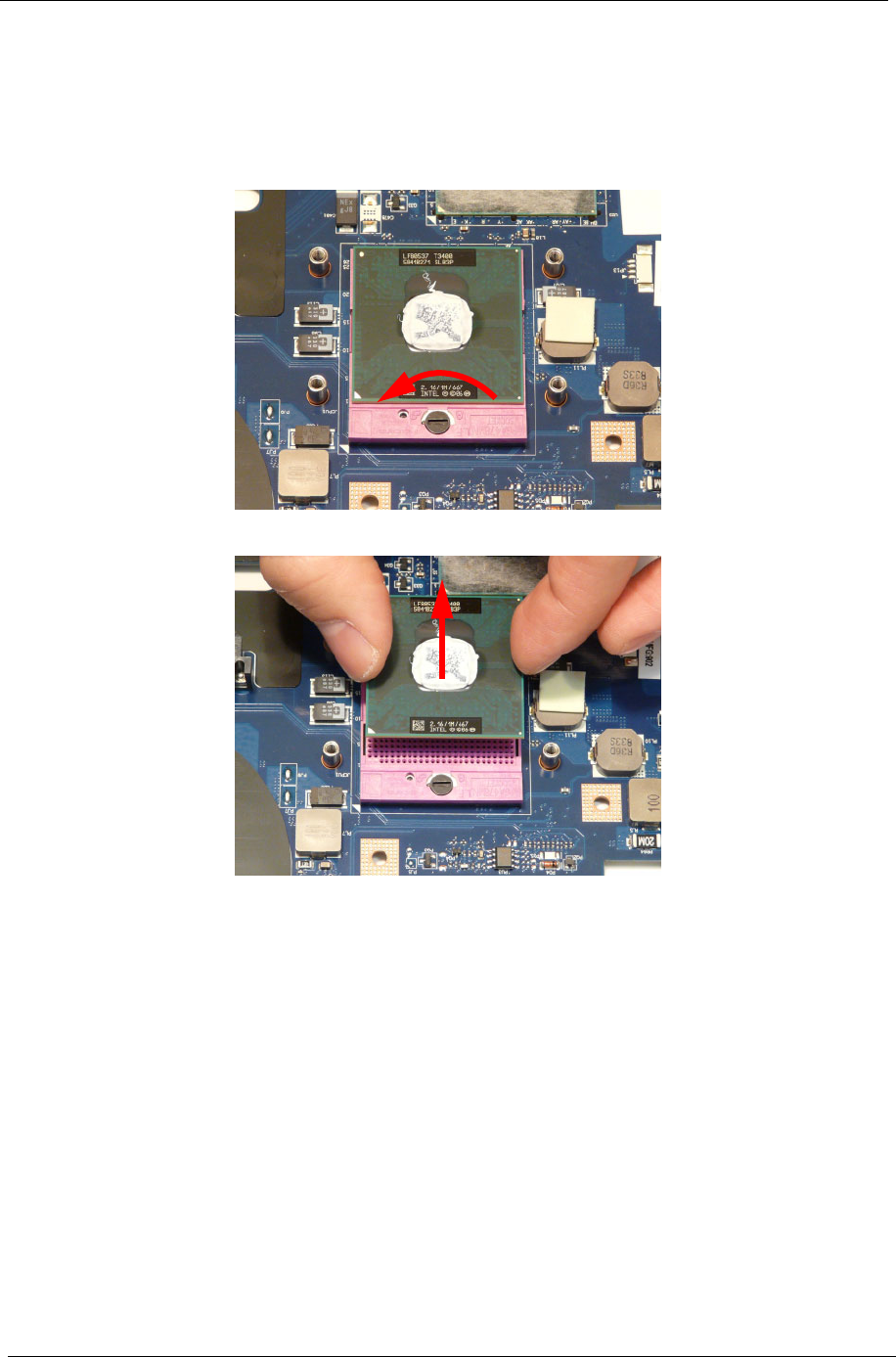
80 Chapter 3
Removing the CPU
IMPORTANT: The pins on the underside of the CPU are very delicate. If they are damaged, the CPU may
malfunction. Place the CPU on a clean, dry surface when it is not installed.
1. See “Removing the Thermal Module” on page 76.
2. Using a flat-bladed screw driver, rotate the CPU locking screw 180° counter-clockwise as shown.
3. Lift the CPU clear of the socket as shown.
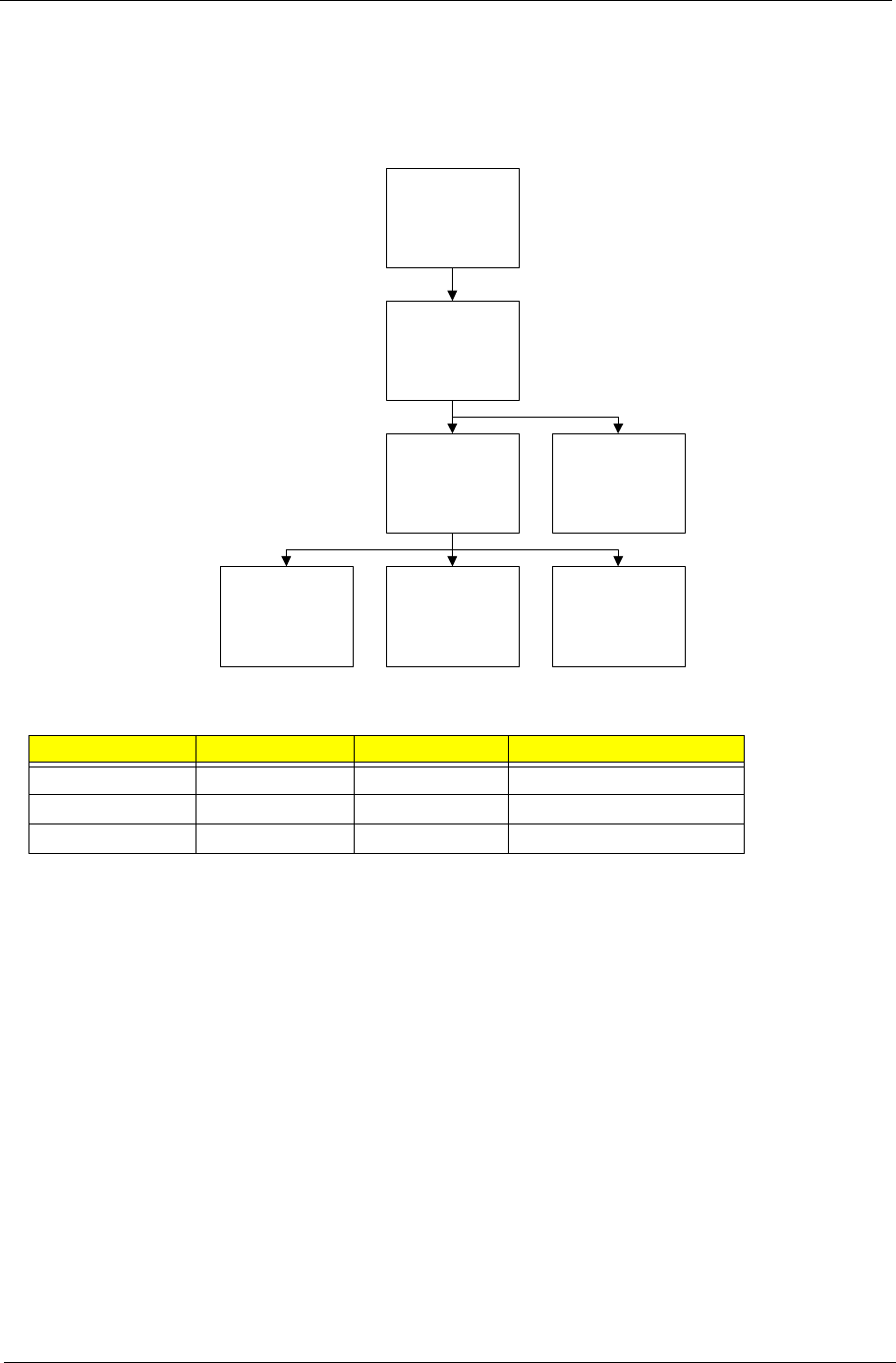
Chapter 3 81
LCD Module Disassembly Process
LCD Module Disassembly Flowchart
Screw List
Step Screw Quantity Part No.
LCD Bezel M2.5*6 4 86.N2802.002
LCD Panel M2.5*6 2 86.N2802.002
LCD Brackets M2*3 6 86.N2802.006
Remove
LCD Panel
Remove
LCD Bezel
Remove
LCD FPC Cable
Remove LCD
Panel from Main
Unit before
proceeding
Remove
LCD Brackets
Remove
Antennas
Remove
Camera Module
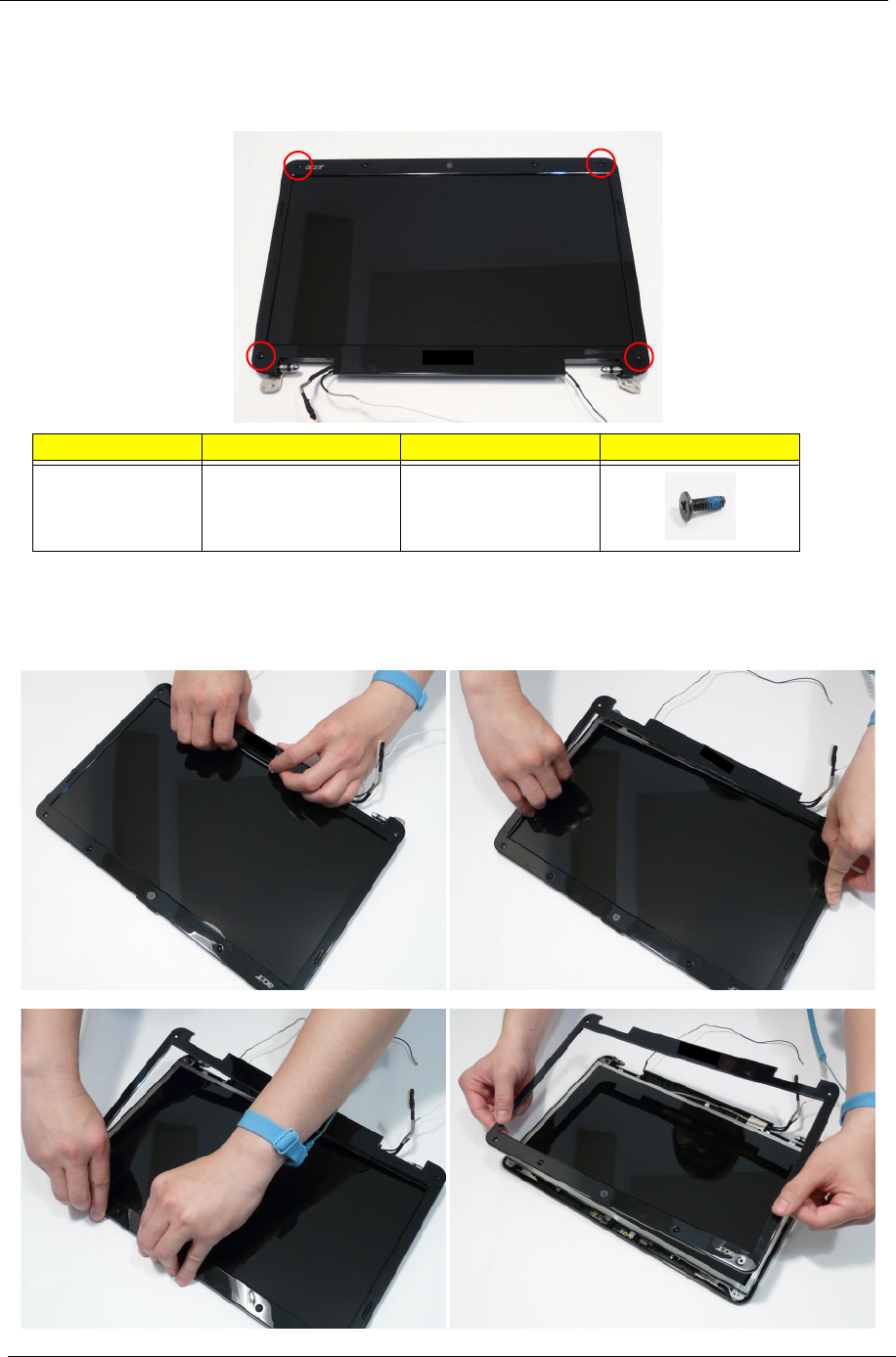
82 Chapter 3
Removing the LCD Bezel
1. See “Removing the LCD Module” on page 59.
2. Remove the two upper and two lower bezel screw caps and screws.
3. Starting from the bottom edge of the bezel, pry the bezel upwards and away from the panel. Work along the
right side toward the top of the bezel, prying the covers apart. Continue along the top edge and down the left
side to remove the bezel.
NOTE: If necessary, use a pry to lift up the outside edges of the bezel.
Step Size Quantity Screw Type
LCD Bezel M2.5*6 4
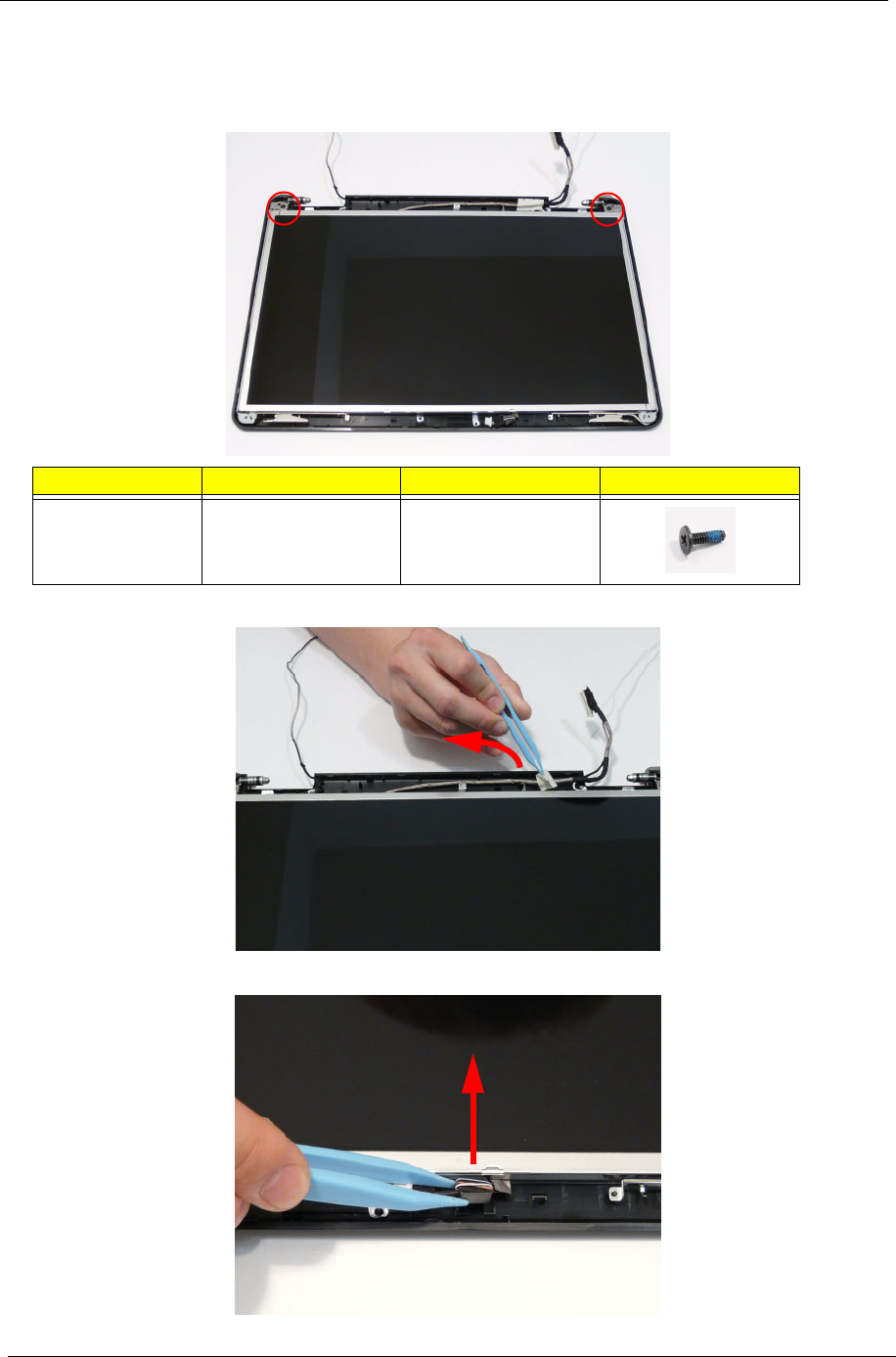
84 Chapter 3
Removing the LCD Panel
1. See “Removing the Camera Module” on page 83.
2. Remove the two securing screws from the LCD Panel.
3. Remove the adhesive strip holding the cables in place.
4. Remove the Camera cable cluster from the LCD Module as shown.
Step Size Quantity Screw Type
LCD Panel M2.5*6 2
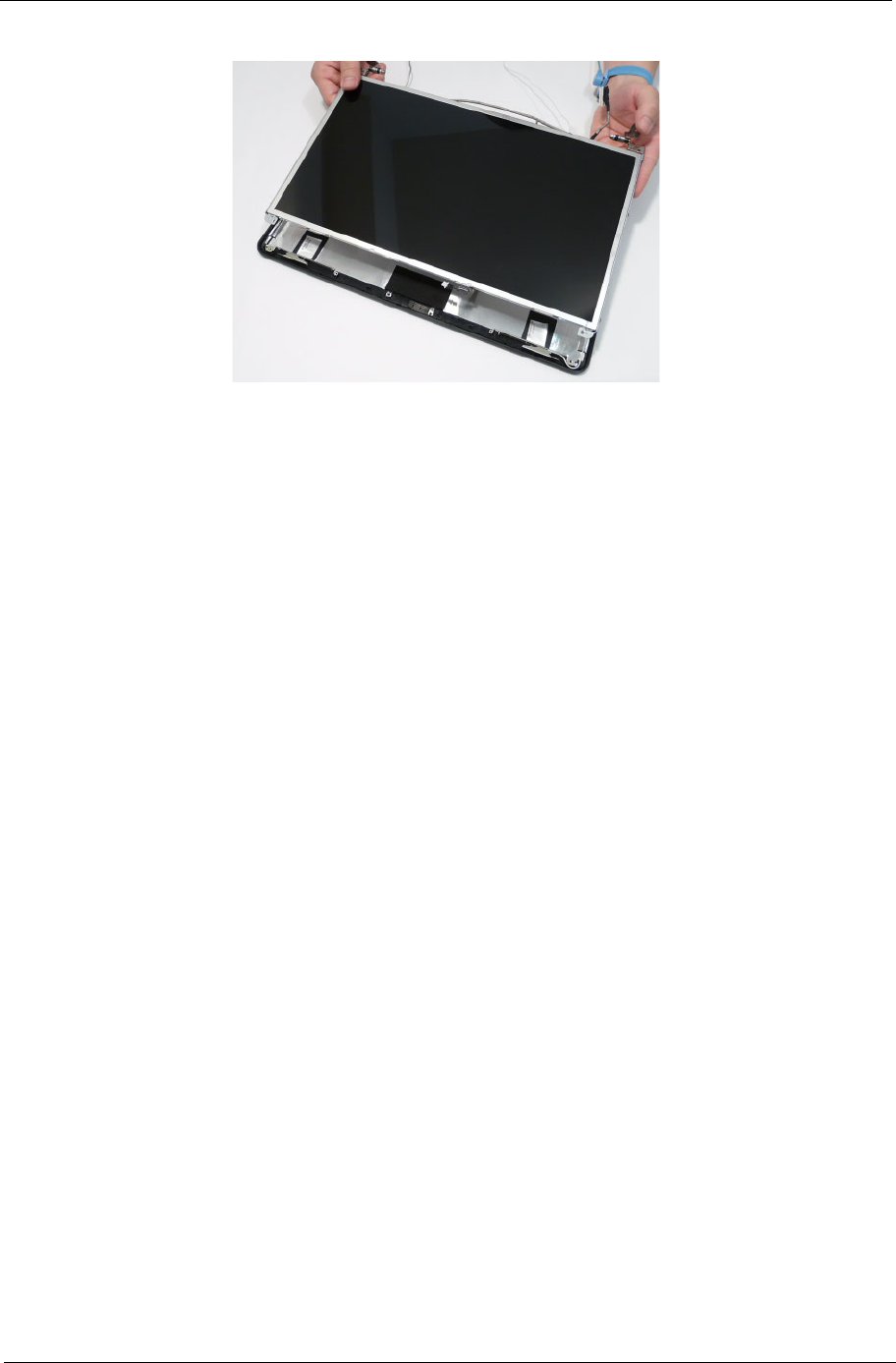
Chapter 3 85
5. Lift the LCD Panel clear of the module.
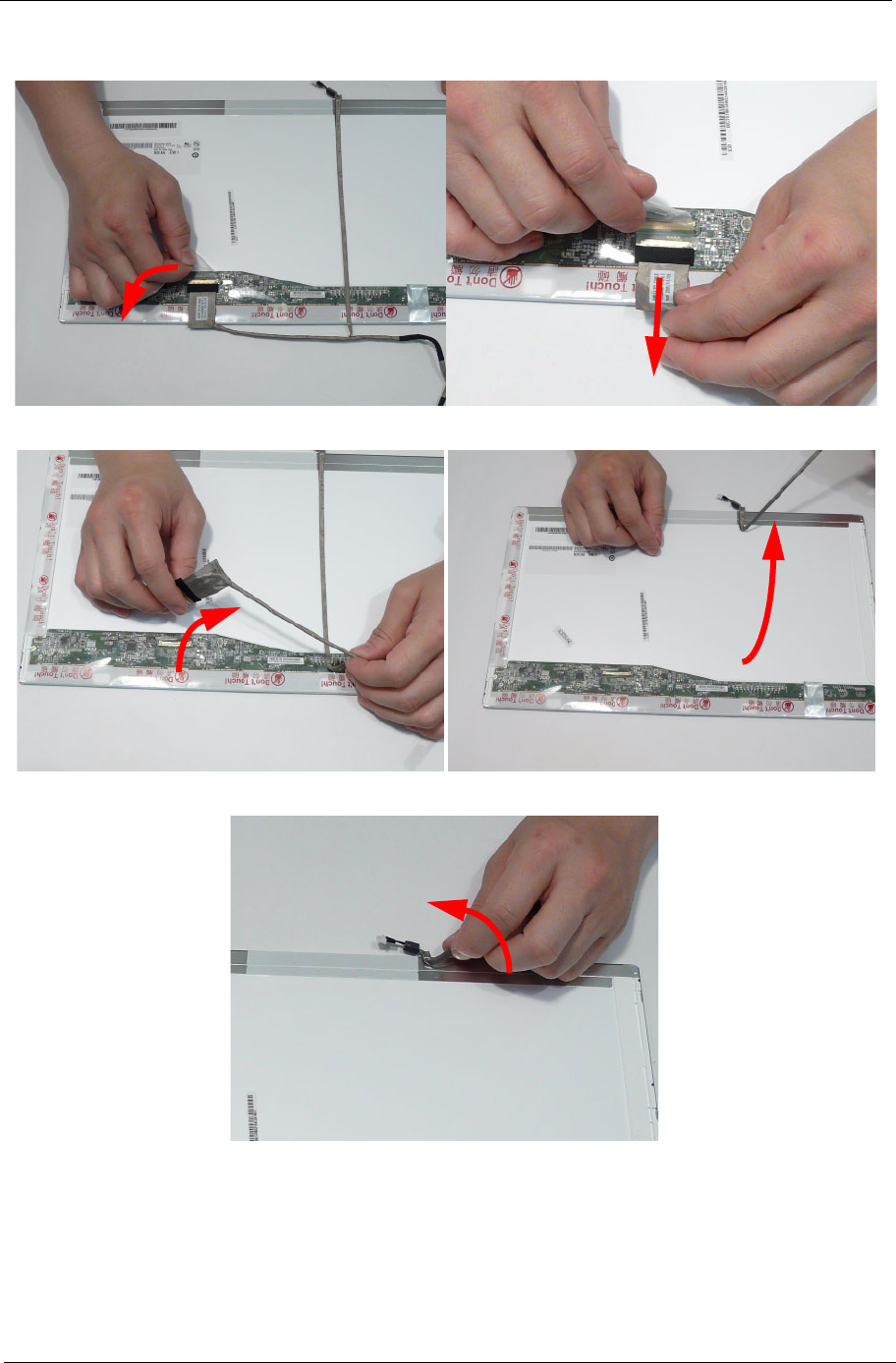
Chapter 3 87
4. Turn the LCD panel over to expose the rear. Lift the adhesive protector and disconnect the cable from the LCD
Panel.
5. Lift the cable as shown to disengage the adhesive strip securing it in place.
6. Lift the FPC cable to disengage the remaining adhesive and remove the cable from the panel.
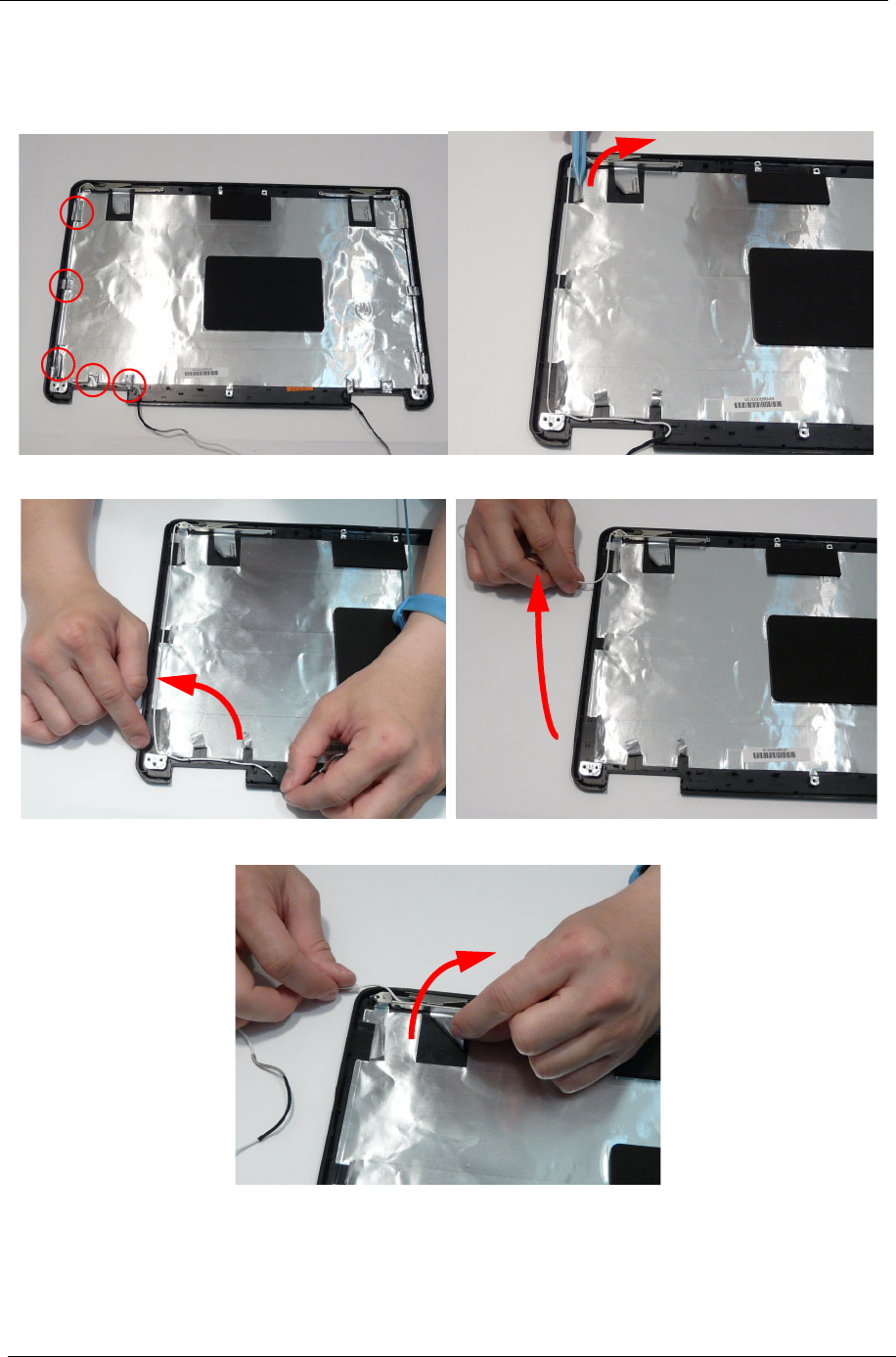
88 Chapter 3
Removing the Antennas
1. See “Removing the LCD Panel” on page 84.
2. Remove the adhesive strips holding the left antenna cable in place. Ensure the cable is free from obstructions.
3. Remove the cable from the cable channel. Ensure that the cable is free from all cable clips and adhesive strips.
4. Remove the adhesive tape securing the left Antenna to the LCD Module.
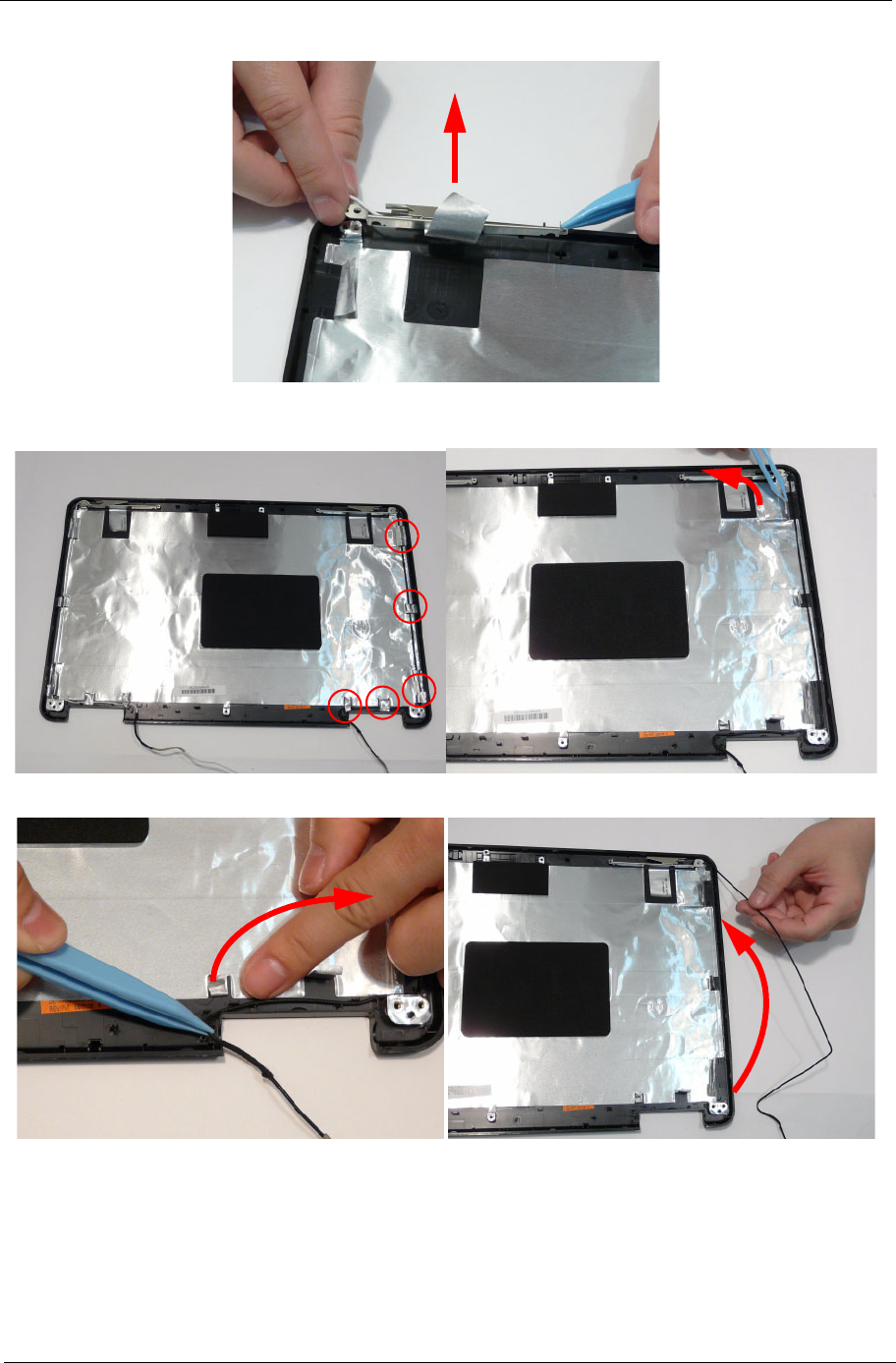
Chapter 3 89
5. Lift the left Antenna clear of the cover.
6. Remove the adhesive strips holding the right antenna cable in place. Ensure the cable is free from
obstructions.
7. Remove the cable from the cable channel. Ensure that the cable is free from all cable clips and adhesive strips.
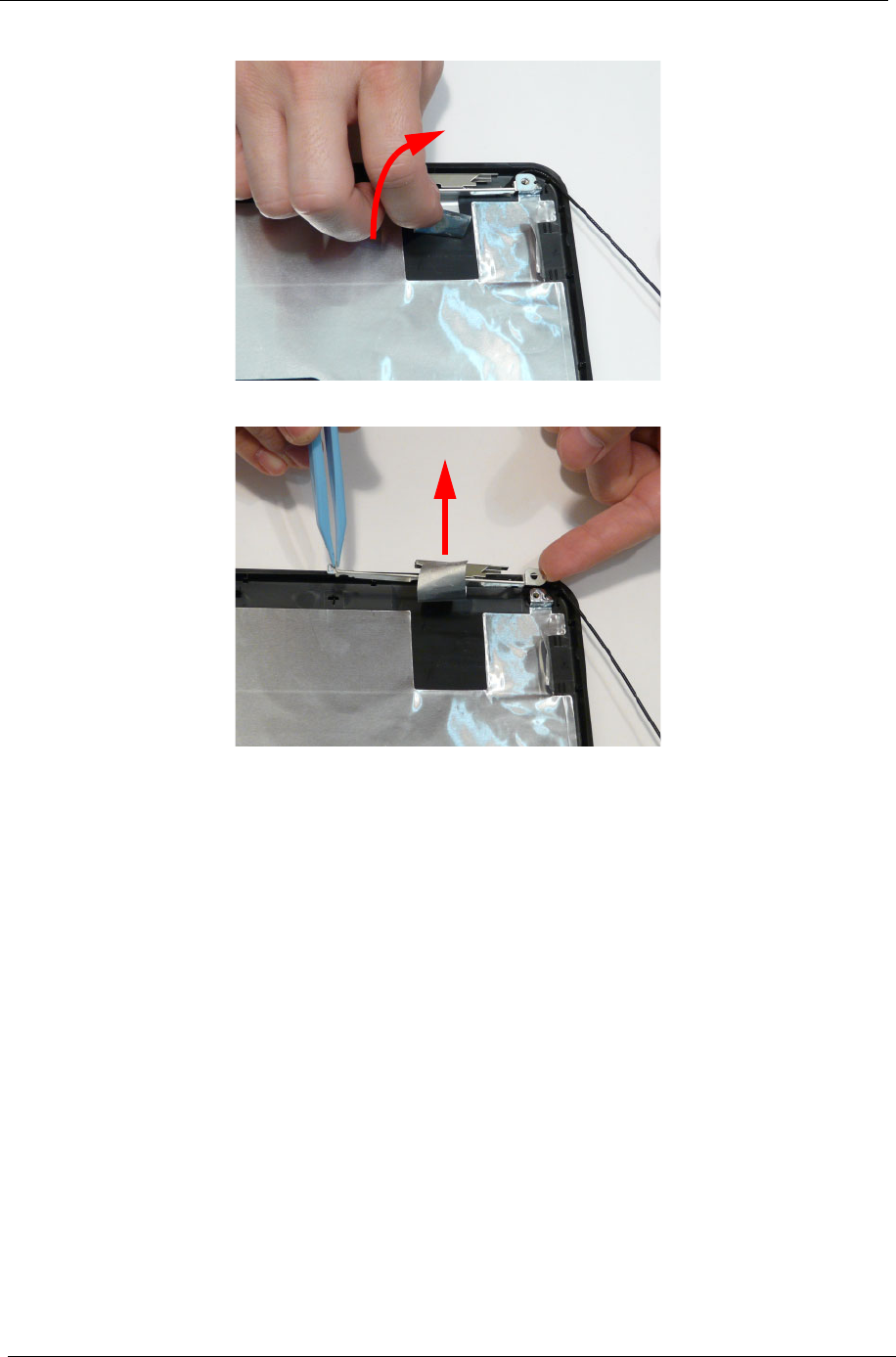
90 Chapter 3
8. Remove the adhesive tape securing the right Antenna to the LCD Module.
9. Lift the right Antenna clear of the cover.
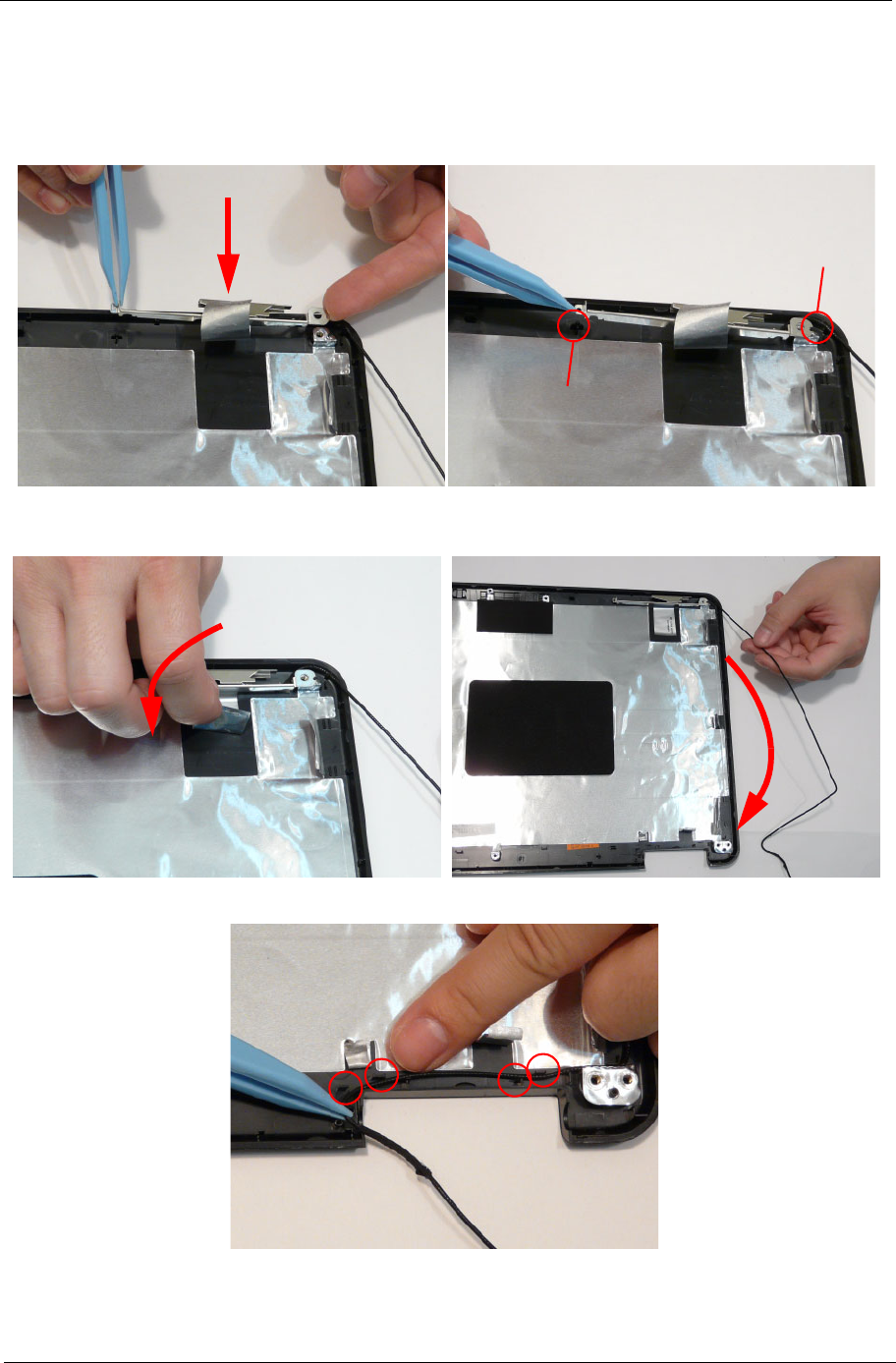
Chapter 3 91
LCD Module Reassembly Procedure
Replacing the Antennas
1. Replace the right Antenna as shown. Ensure that the locating pins on the Antenna are correctly seated.
2. Replace the adhesive strip to secure the Antenna
in place.
3. Run the cable down the side of the LCD Module
using all available clips and adhesive.
4. Run the cable along the cable channel as shown, using all available cable clips.
Locating Pin
Locating Pin
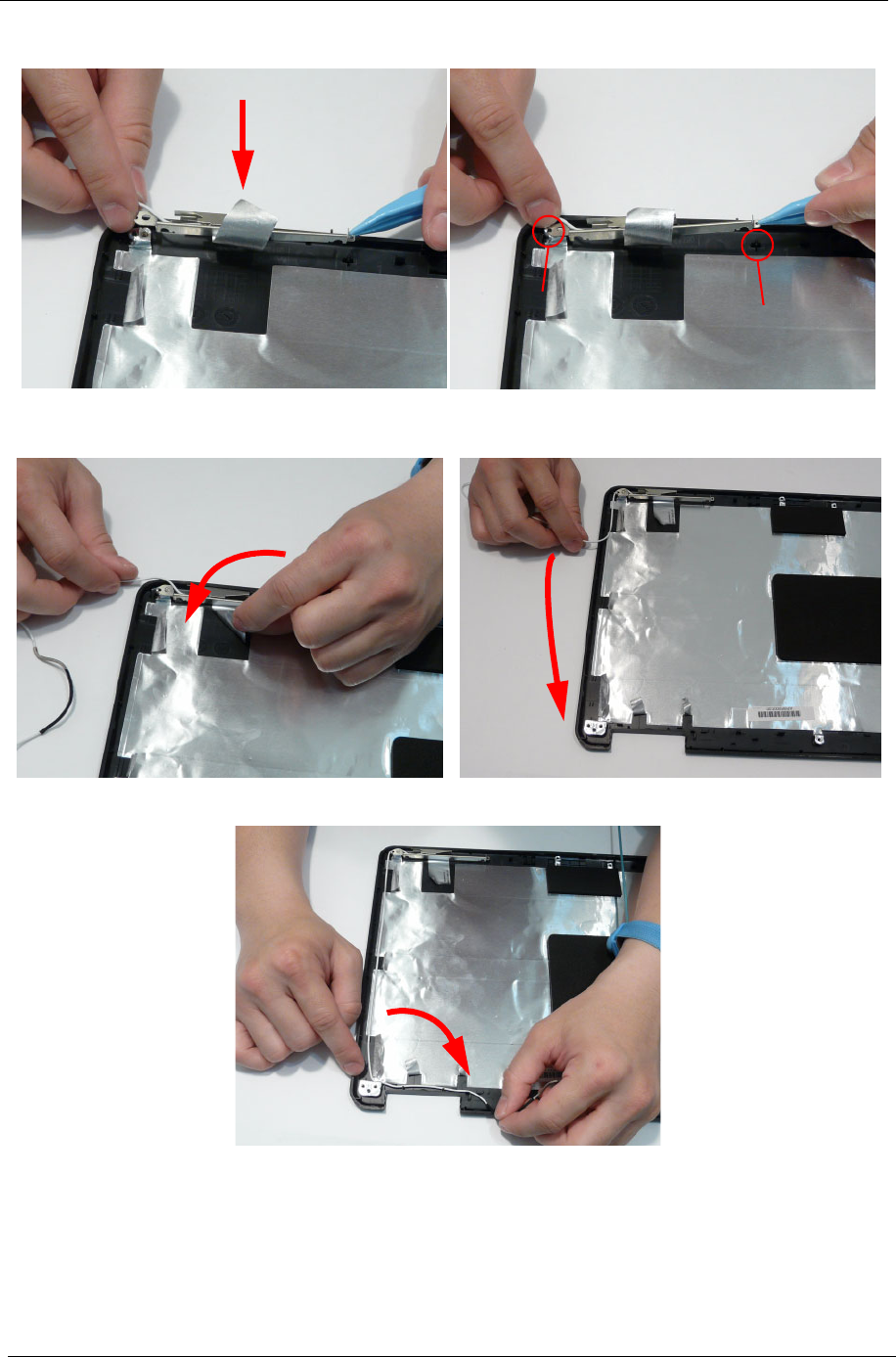
92 Chapter 3
5. Replace the left Antenna as shown. Ensure that the locating pins on the Antenna are correctly seated.
6. Replace the adhesive strip to secure the Antenna
in place.
7. Run the cable down the side of the LCD Module
using all available clips and adhesive.
8. Run the cable along the cable channel as shown, using all available cable clips and adhesive.
Locating Pin
Locating Pin
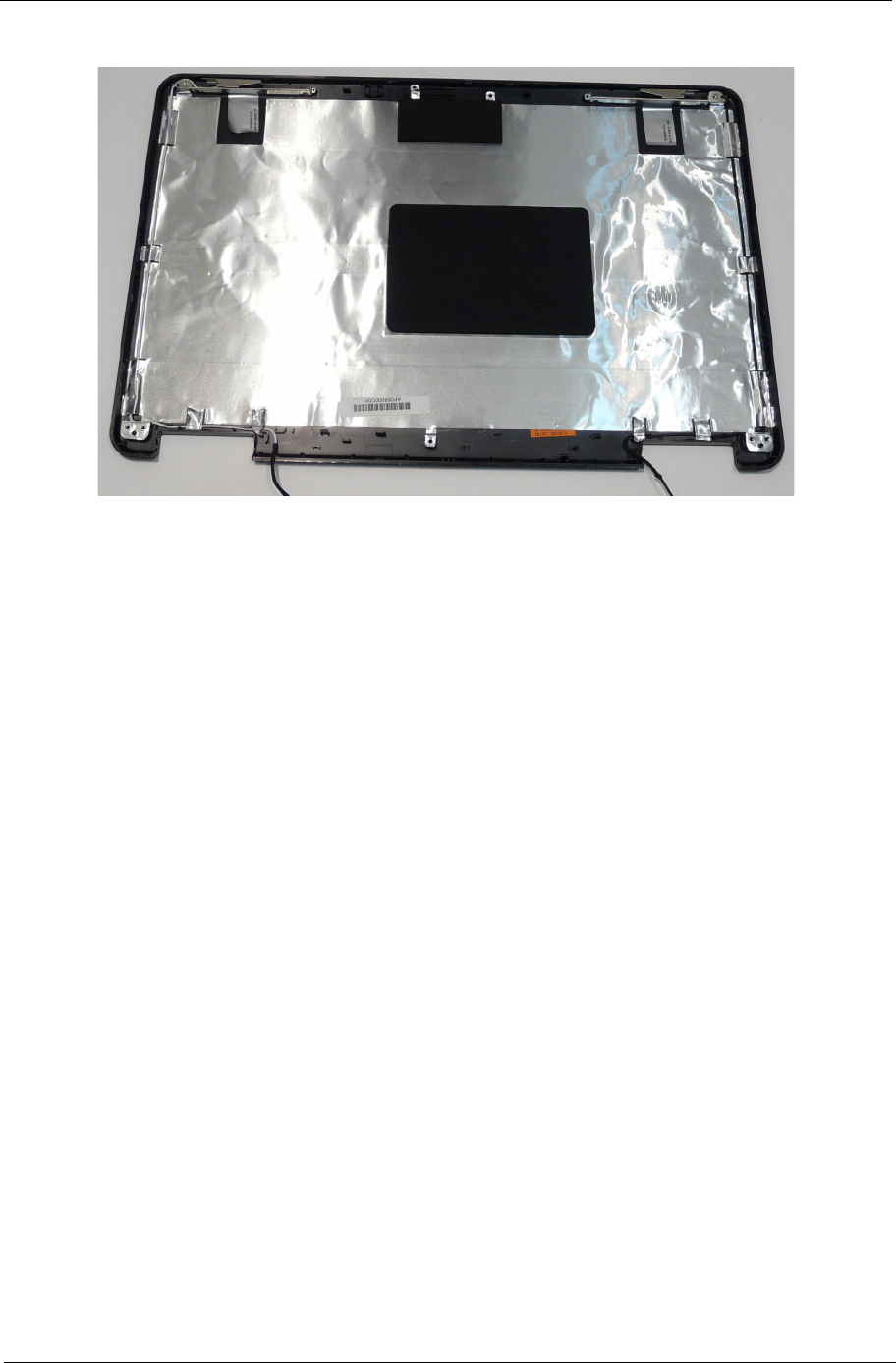
Chapter 3 93
9. The Antennas and cables appear as shown when correctly installed.
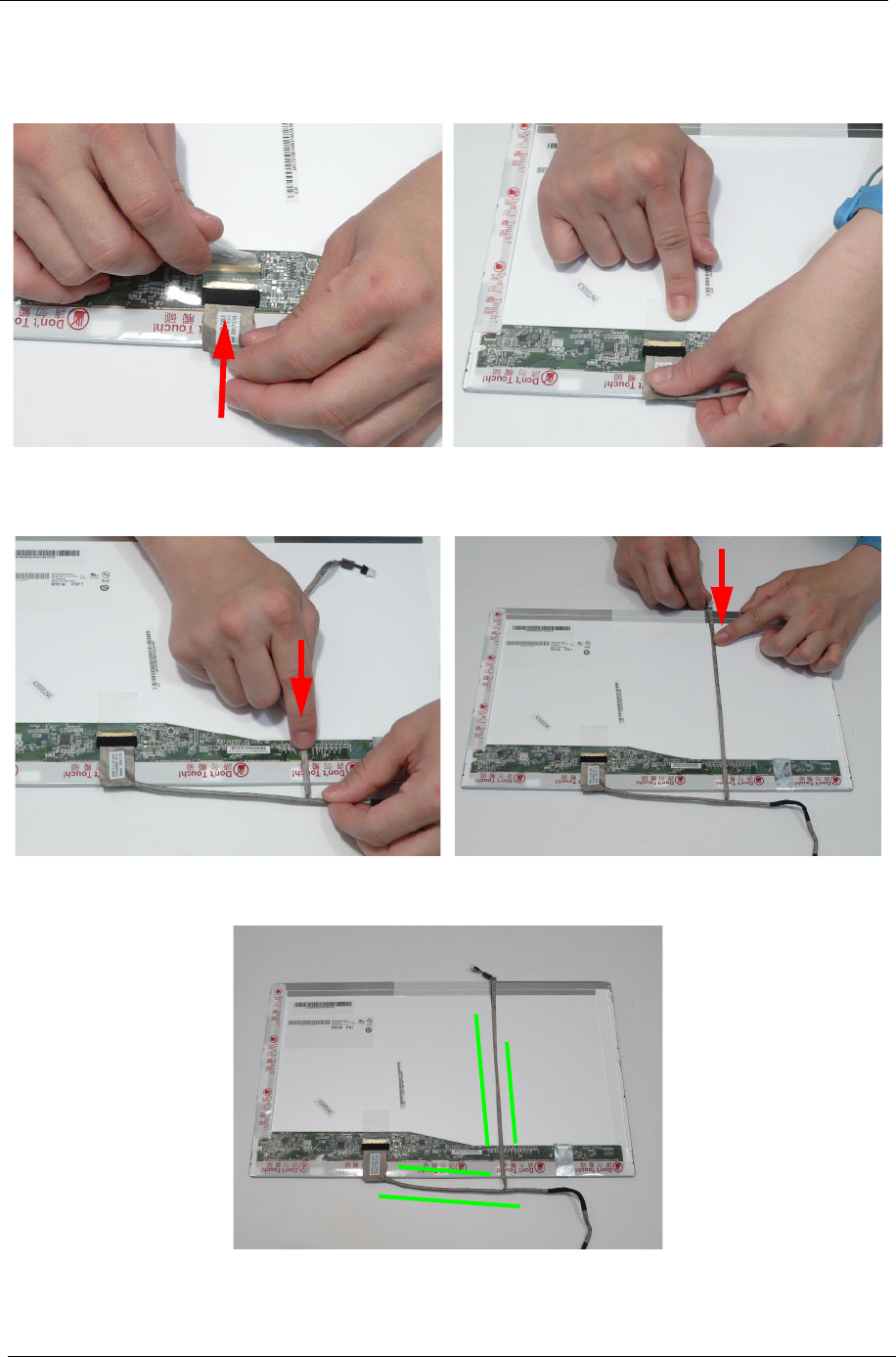
94 Chapter 3
Replacing the LCD Panel
1. Connect the LCD cable to the panel connector as
shown.
2. Press down the adhesive strip to secure the cable
in place.
3. Run the cable along the back of the panel and
press down as indicated to secure the cable in
place.
4. Run the cable across the back of the panel as
shown and press down as indicated to secure the
cable in place.
IMPORTANT: Ensure that the LCD cable runs between the green callouts to avoid trapping when the panel is
replaced in the LCD Module.
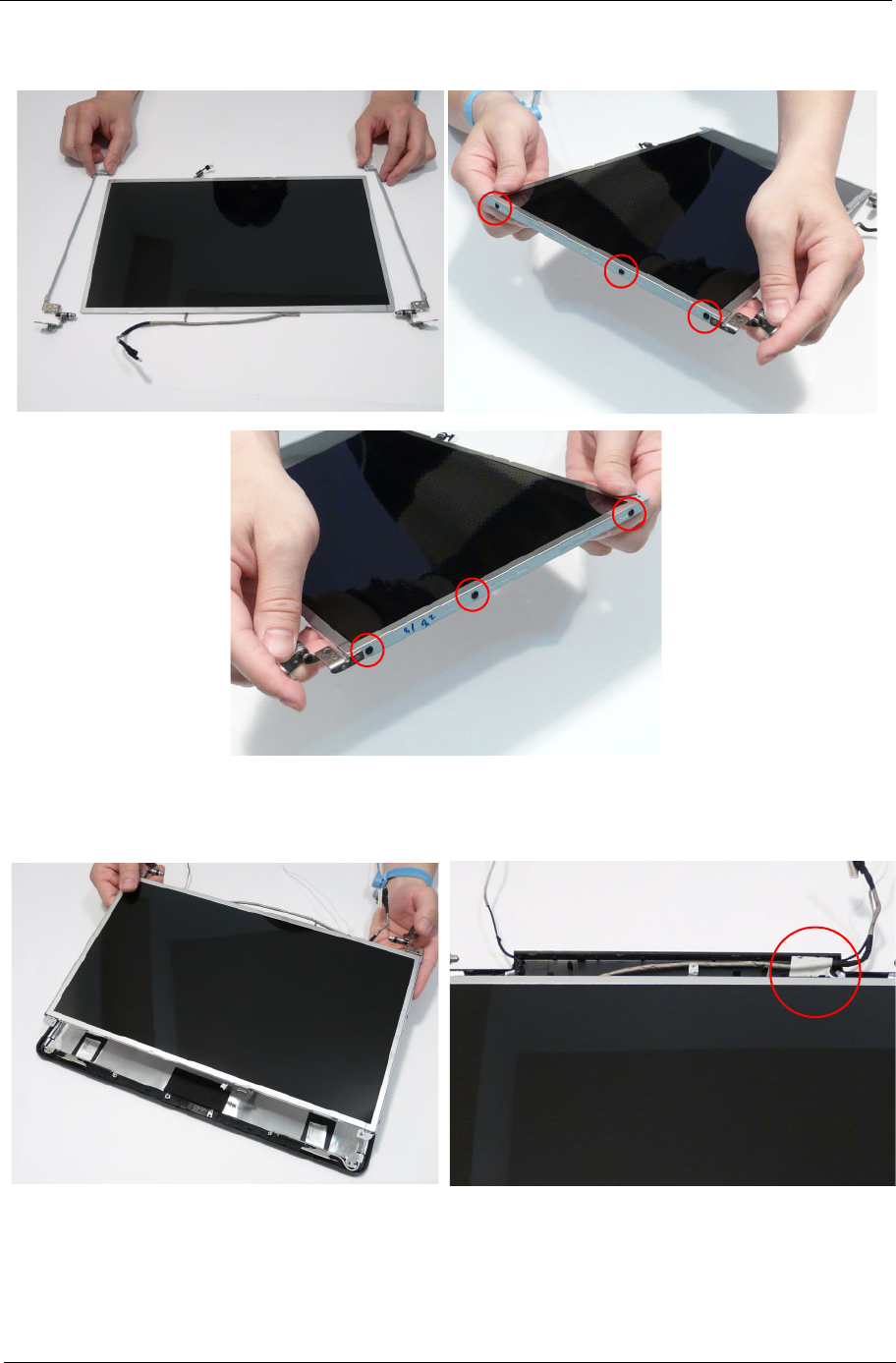
Chapter 3 95
5. Align the LCD brackets with the screw holes on the panel. Replace the six screws (three on each side) in the
brackets as shown.
6. Place the LCD Panel in the LCD Module, top edge first, and secure the LCD cable with adhesive tape.
IMPORTANT: Ensure that the LCD power cable passes through the hinge well and is not trapped under the
panel.
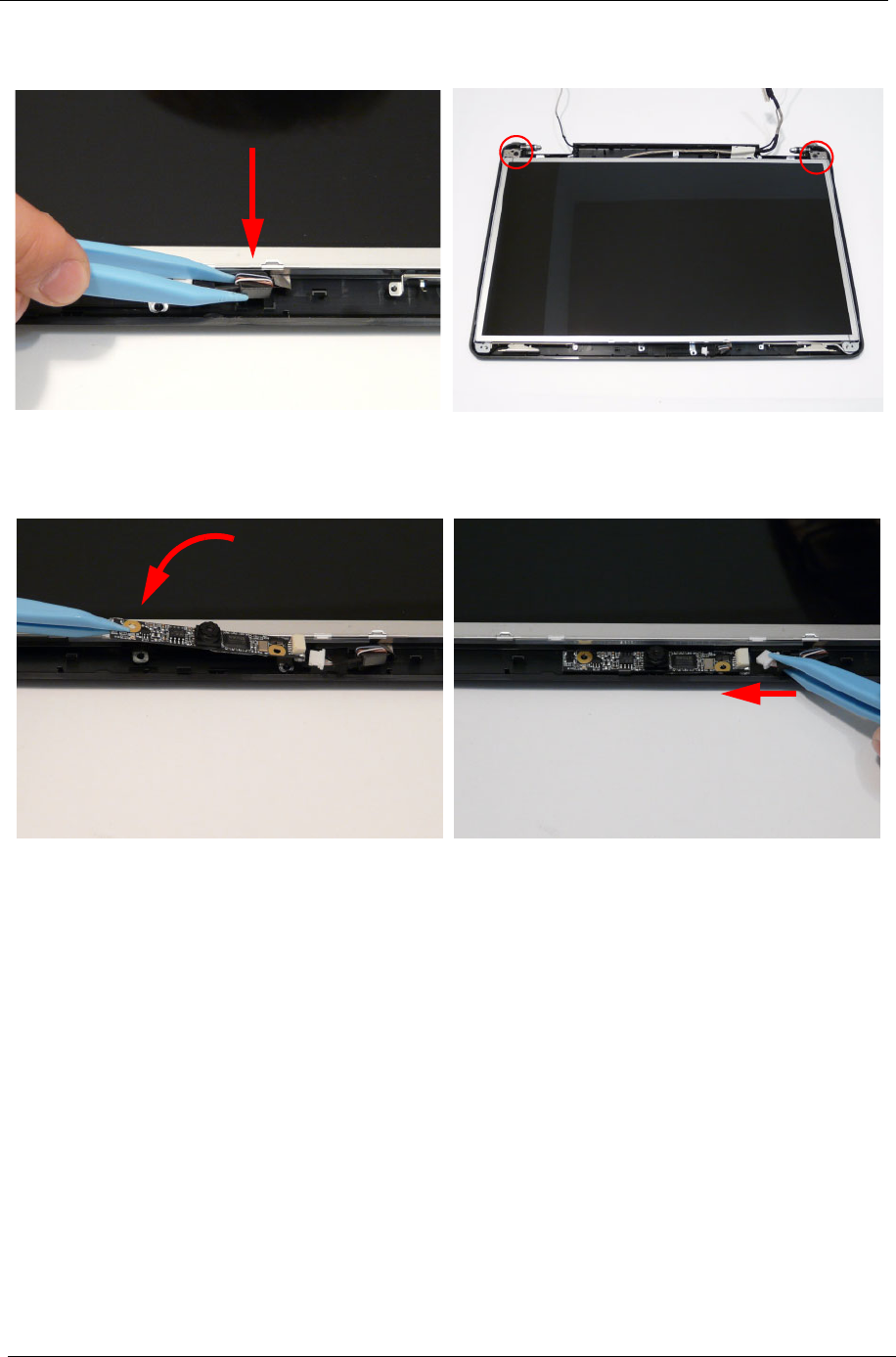
96 Chapter 3
Replacing the Camera Module
7. Replace the Camera cable cluster in the LCD
Module.
8. Secure the LCD module with the two securing
screws.
1. Place the camera in the LCD Module. 2. Connect the cable to the camera module.
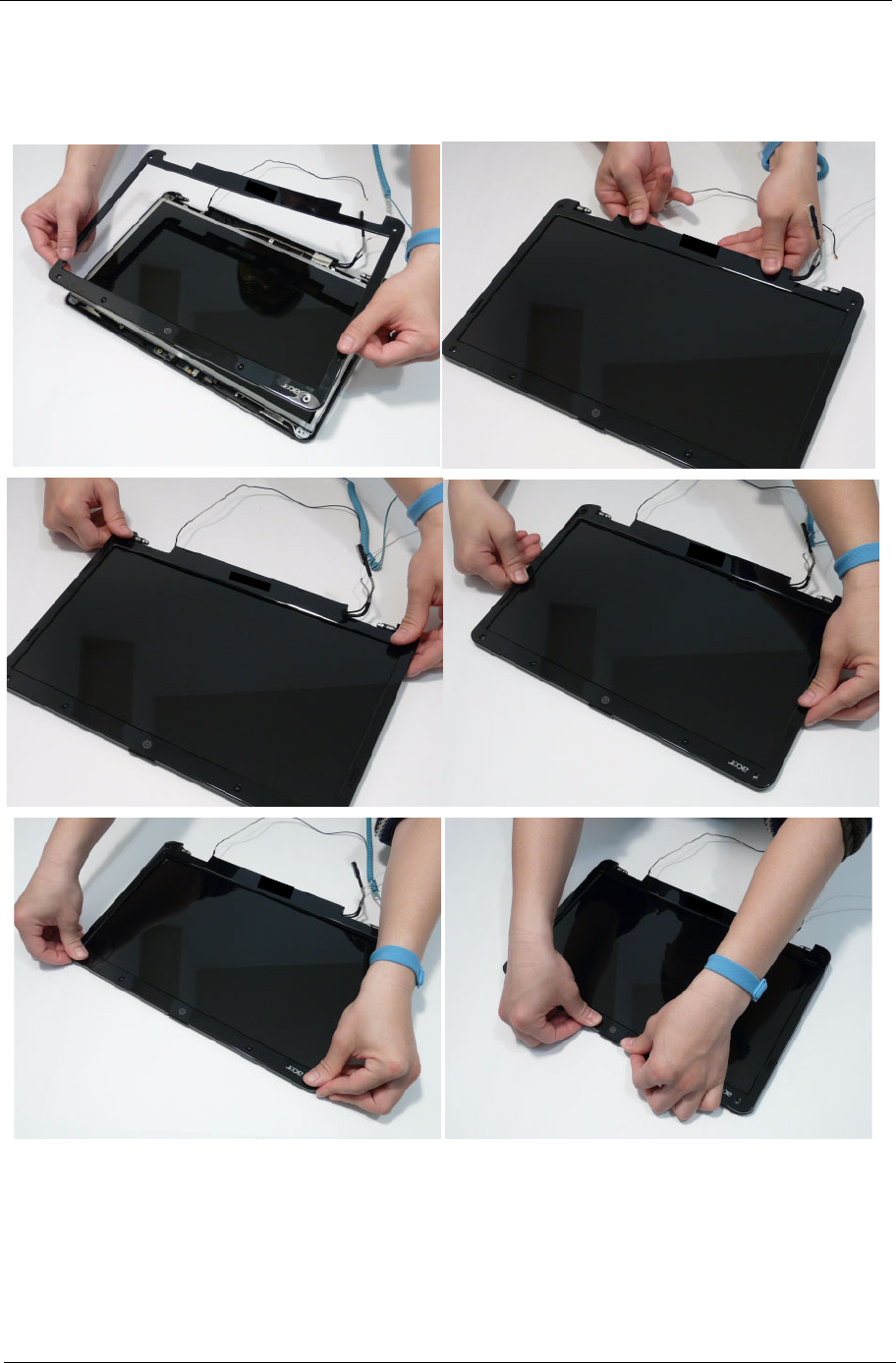
Chapter 3 97
Replacing the LCD Bezel
1. Replace the bezel and press down until there are no gaps between the bezel and the LCD Module.
IMPORTANT: Ensure that the LCD cables pass through the hinge wells and are not trapped by the bezel.
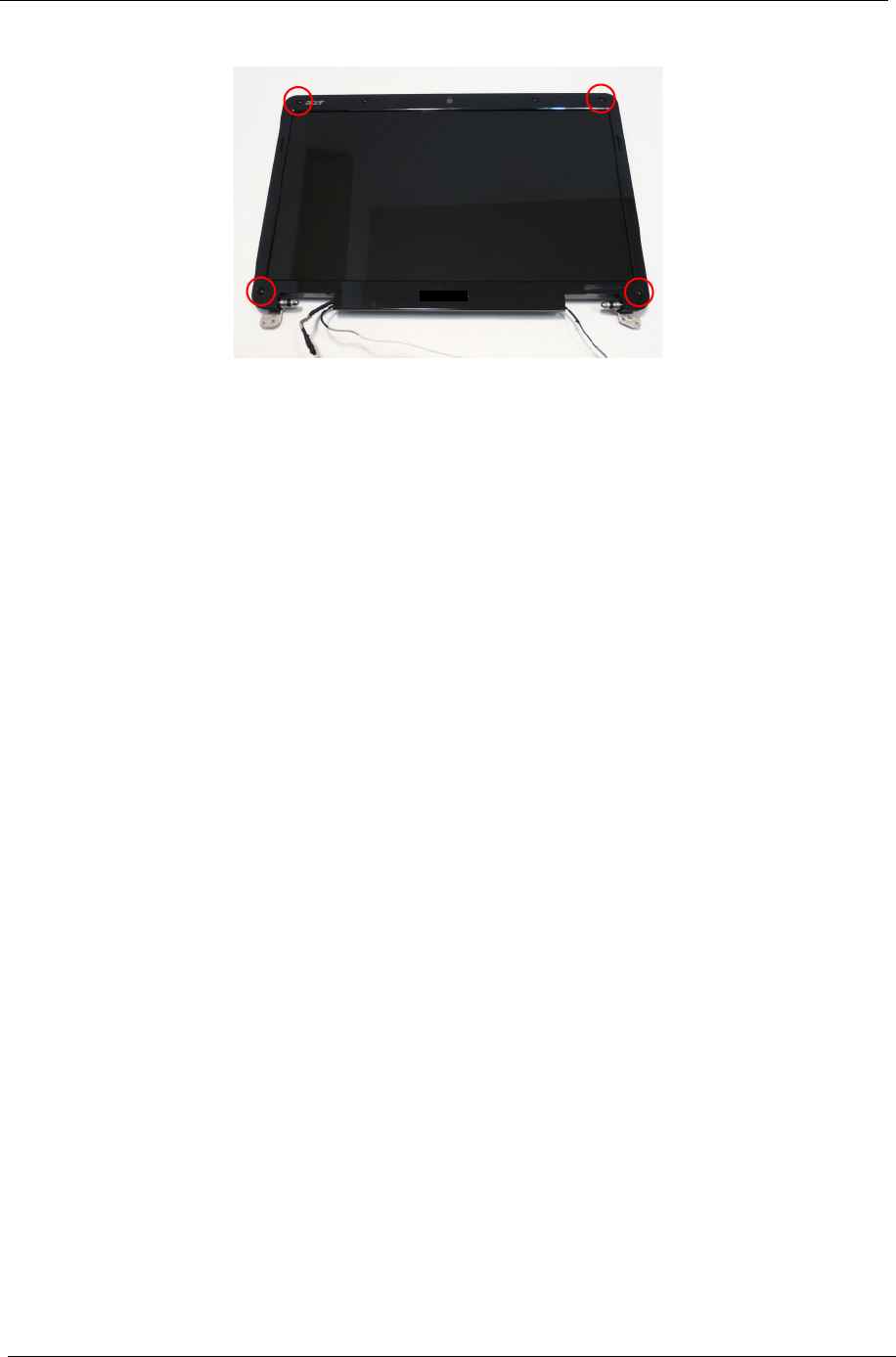
98 Chapter 3
2. Replace the four screws and screw caps provided.
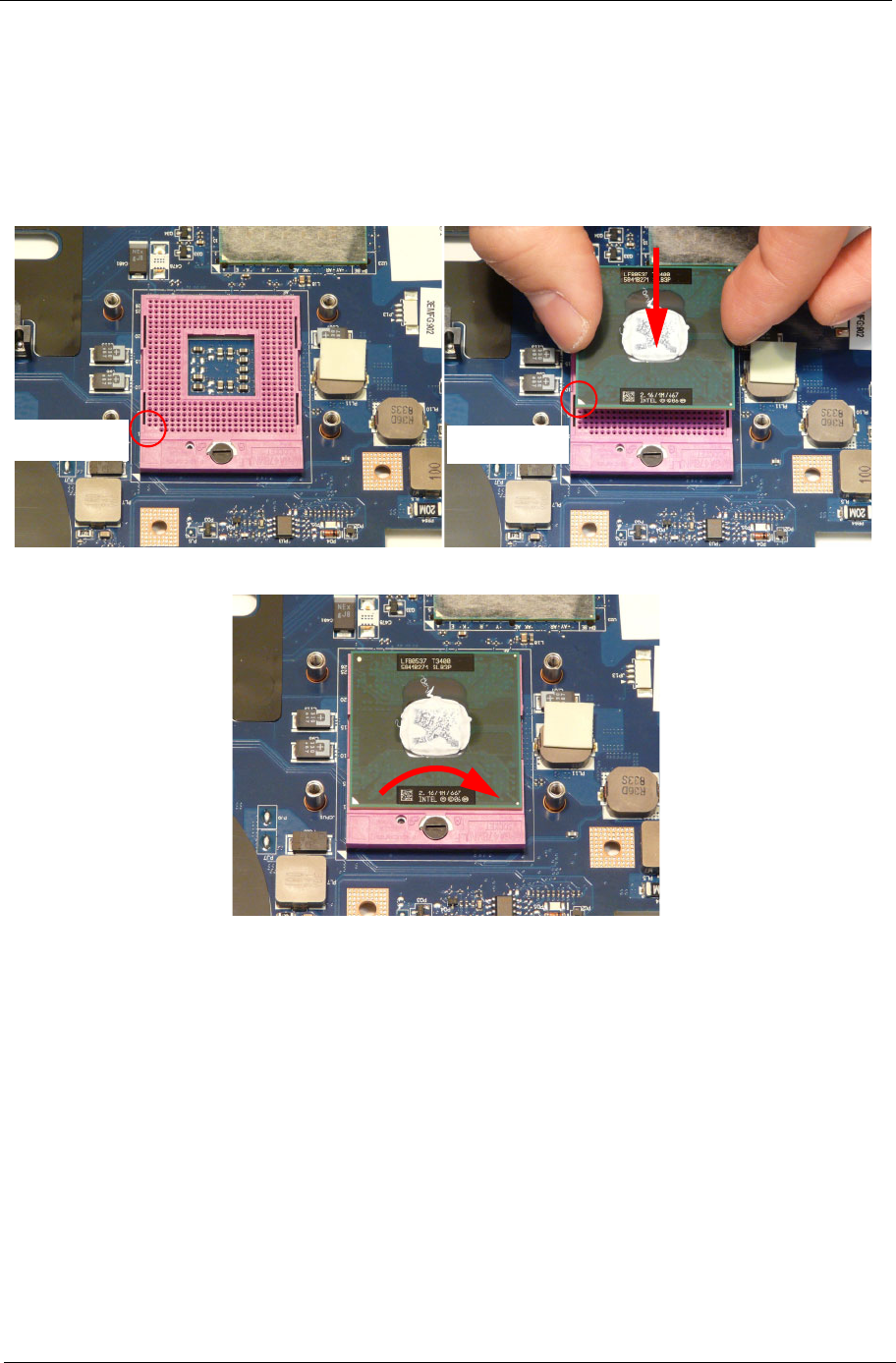
Chapter 3 99
Main Module Reassembly Procedure
Replacing the CPU
IMPORTANT: The CPU has a Pin1 locator that must be positioned corresponding to the marker on the CPU
socket.
1. Place the CPU into the CPU socket as shown, taking note of the Pin1 locator.
2. Using a flat-bladed screw driver, rotate the CPU locking screw 180° clockwise to secure the CPU in place.
Socket
Pin1 Locator CPU
Pin1 Locator
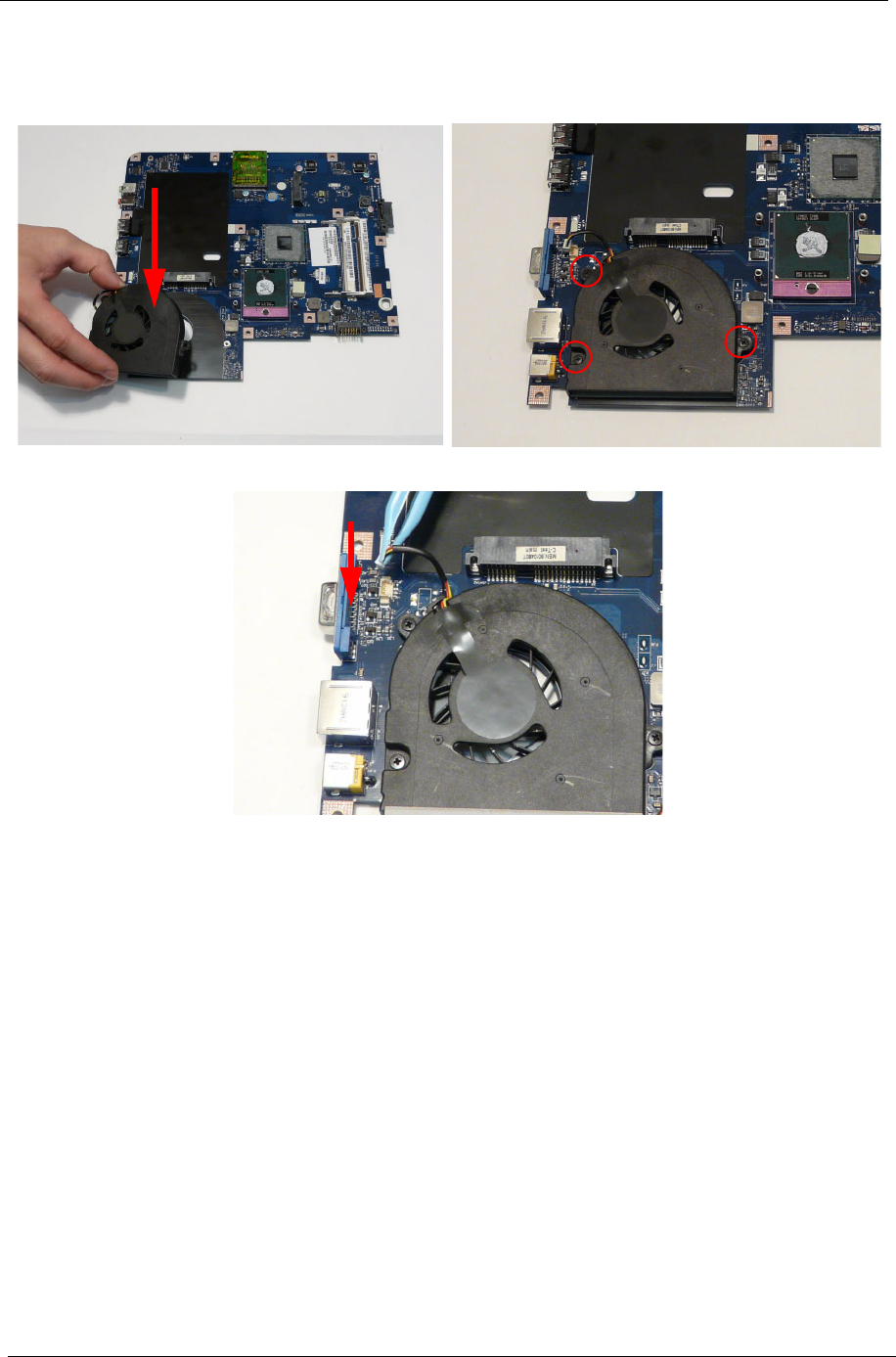
100 Chapter 3
Replacing the CPU Fan
Replacing the Thermal Module
IMPORTANT: Apply a suitable thermal grease and ensure all heat pads are in place before replacing the Thermal
Module.
The following thermal grease types are approved for use:
•Silmore GP50
•Honeywell
•Jet Motor 7762
The following thermal pads are approved for use:
• Eapus XR-PE
1. Align the screw holes on the CPU Fan and
Mainboard and replace the Fan.
2. Replace the three screws to secure the Fan to the
Mainboard.
3. Connect the Fan power cable to the Mainboard connector.
1. Remove all traces of thermal grease from the CPU using a lint-free cloth or cotton swab and Isopropyl
Alcohol, Acetone, or other approved cleaning agent.
2. Apply a small amount of thermal grease to the centre of the CPU—there is no need to spread the grease
manually, the force used during the installation of the Thermal Module is sufficient.
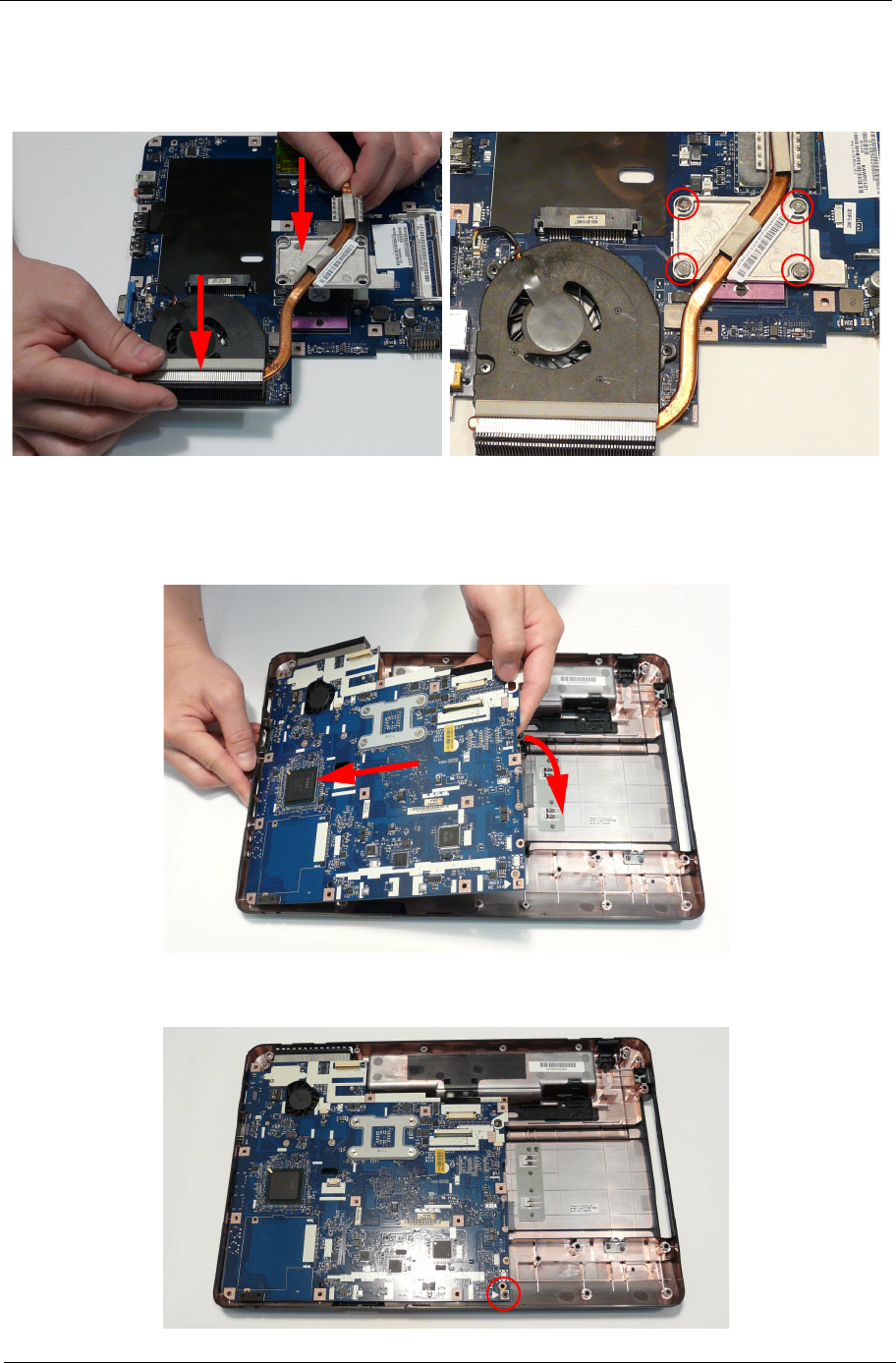
Chapter 3 101
Replacing the Mainboard
3. Align the screw holes on the Thermal Module and
Mainboard then replace the module. Keep the
module as level as possible to spread the thermal
grease evenly.
4. Replace the four securing screws (in numerical
order from screw 1 to screw 4) to secure the
Thermal Module in place.
1. Ensure that the Mainboard is face up (the CPU is not visible). Place the Mainboard in the chassis, left edge
first (1), then rotate it downward into position (2).
NOTE: Ensure the I/O ports are positioned correctly through the casing.
2. Replace the single securing screw in the mainboard.
1
2
3
4
(1) (2)
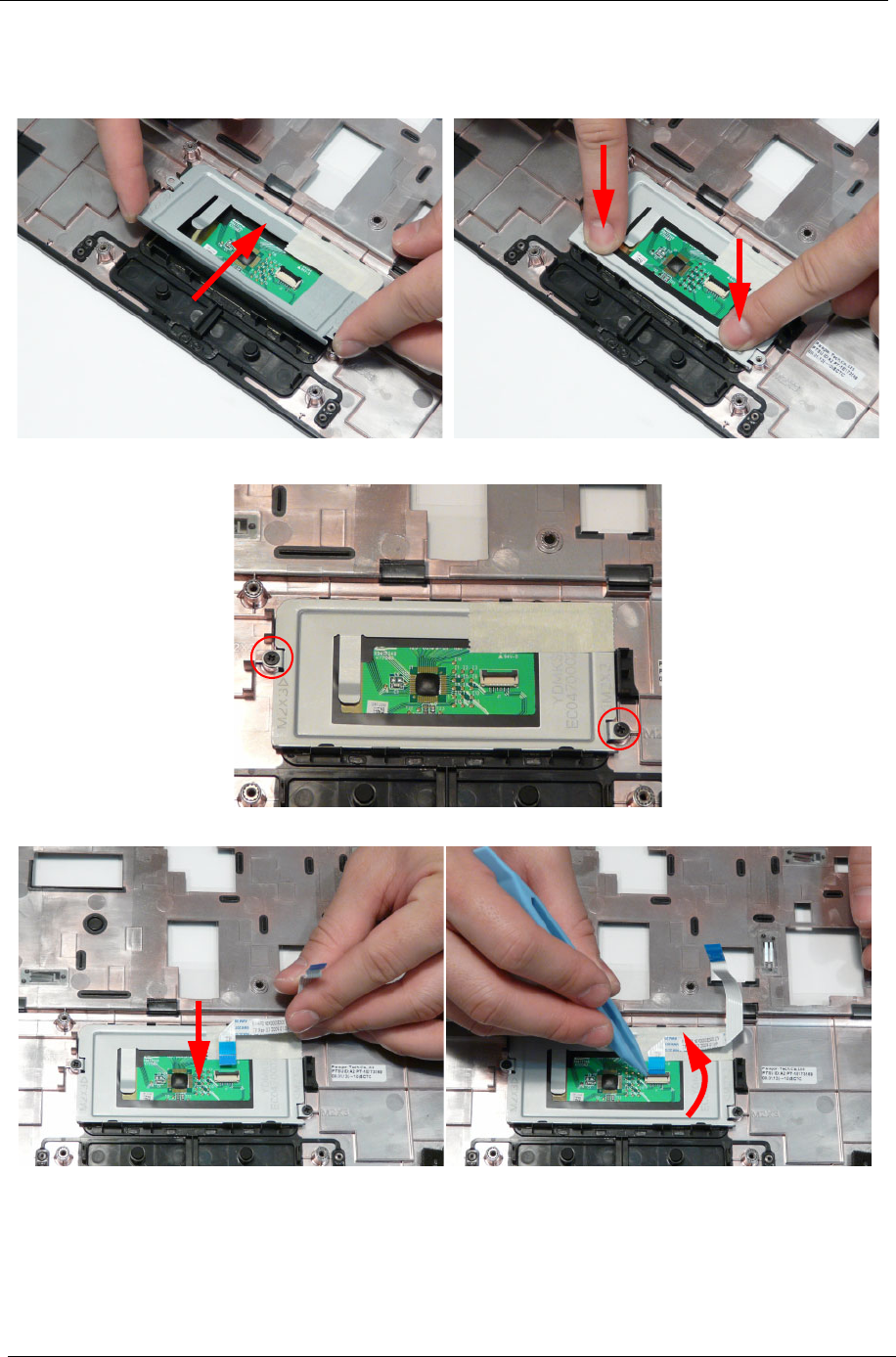
102 Chapter 3
Replacing the TouchPad Bracket
1. Replace the TouchPad bracket top edge first to
engage the securing clips.
2. Press the bracket down to engage the securing
clips.
3. Replace the two screws to secure the TouchPad Bracket to the Upper Cover.
4. Replace the TouchPad FFC and close the locking latch on the connector.
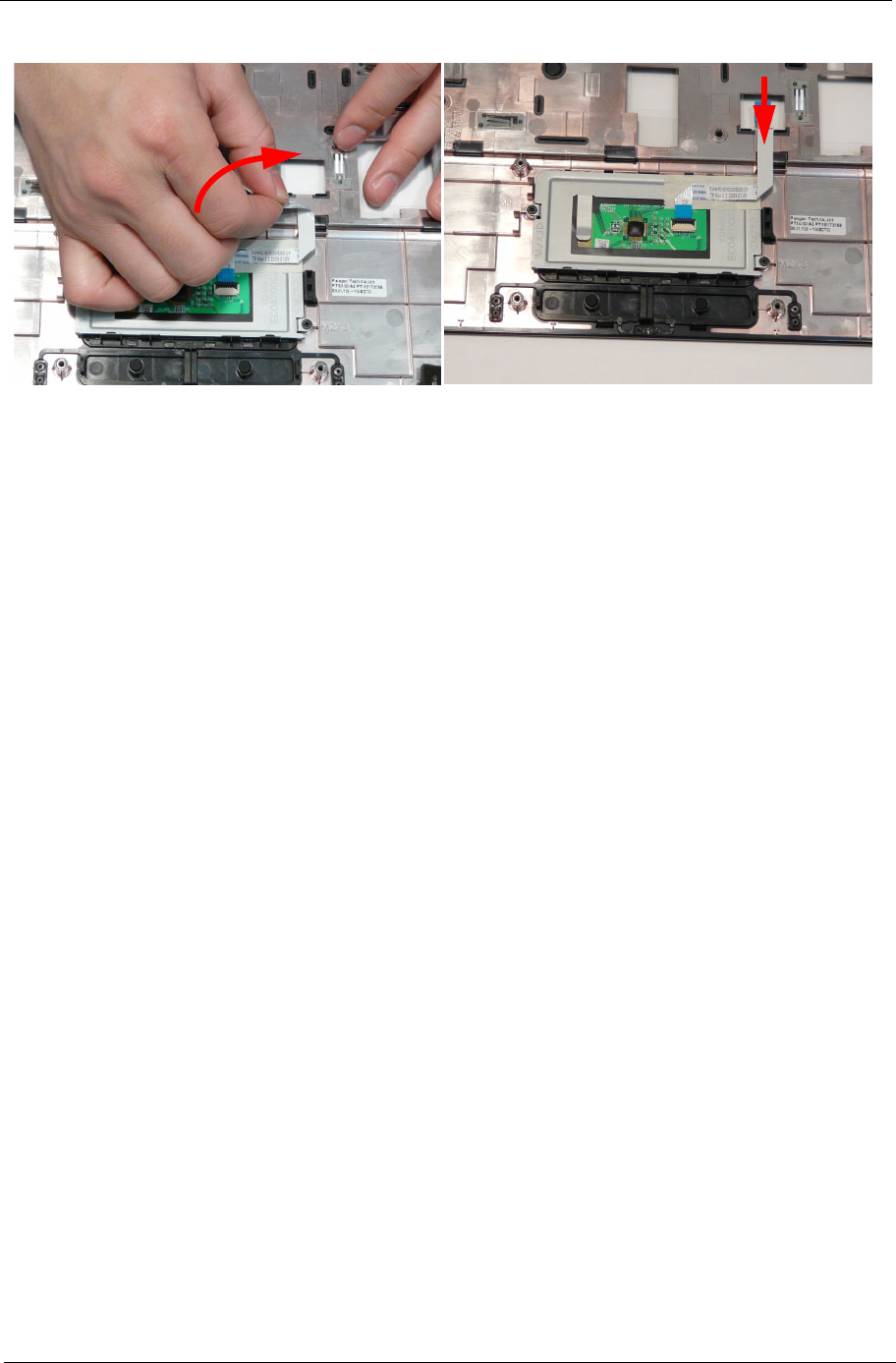
Chapter 3 103
5. Replace the FFC and press down as indicated to secure it to the Upper Cover.
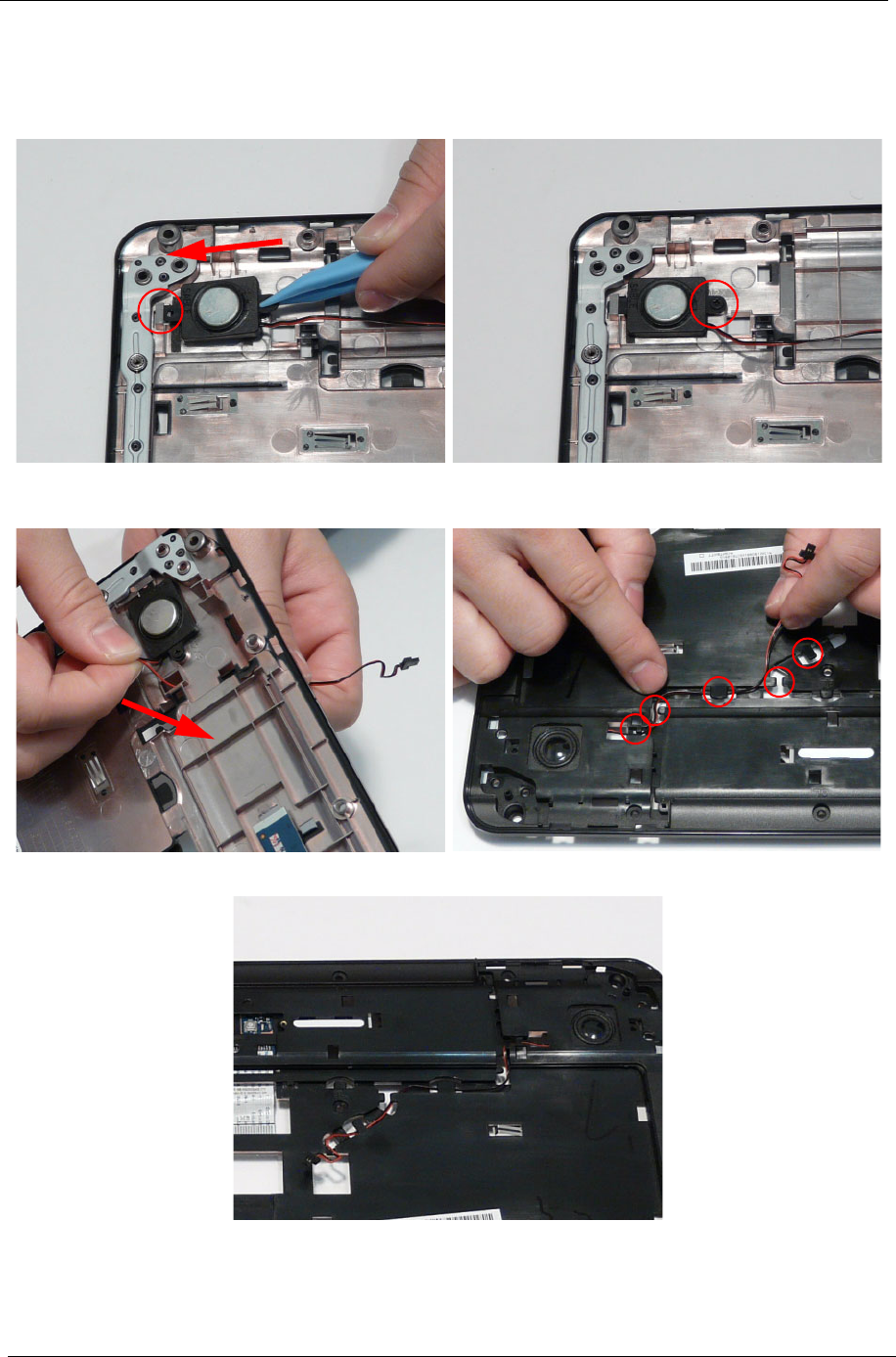
104 Chapter 3
Replacing the Right Speaker Module
1. Place the module left side first on the Upper Cover
as shown. Ensure that the left side of the module is
seated correctly in the securing clip.
2. Replace the single screw to secure the module in
place.
3. Pass the cable through the Upper Cover as shown. 4. Turn the Upper Cover over and run the cable along
the cable channel using all available cable clips.
5. The cable runs as shown when correctly installed.
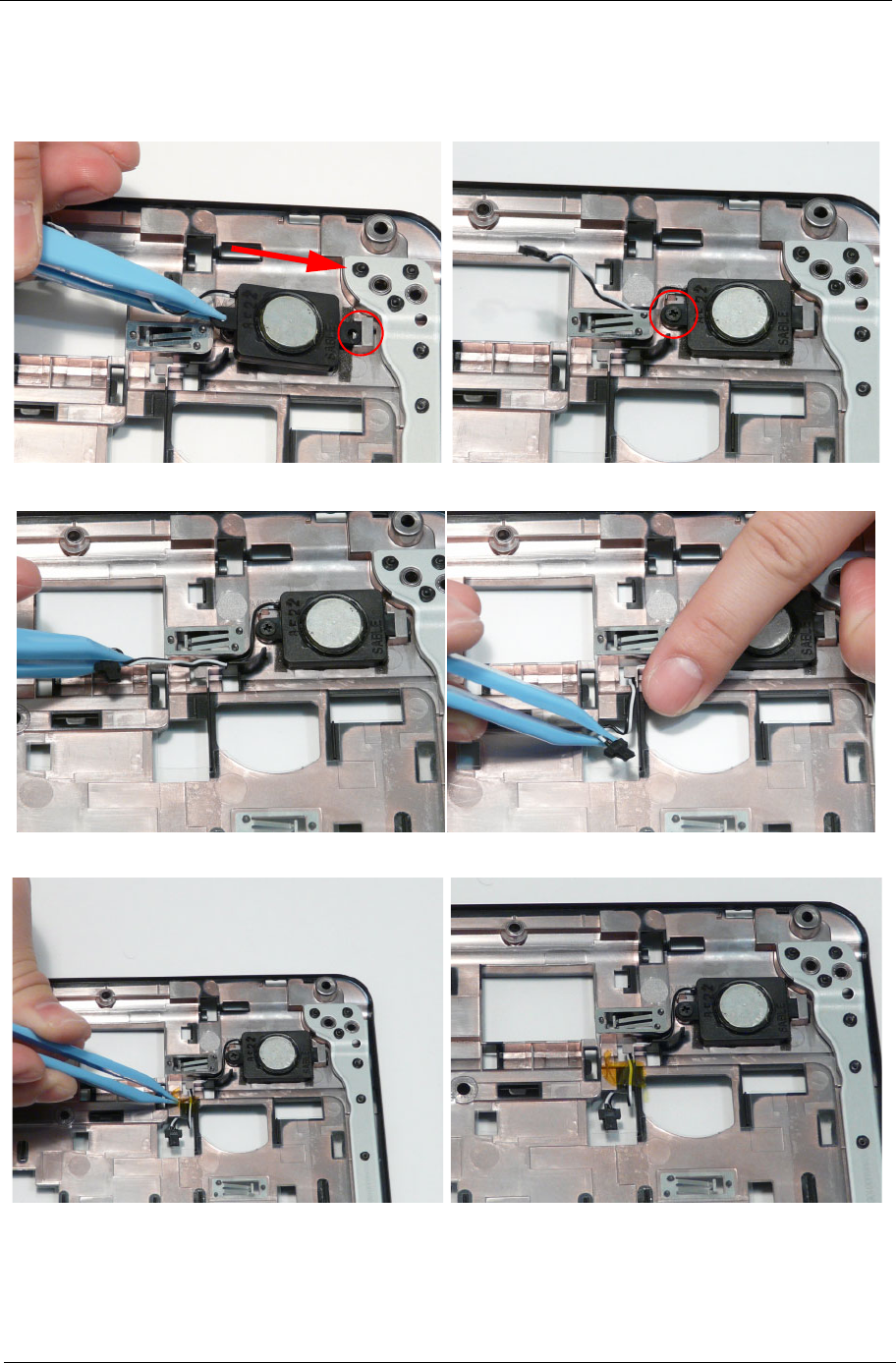
Chapter 3 105
Replacing the Left Speaker Module
1. Place the module right side first on the Upper
Cover as shown. Ensure that the right side of the
module is seated correctly in the securing clip.
2. Replace the single screw to secure the module in
place.
3. Run the cable along the cable channel using all available cable clips.
4. Secure the cable in place with adhesive tape. 5. The cable runs as shown when correctly installed.
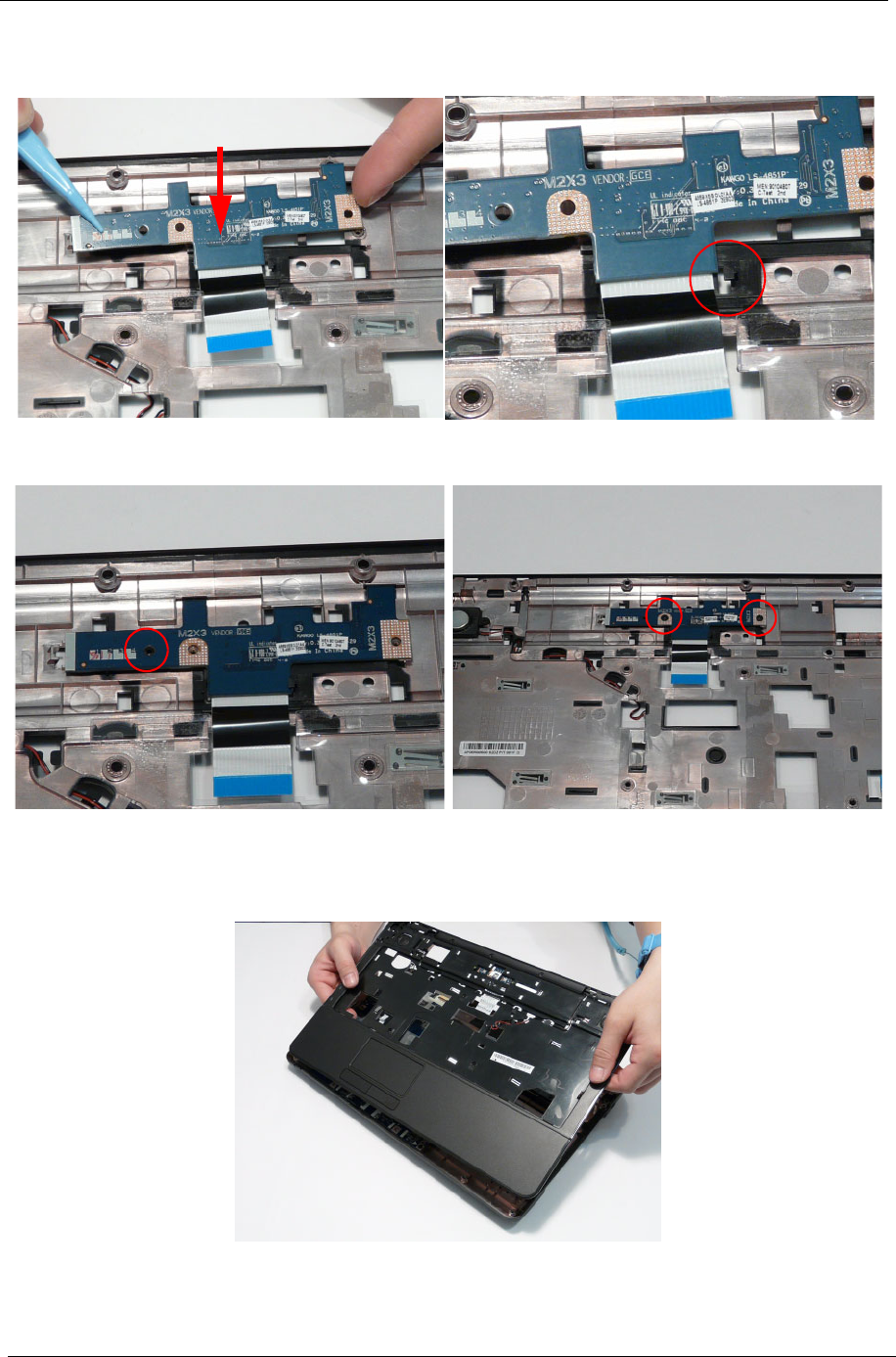
106 Chapter 3
Replacing the Power Board
Replacing the Upper Cover
1. Slide the Power Board in to the Upper Cover front edge first to engage the securing clip.
2. Press the board down to locate the securing pin. 3. Replace the two screws to secure the board to the
Upper Cover.
1. Place the Upper Cover on the Lower Cover as shown.
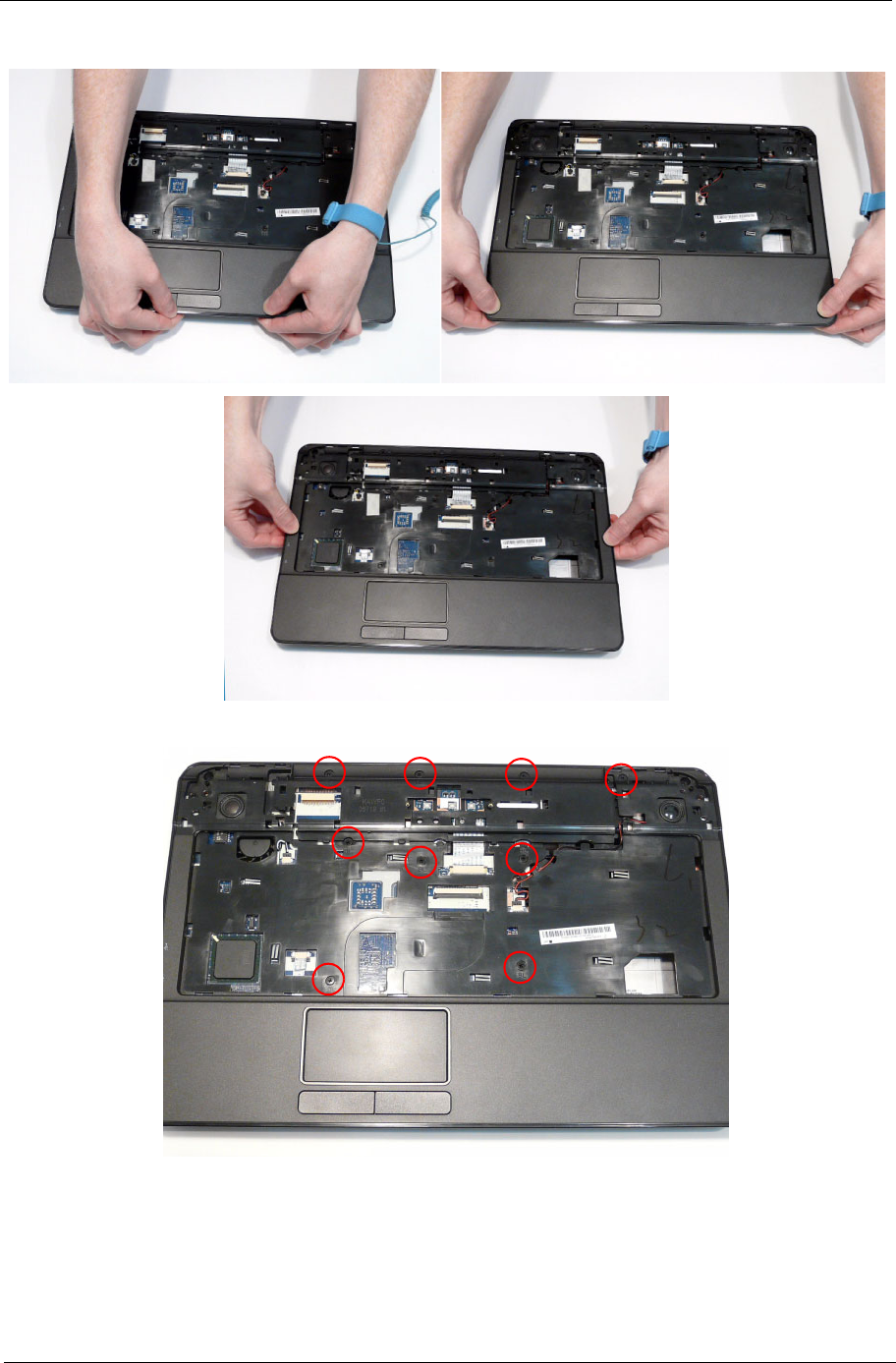
Chapter 3 107
2. Press down around the edges to secure it in place.
3. Replace the nine screws in the Upper Cover as shown.
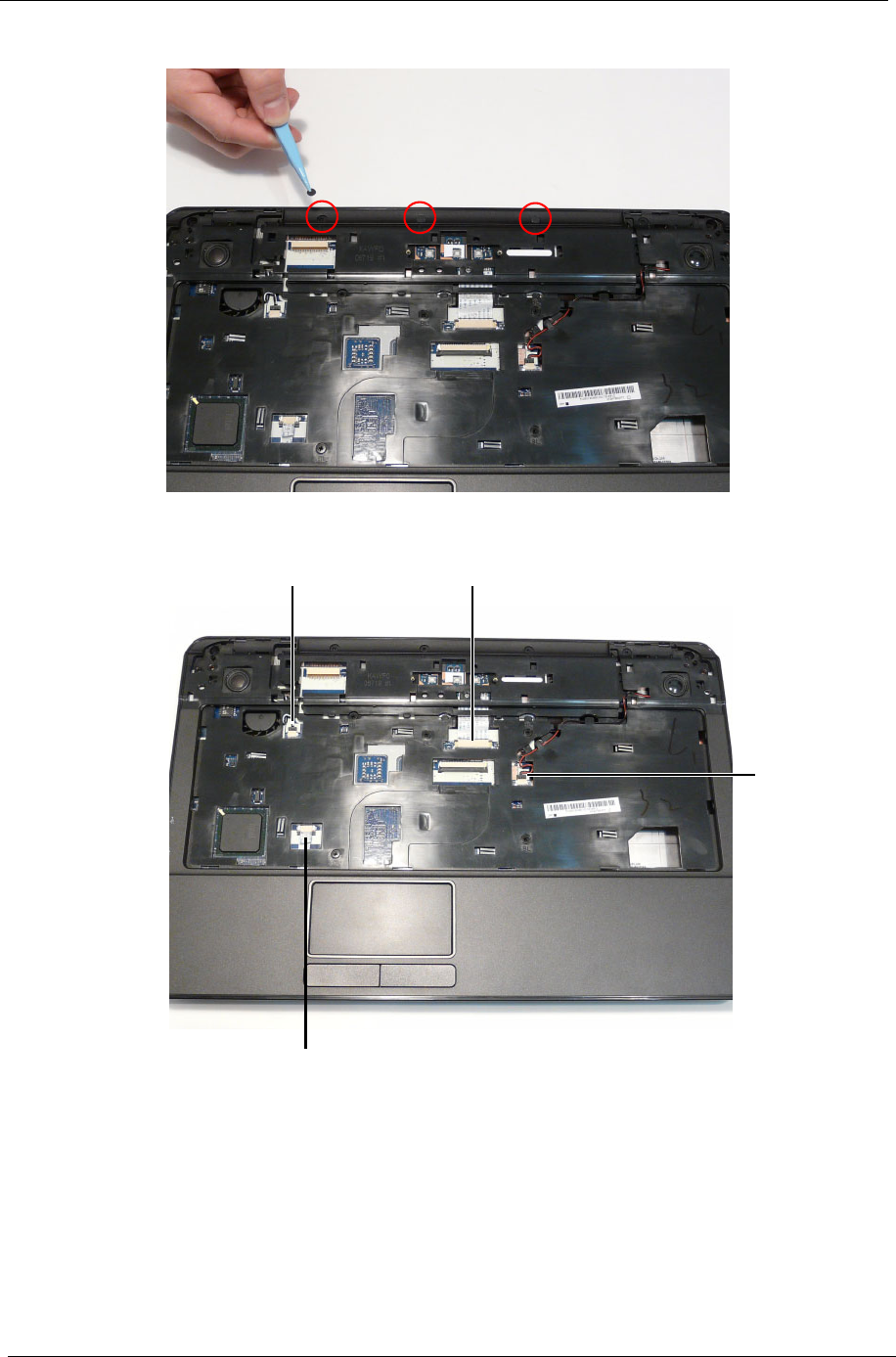
108 Chapter 3
4. Replace the three screw caps as shown.
5. Connect the following cables to the Mainboard.
AB
C
D
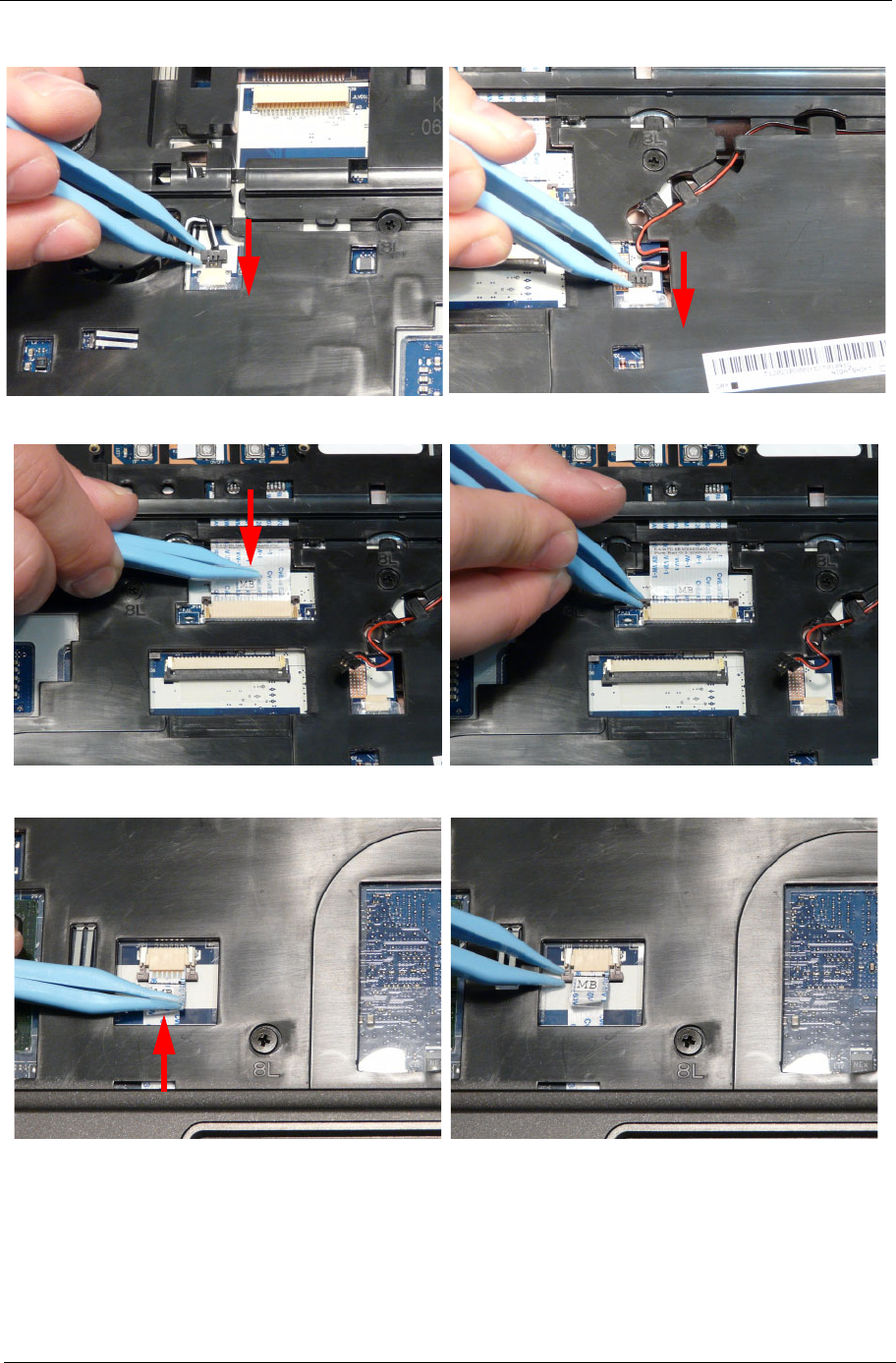
Chapter 3 109
6. Connect A as shown. 7. Connect C as shown.
8. Connect B and close the locking latch to secure the cable in place.
9. Connect D and close the locking latch to secure the cable in place.
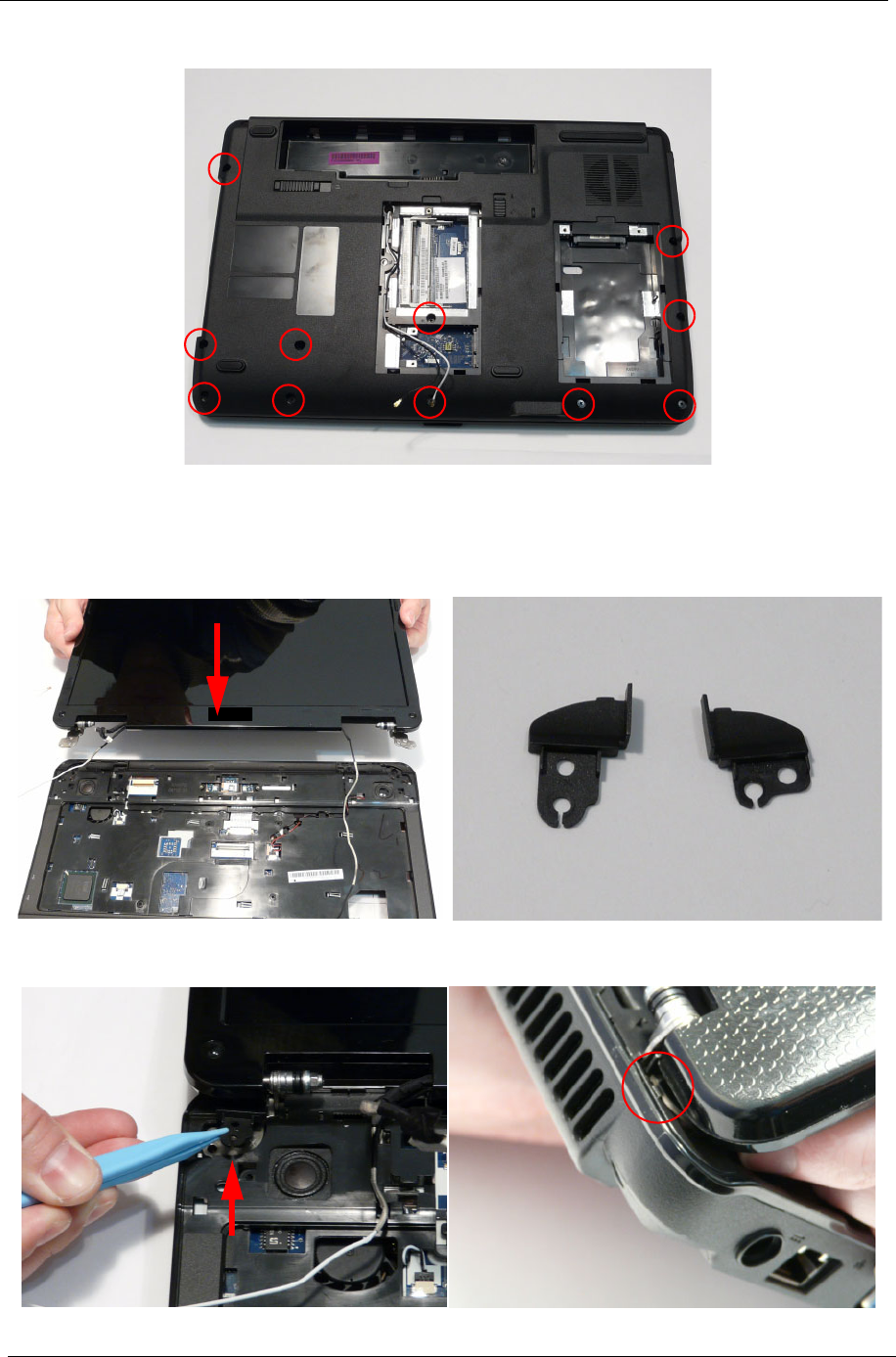
110 Chapter 3
Replacing the LCD Module
10. Turn the computer over and replace the eleven screws as shown.
1. Align the screw holes on the LCD Module and
Upper Cover and replace the LCD Module.
2. The left and right screw covers are shaped
differently. Ensure that the correct cover is used.
3. Replace the left screw cover as shown. Ensure that the securing tab on the rear of the cover is seated
correctly in the Upper Cover.
Left Screw
Cover Right Screw
Cover
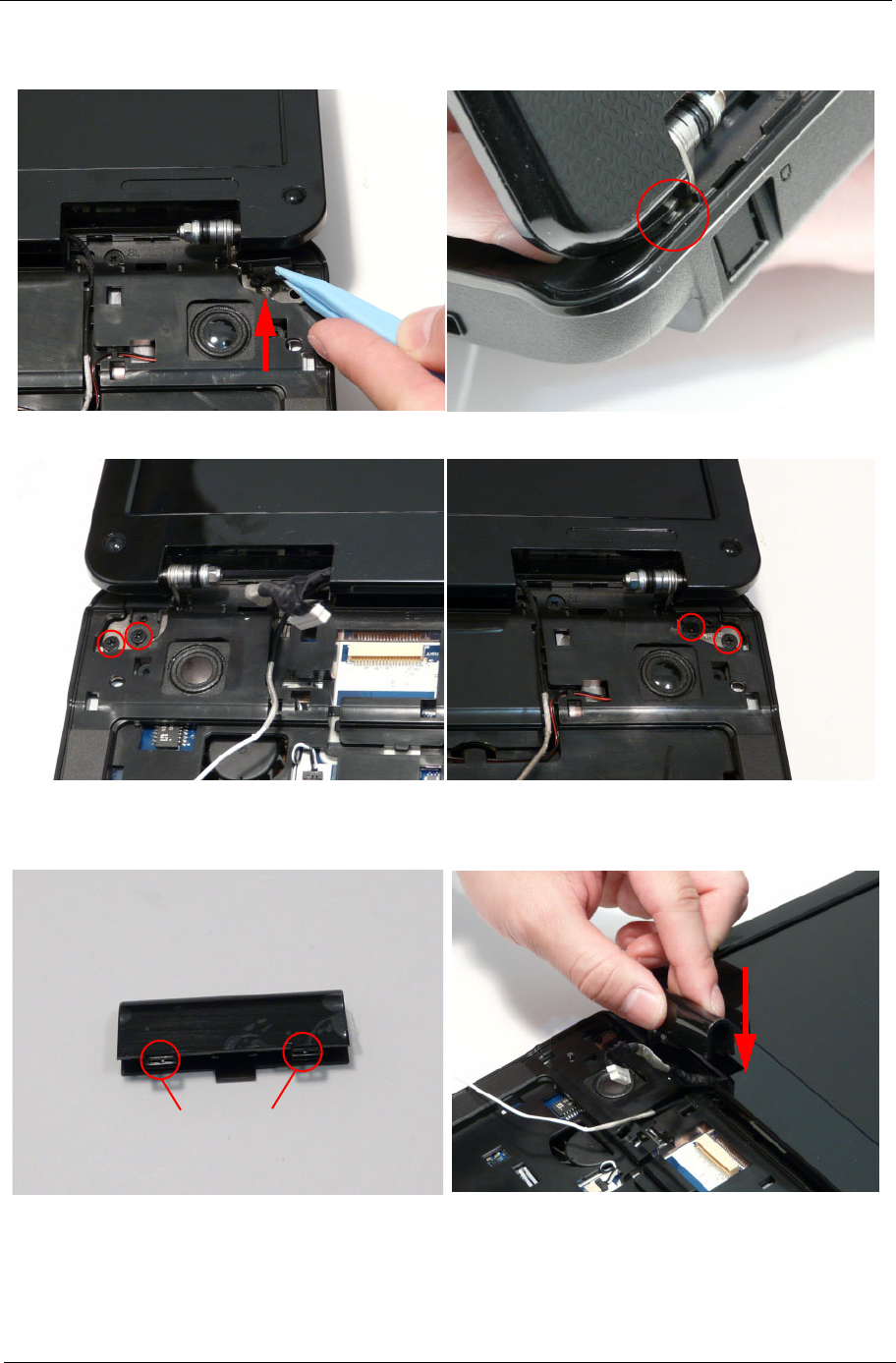
Chapter 3 111
4. Replace the right screw cover as shown. Ensure that the securing tab on the rear of the cover is seated
correctly in the Upper Cover.
5. Replace the four screws securing the LCD Module to the Upper Cover.
6. Ensure that the Hinge Covers are replaced
correctly. Identify the rear edge of the covers by the
two securing clips.
7. Align the left Hinge Cover as shown and press
down to replace the cover.
8. Repeat the process for the right side Hinge Cover.
Rear Securing
Clips
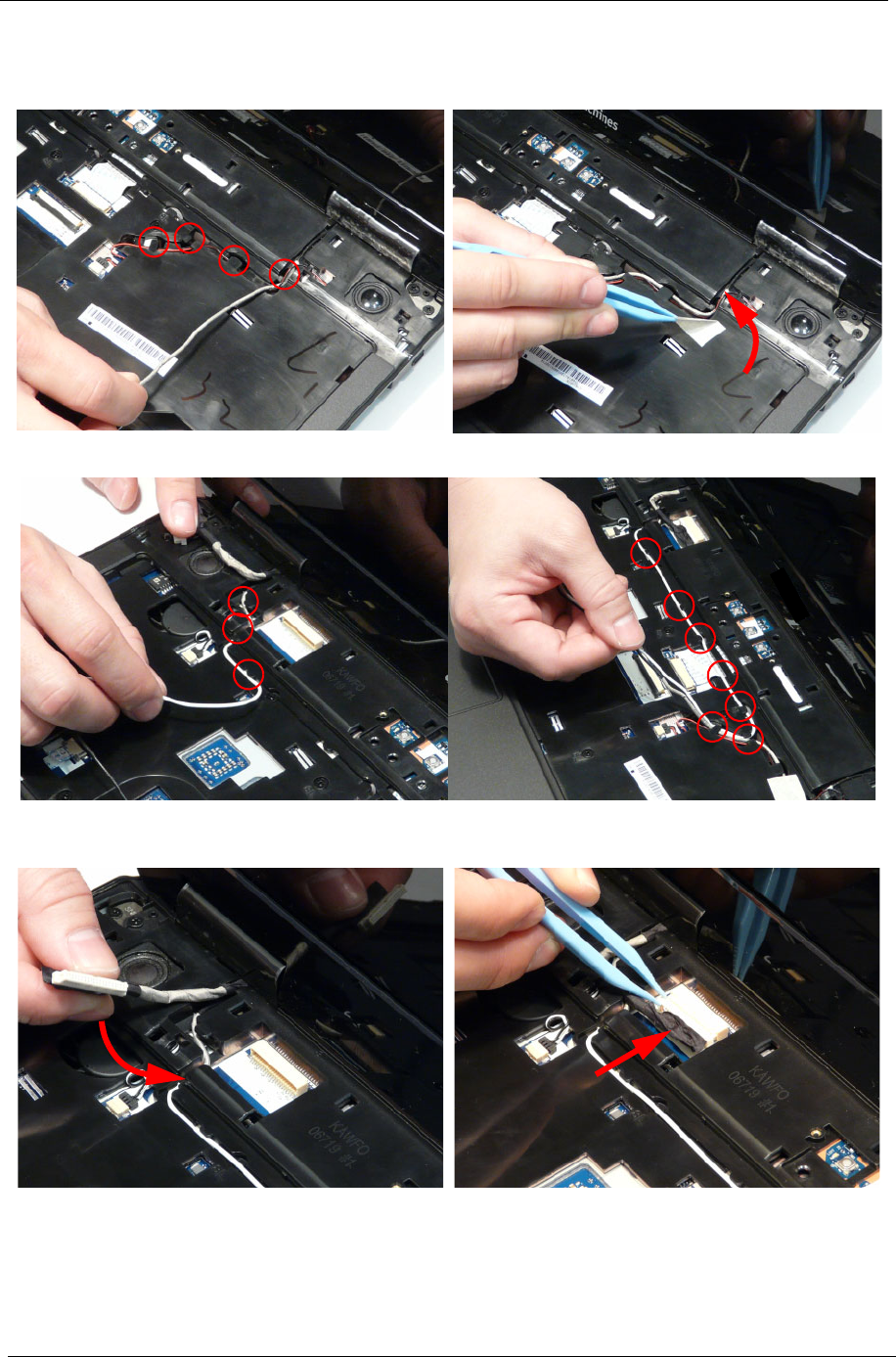
112 Chapter 3
9. Run the black Antenna cable along the cable
channel as shown using all available retaining
clips.
10. Replace the adhesive strip to secure the cable in
place.
11. Run the white Antenna cable along the cable channel as shown using all available retaining clips.
12. Run the LCD cable along the cable channel using
all available cable clips.
13. Connect the LCD cable to the Mainboard as
shown.
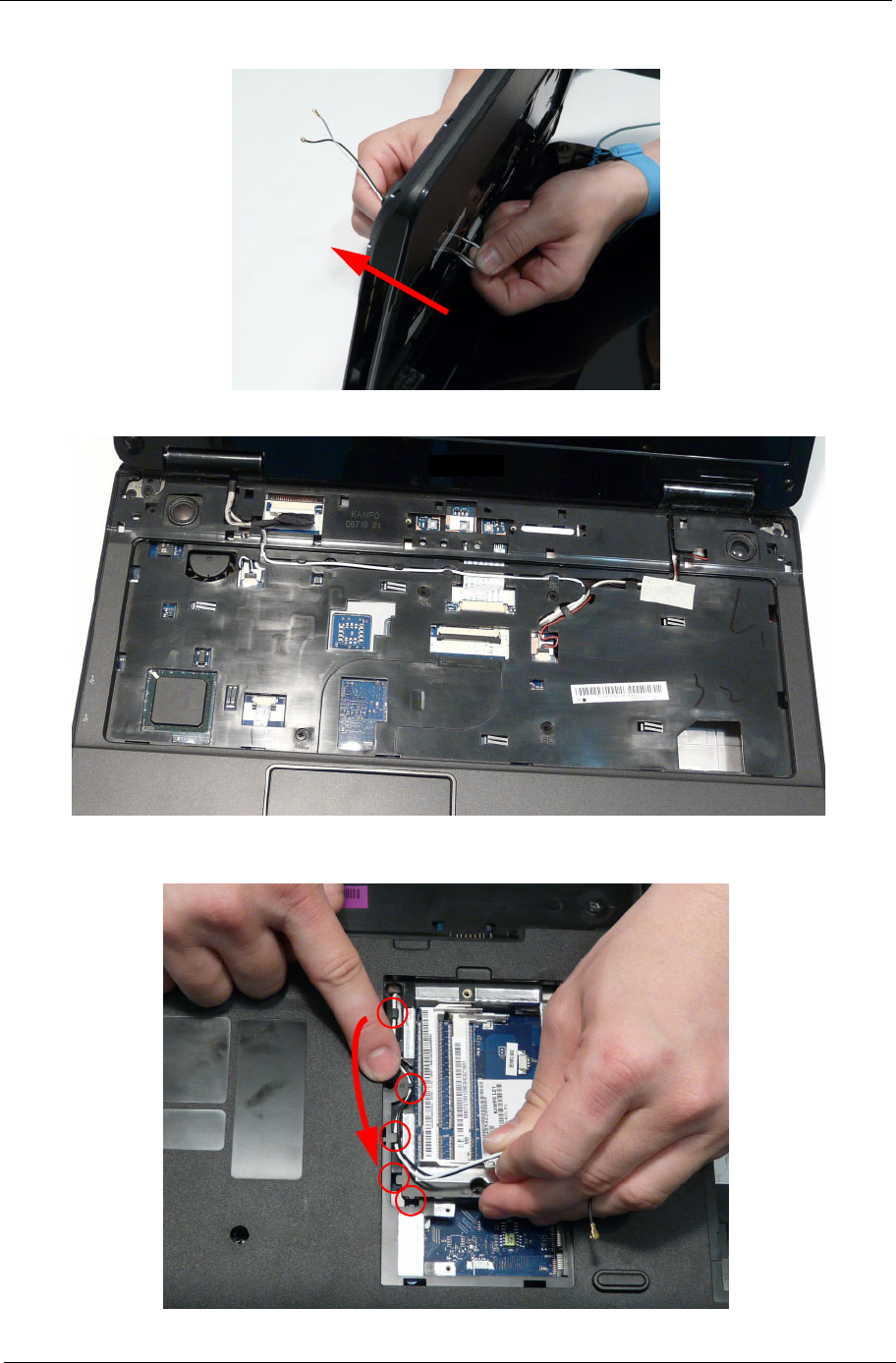
Chapter 3 113
14. Stand the computer on the LCD Panel and pass the Antenna cables through the chassis.
15. The Upper Cover appears as shown when the Antenna and LCD cables are correctly installed.
16. Turn the computer over. Run the Antenna cables along the cable channel as shown, using all available
cable clips.
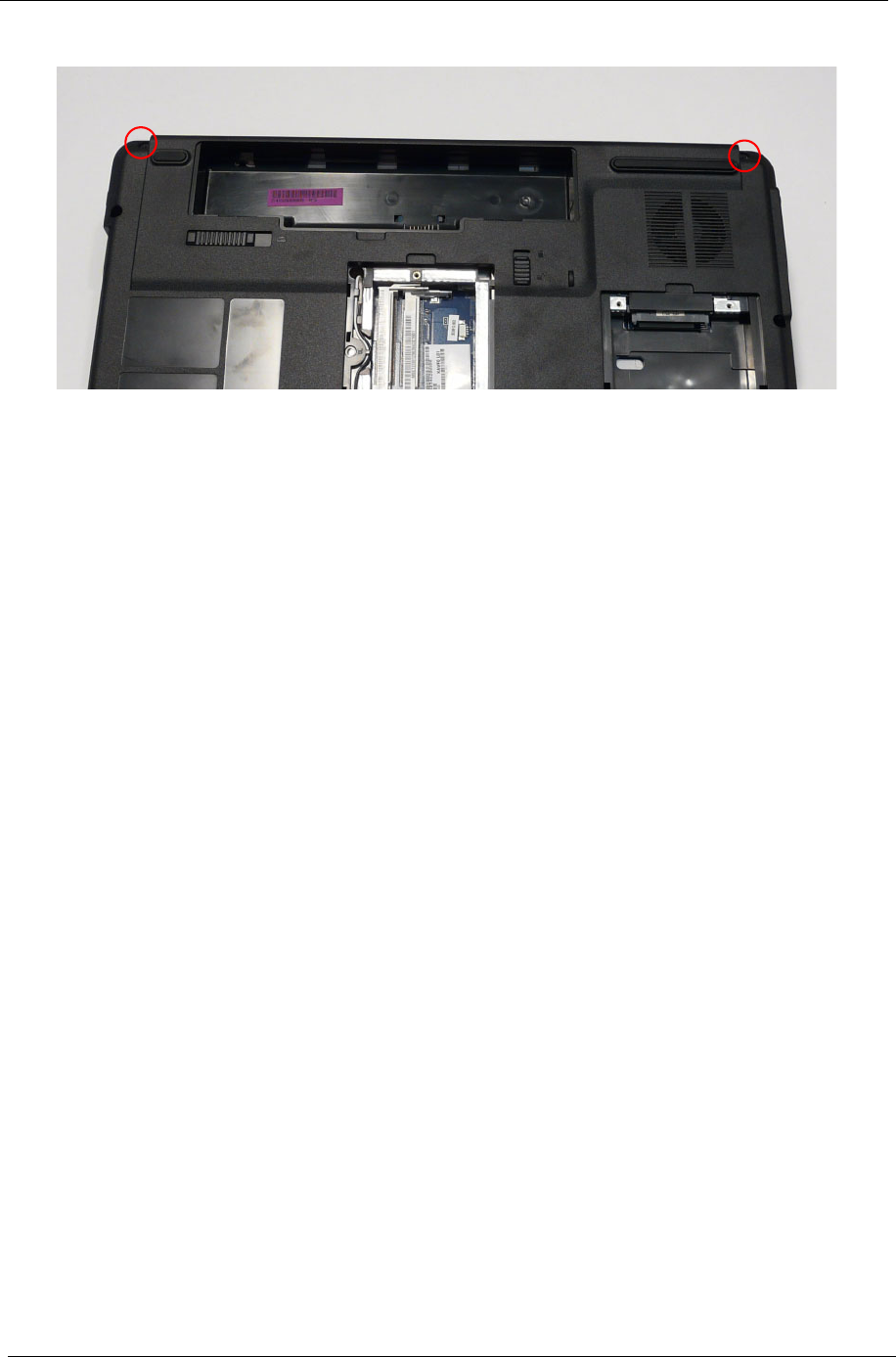
114 Chapter 3
17. Replace the two screws securing the LCD Module to the Lower Cover.
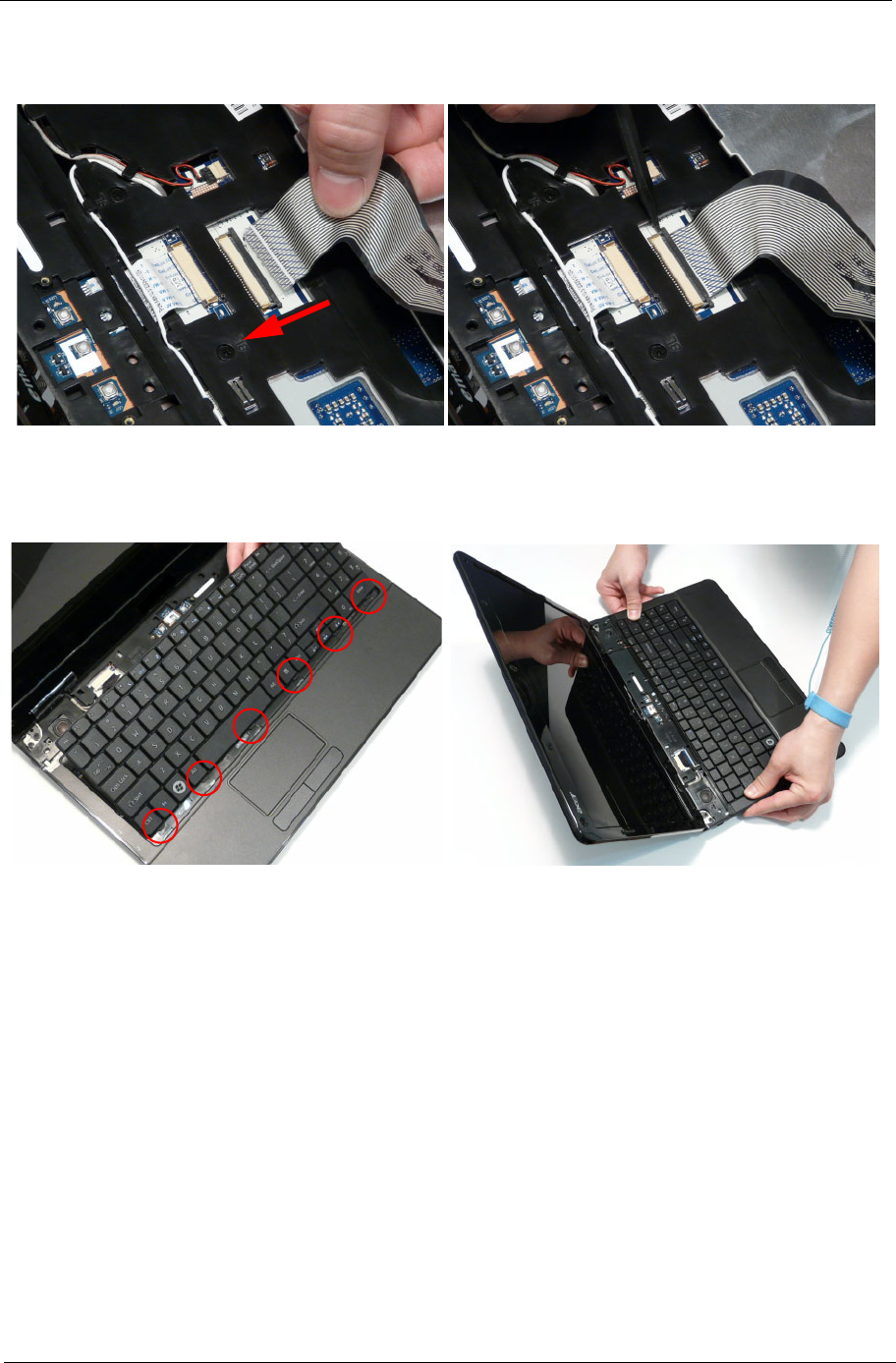
Chapter 3 115
Replacing the Keyboard
1. Connect the Keyboard FFC to the Mainboard and close the locking latch to secure the cable in place.
2. Turn the Keyboard over and insert it front edge first
into the chassis.
NOTE: Ensure that the six locating tabs are
correctly seated.
3. Press down as indicated to secure the Keyboard in
place.
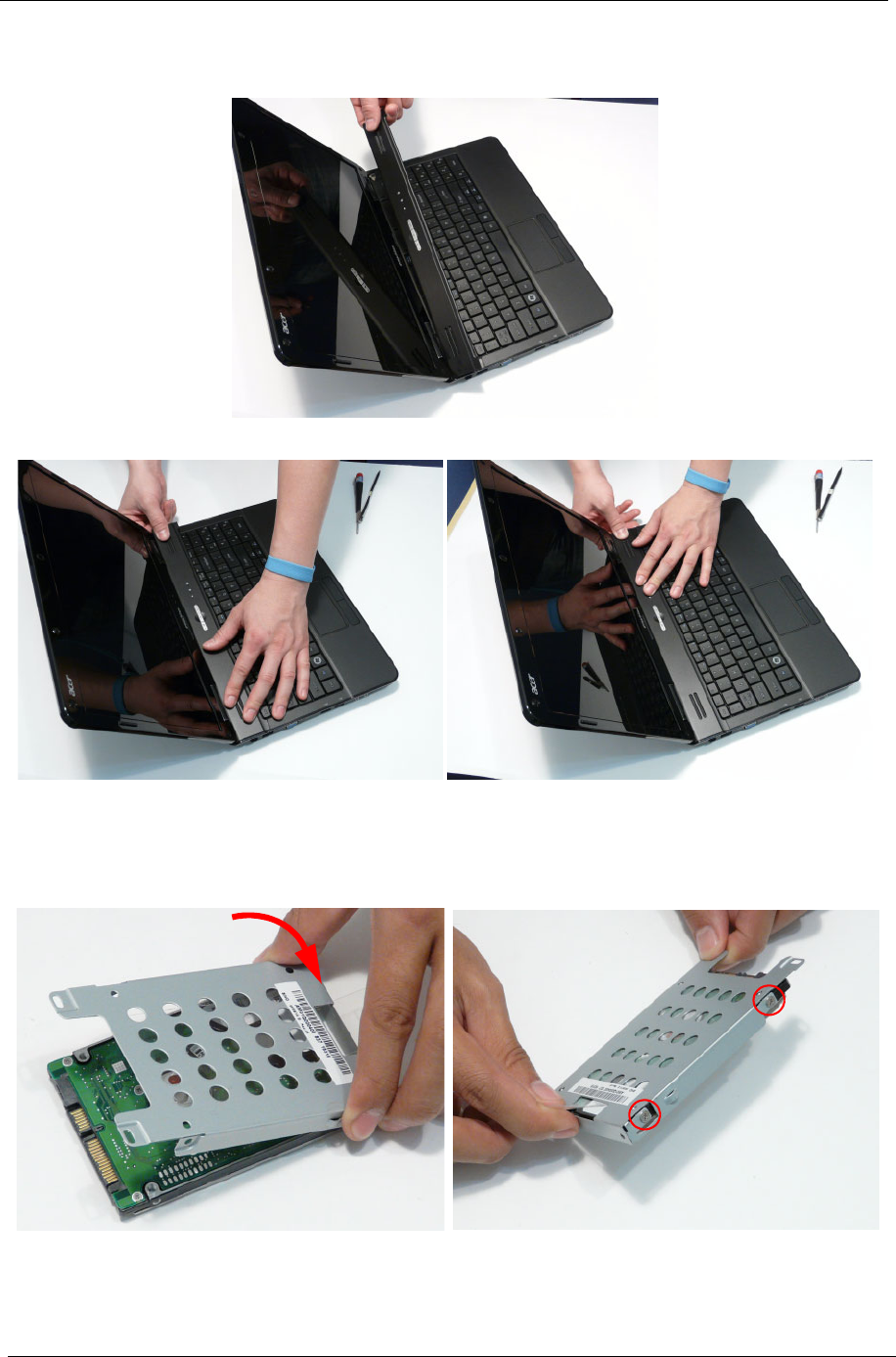
116 Chapter 3
Replacing the Switch Cover
Replacing the Hard Disk Drive Module
1. Place the Switch Cover left side first on to the Upper Cover.
2. Press down as indicated to snap the Switch Cover into place.
1. Place the HDD in the HDD carrier. 2. Replace the four screws (two each side) to secure
the carrier.
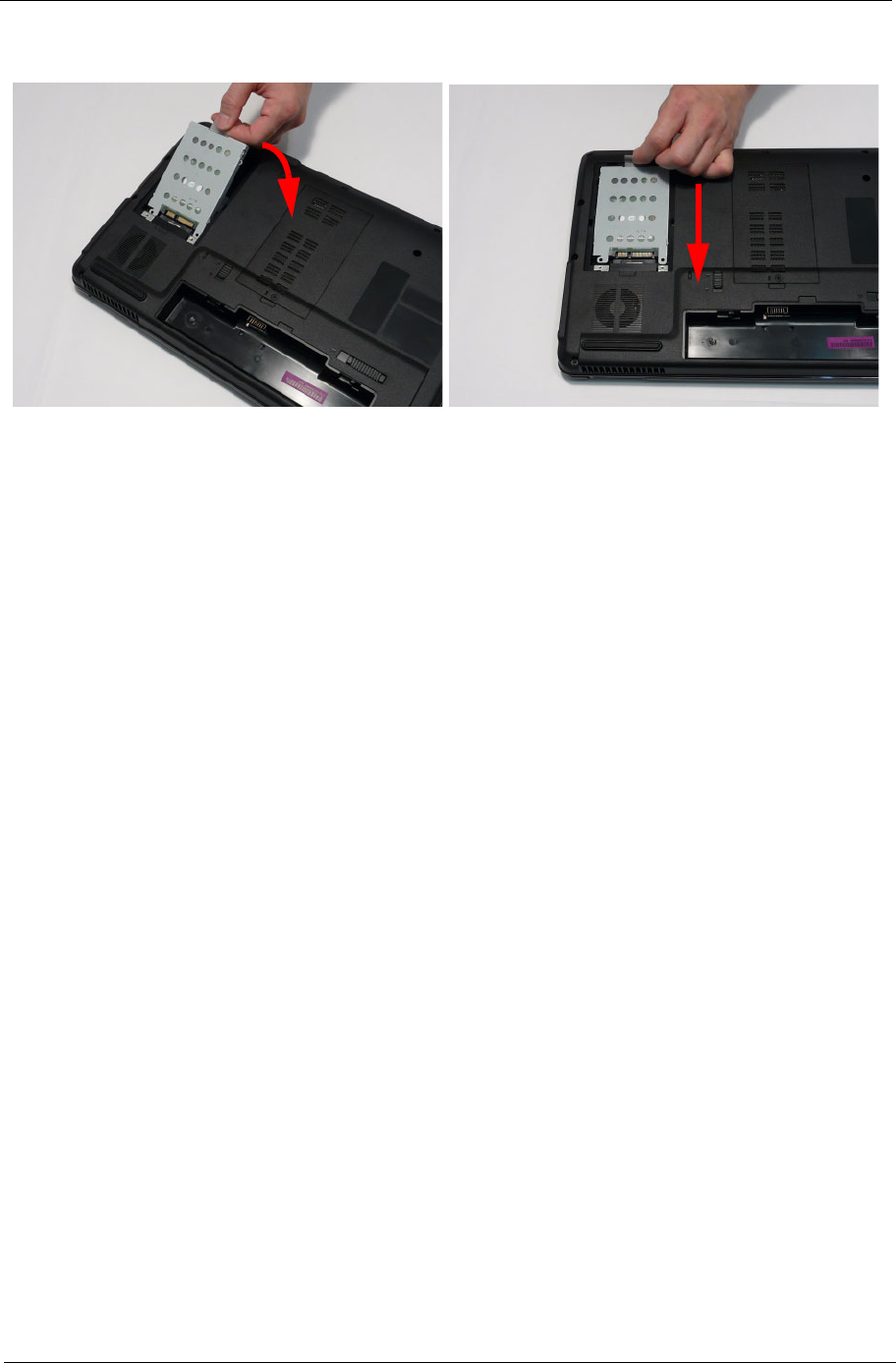
Chapter 3 117
3. Insert the HDD, as indicated and lower it into
place.
4. Slide the HDD in the direction of the arrow to
connect the interface.
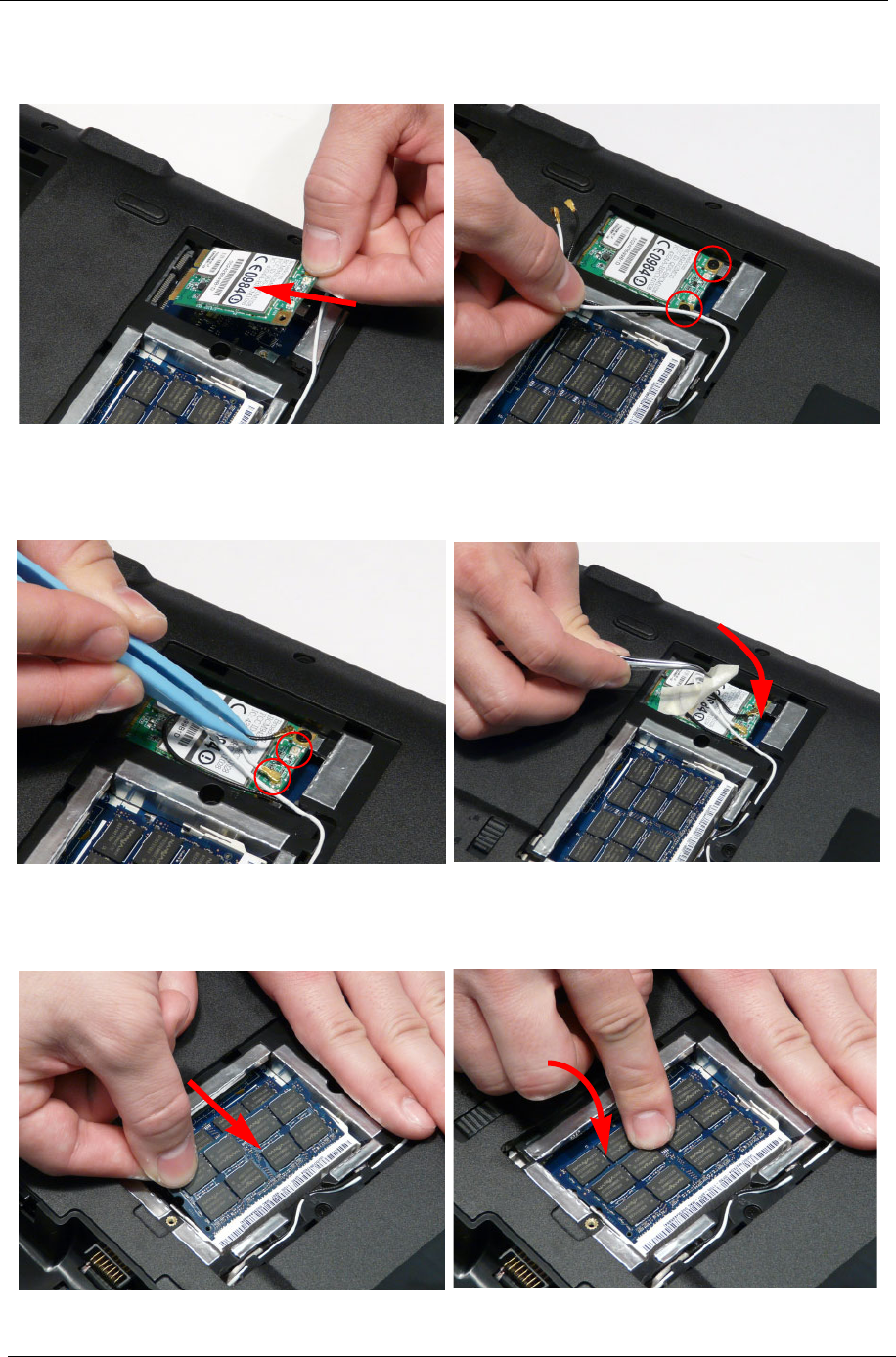
118 Chapter 3
Replacing the WLAN Module
Replacing the DIMM Modules
1. Insert the WLAN Module into the WLAN socket. 2. Replace the two screws to secure the module.
3. Connect the two Antenna cables to the module.
NOTE: The black cable connects to the upper
terminal (MAIN) and the white cable to the
lower terminal (MAIN).
4. After connecting the cables to the terminals,
secure the cables in place with adhesive tape to
avoid trapping.
1. Insert the DIMM Module in place. 2. Press down to lock the DIMM module in place.
3. Repeat steps for the second DIMM module if present.
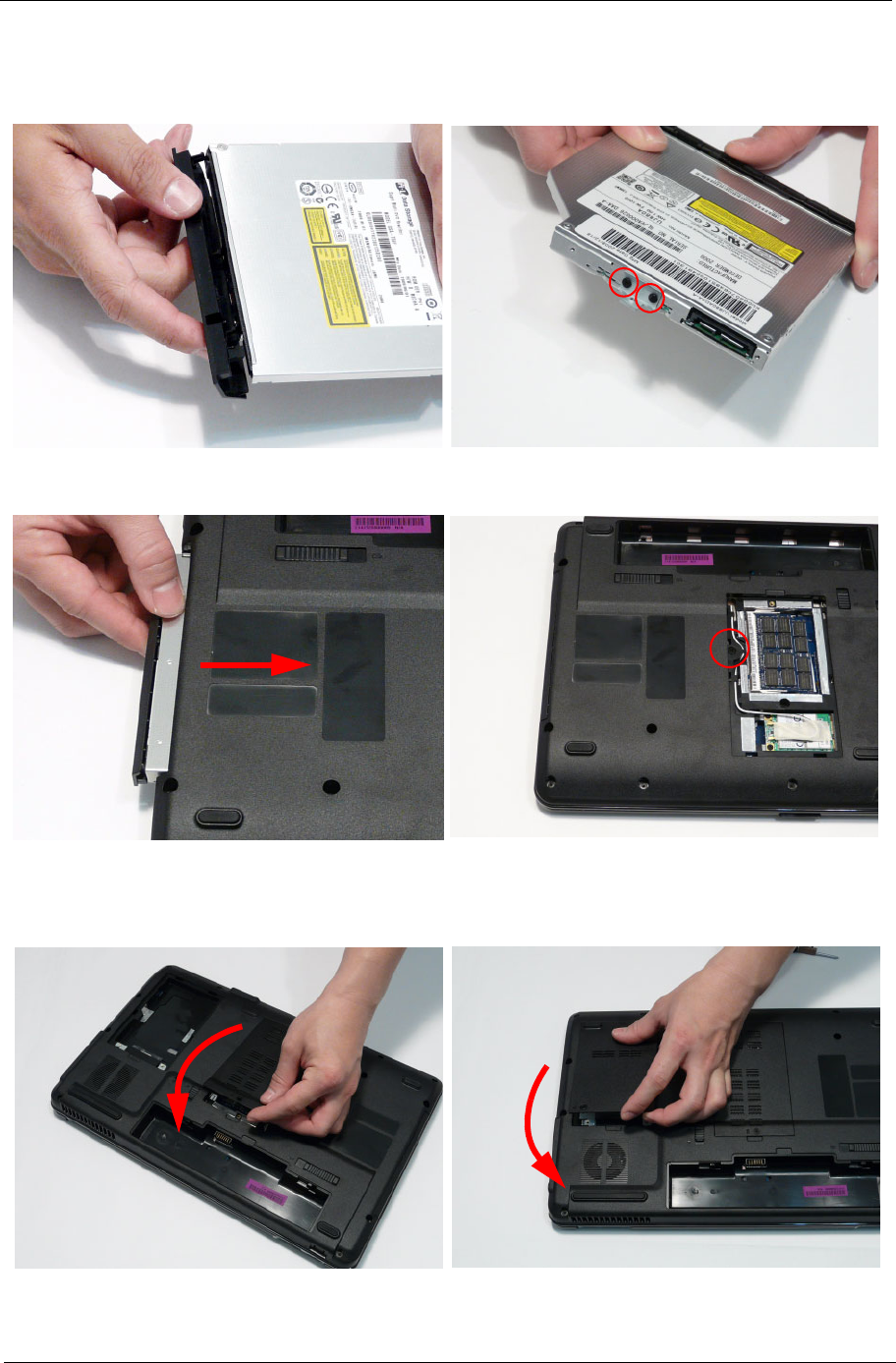
Chapter 3 119
Replacing the ODD Module
Replacing the Lower Covers
1. Press the bezel into the tray, bottom edge first, to
secure it to the ODD Module.
2. Secure the ODD bracket with the two screws.
3. Push the ODD Module into the ODD bay until it is
flush with the casing.
4. Replace the single screw to secure the Module.
1. Replace the Memory Cover as shown. 2. Replace the HDD Cover as shown.
IMPORTANT: Press down around the perimeter of the covers to ensure that the all the securing tabs are
correctly located in the casing.
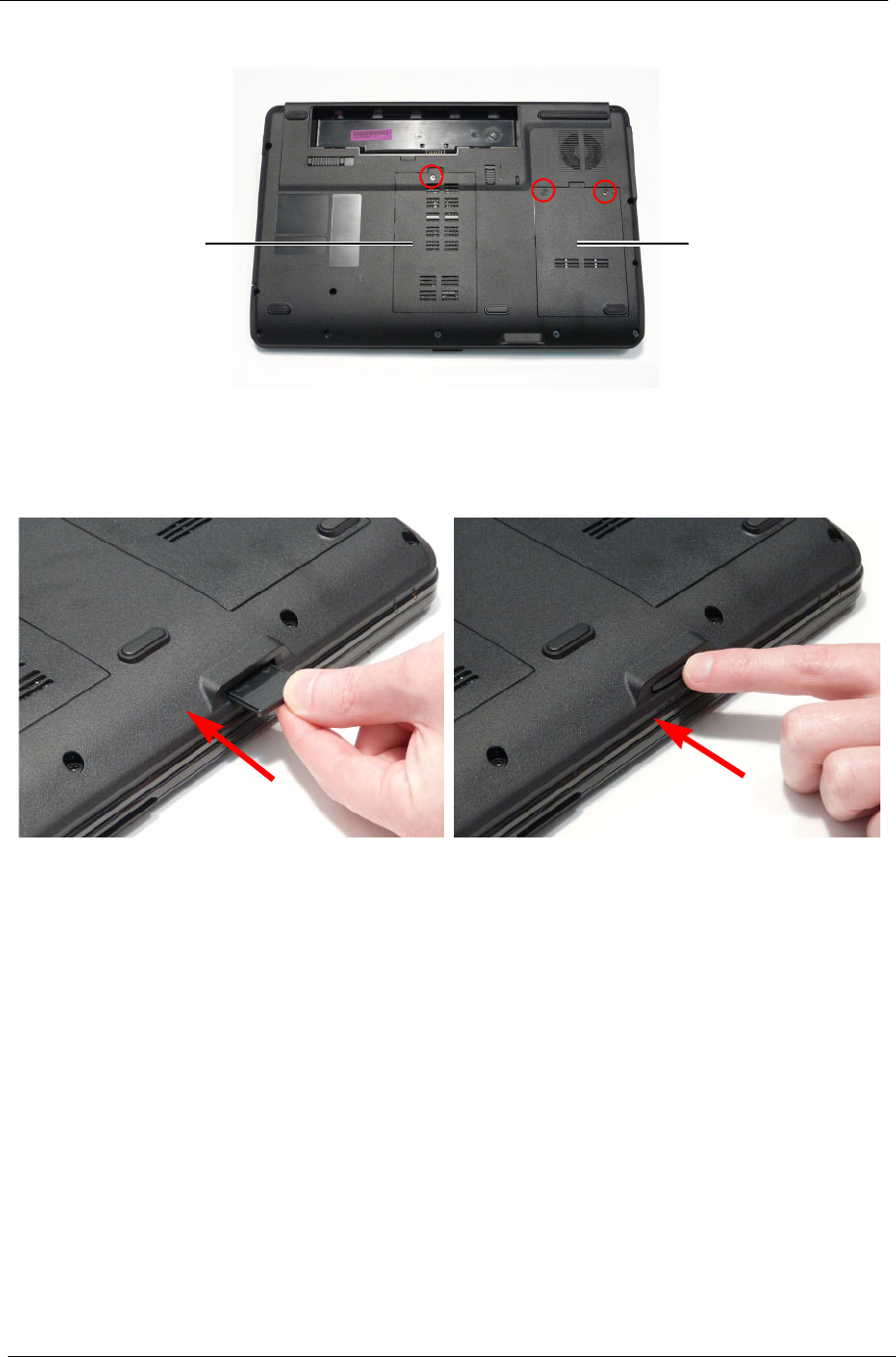
120 Chapter 3
Replacing the SD Dummy Card
3. Replace the three screws to secure the covers in place.
1.
Insert the SD Dummy Card into the slot as shown.
2.
Push until the card clicks into place and is flush with
the casing.
Memory
Cover
HDD
Cover
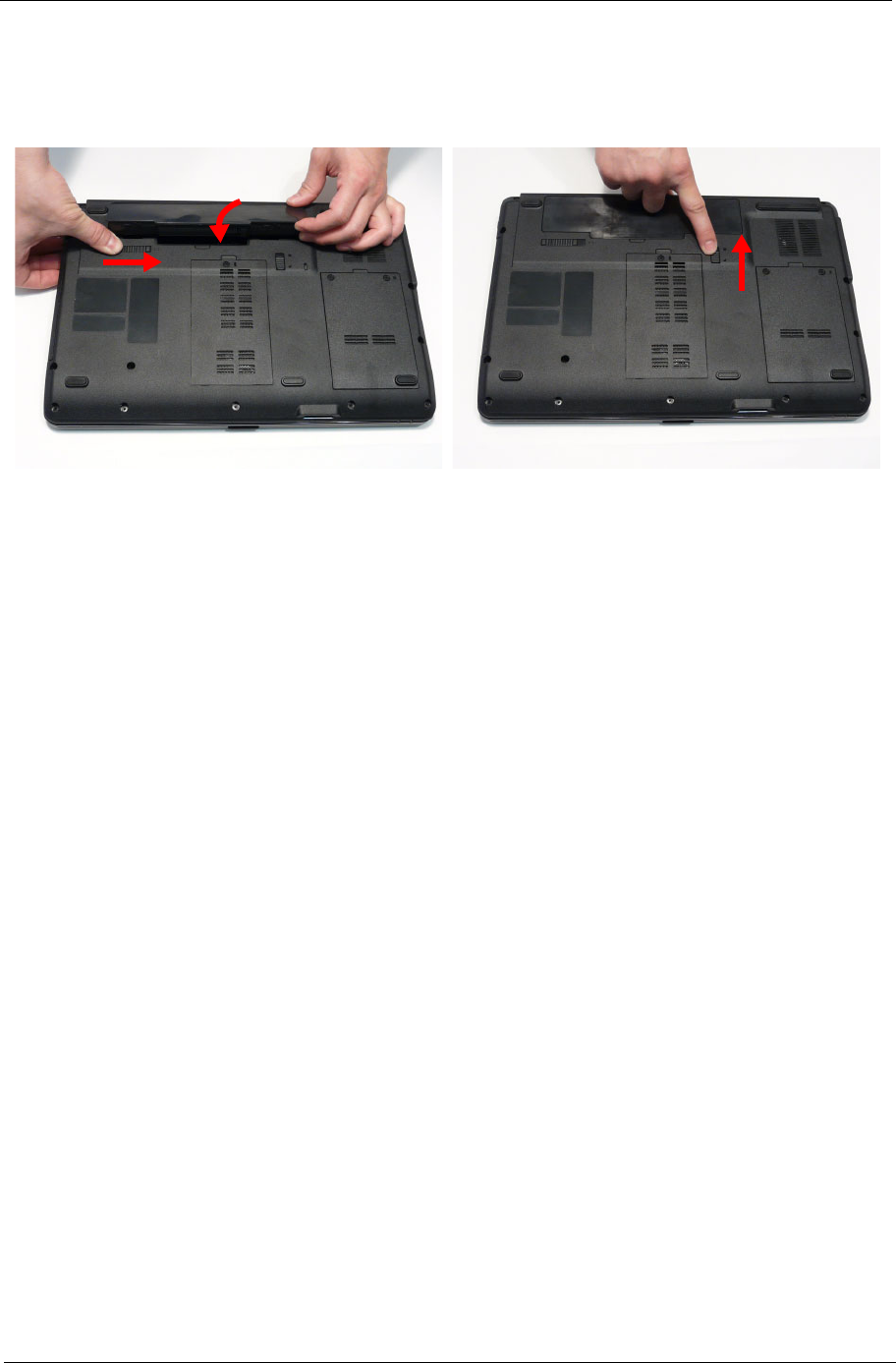
Chapter 3 121
Replacing the Battery
1.
Slide and hold the battery release latch to the
release position (1), insert the battery pack and
press down (2).
2. Slide the battery lock in the direction shown to
secure the battery in place.
1
2

122 Chapter 3
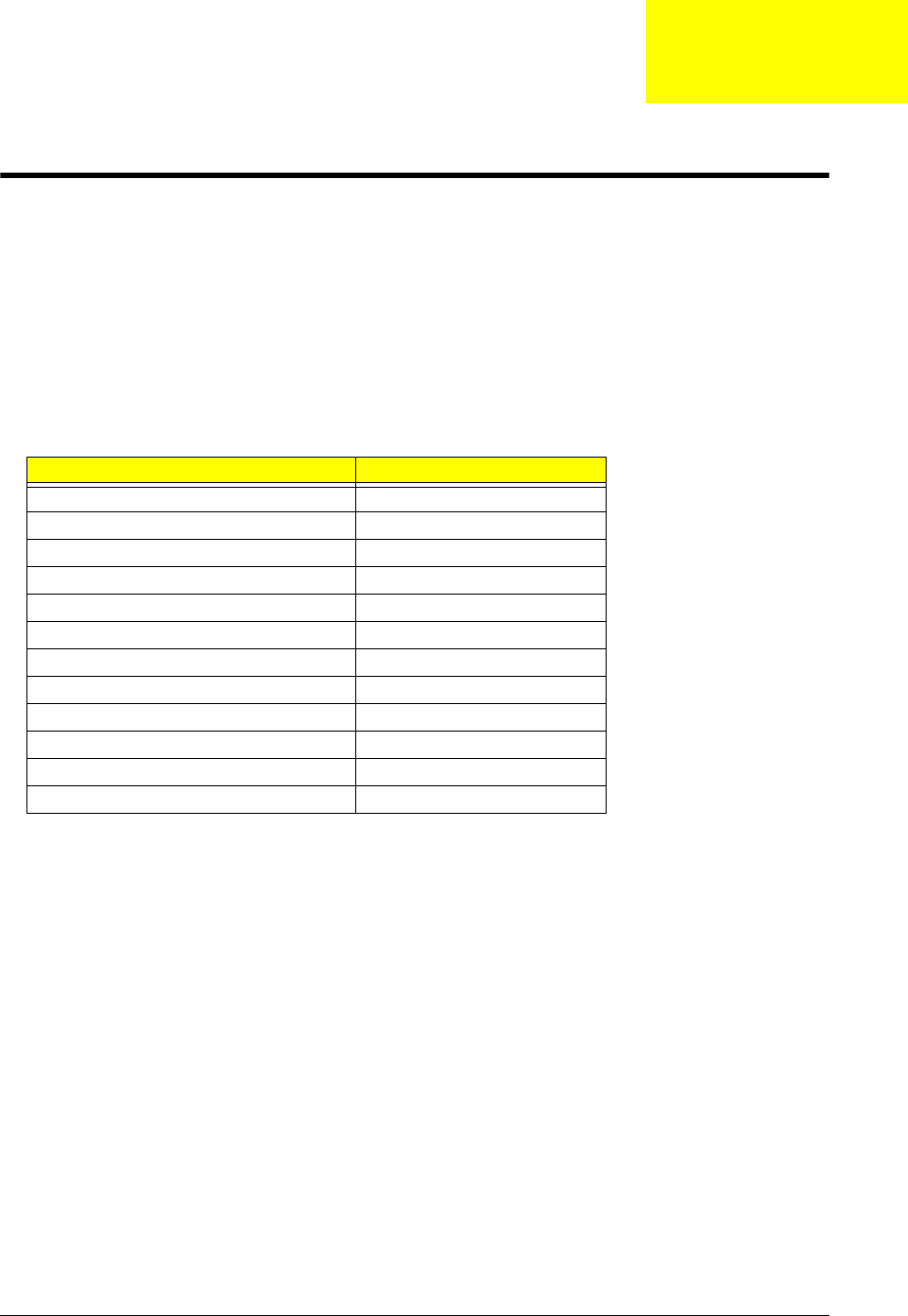
Chapter 4 123
Troubleshooting
Common Problems
Use the following procedure as a guide for computer problems.
NOTE: The diagnostic tests are intended to test only Acer products. Non-Acer products, prototype cards, or
modified options can give false errors and invalid system responses.
1. Obtain the failing symptoms in as much detail as possible.
2. Verify the symptoms by attempting to re-create the failure by running the diagnostic test or by repeating
the same operation.
3. Use the following table with the verified symptom to determine which page to go to.
4. If the Issue is still not resolved, see “Online Support Information” on page 185.
Symptoms (Verified) Go To
Power On Issue Page 124
No Display Issue Page 125
LCD Failure Page 127
Internal Keyboard Failure Page 127
TouchPad Failure Page 128
Internal Speaker Failure Page 128
ODD Failure Page 131
WLAN Failure Page 134
Thermal Unit Failure Page 134
Other Functions Failure Page 135
Intermittent Failures Page 136
Undermined Failures Page 136
Chapter 4
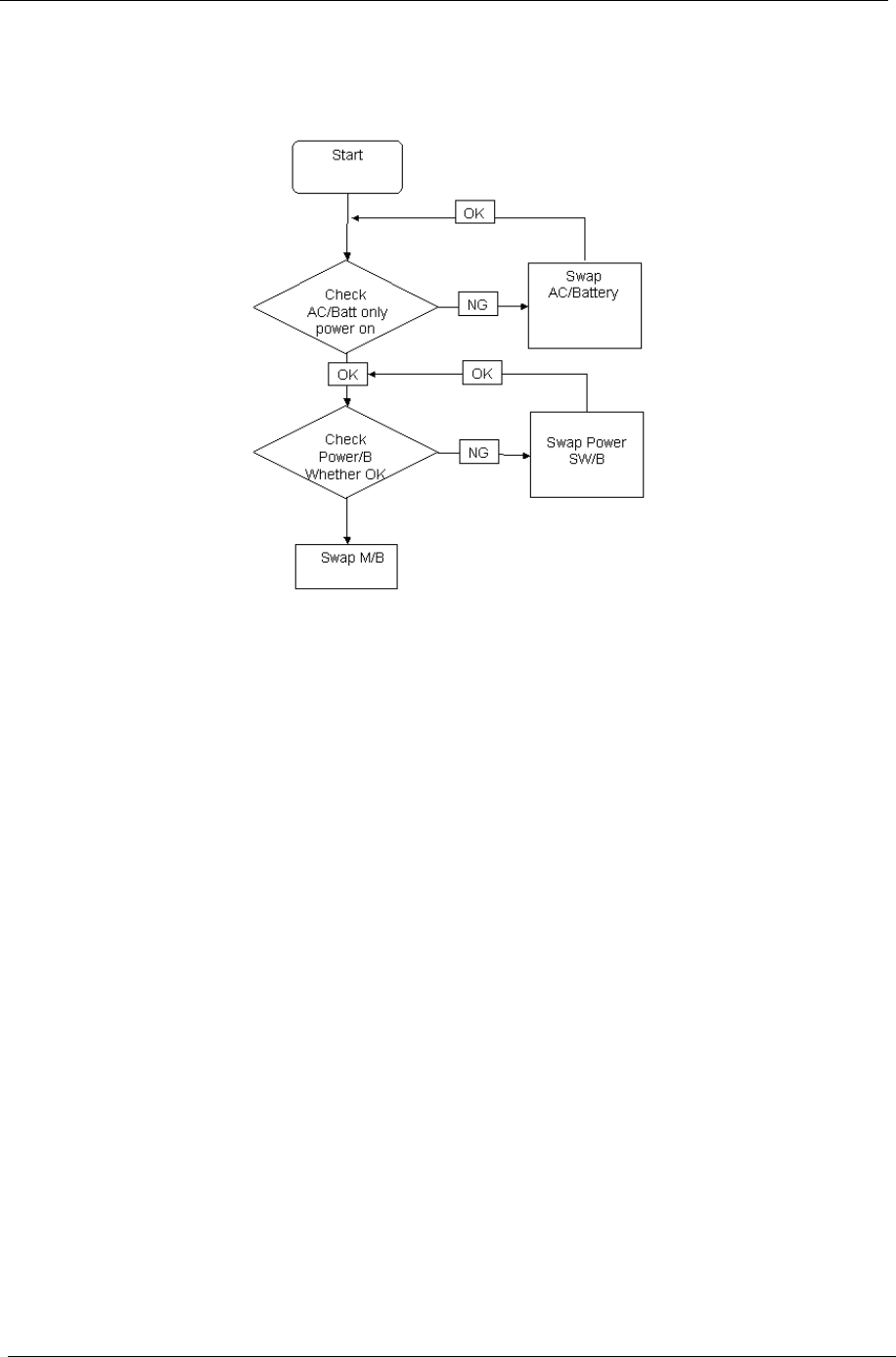
124 Chapter 4
Power On Issue
If the system doesn’t power on, perform the following actions one at a time to correct the problem. Do not
replace a non-defective FRUs:
Computer Shutsdown Intermittently
If the system powers off at intervals, perform the following actions one at a time to correct the problem.
1. Check the power cable is properly connected to the computer and the electrical outlet.
2. Remove any extension cables between the computer and the outlet.
3. Remove any surge protectors between the computer and the electrical outlet. Plug the computer directly
into a known good electrical outlet.
4. Disconnect the power and open the casing to check the Thermal Unit (see “Thermal Unit Failure” on page
134) and fan airways are free of obstructions.
5. Remove all external and non-essential hardware connected to the computer that are not necessary to
boot the computer to the failure point.
6. Remove any recently installed software.
7. If the Issue is still not resolved, see “Online Support Information” on page 185.
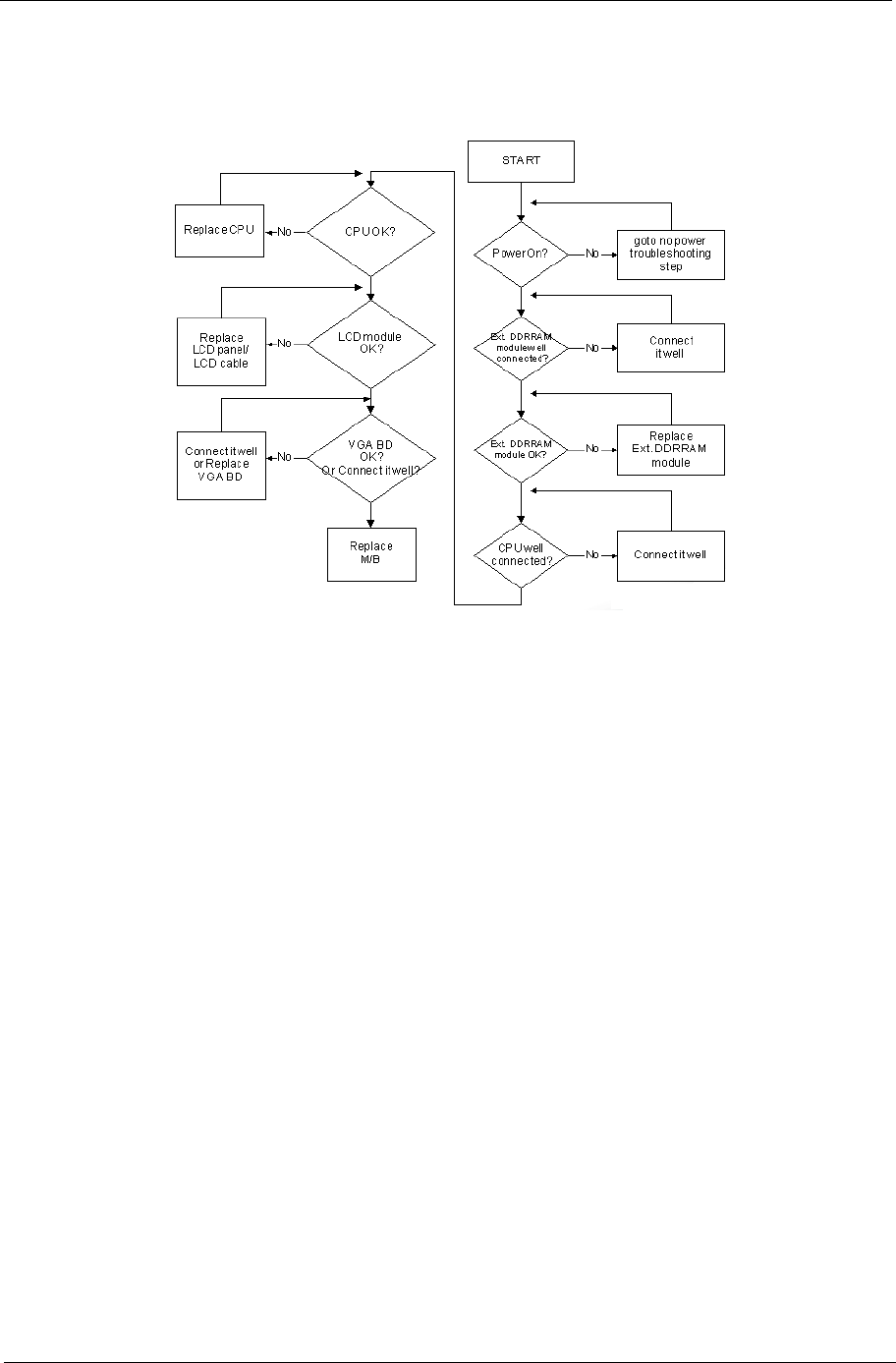
Chapter 4 125
No Display Issue
If the Display doesn’t work, perform the following actions one at a time to correct the problem. Do not replace
a non-defective FRUs:
No POST or Video
If the POST or video doesn’t display, perform the following actions one at a time to correct the problem.
1. Make sure that the internal display is selected. On this notebook model, switching between the internal
display and the external display is done by pressing Fn+F5. Reference Product pages for specific model
procedures.
2. Make sure the computer has power by checking at least one of the following occurs:
• Fans start up
• Status LEDs light up
If there is no power, see “Power On Issue” on page 124.
3. Drain any stored power by removing the power cable and battery and holding down the power button for
10 seconds. Reconnect the power and reboot the computer.
4. Connect an external monitor to the computer and switch between the internal display and the external
display is by pressing Fn+F5 (on this model).
If the POST or video appears on the external display, see “LCD Failure” on page 127.
5. Disconnect power and all external devices including port replicators or docking stations. Remove any
memory cards and CD/DVD discs. Restart the computer.
If the computer boots correctly, add the devices one by one until the failure point is discovered.
6. Reseat the memory modules.
7. Remove the drives (see “Disassembly Process” on page 44).
8. If the Issue is still not resolved, see “Online Support Information” on page 185.

126 Chapter 4
Abnormal Video Display
If video displays abnormally, perform the following actions one at a time to correct the problem.
1. Reboot the computer.
2. If permanent vertical/horizontal lines or dark spots display in the same location, the LCD is faulty and
should be replaced. See “Disassembly Process” on page 44.
3. If extensive pixel damage is present (different colored spots in the same locations on the screen), the LCD
is faulty and should be replaced. See “Disassembly Process” on page 44.
4. Adjust the brightness to its highest level. See the User Manual for instructions on adjusting settings.
NOTE: Ensure that the computer is not running on battery alone as this may reduce display brightness.
If the display is too dim at the highest brightness setting, the LCD is faulty and should be replaced. See
“Disassembly Process” on page 44.
5. Check the display resolution is correctly configured:
a. Minimize or close all Windows.
b. If display size is only abnormal in an application, check the view settings and control/mouse wheel
zoom feature in the application.
c. If desktop display resolution is not normal, right-click on the desktop and select
Personalize´ Display Settings.
d. Click and drag the Resolution slider to the desired resolution.
e. Click Apply and check the display. Readjust if necessary.
6. Roll back the video driver to the previous version if updated.
7. Remove and reinstall the video driver.
8. Check the Device Manager to determine that:
• The device is properly installed. There are no red Xs or yellow exclamation marks.
• There are no device conflicts.
• No hardware is listed under Other Devices.
9. If the Issue is still not resolved, see “Online Support Information” on page 185.
10. Run the Windows Memory Diagnostic from the operating system DVD and follow the onscreen prompts.
11. If the Issue is still not resolved, see “Online Support Information” on page 185.
Random Loss of BIOS Settings
If the computer is experiencing intermittent loss of BIOS information, perform the following actions one at a
time to correct the problem.
1. If the computer is more than one year old, replace the CMOS battery.
2. Run a complete virus scan using up-to-date software to ensure the computer is virus free.
3. If the computer is experiencing HDD or ODD BIOS information loss, disconnect and reconnect the power
and data cables between devices.
If the BIOS settings are still lost, replace the cables.
4. If HDD information is missing from the BIOS, the drive may be defective and should be replaced.
5. Replace the Motherboard.
6. If the Issue is still not resolved, see “Online Support Information” on page 185.
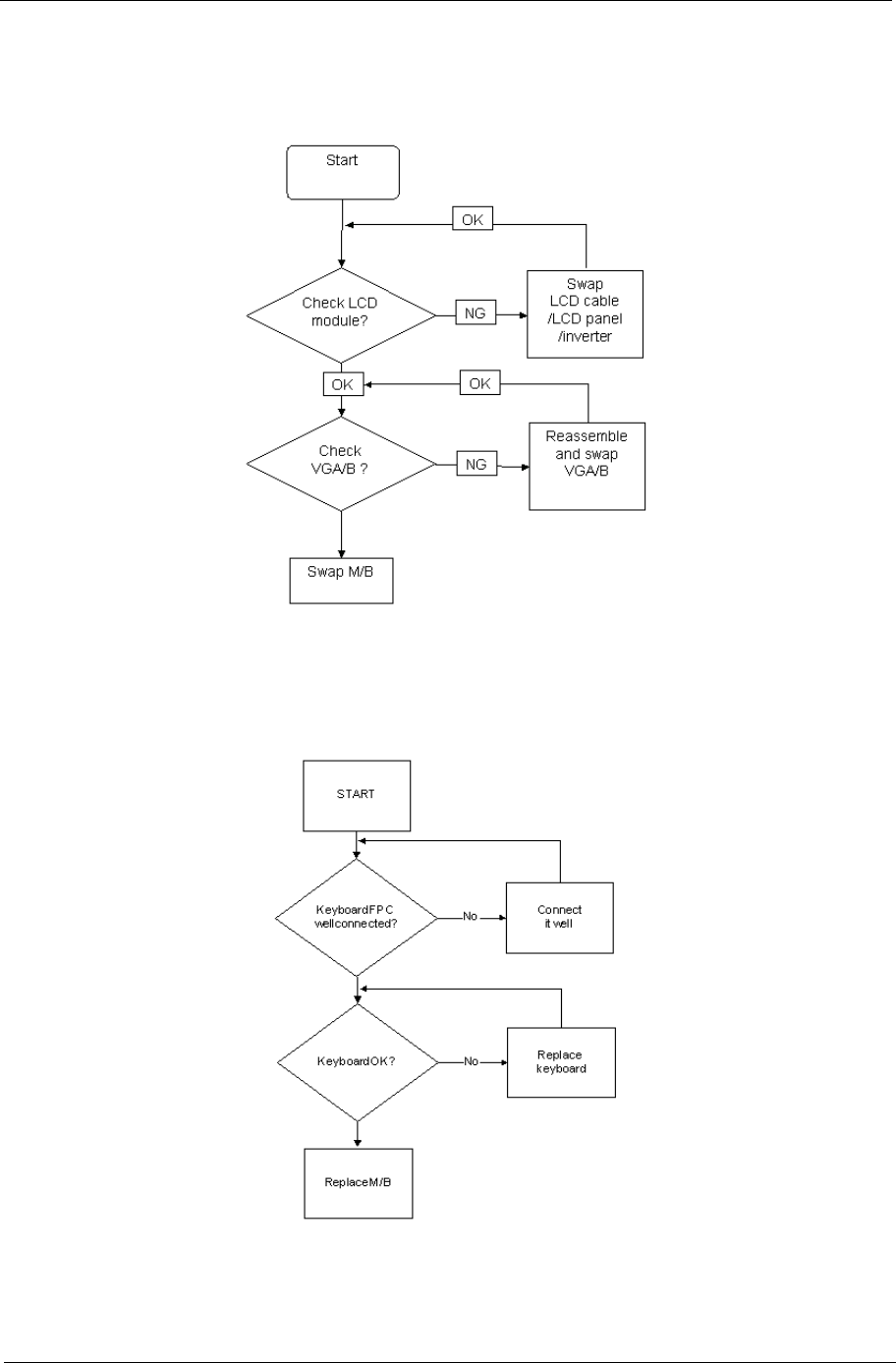
Chapter 4 127
LCD Failure
If the LCD fails, perform the following actions one at a time to correct the problem. Do not replace a non-
defective FRUs:
Built-In Keyboard Failure
If the built-in Keyboard fails, perform the following actions one at a time to correct the problem. Do not replace
a non-defective FRUs:
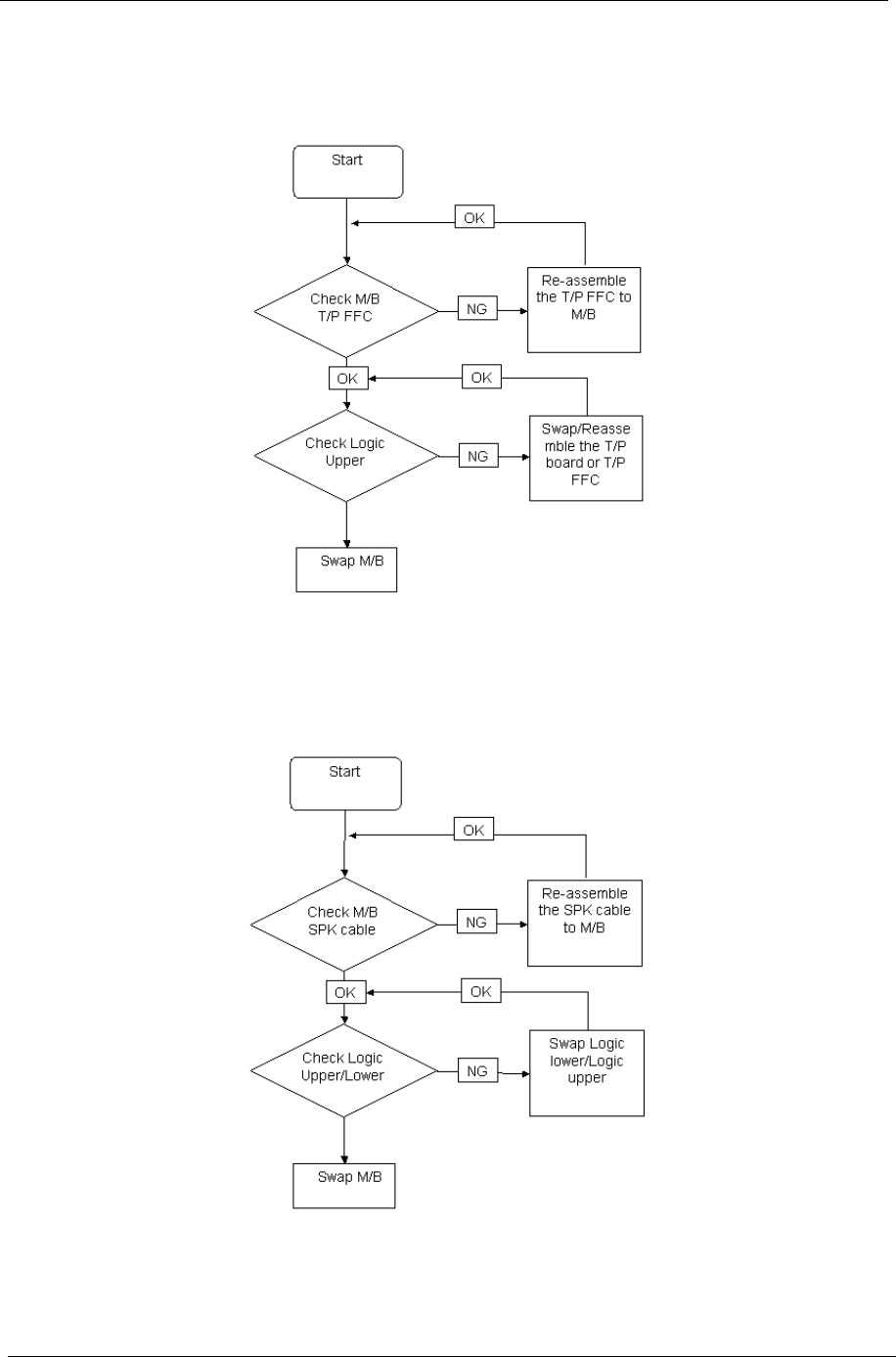
128 Chapter 4
TouchPad Failure
If the TouchPad doesn’t work, perform the following actions one at a time to correct the problem. Do not
replace a non-defective FRUs:
Internal Speaker Failure
If the internal Speakers fail, perform the following actions one at a time to correct the problem. Do not replace
a non-defective FRUs:

Chapter 4 129
Sound Problems
If sound problems are experienced, perform the following actions one at a time to correct the problem.
1. Reboot the computer.
2. Navigate to Start´ Control Panel´ System and Maintenance´ System´ Device Manager. Check
the Device Manager to determine that:
• The device is properly installed.
• There are no red Xs or yellow exclamation marks.
• There are no device conflicts.
• No hardware is listed under Other Devices.
3. Roll back the audio driver to the previous version, if updated recently.
4. Remove and reinstall the audio driver.
5. Ensure that all volume controls are set mid range:
a. Click the volume icon on the taskbar and drag the slider to 50. Ensure that the volume is not muted.
b. Click Mixer to verify that other audio applications are set to 50 and not muted.
6. Navigate to Start´ Control Panel´ Hardware and Sound´ Sound. Ensure that Speakers are selected
as the default audio device (green check mark).
NOTE: If Speakers does not show, right-click on the Playback tab and select Show Disabled Devices
(clear by default).
7. Select Speakers and click Configure to start Speaker Setup. Follow the onscreen prompts to configure
the speakers.
8. Remove and recently installed hardware or software.
9. Restore system and file settings from a known good date using System Restore.
If the issue is not fixed, repeat the preceding steps and select an earlier time and date.
10. Reinstall the Operating System.
11. If the Issue is still not resolved, see “Online Support Information” on page 185.
Microphone Problems
If internal or external Microphones do no operate correctly, perform the following actions one at a time to
correct the problem.
1. Check that the microphone is enabled. Navigate to Start´ Control Panel´ Hardware and Sound´
Sound and select the Recording tab.
2. Right-click on the Recording tab and select Show Disabled Devices (clear by default).
3. The microphone appears on the Recording tab.
4. Right-click on the microphone and select Enable.
5. Select the microphone then click Properties. Select the Levels tab.
6. Increase the volume to the maximum setting and click OK.
7. Test the microphone hardware:
a. Select the microphone and click Configure.
b. Select Set up microphone.
c. Select the microphone type from the list and click Next.
d. Follow the onscreen prompts to complete the test.
8. If the Issue is still not resolved, see “Online Support Information” on page 185.

130 Chapter 4
HDD Not Operating Correctly
If the HDD does not operate correctly, perform the following actions one at a time to correct the problem.
1. Disconnect all external devices.
2. Run a complete virus scan using up-to-date software to ensure the computer is virus free.
3. Run the Windows Vista Startup Repair Utility:
a. insert the Windows Vista Operating System DVD in the ODD and restart the computer.
b. When prompted, press any key to start to the operating system DVD.
c. The Install Windows screen displays. Click Next.
d. Select Repair your computer.
e. The System Recovery Options screen displays. Click Next.
f. Select the appropriate operating system, and click Next.
NOTE: Click Load Drivers if controller drives are required.
g. Select Startup Repair.
h. Startup Repair attempts to locate and resolve issues with the computer.
i. When complete, click Finish.
If an issue is discovered, follow the onscreen information to resolve the problem.
4. Run the Windows Memory Diagnostic Tool. For more information see Windows Help and Support.
5. Restart the computer and press F2 to enter the BIOS Utility. Check the BIOS settings are correct and that
CD/DVD drive is set as the first boot device on the Boot menu.
6. Ensure all cables and jumpers on the HDD and ODD are set correctly.
7. Remove any recently added hardware and associated software.
8. Run the Windows Disk Defragmenter. For more information see Windows Help and Support.
9. Run Windows Check Disk by entering chkdsk /r from a command prompt. For more information see
Windows Help and Support.
10. Restore system and file settings from a known good date using System Restore.
If the issue is not fixed, repeat the preceding steps and select an earlier time and date.
11. Replace the HDD. See “Disassembly Process” on page 44.
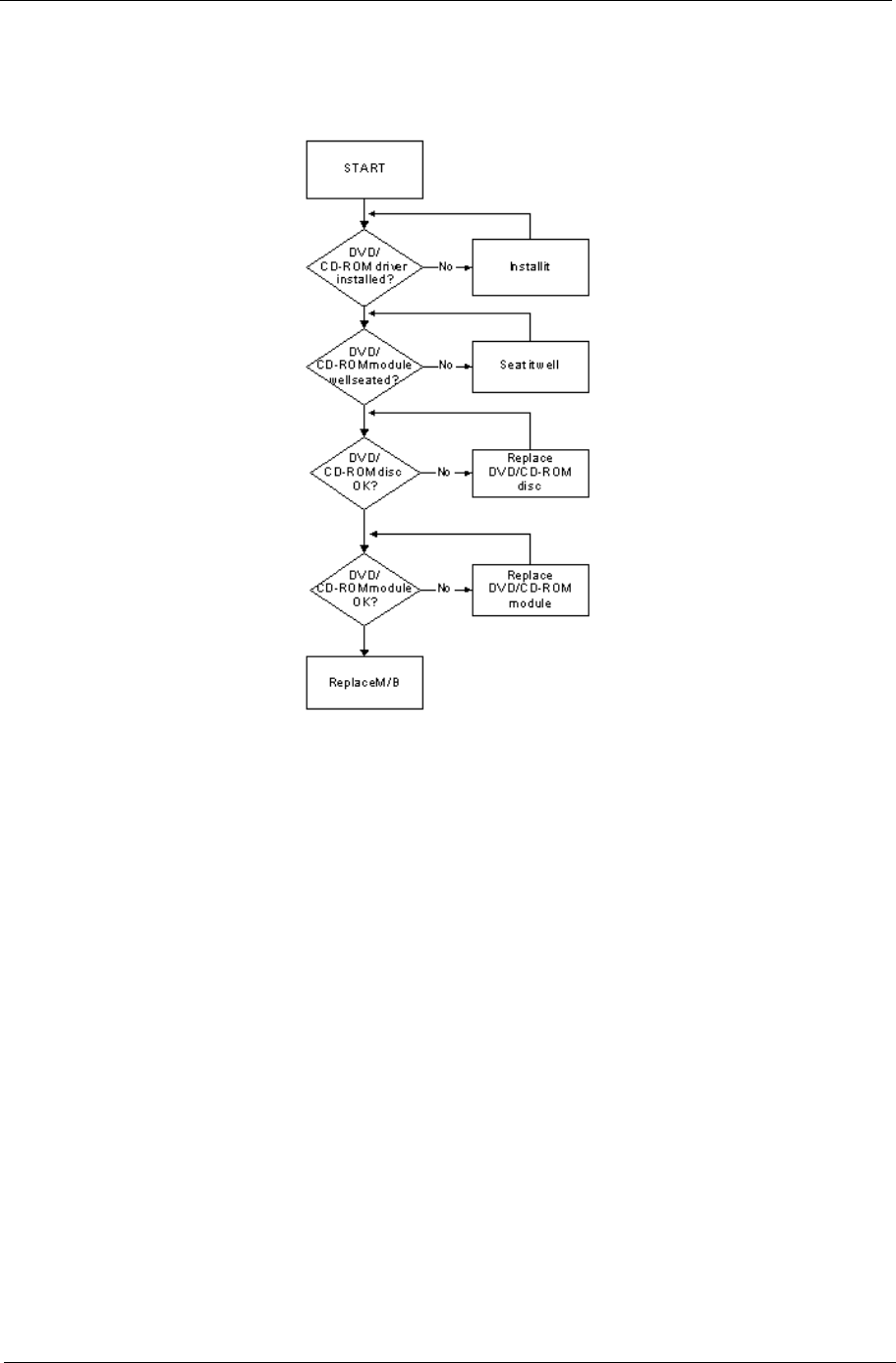
Chapter 4 131
ODD Failure
If the ODD fails, perform the following actions one at a time to correct the problem. Do not replace a non-
defective FRUs:
ODD Not Operating Correctly
If the ODD exhibits any of the following symptoms it may be faulty:
• Audio CDs do not play when loaded
• DVDs do not play when loaded
• Blank discs do not burn correctly
• DVD or CD play breaks up or jumps
• Optical drive not found or not active:
• Not shown in My Computer or the BIOS setup
• LED does not flash when the computer starts up
• The tray does not eject
• Access failure screen displays
• The ODD is noisy
Perform the following general solutions one at a time to correct the problem.
1. Reboot the computer and retry the operation.
2. Try an alternate disc.
3. Navigate to Start´ Computer. Check that the ODD device is displayed in the Devices with Removable
Storage panel.
4. Navigate to Start´ Control Panel´ System and Maintenance´ System´ Device Manager.

132 Chapter 4
a. Double-click lDE ATA/ATAPI controllers. If a device displays a down arrow, right-click on the device
and click Enable.
b. Double-click DVD/CD-ROM drives. If the device displays a down arrow, right-click on the device and
click Enable.
c. Check that there are no yellow exclamation marks against the items in lDE ATA/ATAPI controllers. If
a device has an exclamation mark, right-click on the device and uninstall and reinstall the driver.
d. Check that there are no yellow exclamation marks against the items in DVD/CD-ROM drives. If a
device has an exclamation mark, right-click on the device and uninstall and reinstall the driver.
e. If the exclamation marker is not removed from the item in the lists, try removing any recently installed
software and retrying the operation.
Discs Do Not Play
If discs do not play when inserted in the drive, perform the following actions one at a time to correct the
problem.
1. Check that the disc is correctly seated in the drive tray and that the label on the disc is visible.
2. Check that the media is clean and scratch free.
3. Try an alternate disc in the drive.
4. Ensure that AutoPlay is enabled:
a. Navigate to Start´ Control Panel´ Hardware and Sound´ AutoPlay.
b. Select Use AutoPlay for all media and devices.
c. In the Audio CD and DVD Movie fields, select the desired player from the drop down menu.
5. Check that the Regional Code is correct for the selected media:
IMPORTANT:Region can only be changed a limited number of times. After Changes remaining reaches zero,
the region cannot be changed even Windows is reinstalled or the drive is moved to another computer.
a. Navigate to Start´ Control Panel´ System and Maintenance´ System´ Device Manager.
b. Double-click DVD/CD-ROM drives.
c. Right-click DVD drive and click Properties, then click the DVD Region tab.
d. Select the region suitable for the media inserted in the drive.
Discs Do Not Burn Properly
If discs can not be burned, perform the following actions one at a time to correct the problem.
1. Ensure that the default drive is record enabled:
a. Navigate to Start´ Computer and right-click the writable ODD icon. Click Properties.
b. Select the Recording tab. In the Desktop disc recording panel, select the writable ODD from the
drop down list.
c. Click OK.
2. Ensure that the software used for burning discs is the factory default. If using different software, refer to
the software's user manual.
Playback is Choppy
If playback is choppy or jumps, perform the following actions one at a time to correct the problem.
1. Check that system resources are not running low:
a. Try closing some applications.
b. Reboot and try the operation again.
2. Check that the ODD controller transfer mode is set to DMA:
a. Navigate to Start´ Control Panel´ System and Maintenance´ System´ Device Manager.

Chapter 4 133
b. Double-click IDE ATA/ATAPI controllers, then right-click ATA Device 0.
c. Click Properties and select the Advanced Settings tab. Ensure that the Enable DMA box is
checked and click OK.
d. Repeat for the other ATA Devices shown if applicable.
Drive Not Detected
If Windows cannot detect the drive, perform the following actions one at a time to correct the problem.
1. Restart the computer and press F2 to enter the BIOS Utility.
2. Check that the drive is detected in the ATAPI Model Name field on the Information page.
NOTE: Check that the entry is identical to one of the ODDs specified in “Hardware Specifications and
Configurations” on page 13.
3. Turn off the power and remove the cover to inspect the connections to the ODD. See “Disassembly
Process” on page 44.
a. Check for broken connectors on the drive, motherboard, and cables.
b. Check for bent or broken pins on the drive, motherboard, and cable connections.
c. Try an alternate cable, if available. If the drive works with the new cable, the original cable should be
replaced.
4. Reseat the drive ensuring and all cables are connected correctly.
5. Replace the ODD. See “Disassembly Process” on page 44.
Drive Read Failure
If discs cannot be read when inserted in the drive, perform the following actions one at a time to correct the
problem.
1. Remove and clean the failed disc.
2. Retry reading the CD or DVD.
d. Test the drive using other discs.
e. Play a DVD movie
f. Listen to a music CD
If the ODD works properly with alternate discs, the original disc is probably defective and should be
replaced.
3. Turn off the power and remove the cover to inspect the connections to the ODD. See “Disassembly
Process” on page 44.
a. Check for broken connectors on the drive, motherboard, and cables.
b. Check for bent or broken pins on the drive, motherboard, and cable connections.
c. Try an alternate cable, if available. If the drive works with the new cable, the original cable should be
replaced.
4. Replace the ODD. See “Disassembly Process” on page 44.
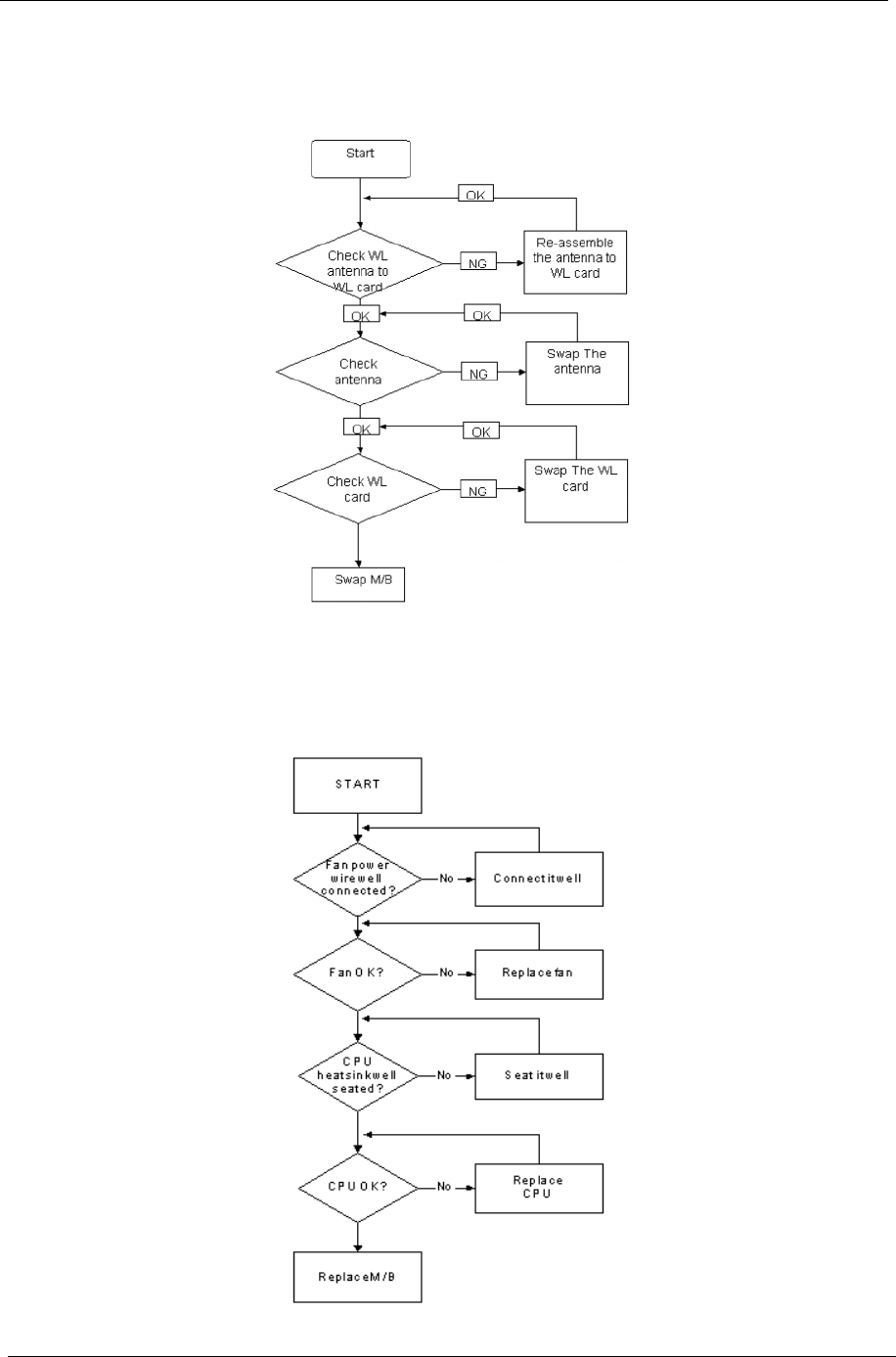
134 Chapter 4
Wireless Function Failure
If the WLAN fails, perform the following actions one at a time to correct the problem. Do not replace a non-
defective FRUs:
Thermal Unit Failure
If the Thermal Unit fails, perform the following actions one at a time to correct the problem. Do not replace a
non-defective FRUs:

Chapter 4 135
External Mouse Failure
If an external Mouse fails, perform the following actions one at a time to correct the problem.
1. Try an alternative mouse.
2. If the mouse uses a wireless connection, insert new batteries and confirm there is a good connection. See
the mouse user manual.
3. If the mouse uses a USB connection, try an alternate USB port.
4. Try an alternative program to verify mouse operation. Reinstall the program experiencing mouse failure.
5. Restart the computer.
6. Remove any recently added hardware and associated software.
7. Remove any recently added software and reboot.
8. Restore system and file settings from a known good date using System Restore.
If the issue is not fixed, repeat the preceding steps and select an earlier time and date.
9. Run the Event Viewer to check the events log for errors. For more information see Windows Help and
Support.
10. Roll back the mouse driver to the previous version if updated recently.
11. Remove and reinstall the mouse driver.
12. Check the Device Manager to determine that:
• The device is properly installed. There are no red Xs or yellow exclamation marks.
• There are no device conflicts.
• No hardware is listed under Other Devices.
13. If the Issue is still not resolved, see “Online Support Information” on page 185.
Other Failures
If the CRT Switch, Dock, LAN Port, external MIC or Speakers, PCI Express Card, 5-in-1 Card Reader or
Volume Wheel fail, perform the following general steps to correct the problem. Do not replace a non-defective
FRUs:
1. Check Drive whether is OK.
2. Check Test Fixture is ok.
3. Swap M/B to Try.

136 Chapter 4
Intermittent Problems
Intermittent system hang problems can be caused by a variety of reasons that have nothing to do with a
hardware defect, such as: cosmic radiation, electrostatic discharge, or software errors. FRU replacement
should be considered only when a recurring problem exists.
When analyzing an intermittent problem, do the following:
1. Run the advanced diagnostic test for the system board in loop mode at least 10 times.
2. If no error is detected, do not replace any FRU.
3. If any error is detected, replace the FRU. Rerun the test to verify that there are no more errors.
Undetermined Problems
The diagnostic problems does not identify which adapter or device failed, which installed devices are incorrect,
whether a short circuit is suspected, or whether the system is inoperative.
Follow these procedures to isolate the failing FRU (do not isolate non-defective FRU).
NOTE: Verify that all attached devices are supported by the computer.
NOTE: Verify that the power supply being used at the time of the failure is operating correctly. (See “Power On
Issue” on page 124.):
1. Power-off the computer.
2. Visually check them for damage. If any problems are found, replace the FRU.
3. Remove or disconnect all of the following devices:
• Non-Acer devices
• Printer, mouse, and other external devices
•Battery pack
• Hard disk drive
•DIMM
• CD-ROM/Diskette drive Module
• PC Cards
4. Power-on the computer.
5. Determine if the problem has changed.
6. If the problem does not recur, reconnect the removed devices one at a time until you find the failing FRU.
7. If the problem remains, replace the following FRU one at a time. Do not replace a non-defective FRU:
• System board
• LCD assembly

Chapter 4 137
Post Codes
These tables describe the POST codes and descriptions during the POST.
Sec:
NO_EVICTION_MODE_DEBUG EQU 1 (CommonPlatform\sec\Ia32\SecCore.inc)
Memory:
DEBUG_BIOS equ 1 (Chipset\Alviso\MemoryInitAsm\IA32\IMEMORY.INC)
Code Description
0xC2 MTRR setup
0xC3 Enable cache
0xC4 Establish cache tags
0xC5 Enter NEM, Place the BSP in No Fill mode, set CR0.CD = 1, CR0.NW = 0.
0xCF Cache Init Finished
Code Description
0xA0 First memory check point
0x01 Enable MCHBAR
0x02 Check for DRAM initialization interrupt and reset fail
0x03 Verify all DIMMs are DDR or DDR2 and unbuffered
0x04 Detect an improper warm reset and handle
0x05 Detect if ECC SO-DIMMs are present in the system
0x06 Verify all DIMMs are single or double sided and not asymmetric
0x07 Verify all DIMMs are x8 or x16 width
0x08 Find a common CAS latency between the DIMMS and the MCH
0x09 Determine the memory frequency and CAS latency to program
0x10 Determine the smallest common TRAS for all DIMMs
0x11 Determine the smallest common TRP for all DIMMs
0x12 Determine the smallest common TRCD for all DIMMs
0x13 Determine the smallest refresh period for all DIMMs
0x14 Verify burst length of 8 is supported by all DIMMs
0x15 Determine the smallest tWR supported by all DIMMs
0x16 Determine DIMM size parameters
0x17 Program the correct system memory frequency
0x18 Determine and set the mode of operation for the memory channels
0x19 Program clock crossing registers
0x20 Disable Fast Dispatch
0x21 Program the DRAM Row Attributes and DRAM Row Boundary registers
0x22 Program the DRAM Bank Architecture register
0x23 Program the DRAM Timing & and DRAM Control registers
0x24 Program ODT
0x25 Perform steps required before memory init
0x26 Program the receive enable reference timing control register
Program the DLL Timing Control Registers, RCOMP settings

138 Chapter 4
BDS & Specific action:
0x27 Enable DRAM Channel I/O Buffers
0x28 Enable all clocks on populated rows
0x29 Perform JEDEC memory initialization for all memory rows
0x30 Perform steps required after memory init
0x31 Program DRAM throttling and throttling event registers
0x32 Setup DRAM control register for normal operation and enable
0x33 Enable RCOMP
0x34 Clear DRAM initialization bit in the SB
0x35 Initialization Sequence Completed, program graphic clocks
0xAF Disable access to the XMM registers
Code Description
0x00 Report the legacy boot is happening
0x12 Wake up the Aps
0x13 Initialize SMM Private Data and relocate BSP SMBASE
0x21 PC init begin at the stage1
0x27 Report every memory range do the hardware ECC init
0x28 Report status code of every memory range
0x50 Get the root bridge handle
0x51 Notify pci bus driver starts to program the resource
0x58 Reset the host controller
0x5A IdeBus begin initialization
0x70 Simple Text Output Protocol Functions(VGA class reset)
0x71 Report that VGA Class driver is being disabled
0x72 Report that VGA Class driver is being enabled
0x78 Terminal Console In reset and Console Out reset
0x79 Report that the remote terminal is being disabled
0x7A Report that the remote terminal is being enabled
0x90 Keyboard reset
0x91 USB Keyboard disable
0x92 Keyboard detection
0x93 Report that the usb keyboard is being enabled
0x94 Clear the keyboard buffer
0x95 Init Keyboard
0x98 Mouse reset
0x99 Mouse disable
0x9A Detect PS2 mouse
0x9B Report that the mouse is being enabled
0xB8 Peripheral removable media reset (ex: IsaFloppy, USB device)
0xB9 Peripheral removable media disable
0xBB Peripheral removable media enable
0xE4 Report Status Code here for DXE_ENTRY_POINT once it is available
Code Description

Chapter 4 139
0xF8 Report that ExitBootServices () has been called
0xF9 Runtime driver set virtual address map
Code Description

140 Chapter 4
Each PEIM entry point used in 80_PORT
Each Driver entry point used in 80_PORT
Code Description
0x00
0x01 PEI_EVENT_LOG
0x02 PEI_OEM_SERVICE
0x03 PEI_SIO_INIT
0x04 PEI_MONO_STATUS_CODE
0x05 PEI_CPU_IO_PCI_CFG
0x06 PEI_CPU_IO
0x07 PEI_PCI_CFG
0x08 PEI_CPU_PEIM
0x09 PEI_PLATFORM_STAGE1
0x0A PEI_VARIABLE
0x0B PEI_SB_INIT
0x0C PEI_CAPSULE
0x0D PEI_PLATFORM_STAGE2
0x0E PEI_SB_SMBUS_ARP_DISABLED
0x0F PEI_HOST_TO_SYSTEM
0x10 PEI_MEMORY_INIT
0x11 PEI_S3_RESUME
0x12 PEI_CLOCK_GEN
0x13 PEI_OP_PRESENCE
0x14 PEI_TPM_TCG
0x15 PEI_FIND_FV
0x16 PEI_H2O_DEBUG_IO
0x17 PEI_H2O_DEBUG_COMM
0x18 PEI_SMM_CONTROL
0x19~0x1F PEI_RESERVED
0x20~0x2E PEI_OEM_DEFINED
0x2F PEI_DXE_IPL
Code Description
0x30 RESERVED
0x31 DXE_CRC32_SECTION_EXTRACT
0x32 SCRIPT_SAVE
0x33 ACPI_S3_SAVE
0x34 SMART_TIMER
0x35 JPEG_DECODER
0x36 PCX_DECODER
0x37 HT_CPU / MP_CPU
0x38 LEGACY_METRONOME
0x39 FTWLITE
0x3A RUN_RIME

Chapter 4 141
0x3B MONOTONIC_COUNTER
0x3C WATCH_DOG_TIMER
0x3D SECURITY_STUB
0x3E DXE_CPU_IO
0x3F CF9_RESET
0x40 PC_RTC
0x41 STATUS_CODE
0x42 VARIABLE
0x43 EMU_VARIABLE
0x44 DXE_CHIPSET_INIT
0x45 DXE_ALERT_FORMAT
0x46 PCI_HOST_BRIDGE
0x47 PCI_EXPRESS
0x48 DXE_SB_INIT
0x49 IDE_CONTROLLER
0x4A SATA_CONTROLLER
0x4B SB_SM_BUS
0x4C ISA_ACPI_DRIVER
0x4D ISA_BUS
0x4E ISA_SERIAL
0x4F IDE_BUS
0x50 PCI_BUS
0x51 BOOT_PRIORITY
0x52 FVB_SERVICE
0x53 ACPI_PLATFORM
0x54 PCI_HOT_PLUG
0x55 DXE_PLATFORM
0x56 PLATFORM_IDE
0x57 SMBIOS
0x58 MEMORY_SUB_CLASS
0x59 MISC_SUB_CLASS
0x5A CON_PLATFORM
0x5B SAVE_MEMORY_CONFIG
0x5C ACPI_SUPPORT
0x5D CON_SPLITTER_UGA_VGA / CON_SPLITTER
0x5E VGA_CLASS
0x5F DATA_HUB
0x60 DISK_IO
0x61 MEMORY_TEST
0x62 CRISIS_RECOVERY
0x63 LEGACY_8259
0x64 LEGACY_REGION
0x65 LEGACY_INTERRUPT
Code Description

142 Chapter 4
0x66 BIOS_KEYBOARD
0x67 BIOS_VEDIO
0x68 MONITER_KEY
0x69 LEGACY_BIOS
0x6A LEGACY_BIOS_PLATFORM
0x6B PCI_PLATFORM
0x6C ISA_FLOOPY
0x6D PS2_MOUSE
0x6E USB_BOT
0x6F USB_CBI0
0x70 USB_CBI1
0x71 USB_KB
0x72 USB_MASS_STORAGE
0x73 BUS_PCI_UHCI
0x74 USB_MOUSE
0x75 USB_BUS
0x76 SETUP_UTILITY
0x77 FW_BLOCK_SERVICE
0x78 USB_LEGACY_PLATFORM
0x79 GRAPHICS_CONSOLE
0x7A TERMINAL
0x7B DATA_HUB_STD_ERR
0x7C FAT
0x7D PARTITION
0x7E ENGLISH
0x7F FRENCH
0x80 HII_DATABASE
0x81 SETUP_BROWSER
0x82 OEM_SETUP_BROWSER
0x83 OEM_BADGING_SUPPORT
0x84 LEGACY_MOUSE
0x85 BIOS_SNP16
0x86 BUS_PCI_UNDI
0x87 SETUP_MOUSE
0x88 OEM_SETTING
0x89 MONITOR_KEY
0x8A PLATFORM_BDS
0x8B FAULT_TOLERANT_WRITE
0x8C UPDATE_DISPATCHER
0x8D CHINESE
0x8E TPM_S3_Resume
0x8F USB_EHCI
0x90 SNP_32_64
Code Description

Chapter 4 143
0x91 DXE_0x91 PXE_BC
0x92 PXE_DHCP4
0x93 EBC
0x94~0x9F RESERVED
0xA0 DXE_H2O_DEBUG_IO
0xA1 DXE_H2O_DEBUG_IO
0xA2 DXE_TPM_TCG
0xA3 DXE_TPM_PHYSICAL_PRESENCE
0xA4 DXE_OEM_SERVICE
0xA5 DXE_EVENT_LOG
0xA6 DXE_ SECURITY_HDD_PASSWORD_SERVICE
0xA7 DXE_LAN_ASF_INIT
0xA8 DXE_BUS_PCI_SERIAL
0xA9 DXE_LAN_IDER_CONTROLLER
0xAA DXE_LAN_AMT
0xAB DXE_ SECURITY_SYSTEM_PASSWORD_SERVICE
0xAC DXE_ SECURITY_ PASSWORD_CONSOLE
0xAD DXE_ DATA_HUB_RECORD_POLICY
0xAE DXE_TPM_DRIVER
0xAF RESERVED
0xB0 JAPANESE
0xB1 DXE_UNICODE_COLLACTION
Code Description

144 Chapter 4
Each SmmDriver entry point used in 80_PORT
* If the BIOS detects error 2C, 2E, or 30 (base 512K RAM error), it displays an additional word-bitmap (xxxx)
indicating the address line or bits that failed. For example, 2C 0002 means address line 1 (bit one set) has
failed. 2E 1020 means data bits 12 and 5 (bits 12 and 5 set) have failed in the lower 16 bits. Note that error 30
cannot occur on 386SX systems because they have a 16 rather than 32-bit bus. The BIOS also sends the
bitmap to the port-80 LED display. It first displays the check point code, followed by a delay, the high-order
byte, another delay, and then the low-order byte of the error. It repeats this sequence continuously.
Code Description
0xC0 SMM_ACCESS
0xC2 SMM_CONTROL
0xC1 SMM_BASE
0xC3 SMMAP
0xC4 SMMCORE
0xC5 SMM_DISPATCH
0xC6 SMM_START
0xC7 SMM_RUNTIME
0xC8 SB_SMM_DISPATCH
0xC9 SMM_THUNK
0xCA SMM_ACPI_SW_CHILD
0xCB SMM_SB_S3_SAVE
0xCC SMM_PLATFORM
0xCD SMM_GMCH_MBI
0xCE SMM_FW_BLOCK_SERVICE
0xCF SMM_VARIABLE
0xD0 SMM_IHISI
0xD1 SMM_INT15_MICROCODE
0xD2 SMM_PNP
0xD3 SMM_USB_LEGACY
0xD4 SMM_INT13_HDD
0xD5 SMM_INIT_PPM
0xD6 SMM_OHCI1394
0xD7 SMM_ SECURITY_HDD_PASSWORD_SERVICE
0xD8 SMM_OEM_SERVICE
0xD9 SMM_PPM
0xDA SMM_DIGITAL_THERMAL_SENSOR
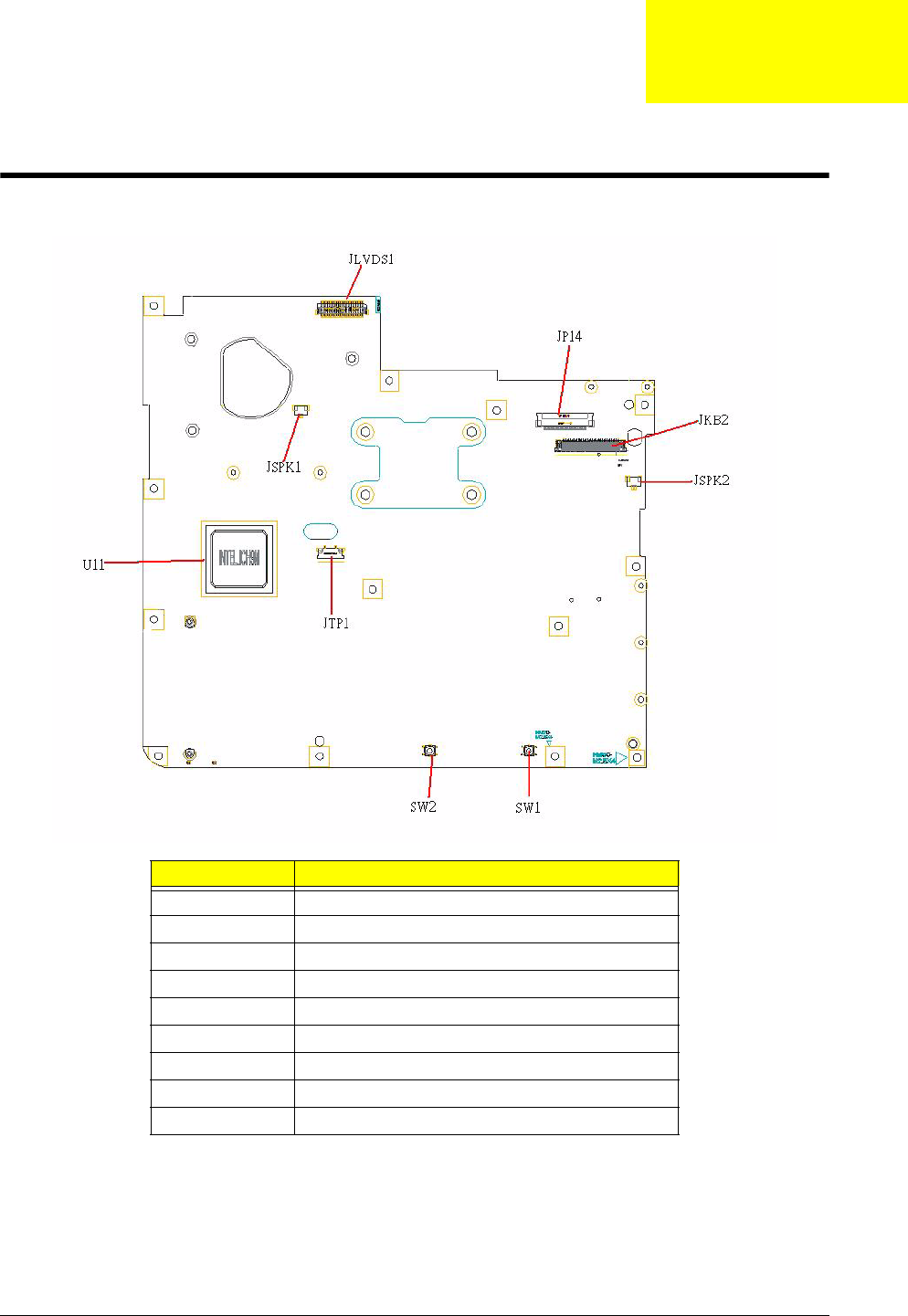
Chapter 5 145
Jumper and Connector Locations
Top View
Item Description
JLVDS1 LCD Connector
JP14 Power/B Connector
JSPK1 Speaker(Left) Connector
JSPK2 Speaker(Right) Connector
JKB2 Internal Keyboard Connector
JTP1 Touch Pad Connector
U11 South Bridge
SW4 Touch pad (Left) Button
SW3 Touch pad (Right) Button
Chapter 5
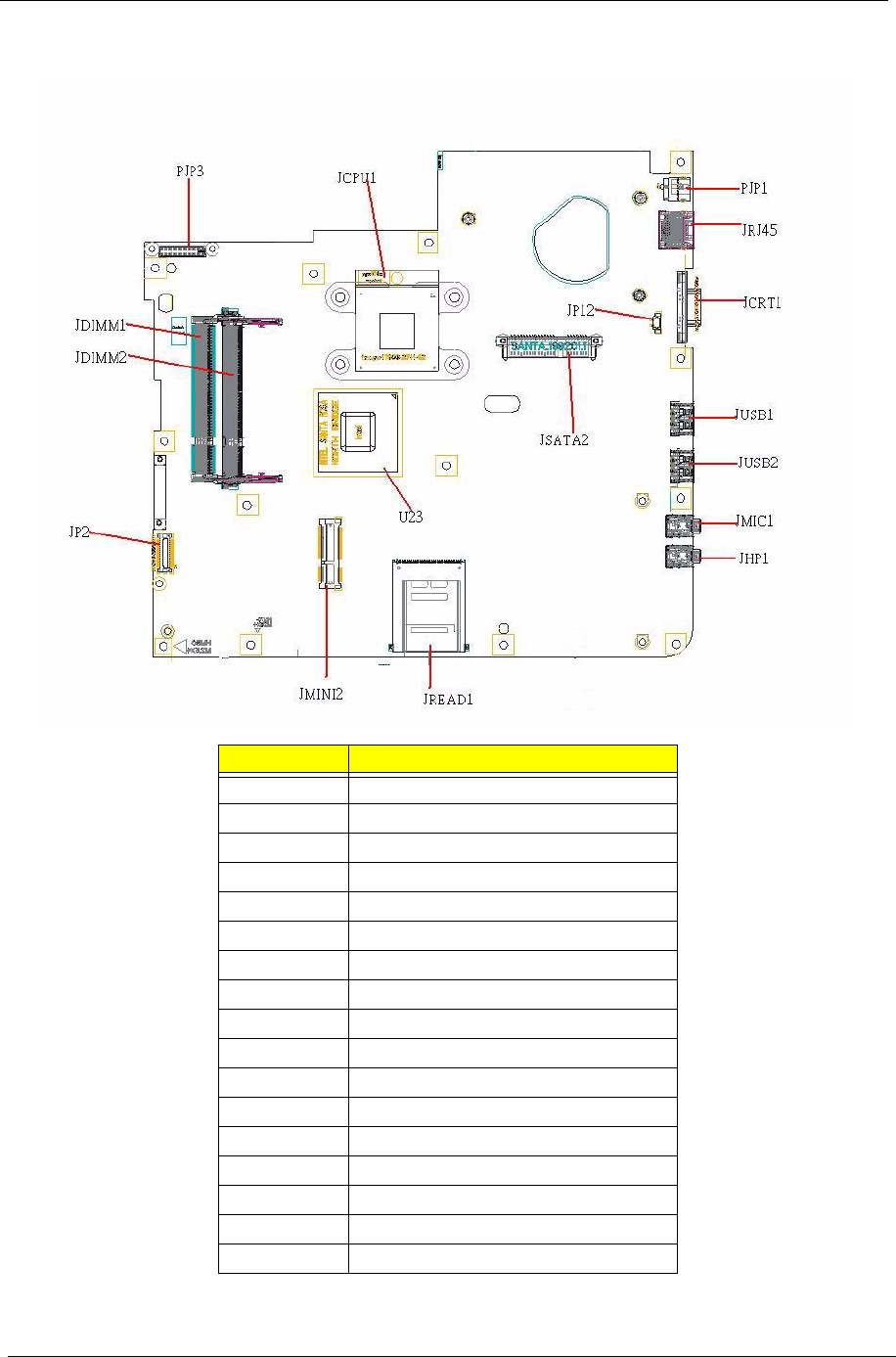
146 Chapter 5
Bottom View
ITEM DESCRIPTION
PJP1 AC-IN Connector
JRJ45 RJ45 Connector
JCRT1 CRT Connector
JP12 Fan Connector
JUSB1 USB Connector
JUSB2 USB Connector
JMIC1 MIC-In Jack
JHP1 Head-Phone Jack
JSATA2 HDD Connector
U23 North Bridge
JCPU1 CPU Socket
JREAD1 Card Reader Socket
PJP3 Battery Board Connector
JDIMM2 Memory DIMM2 Connector
JDIMM1 Memory DIMM1 Connector
PJP2 ODD Board Connector
JMINI2 Wireless Card Connector
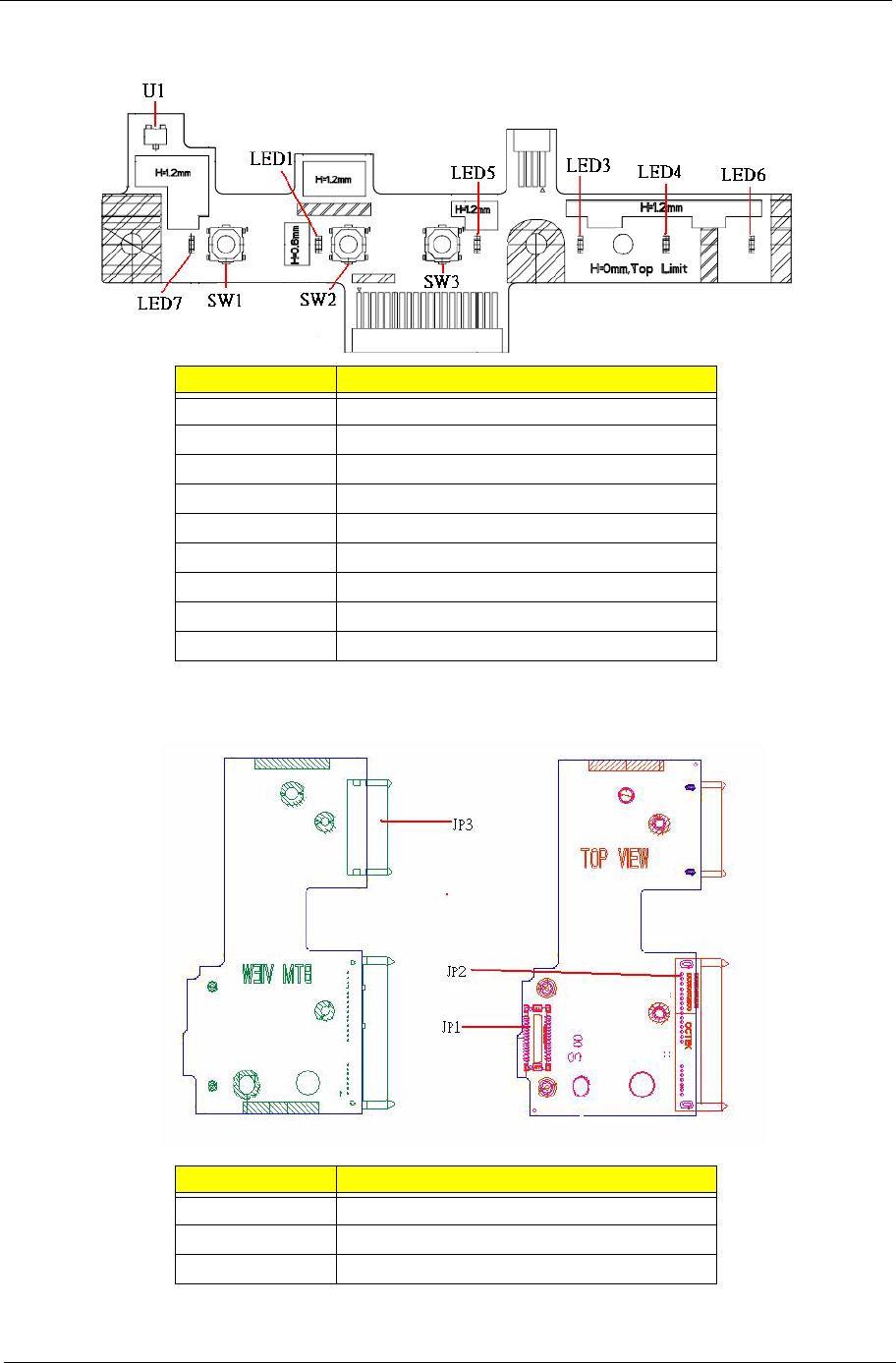
Chapter 5 147
Power Board
LS-4852P ODD Board
ITEM DESCRIPTION
SW1 TP Lock Button
SW2 ON/OFF Button
SW3 Wireless Button
LED1 ON/OFF LED
LED3 Media LED
LED4 Num LED
LED5 Wireless LED
LED6 Caps LED
LED7 TP Lock LED
ITEM DESCRIPTION
JP1 M/B Connector
JP2 HDD Connector
JP3 ODD Board Connector
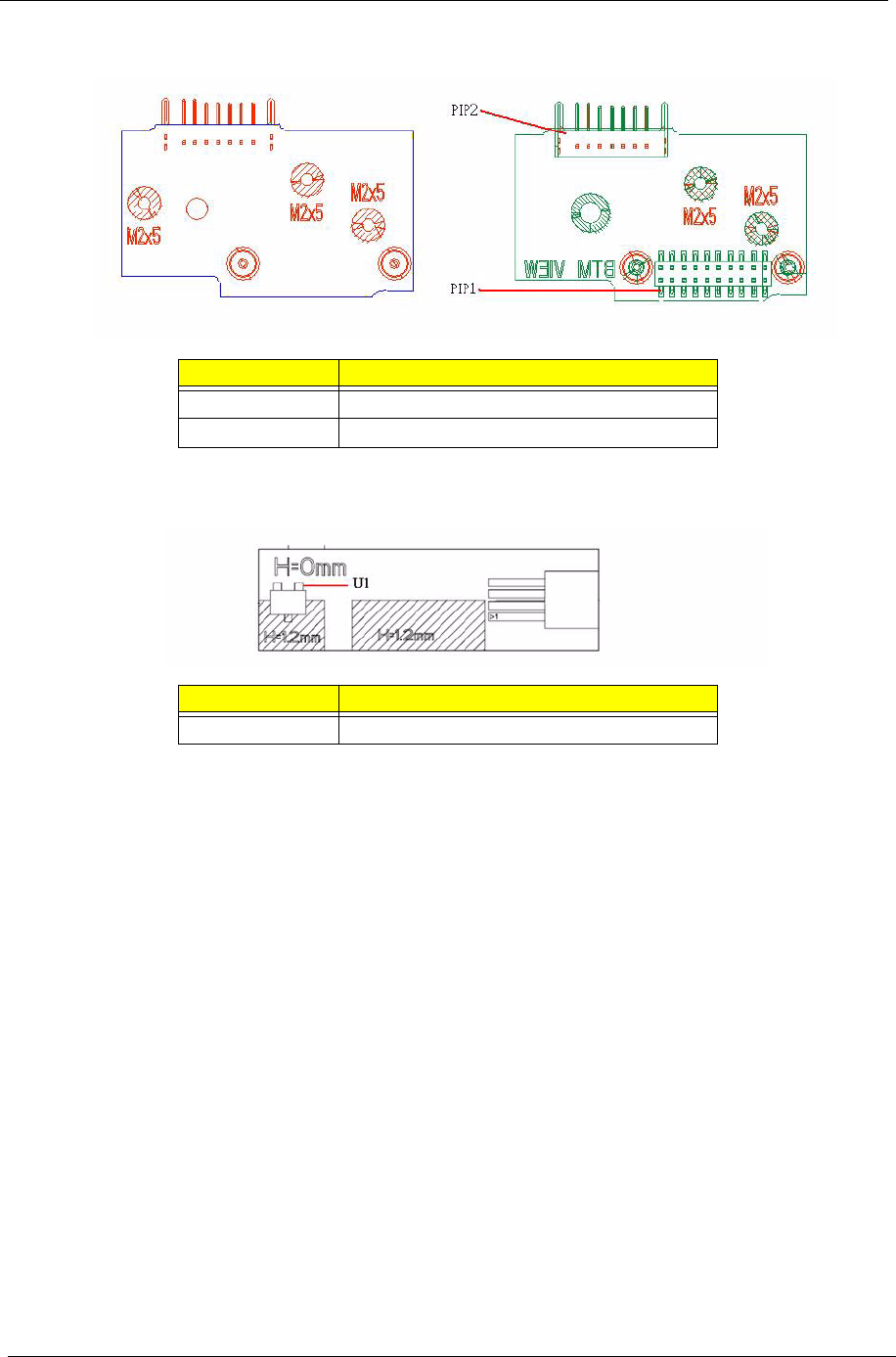
148 Chapter 5
LS-4853P Battery Board
LS-4854P Lid Board
ITEM DESCRIPTION
PIP1 M/B Connector
PIP2 Battery Connector
ITEM DESCRIPTION
U1 Lid Switch
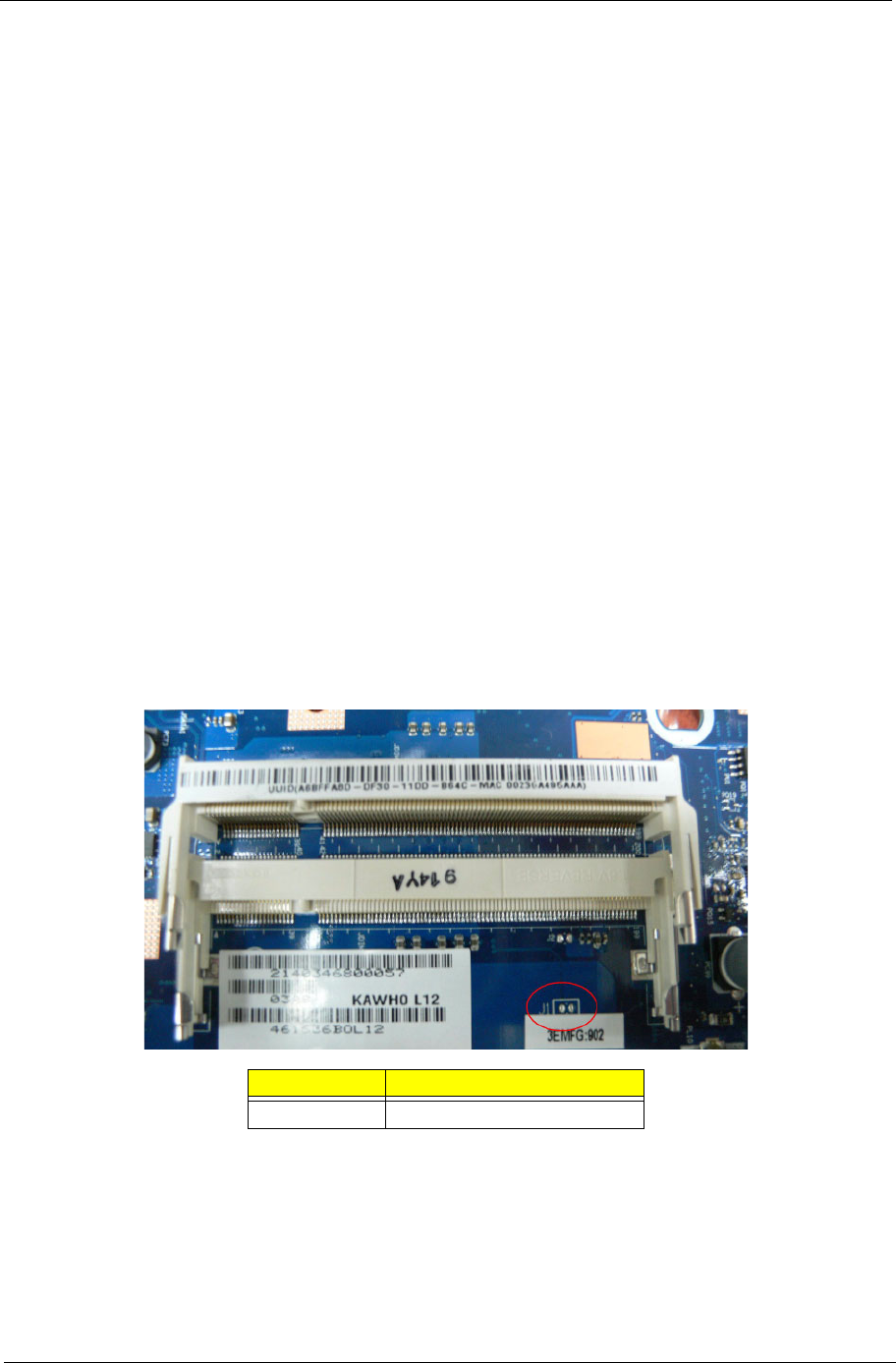
Chapter 5 149
Clearing Password Check and BIOS Recovery
This section provides you with the standard operating procedures of clearing password and BIOS recovery for
eMachine HM70-MV. The machine provides one Hardware Open Gap on main board for clearing password
check, and one Hotkey for enabling BIOS Recovery.
Clearing Password Check
Steps for Clearing BIOS Password Check
If users set BIOS Password (Supervisor Password and/or User Password) for a security reason, BIOS will ask
the password during systems POST or when systems enter to BIOS Setup menu. However, once it is
necessary to bypass the password check, users need to short the HW Gap to clear the password by the
following steps:
1. Power Off the system, and remove HDD, AC and Battery from the machine.
2. Disconnect the RTC Battery cable and locate the J1 jumper.
3. Use an electric conductivity tool to short the two points of the HW Gap.
4. Plug in AC, keep the short condition on the HW Gap, and press Power Button to power on the system till
BIOS POST finish. Then remove the tool from the HW Gap.
5. Restart system. Press F2 key to enter BIOS Setup menu.
6. If there is no Password request, BIOS Password is cleared. Otherwise, please follow the steps and try
again.
NOTE: These steps are only for clearing BIOS Password (Supervisor Password and User Password).
Clear CMOS Jumper
Item Description
J1 Clear CMOS Jumper

150 Chapter 5
BIOS Recovery by Crisis Disk
BIOS Recovery Boot Block:
BIOS Recovery Boot Block is a special block of BIOS. It is used to boot up the system with minimum BIOS
initialization. Users can enable this feature to restore the BIOS firmware to a successful one once the previous
BIOS flashing process failed.
BIOS Recovery Hotkey:
The system provides a function hotkey: Fn+Esc, for enable BIOS Recovery process when system is powered
on during BIOS POST. To use this function, it is strongly recommended to have the AC adapter and Battery
present. If this function is enabled, the system will force the BIOS to enter a special BIOS block, called Boot
Block.
Steps for BIOS Recovery from USB Storage:
Before doing this, prepare the Crisis USB key. The Crisis USB key could be made by executing the Crisis Disk
program in another system with Windows XP OS.
Follow the steps below:
1. Format the USB storage disk using the Fast Format option.
2. Save ROM file (file name: JAL90x64.fd) to the root directory of USB storage. Make sure that there is no
other BIOS file saved in the same directory.
3. Plug USB storage into USB port.
4. Press Fn + ESC button then plug in AC power.
The Power button flashes once.
5. Press Power button to initiate system CRISIS mode.
When CRISIS is complete, the system auto restarts with a workable BIOS.
6. Update the latest version BIOS for this machine by regular BIOS flashing process.

Chapter 6 151
FRU (Field Replaceable Unit) List
This chapter gives you the FRU (Field Replaceable Unit) listing in global configurations of Aspire 7715Z/7315. Refer to this
chapter whenever ordering for parts to repair or for RMA (Return Merchandise Authorization).
Please note that WHEN ORDERING FRU PARTS, you should check the most up-to-date information available on your
regional web or channel. For whatever reasons a part number change is made, it will not be noted on the printed Service
Guide. For ACER AUTHORIZED SERVICE PROVIDERS, your Acer office may have a DIFFERENT part number code from
those given in the FRU list of this printed Service Guide. You MUST use the local FRU list provided by your regional Acer
office to order FRU parts for repair and service of customer machines.
NOTE: To scrap or to return the defective parts, you should follow the local government ordinance or regulations on how to
dispose it properly, or follow the rules set by your regional Acer office on how to return it.
Chapter 6
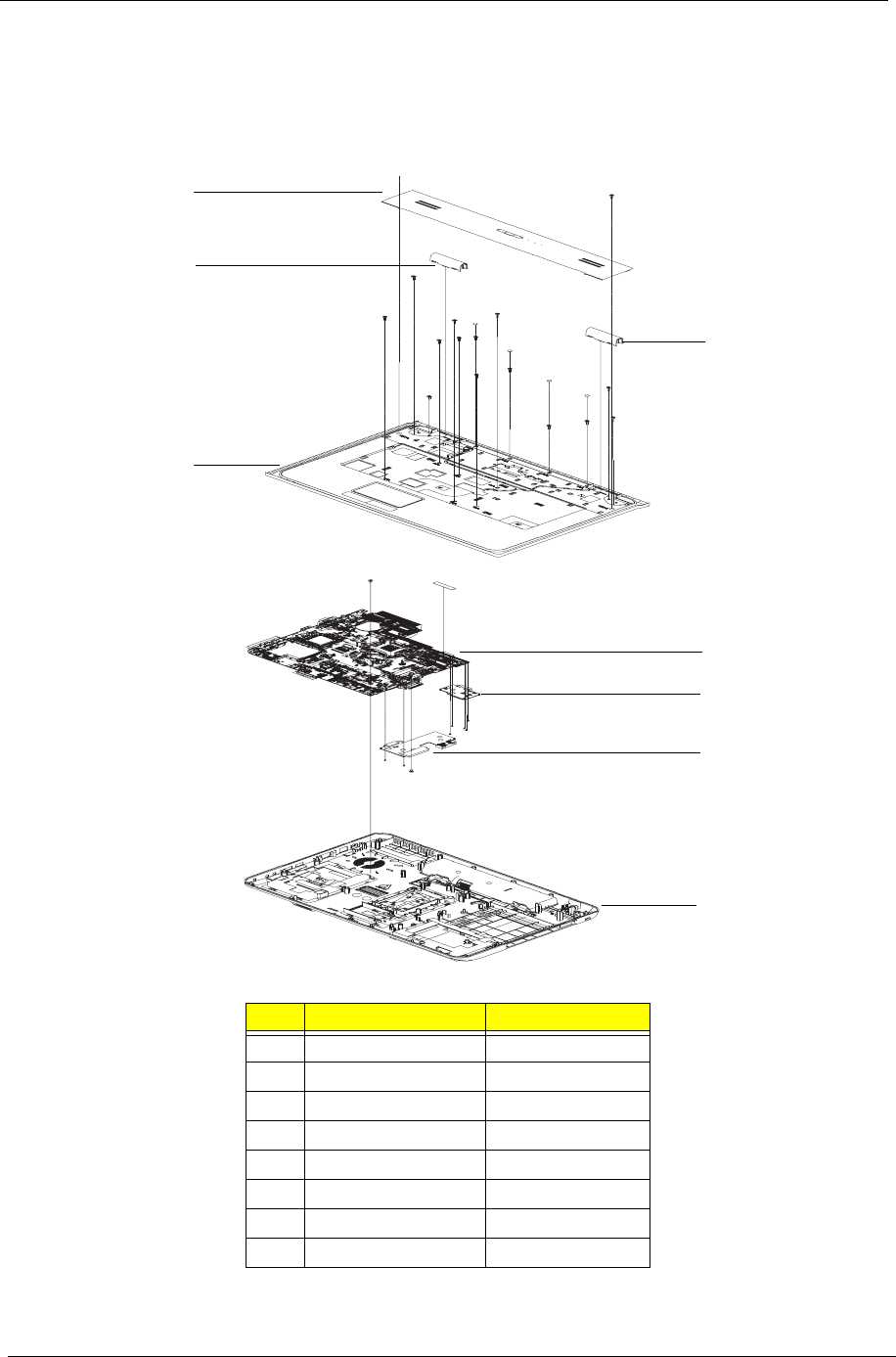
152 Chapter 6
Aspire 7715Z/7315 Exploded Diagrams
Main Assembly
No. Description Acer P/N
1 Middle Cover
2Up Cap (L)
3 Upper Cover
4Up Cap (R)
5 Mainboard
6
7
8 Lower Cover
1
2
3
4
5
6
7
8
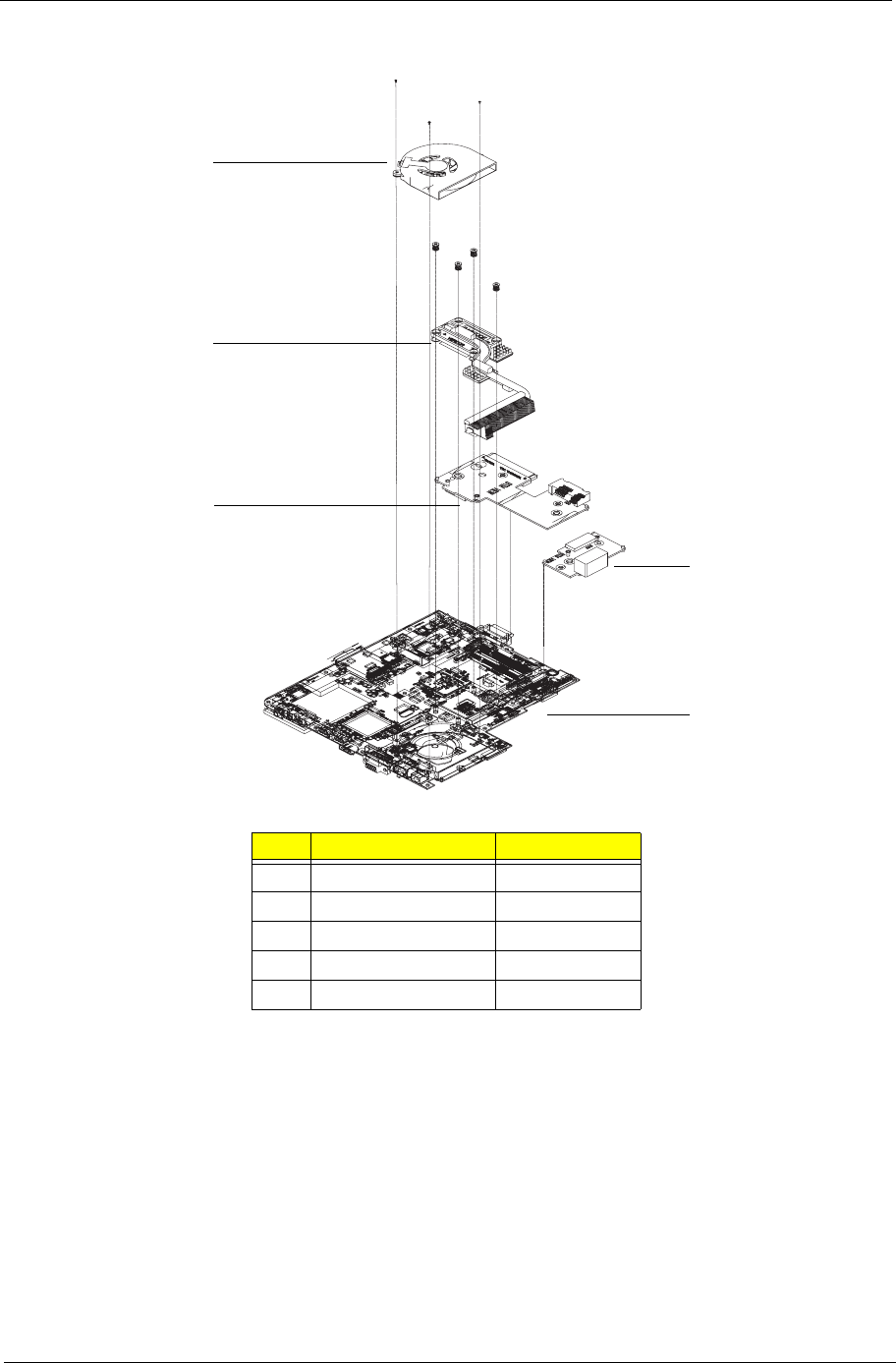
Chapter 6 153
Base Assembly
No. Description Acer P/N
1CPU Fan
2 Thermal Module
3
4
5 Mainboard
1
2
3
4
5
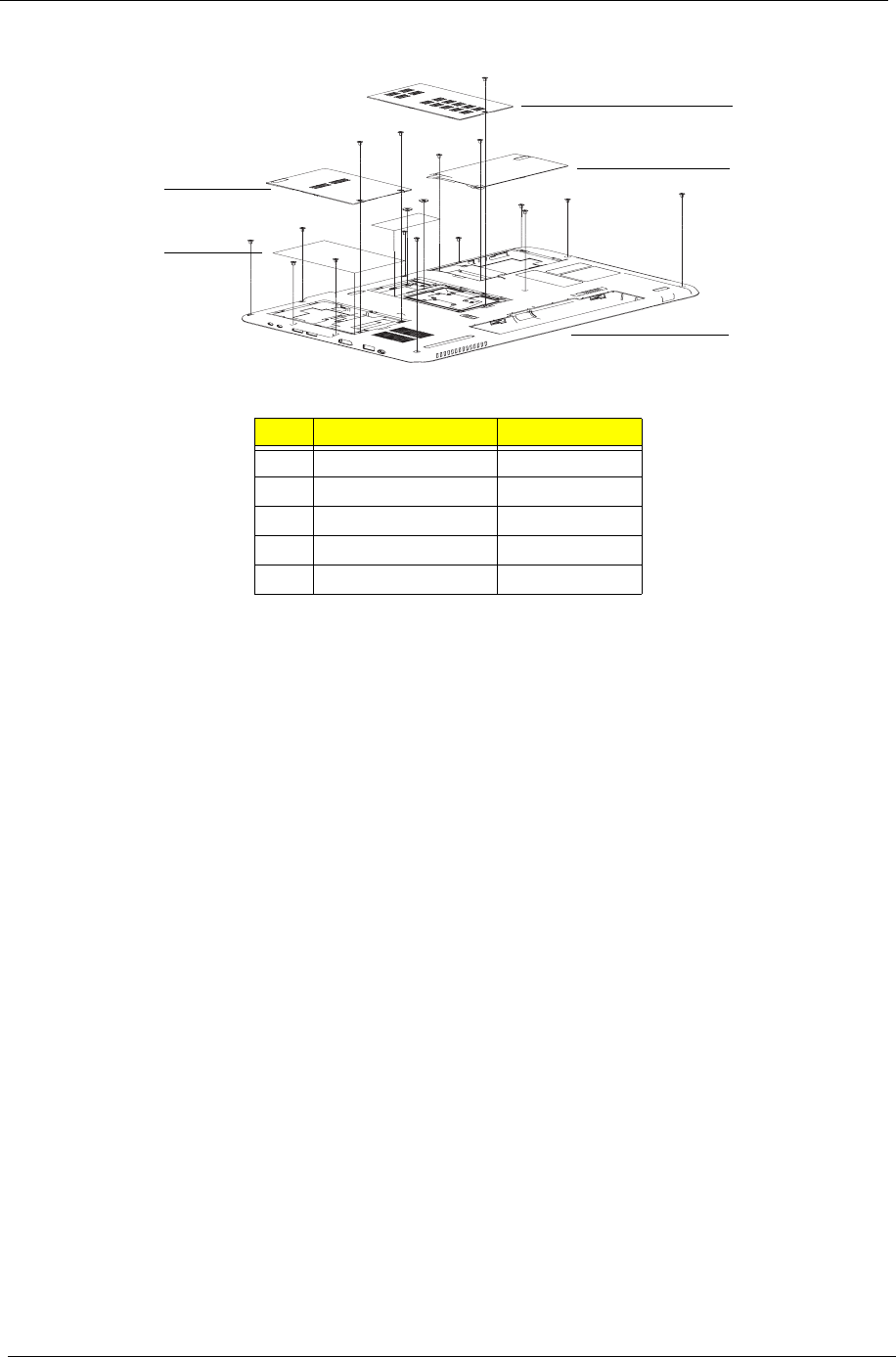
154 Chapter 6
Rear Assembly
No. Description Acer P/N
1 HDD Cover
2
3 RAM Cover
4
5
1
2
3
4
5
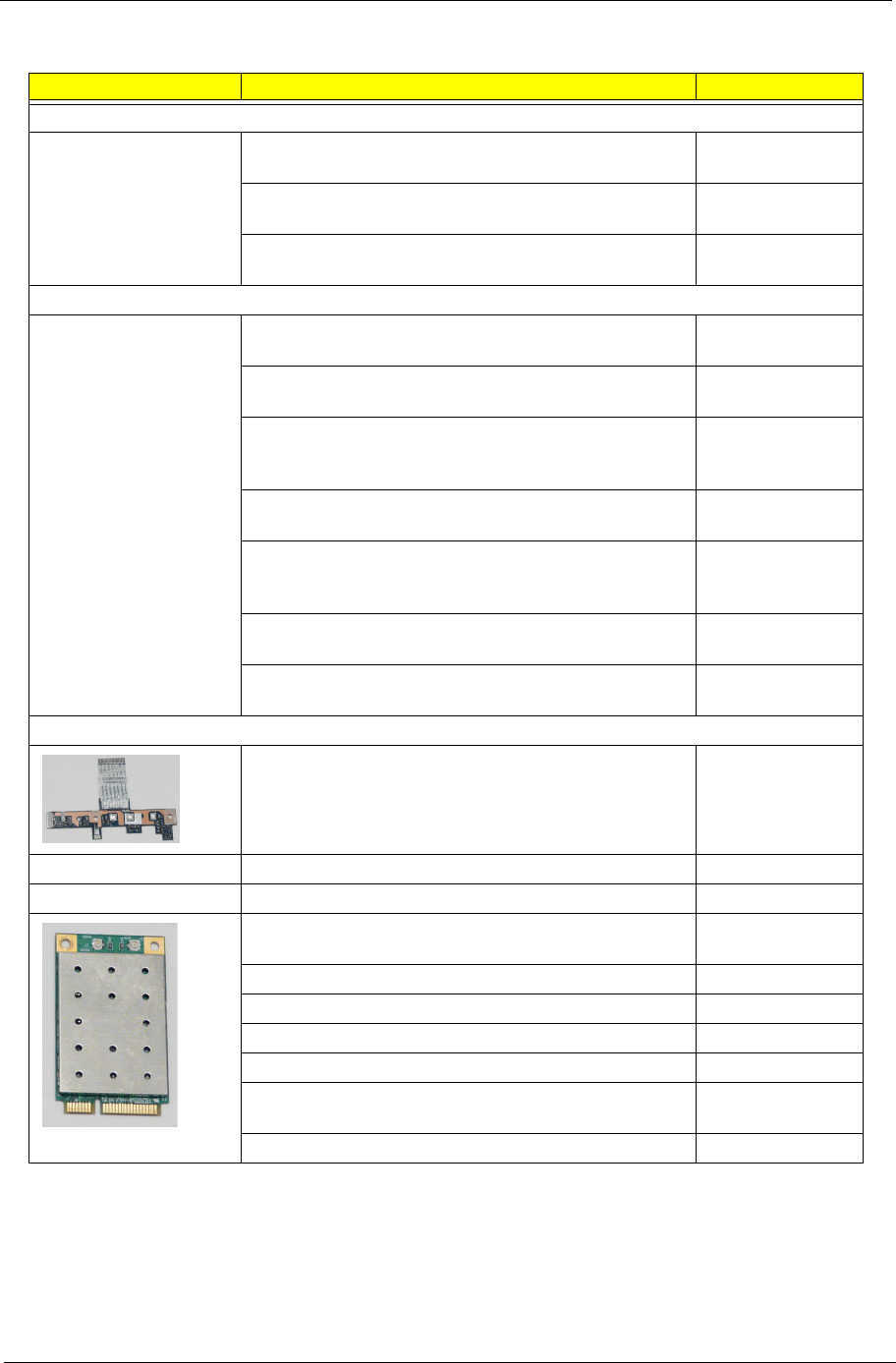
Chapter 6 155
Aspire 7715Z/7315 FRU List
CATEGORY DESCRIPTION AcerPN
ADAPTER
Adapter DELTA 65W 19V 1.7x5.5x11 Yellow ADP-
65JH DB A, LV5 LED LF
AP.06501.026
Adapter LITE-ON 65W 19V 1.7x5.5x11 Yellow PA-
1650-22AC LV5 LED LF
AP.06503.024
Adapter HIPRO 65W 19V 1.7x5.5x11 Yellow HP-
A0652R3B 1LF, LV5 LED LF
AP.0650A.012
BATTERY
Battery SANYO AS-2009A Li-Ion 3S2P SANYO 6 cell
4400mAh Main COMMON 2.2Ah(A)
BT.00603.076
Battery SONY AS-2009A Li-Ion 3S2P SONY 6 cell
4400mAh Main COMMON 2.2Ah(G6F)
BT.00604.030
Battery PANASONIC AS-2009A Li-Ion 3S2P
PANASONIC 6 cell 4400mAh Main COMMON
2.2Ah(CG )
BT.00605.036
Battery SAMSUNG AS-2009A Li-Ion 3S2P SAMSUNG
6 cell 4400mAh Main COMMON 2.2Ah(F)
BT.00606.002
Battery SIMPLO AS-2009A Li-Ion 3S2P PANASONIC
6 cell 4400mAh Main COMMON Panasonic 2.2Ah (
CG )
BT.00607.066
Battery SIMPLO AS-2009A Li-Ion 3S2P LGC 6 cell
4400mAh Main COMMON LGC 2.2Ah(S3 )
BT.00607.067
Battery SIMPLO AS-2009A Li-Ion 3S2P SAMSUNG 6
cell 4400mAh Main COMMON SDI 2.2Ah(F)
BT.00607.068
BOARD
POWER BOARD 55.N3702.001
ODD BOARD 55.N3702.002
BATTERY BOARD 55.N3702.003
Foxconn FOX_ATH_XB63 Foxconn Atheros XB63
minicard b/g
NI.23600.007
Foxconn Wireless LAN Broadcom 4312 minicard b/g NI.23600.029
Foxconn Wireless LAN Broadcom 4312H BG (HM) NI.23600.053
Foxconn Wirelss LAN Atheros HB95 1x1 BG (HM) NI.23600.047
Foxconn Wireless LAN Atheros HB93 1x2 BGN (HM) NI.23600.046
Liteon Wireless LAN Reltek RTL8191SE (WN6605LH)
(1x1)
NI.23600.056
Foxconn Wireless LAN Broadcomm 43225 BGN (HM) NI.23600.058
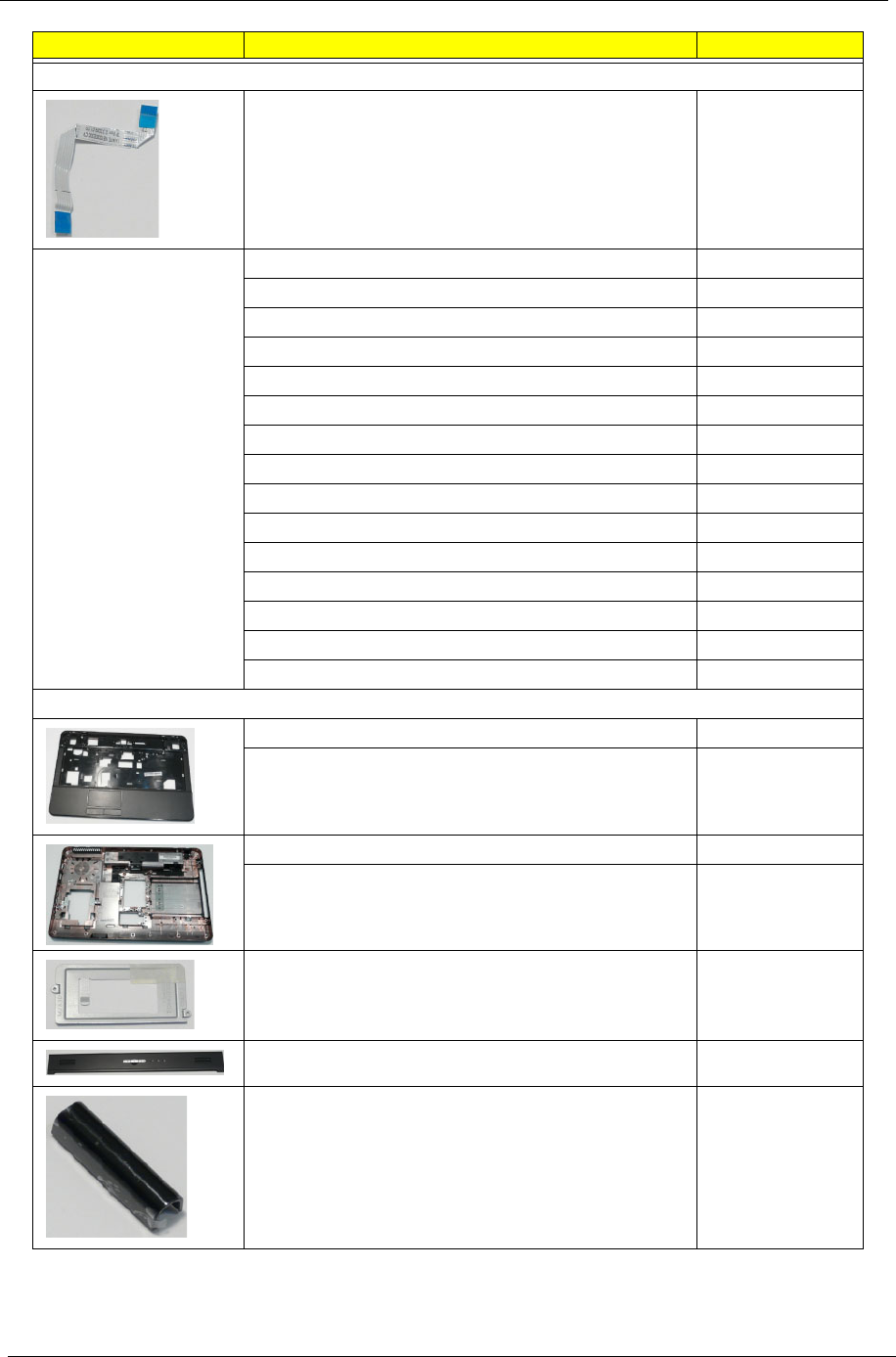
156 Chapter 6
CABLE
TP FFC 50.N3702.001
POWER CORD US 3 PIN 27.TAVV5.001
POWER CORD EU 3 PIN 27.TAVV5.002
POWER CORD AUS 3 PIN 27.TAVV5.003
POWER CORD UK 3 PIN 27.TAVV5.004
POWER CORD CHINA 3 PIN 27.TAVV5.005
POWER CORD SWISS 3 PIN 27.TAVV5.006
POWER CORD ITALIAN 3 PIN 27.TAVV5.007
POWER CORD DENMARK 3 PIN 27.TAVV5.008
POWER CORD JP 3 PIN 27.TAVV5.009
POWER CORD SOUTH AFRICA 3 PIN 27.TAVV5.010
POWER CORD KOERA 3 PIN 27.TAVV5.011
POWER CORD ISRAEL 3 PIN 27.TAVV5.012
POWER CORD INDIA 3 PIN 27.TAVV5.013
POWER CORD TWN 3 PIN 27.TAVV5.014
POWER CORD ARGENTINA 3 PIN 27.APV02.001
CASE/COVER/BRACKET ASSEMBLY
UPPER CASE ASSY 60.N3702.001
UPPER CASE ASSY, INCL.TP & TP MYLAR -
ASPIRE
60.PL602.001
LOWER CASE 60.N3702.002
LOWER CASE WASHER 47.N3702.001
TP BRACKET 33.N3702.001
MIDDLE COVER - ASPIRE 60.PL602.002
HINGE CAP ASSY 42.N3702.001
CATEGORY DESCRIPTION AcerPN

Chapter 6 157
RAM DOOR ASSY 42.N3702.002
HDD DOOR ASSY 42.N3702.003
2ND HDD DOOR ASSY 42.N3702.004
MINI CARD BRK 33.PGY02.001
33.N6602.001
CPU/PROCESSOR
CPU Intel CeleronM T1600 1.66G 1M 667 Dual Core,
MV
KC.16001.CMT
CPU Intel CeleronM T1700 PGA 1.83G 1M 667 Dual
Core, MV
KC.17001.CMT
CPU Intel Pentium Dual-Core T3400 PGA 2.16G 1M
667 MV
KC.34001.DTP
CPU Intel Pentium Dual-Core T4200 PGA 2.0G 1M
800 35W R-0 no VT
KC.42001.DTP
CPU Intel Celeron 575 PGA 2.0G 1M 667 MV KC.N0001.575
CPU Intel Celeron 585 PGA 2.16G 1M 667 MV KC.N0001.585
CPU Intel Celeron 900 PGA 2.2G 1M 800 35W KC.N0001.900
HDD/HARD DISK DRIVE
HDD SEAGATE 2.5" 5400rpm 160GB ST9160310AS
Crockett SATA LF F/W:0303
KH.16001.034
HDD TOSHIBA 2.5" 5400rpm 160GB MK1655GSX
Libra SATA LF F/W: FG011J
KH.16004.006
HDD HGST 2.5" 5400rpm 160GB HTS543216L9A300
Falcon-B SATA LF F/W:C40C
KH.16007.019
HDD WD 2.5" 5400rpm 160GB WD1600BEVT-
22ZCTO ML160 SATA LF F/W:11.01A11
KH.16008.022
HDD SEAGATE 2.5" 5400rpm 250GB ST9250315AS
Wyatt SATA LF F/W:0001SDM1
KH.25001.016
HDD TOSHIBA 2.5" 5400rpm 250GB MK2555GSX
Libra SATA LF F/W:FG001J
KH.25004.003
HDD HGST 2.5" 5400rpm 250GB HTS545025B9A300
Panther B SATA LF F/W:C60F
KH.25007.015
HDD WD 2.5" 5400rpm 250GB WD2500BEVT-
22ZCT0 ML160 SATA LF F/W:11.01A11
KH.25008.021
HDD SEAGATE 2.5" 5400rpm 320GB ST9320320AS
Crockett SATA LF F/W:0303
KH.32001.008
CATEGORY DESCRIPTION AcerPN
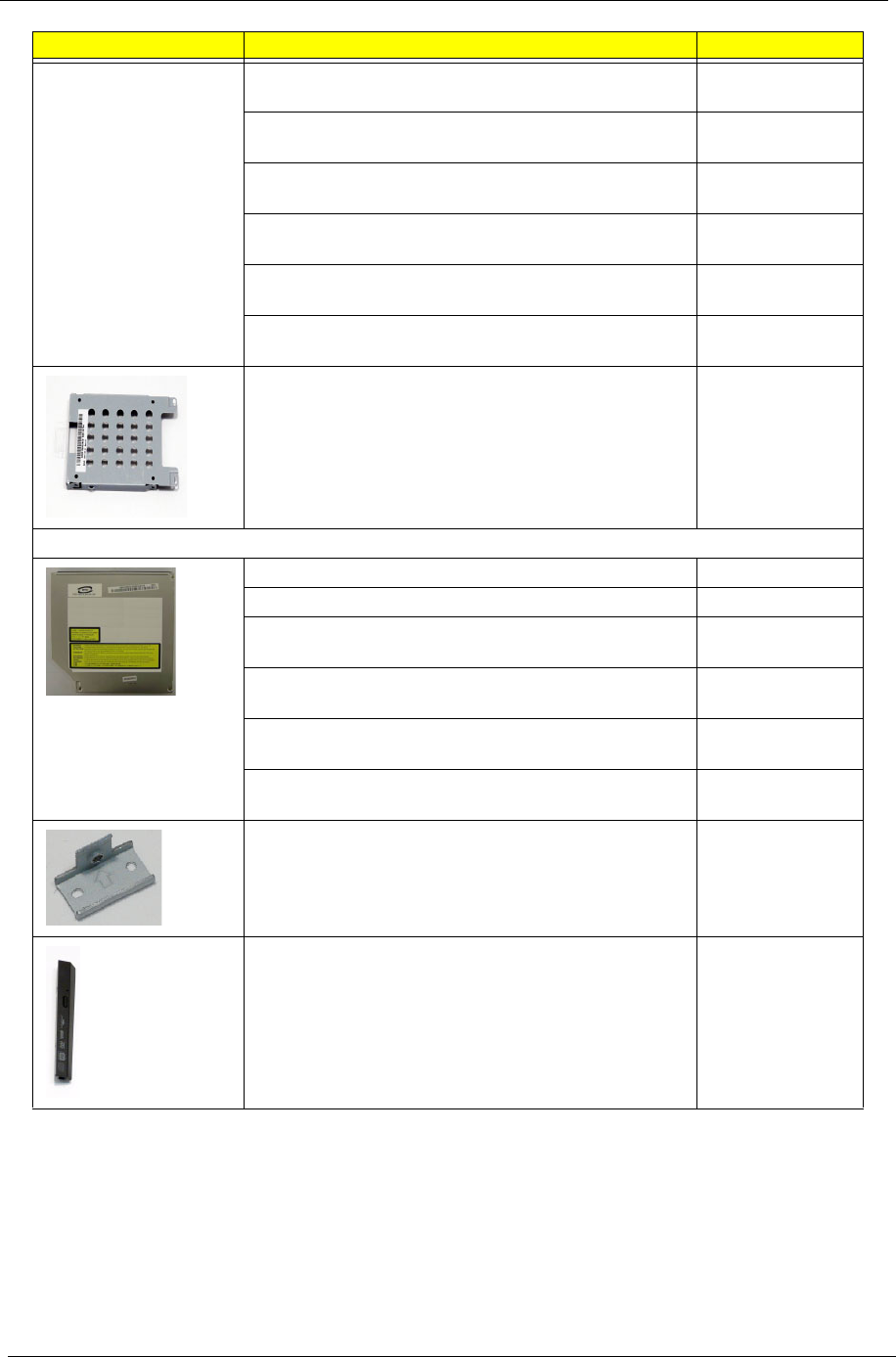
158 Chapter 6
HDD TOSHIBA 2.5" 5400rpm 320GB MK3255GSX
Libra SATA LF F/W:FG011J
KH.32004.002
HDD HGST 2.5" 5400rpm 320GB HTS545032B9A300
Panther B SATA LF F/W: C60F
KH.32007.007
HDD WD 2.5" 5400rpm 320GB WD3200BEVT-
22ZCT0 ML160 SATA LF F/W:11.01A11
KH.32008.013
HDD SEAGATE 2.5" 5400rpm 500GB ST9500325AS
Wyatt SATA LF F/W:0001SDM1
KH.50001.011
HDD WD 2.5" 5400rpm 500GB WD5000BEVT-
22ZAT0 ML250 SATA LF F/W:01.01A01
KH.50008.013
HDD HGST 2.5" 5400rpm 500GB HTS545050B9A300
Panther B SATA LF F/W:C60F
KH.50007.009
HDD BRACKET ASSY 33.N3702.002
DVD DRIVE
DVD SUPER MULTI DRIVE MODULE 6M.N3702.001
DVD SUPER MULTI DRIVE MODULE - Win 7 6M.PL802.001
ODD PANASONIC Super-Multi DRIVE 12.7mm Tray
DL 8X UJ880A LF W/O bezel SATA
KU.00807.064
ODD HLDS Super-Multi DRIVE 12.7mm Tray DL 8X
GT20N LF W/O bezel SATA
KU.0080D.040
ODD SONY Super-Multi DRIVE 12.7mm Tray DL 8X
AD-7580S LF W/O bezel SATA
KU.0080E.017
ODD PLDS Super-Multi DRIVE 12.7mm Tray DL 8X
DS-8A3S LF W/O bezel SATA
KU.0080F.004
ODD BRACKET 33.N3702.003
ODD BEZEL-SUPER MULTI 42.N3702.005
CATEGORY DESCRIPTION AcerPN
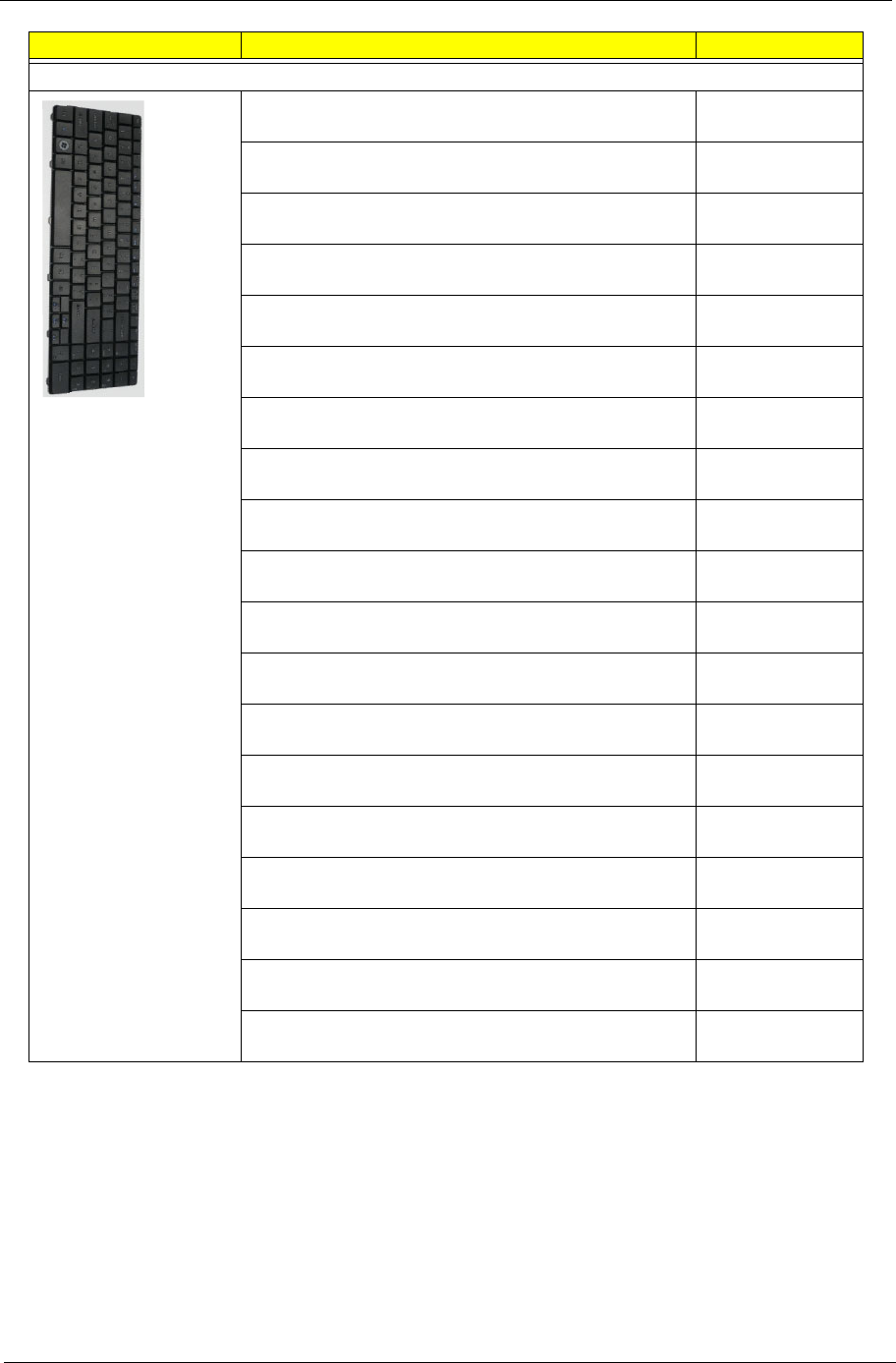
Chapter 6 159
KEYBOARD
Keyboard EM-7T HM50/70 Internal 17 Standard 99KS
Black Greek
KB.I1700.423
Keyboard EM-7T HM50/70 Internal 17 Standard 99KS
Black Arabic
KB.I1700.414
Keyboard EM-7T HM50/70 Internal 17 Standard 99KS
Black Russian
KB.I1700.430
Keyboard EM-7T HM50/70 Internal 17 Standard 99KS
Black Thailand
KB.I1700.435
Keyboard EM-7T HM50/70 Internal 17 Standard
100KS Black UK
KB.I1700.437
Keyboard EM-7T HM50/70 Internal 17 Standard
100KS Black German
KB.I1700.422
Keyboard EM-7T HM50/70 Internal 17 Standard
100KS Black Swiss/G
KB.I1700.434
Keyboard EM-7T HM50/70 Internal 17 Standard
100KS Black Belgium
KB.I1700.415
Keyboard EM-7T HM50/70 Internal 17 Standard
100KS Black Danish
KB.I1700.419
Keyboard EM-7T HM50/70 Internal 17 Standard
100KS Black Italian
KB.I1700.425
Keyboard EM-7T HM50/70 Internal 17 Standard
100KS Black French
KB.I1700.421
Keyboard EM-7T HM50/70 Internal 17 Standard
100KS Black Hungarian
KB.I1700.424
Keyboard EM-7T HM50/70 Internal 17 Standard
100KS Black Norwegian
KB.I1700.428
Keyboard EM-7T HM50/70 Internal 17 Standard
100KS Black Portuguese
KB.I1700.429
Keyboard EM-7T HM50/70 Internal 17 Standard
100KS Black Spanish
KB.I1700.432
Keyboard EM-7T HM50/70 Internal 17 Standard
100KS Black Turkish
KB.I1700.436
Keyboard EM-7T HM50/70 Internal 17 Standard
100KS Black Sweden
KB.I1700.433
Keyboard EM-7T HM50/70 Internal 17 Standard
100KS Black SLO/CRO
KB.I1700.431
Keyboard EM-7T HM50/70 Internal 17 Standard
100KS Black Nordic
KB.I1700.427
CATEGORY DESCRIPTION AcerPN
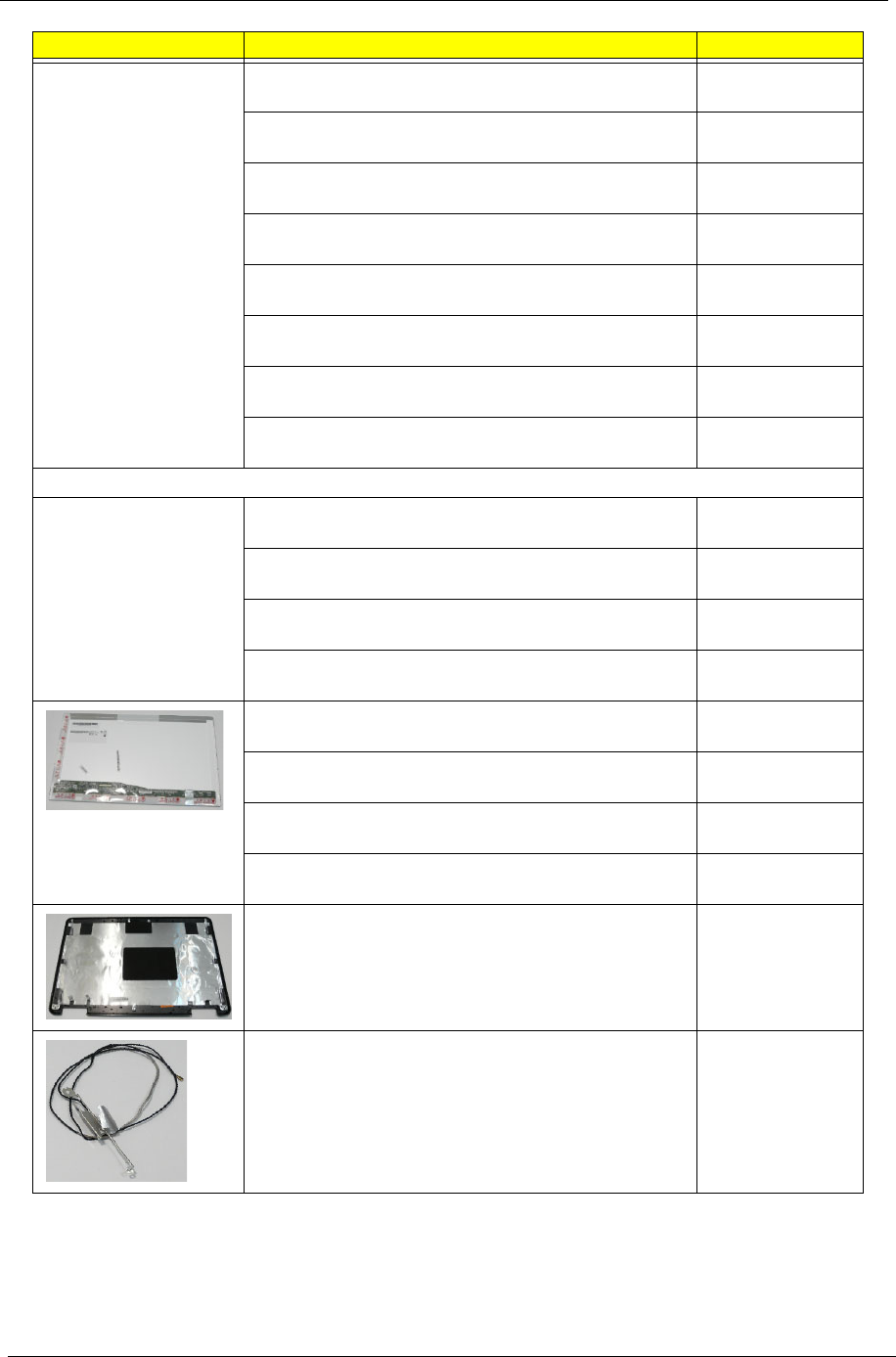
160 Chapter 6
Keyboard EM-7T HM50/70 Internal 17 Standard 99KS
Black US International
KB.I1700.438
Keyboard EM-7T HM50/70 Internal 17 Standard 99KS
Black Chinese
KB.I1700.418
Keyboard EM-7T HM50/70 Internal 17 Standard 99KS
Black US International w/ Hebrew
KB.I1700.439
Keyboard EM-7T HM50/70 Internal 17 Standard
100KS Black FR/Arabic
KB.I1700.420
Keyboard EM-7T HM50/70 Internal 17 Standard
100KS Black US w/ Canadian French
KB.I1700.440
Keyboard EM-7T HM50/70 Internal 17 Standard
100KS Black Brazilian Portuguese
KB.I1700.416
Keyboard EM-7T HM50/70 Internal 17 Standard
100KS Black CZ/SK
KB.I1700.417
Keyboard EM-7T HM50/70 Internal 17 Standard
103KS Black Japanese
KB.I1700.426
LCD
ASSY LED MODULE 17.3 IN. WXGA GLARE W/
ANTENNA*2 CCD 0.3M - ASPIRE
6M.PL602.001
ASSY LED MODULE 17.3 IN. WXGA GLARE W/
ANTENNA*3 CCD 0.3M - ASPIRE
6M.PL602.002
ASSY LED MODULE 17.3 IN. WXGA GLARE W/
ANTENNA*2, W/O CCD - ASPIRE
6M.PL802.002
ASSY LED MODULE 17.3 IN. WXGA GLARE W/
ANTENNA*3, W/O CCD - ASPIRE
6M.PL802.003
LED LCD AUO 17.3" WXGA+ Glare B173RW01-V0 LF
220nit 8ms 600:1
LK.17305.001
LED LCD SAMSUNG 17.3" WXGA+ Glare
LTN173KT01-A01 LF 220nit 8ms 600:1
LK.17306.001
LED LCD LPL 17.3" WXGA+ Glare LP173WD1-TLA1
LF 220nit 8ms 600:1
LK.17308.001
LED LCD CMO 17.3" WXGA+ Glare N173O6-L02 LF
220nit 8ms 600:1
LK.1730D.001
LCD COVER - ASPIRE 60.PL602.003
ANTENNA MAIN 50.N3702.002
CATEGORY DESCRIPTION AcerPN
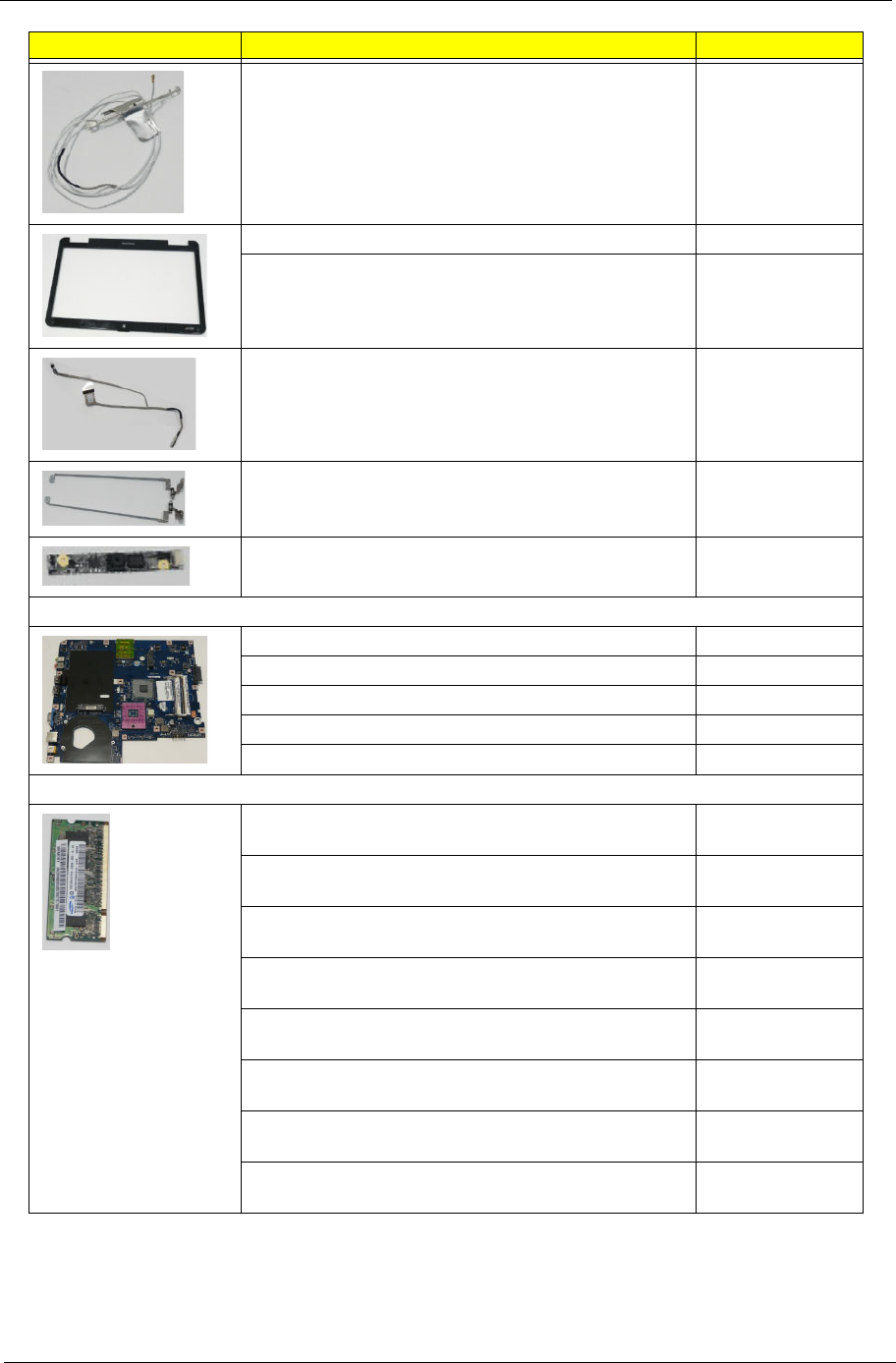
Chapter 6 161
ANTENNA AUX 50.N3702.004
LCD BEZEL FOR W/CCD FUNCTION - ASPIRE 60.PL602.004
LCD BEZEL FOR W/O CCD FUNCTION - ASPIRE 60.PL502.001
LED CABLE FOR W/CCD F 60.N3702.006
LCD BRACKET R&L FOR LED F 33.N3702.004
CAMERA 0.3 57.N2802.001
MAINBOARD
MB ASSY-GM45(B3)-INTEL MB.N5302.001
MB ASSY-GM45(A1)-INTEL TBD
MB ASSY-GL40-(B3)-INTEL TBD
Mainboard AS7715Z Intel GL40 ICH9M V1.0 LF MB.PL402.001
Mainboard G525 Intel GL40 ICH9M V1.0 LF DDR3 MB.N8302.001
MEMORY
Memory NANYA SO-DIMM DDRII 667 1GB
NT1GT64UH8D0FN-3C LF 64*16 0.07um
KN.1GB03.026
Memory MICRON SO-DIMM DDRII 667 1GB
MT8HTF12864HDY-667G1 LF 64*16 0.065um
KN.1GB04.010
Memory ELPIDA SO-DIMM DDRII 667 1GB
EBE11UE6ACUA-6E-E LF 64*16 0.065um
KN.1GB09.008
Memory SAMSUNG SO-DIMM DDRII 667 1GB
M470T2864EH3-CE6 LF 64*16 0.055um
KN.1GB0B.027
Memory HYNIX SO-DIMM DDRII 667 1GB
HYMP112S64CP6-Y5 LF
KN.1GB0G.012
Memory HYNIX SO-DIMM DDRII 667 1GB
HMP112S6EFR6C-Y5 LF 64*16 0.055um
KN.1GB0G.022
Memory NANYA SO-DIMM DDRII 667 2GB
NT2GT64U8HD0BN-3C LF 128*8 0.07um
KN.2GB03.011
Memory MICRON SO-DIMM DDRII 667 2GB
MT16HTF25664HY-667G1 LF 128*8 0.065um
KN.2GB04.010
CATEGORY DESCRIPTION AcerPN
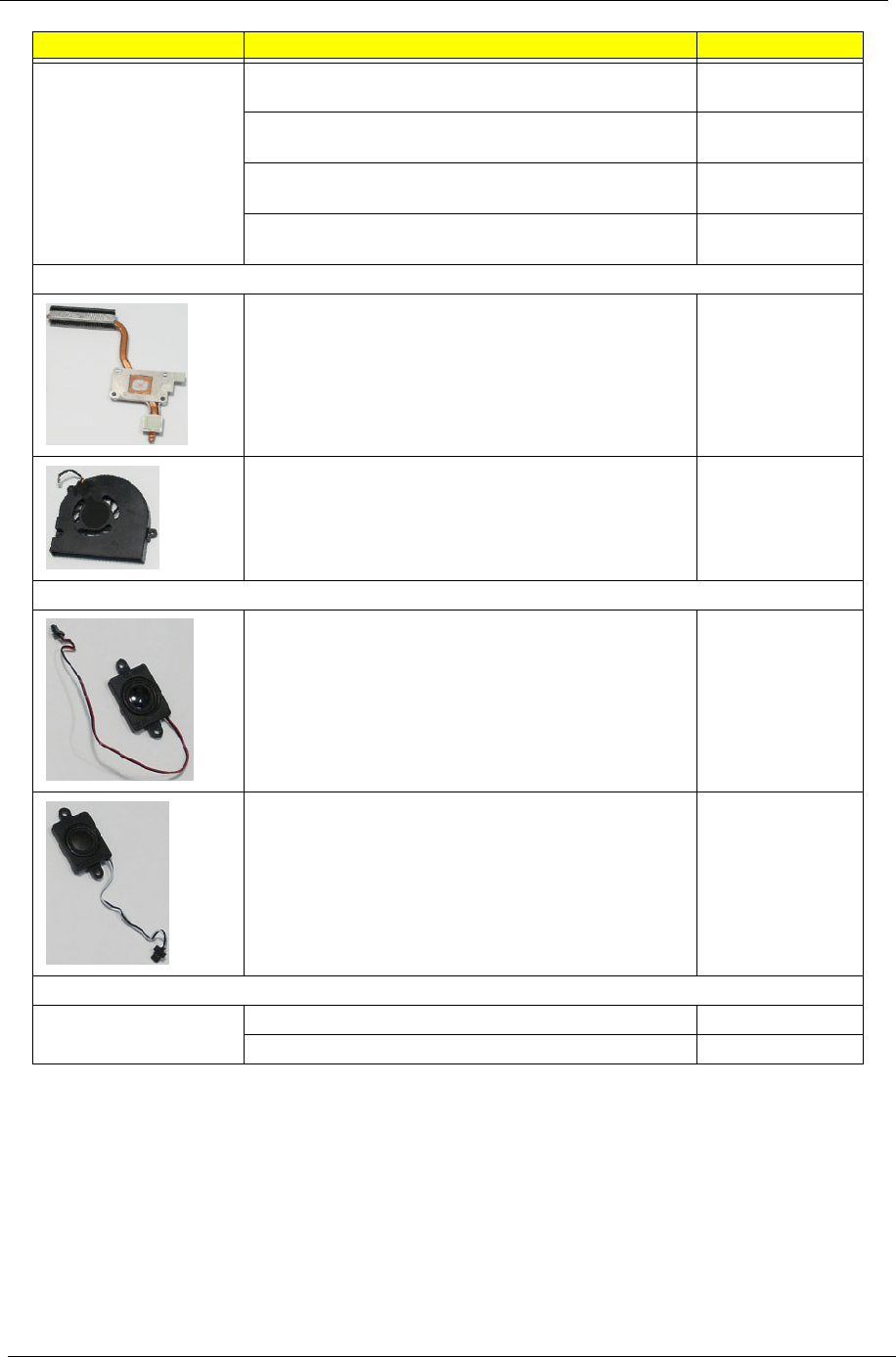
162 Chapter 6
Memory ELPIDA SO-DIMM DDRII 667 2GB
EBE21UE8ACUA-6E-E LF 128*8 0.07um
KN.2GB09.001
Memory SAMSUNG SO-DIMM DDRII 667 2GB
M470T5663EH3-CE6 LF 128*8 0.055um
KN.2GB0B.011
Memory HYNIX SO-DIMM DDRII 667 2GB
HYMP125S64CP8-Y5 LF
KN.2GB0G.004
Memory HYNIX SO-DIMM DDRII 667 2GB
HMP125S6EFR8C-Y5 LF 128*8 0.055um
KN.2GB0G.012
HEATSINK
THERMAL MODULE-INTEL 60.N3702.007
FAN 23.N3702.001
SPEAKER
SPEAKER R 23.N3702.002
SPEAKER L 23.N3702.003
MISCELLANEOUS
NAME PLATE-AS7715 40.PL502.001
NAME PLATE-AS7315 40.PL802.001
CATEGORY DESCRIPTION AcerPN

Chapter 6 163
Screw List
CATEGORY DESCRIPTION Acer PN
SCREW
SCREW M2.48D 4.0L K 5.5D 0.8T ZKNL 86.N3702.001
SCREW M2.48D 6.0L K 5.5D 0.8T ZKNL 86.N3702.002
SCREW M2.45D 8.0L K 5.5D 0.8T ZKNL 86.N3702.003
SCREW M1.98D 3.0L K 4.6D 0.8T ZKNL 86.N3702.004
SCREW M M 2D 5L K 4.6D NI NL+ 86.N3702.005
SCREW M M 3.0D 3.0L K 4.9D NI+ 86.N3702.006
SCREW ASSY CPU THERMAL 86.N3702.007

Appendix A 164
Model Definition and Configuration
Appendix A

165 Appendix A
Aspire 7315
Model Acer Part No RO Country Description
AS7315-
903G50Mi
S2.PL602.001 WW WW AS7315-903G50Mi W7HP64AWW1 UMACks
2G+1G/500_L/6L2.2/5R/CB_bg_0.3D_HG_ES62
AS7315-
313G25Mn
LX.PNL02.001 EMEA UK AS7315-313G25Mn W7HP64ATGB1 MC UMACks_3
2G+1G/250/6L2.2/5R/CB_bgn_0.3D_HG_EN11
AS7315-
902G25Mn
S2.PNL02.001 WW WW AS7315-902G25Mn W7HP64AWW1 MC UMACks_3
1*2G/250/6L2.2/5R/CB_bgn_0.3D_HG_ES62
AS7315-
302G25Mn
S2.PL80C.001 WW WW AS7315-302G25Mn LINPUSAWW1 UMAks 1*2G/
250/6L2.2/5R/CB_bgn_HG_EN11
AS7315-
902G25Mn
S2.PNM0C.001 WW WW AS7315-902G25Mn LINPUSAWW1 UMAks_3 2*1G/
250/6L2.2/5R/CB_bgn_HG_EN11
Model Acer Part No CPU LCD VGA
Chip VRAM
1Memory 1 Memory 2
AS7315-
903G50Mi
S2.PL602.001 CM900 NLED17.3
WXGA+G
UMA N SO2GBII6 SO1GBII6
AS7315-
313G25Mn
LX.PNL02.001 CMT3100 NLED17.3
WXGA+G
UMA N SO2GBIII
10
SO1GBIII1
0
AS7315-
902G25Mn
S2.PNL02.001 CM900 NLED17.3
WXGA+G
UMA N SO2GBIII
10
N
AS7315-
302G25Mn
S2.PL80C.001 CMT3000 NLED17.3
WXGA+G
UMA N SO2GBII6 N
AS7315-
902G25Mn
S2.PNM0C.001 CM900 NLED17.3
WXGA+G
UMA N SO1GBIII
10
SO1GBIII1
0
Model Acer Part No Memory
3Memory
4HDD
1(GB) HDD
2(GB) ODD Media
Processor
AS7315-
903G50Mi
S2.PL602.001 N N N500GB
5.4KS
NNSM8XSN
AS7315-
313G25Mn
LX.PNL02.001 N N N250GB
5.4KS
NNSM8XSN
AS7315-
902G25Mn
S2.PNL02.001 N N N250GB
5.4KS
NNSM8XSN
AS7315-
302G25Mn
S2.PL80C.001 N N N250GB
5.4KS
NNSM8XSN
AS7315-
902G25Mn
S2.PNM0C.001 N N N250GB
5.4KS
NNSM8XSN
Model Acer Part No Extra
SW1 Card Reader Wireless LAN1 Bluetooth VOIP
Phone
AS7315-
903G50Mi
S2.PL602.001 NIS 5 in 1-Build in 3rd WiFi BG N N
AS7315-
313G25Mn
LX.PNL02.001 McAfee 5 in 1-Build in 3rd WiFi 1x2
BGN
NN
AS7315-
902G25Mn
S2.PNL02.001 McAfee 5 in 1-Build in 3rd WiFi 1x2
BGN
NN

Appendix A 166
AS7315-
302G25Mn
S2.PL80C.001 N 5 in 1-Build in 3rd WiFi 1x2
BGN
NN
AS7315-
902G25Mn
S2.PNM0C.001 N 5 in 1-Build in 3rd WiFi 1x2
BGN
NN
Model Acer Part No Extra
SW1 Card Reader Wireless LAN1 Bluetooth VOIP
Phone

167 Appendix A
Aspire 7715Z
Model Acer Part No RO Country Description
AS7715Z-
433G25Mi
S2.PL40C.001 WW WW AS7715Z-433G25Mi LINPUSAWW1
UMACks 2G+1G/250/6L2.2/5R/
CB_bg_0.3D_HG_EN11
AS7715Z-
443G25Mn
LX.PNJ02.016 EMEA UK AS7715Z-443G25Mn W7HP64ATGB1 MC
UMACks_3 2G+1G/250/6L2.2/5R/
CB_bgn_0.3D_HG_EN11
AS7715Z-
444G32Mn
LX.PNJ02.045 EMEA UK AS7715Z-444G32Mn W7HP64ATGB1 MC
UMACks_3 2*2G/320/6L2.2/5R/
CB_bgn_0.3D_HG_EN11
AS7715Z-
444G32Mn
LX.PNJ02.057 EMEA France AS7715Z-444G32Mn W7HP64ATFR1 MC
UMACks_3 2*2G/320/6L2.2/5R/
CB_bgn_0.3D_HG_FR21
AS7715Z-
443G32Mn
LX.PNJ02.061 EMEA Holland AS7715Z-443G32Mn W7HP64ATNL1 MC
UMACks_3 2G+1G/320/6L2.2/5R/
CB_bgn_0.3D_HG_NL11
AS7715Z-
442G32Mn
LX.PNJ0C.007 EMEA Poland AS7715Z-442G32Mn LINPUSAPL1
UMACks_3 1*2G/320/6L2.2/5R/
CB_bgn_0.3D_HG_EN41
AS7715Z-
444G50Mn
LX.PNJ02.070 EMEA Holland AS7715Z-444G50Mn W7HP64ATNL1 MC
UMACks_3 2*2G/500_L/6L2.2/5R/
CB_bgn_0.3D_HG_NL11
AS7715Z-
443G32Mn
LX.PNJ02.062 EMEA Belgium AS7715Z-443G32Mn W7HP64ATBE1 MC
UMACks_3 2G+1G/320/6L2.2/5R/
CB_bgn_0.3D_HG_NL11
AS7715Z-
444G64Mn
LX.PNJ02.065 EMEA Belgium AS7715Z-444G64Mn W7HP64ATBE1 MC
UMACks_3 2*2G/640/6L2.2/5R/
CB_bgn_0.3D_HG_NL11
AS7715Z-
444G50Mn
LX.PNJ02.069 EMEA Belgium AS7715Z-444G50Mn W7HP64ATBE1 MC
UMACks_3 2*2G/500_L/6L2.2/5R/
CB_bgn_0.3D_HG_NL11
AS7715Z-
444G50Mn
LX.PNJ02.068 EMEA Luxembourg AS7715Z-444G50Mn W7HP64ATLU3 MC
UMACks_3 2*2G/500_L/6L2.2/5R/
CB_bgn_0.3D_HG_IT41
AS7715Z-
444G25Mn
LX.PNJ02.067 EMEA Eastern
Europe
AS7715Z-444G25Mn W7HP64ATEU4 MC
UMACks_3 2*2G/250/6L2.2/5R/
CB_bgn_0.3D_HG_SV21
AS7715Z-
444G25Mn
LX.PNJ02.066 EMEA Latvia AS7715Z-444G25Mn W7HP64ATLV1 MC
UMACks_3 2*2G/250/6L2.2/5R/
CB_bgn_0.3D_HG_LT11
AS7715Z-
444G32Mn
LX.PNJ02.059 EMEA Switzerland AS7715Z-444G32Mn W7HP64ATCH1 MC
UMACks_3 2*2G/320/6L2.2/5R/
CB_bgn_0.3D_HG_IT41
AS7715Z-
444G64Mn
LX.PNJ02.064 EMEA Holland AS7715Z-444G64Mn W7HP64ATNL1 MC
UMACks_3 2*2G/640/6L2.2/5R/
CB_bgn_0.3D_HG_NL11
AS7715Z-
444G64Mn
LX.PNJ02.063 EMEA Luxembourg AS7715Z-444G64Mn W7HP64ATLU3 MC
UMACks_3 2*2G/640/6L2.2/5R/
CB_bgn_0.3D_HG_IT41
AS7715Z-
443G32Mn
LX.PNJ02.060 EMEA Luxembourg AS7715Z-443G32Mn W7HP64ATLU3 MC
UMACks_3 2G+1G/320/6L2.2/5R/
CB_bgn_0.3D_HG_IT41

Appendix A 168
AS7715Z-
442G32Mn
LX.PNJ02.058 EMEA Switzerland AS7715Z-442G32Mn W7HP64ATCH1 MC
UMACks_3 1*2G/320/6L2.2/5R/
CB_bgn_0.3D_HG_IT41
AS7715Z-
434G50Mn
LX.PNJ02.050 EMEA Norway AS7715Z-434G50Mn W7HP64ATNO3 MC
UMACks_3 2*2G/500_L/6L2.2/5R/
CB_bgn_0.3D_HG_ENS1
AS7715Z-
434G32Mn
LX.PNJ02.049 EMEA Norway AS7715Z-434G32Mn W7HP64ATNO3 MC
UMACks_3 2*2G/320/6L2.2/5R/
CB_bgn_0.3D_HG_ENS1
AS7715Z-
444G64Mn
LX.PNJ02.054 EMEA Switzerland AS7715Z-444G64Mn W7HP64ATCH1 MC
UMACks_3 2*2G/640/6L2.2/5R/
CB_bgn_0.3D_HG_IT41
AS7715Z-
444G32Mn
LX.PNJ02.041 EMEA Denmark AS7715Z-444G32Mn W7HP64ATDK2 MC
UMACks_3 2*2G/320/6L2.2/5R/
CB_bgn_0.3D_HG_ENS1
AS7715Z-
444G50Mn
LX.PNJ02.052 EMEA France AS7715Z-444G50Mn W7HP64ATFR1 MC
UMACks_3 2*2G/500_L/6L2.2/5R/
CB_bgn_0.3D_HG_FR21
AS7715Z-
444G32Mn
LX.PNJ0C.008 EMEA Poland AS7715Z-444G32Mn LINPUSAPL1
UMACks_3 2*2G/320/6L2.2/5R/
CB_bgn_0.3D_HG_EN41
AS7715Z-
442G25Mn
LX.PNJ02.056 EMEA Switzerland AS7715Z-442G25Mn W7HP64ATCH1 MC
UMACks_3 1*2G/250/6L2.2/5R/
CB_bgn_0.3D_HG_IT41
AS7715Z-
444G50Mn
LX.PNJ0C.005 EMEA Eastern
Europe
AS7715Z-444G50Mn LINPUSAEU7
UMACks_3 2*2G/500_L/6L2.2/5R/
CB_bgn_0.3D_HG_ENQ1
AS7715Z-
444G50Mn
LX.PNJ02.053 EMEA Switzerland AS7715Z-444G50Mn W7HP64ATCH1 MC
UMACks_3 2*2G/500_L/6L2.2/5R/
CB_bgn_0.3D_HG_IT41
AS7715Z-
443G32Mn
LX.PNJ0C.004 EMEA Eastern
Europe
AS7715Z-443G32Mn LINPUSAEU5
UMACks_3 2G+1G/320/6L2.2/5R/
CB_bgn_0.3D_HG_ENF1
AS7715Z-
444G32Mn
LX.PNJ02.044 EMEA Norway AS7715Z-444G32Mn W7HP64ATNO3 MC
UMACks_3 2*2G/320/6L2.2/5R/
CB_bgn_0.3D_HG_ENS1
AS7715Z-
444G32Mn
LX.PNJ02.043 EMEA Finland AS7715Z-444G32Mn W7HP64ATFI2 MC
UMACks_3 2*2G/320/6L2.2/5R/
CB_bgn_0.3D_HG_FI12
AS7715Z-
444G32Mn
LX.PNJ02.042 EMEA Sweden AS7715Z-444G32Mn W7HP64ATSE1 MC
UMACks_3 2*2G/320/6L2.2/5R/
CB_bgn_0.3D_HG_FI12
AS7715Z-
443G25Mn
LX.PNJ02.040 EMEA Ukraine AS7715Z-443G25Mn W7HP64RUATUK1
MC UMACks_3 2G+1G/250/6L2.2/5R/
CB_bgn_0.3D_HG_RU61
AS7715Z-
443G25Mi
LX.PNJ02.039 EMEA Russia AS7715Z-443G25Mi W7HP64RUATRU1
MC UMACks_3 2G+1G/250/6L2.2/5R/
CB_bg_0.3D_HG_RU11
AS7715Z-
443G25Mn
LX.PNJ02.038 EMEA Middle East AS7715Z-443G25Mn EM
W7HP64EMATME4 MC UMACks_3
2G+1G/250/6L2.2/5R/
CB_bgn_0.3D_HG_RU61
Model Acer Part No RO Country Description

169 Appendix A
AS7715Z-
443G25Mn
LX.PNJ02.037 EMEA Middle East AS7715Z-443G25Mn EM
W7HP64EMATME2 MC UMACks_3
2G+1G/250/6L2.2/5R/
CB_bgn_0.3D_HG_ES61
AS7715Z-
443G25Mn
LX.PNJ02.036 EMEA South Africa AS7715Z-443G25Mn EM
W7HP64EMATZA2 MC UMACks_3
2G+1G/250/6L2.2/5R/
CB_bgn_0.3D_HG_ES61
AS7715Z-
443G25Mn
LX.PNJ02.035 EMEA Turkey AS7715Z-443G25Mn EM
W7HP64EMATTR1 MC UMACks_3
2G+1G/250/6L2.2/5R/
CB_bgn_0.3D_HG_TR31
AS7715Z-
443G25Mn
LX.PNJ02.034 EMEA Middle East AS7715Z-443G25Mn EM
W7HP64EMATME2 MC UMACks_3
2G+1G/250/6L2.2/5R/
CB_bgn_0.3D_HG_AR21
AS7715Z-
443G25Mn
LX.PNJ02.033 EMEA Middle East AS7715Z-443G25Mn EM
W7HP64EMATME9 MC UMACks_3
2G+1G/250/6L2.2/5R/
CB_bgn_0.3D_HG_ES81
AS7715Z-
443G25Mn
LX.PNJ02.032 EMEA Algeria AS7715Z-443G25Mn EM
W7HP64EMATDZ1 MC UMACks_3
2G+1G/250/6L2.2/5R/
CB_bgn_0.3D_HG_ES81
AS7715Z-
443G25Mn
LX.PNJ02.031 EMEA South Africa AS7715Z-443G25Mn EM
W7HP64EMATZA1 MC UMACks_3
2G+1G/250/6L2.2/5R/
CB_bgn_0.3D_HG_ES81
AS7715Z-
443G25Mn
LX.PNJ02.030 EMEA Middle East AS7715Z-443G25Mn EM
W7HP64EMATME4 MC UMACks_3
2G+1G/250/6L2.2/5R/
CB_bgn_0.3D_HG_ES61
AS7715Z-
443G25Mn
LX.PNJ02.029 EMEA Middle East AS7715Z-443G25Mn EM
W7HP64EMATME2 MC UMACks_3
2G+1G/250/6L2.2/5R/
CB_bgn_0.3D_HG_AR11
AS7715Z-
443G25Mn
LX.PNJ02.028 EMEA Middle East AS7715Z-443G25Mn EM
W7HP64EMATME3 MC UMACks_3
2G+1G/250/6L2.2/5R/
CB_bgn_0.3D_HG_ES81
AS7715Z-
443G25Mn
LX.PNJ02.027 EMEA Middle East AS7715Z-443G25Mn EM
W7HP64EMATME6 MC UMACks_3
2G+1G/250/6L2.2/5R/
CB_bgn_0.3D_HG_ES61
AS7715Z-
443G25Mn
LX.PNJ02.026 EMEA South Africa AS7715Z-443G25Mn EM
W7HP64EMATZA4 MC UMACks_3
2G+1G/250/6L2.2/5R/
CB_bgn_0.3D_HG_ES61
AS7715Z-
443G25Mn
LX.PNJ02.025 EMEA Germany AS7715Z-443G25Mn W7HP64ATDE1 MC
UMACks_3 2G+1G/250/6L2.2/5R/
CB_bgn_0.3D_HG_DE11
AS7715Z-
443G25Mn
LX.PNJ02.024 EMEA Poland AS7715Z-443G25Mn W7HP64ATPL1 MC
UMACks_3 2G+1G/250/6L2.2/5R/
CB_bgn_0.3D_HG_PL11
Model Acer Part No RO Country Description

Appendix A 170
AS7715Z-
443G25Mn
LX.PNJ02.023 EMEA Luxembourg AS7715Z-443G25Mn W7HP64ATLU3 MC
UMACks_3 2G+1G/250/6L2.2/5R/
CB_bgn_0.3D_HG_IT41
AS7715Z-
443G25Mn
LX.PNJ02.022 EMEA Holland AS7715Z-443G25Mn W7HP64ATNL1 MC
UMACks_3 2G+1G/250/6L2.2/5R/
CB_bgn_0.3D_HG_NL11
AS7715Z-
443G25Mn
LX.PNJ02.021 EMEA Belgium AS7715Z-443G25Mn W7HP64ATBE1 MC
UMACks_3 2G+1G/250/6L2.2/5R/
CB_bgn_0.3D_HG_NL11
AS7715Z-
443G25Mn
LX.PNJ02.020 EMEA Switzerland AS7715Z-443G25Mn W7HP64ATCH1 MC
UMACks_3 2G+1G/250/6L2.2/5R/
CB_bgn_0.3D_HG_IT41
AS7715Z-
443G25Mn
LX.PNJ02.019 EMEA Denmark AS7715Z-443G25Mn W7HP64ATDK2 MC
UMACks_3 2G+1G/250/6L2.2/5R/
CB_bgn_0.3D_HG_ENS1
AS7715Z-
443G25Mn
LX.PNJ02.018 EMEA Eastern
Europe
AS7715Z-443G25Mn W7HP64ATEU5 MC
UMACks_3 2G+1G/250/6L2.2/5R/
CB_bgn_0.3D_HG_RO11
AS7715Z-
443G25Mn
LX.PNJ02.017 EMEA Eastern
Europe
AS7715Z-443G25Mn W7HP64ATEU5 MC
UMACks_3 2G+1G/250/6L2.2/5R/
CB_bgn_0.3D_HG_PL71
AS7715Z-
443G25Mn
LX.PNJ02.015 EMEA Latvia AS7715Z-443G25Mn W7HP64ATLV1 MC
UMACks_3 2G+1G/250/6L2.2/5R/
CB_bgn_0.3D_HG_RU22
AS7715Z-
443G25Mn
LX.PNJ02.014 EMEA Czech AS7715Z-443G25Mn W7HP64ATCZ2 MC
UMACks_3 2G+1G/250/6L2.2/5R/
CB_bgn_0.3D_HG_SK11
AS7715Z-
443G25Mn
LX.PNJ02.013 EMEA Hungary AS7715Z-443G25Mn W7HP64ATHU1 MC
UMACks_3 2G+1G/250/6L2.2/5R/
CB_bgn_0.3D_HG_HU11
AS7715Z-
443G25Mn
LX.PNJ02.012 EMEA Israel AS7715Z-443G25Mn W7HP64ATIL1 MC
UMACks_3 2G+1G/250/6L2.2/5R/
CB_bgn_0.3D_HG_HE11
AS7715Z-
443G25Mn
LX.PNJ02.011 EMEA Cyprus AS7715Z-443G25Mn W7HP64ATCY1 MC
UMACks_3 2G+1G/250/6L2.2/5R/
CB_bgn_0.3D_HG_ES61
AS7715Z-
443G25Mn
LX.PNJ02.010 EMEA Portugal AS7715Z-443G25Mn W7HP64ATPT1 MC
UMACks_3 2G+1G/250/6L2.2/5R/
CB_bgn_0.3D_HG_PT11
AS7715Z-
443G25Mn
LX.PNJ02.009 EMEA Eastern
Europe
AS7715Z-443G25Mn W7HP64ATEU7 MC
UMACks_3 2G+1G/250/6L2.2/5R/
CB_bgn_0.3D_HG_ENQ1
AS7715Z-
443G25Mn
LX.PNJ02.008 EMEA Eastern
Europe
AS7715Z-443G25Mn W7HP64ATEU4 MC
UMACks_3 2G+1G/250/6L2.2/5R/
CB_bgn_0.3D_HG_SV21
AS7715Z-
443G25Mn
LX.PNJ02.006 EMEA Spain AS7715Z-443G25Mn W7HP64ATES1 MC
UMACks_3 2G+1G/250/6L2.2/5R/
CB_bgn_0.3D_HG_ES51
AS7715Z-
443G25Mn
LX.PNJ02.007 EMEA Italy AS7715Z-443G25Mn W7HP64ATIT1 MC
UMACks_3 2G+1G/250/6L2.2/5R/
CB_bgn_0.3D_HG_IT11
Model Acer Part No RO Country Description

171 Appendix A
AS7715Z-
443G25Mn
LX.PNJ02.005 EMEA Serbia/
Macedonia
AS7715Z-443G25Mn W7HP64ATCS1 MC
UMACks_3 2G+1G/250/6L2.2/5R/
CB_bgn_0.3D_HG_SL11
AS7715Z-
443G25Mn
LX.PNJ02.004 EMEA Greece AS7715Z-443G25Mn W7HP64ATGR1 MC
UMACks_3 2G+1G/250/6L2.2/5R/
CB_bgn_0.3D_HG_EL31
AS7715Z-
443G25Mn
LX.PNJ02.003 EMEA Austria AS7715Z-443G25Mn W7HP64ATAT1 MC
UMACks_3 2G+1G/250/6L2.2/5R/
CB_bgn_0.3D_HG_DE61
AS7715Z-
443G25Mn
LX.PNJ02.002 EMEA France AS7715Z-443G25Mn W7HP64ATFR1 MC
UMACks_3 2G+1G/250/6L2.2/5R/
CB_bgn_0.3D_HG_FR21
AS7715Z-
443G25Mn
LX.PNJ02.001 EMEA Eastern
Europe
AS7715Z-443G25Mn W7HP64ATEU7 MC
UMACks_3 2G+1G/250/6L2.2/5R/
CB_bgn_0.3D_HG_SL11
AS7715Z-
434G32Mn
S2.PNJ02.001 WW WW AS7715Z-434G32Mn W7HP64AWW1 MC
UMACks_3 2*2G/320/6L2.2/5R/
CB_bgn_0.3D_HG_ES62
AS7715Z-
432G32Mi
S2.PL50C.001 WW WW AS7715Z-432G32Mi LINPUSAWW1
UMAks 1*2G/320/6L2.2/5R/
CB_bg_HG_EN11
AS7715Z-
432G16Mn
S2.PNK0C.001 WW WW AS7715Z-432G16Mn LINPUSAWW1
UMAks_3 2*1G/160/6L2.2/5R/
CB_bgn_HG_EN11
Model Acer Part No CPU LCD VGA
Chip VRAM
1Memory 1 Memory 2
AS7715Z-
433G25Mi
S2.PL40C.001 PMDT4
300
NLED17.3
WXGA+G
UMA N SO2GBII6 SO1GBII6
AS7715Z-
443G25Mn
LX.PNJ02.016 PMDT4
400
NLED17.3
WXGA+G
UMA N SO2GBIII10 SO1GBIII10
AS7715Z-
444G32Mn
LX.PNJ02.045 PMDT4
400
NLED17.3
WXGA+G
UMA N SO2GBIII10 SO2GBIII10
AS7715Z-
444G32Mn
LX.PNJ02.057 PMDT4
400
NLED17.3
WXGA+G
UMA N SO2GBIII10 SO2GBIII10
AS7715Z-
443G32Mn
LX.PNJ02.061 PMDT4
400
NLED17.3
WXGA+G
UMA N SO2GBIII10 SO1GBIII10
AS7715Z-
442G32Mn
LX.PNJ0C.007 PMDT4
400
NLED17.3
WXGA+G
UMA N SO2GBIII10 N
AS7715Z-
444G50Mn
LX.PNJ02.070 PMDT4
400
NLED17.3
WXGA+G
UMA N SO2GBIII10 SO2GBIII10
AS7715Z-
443G32Mn
LX.PNJ02.062 PMDT4
400
NLED17.3
WXGA+G
UMA N SO2GBIII10 SO1GBIII10
AS7715Z-
444G64Mn
LX.PNJ02.065 PMDT4
400
NLED17.3
WXGA+G
UMA N SO2GBIII10 SO2GBIII10
AS7715Z-
444G50Mn
LX.PNJ02.069 PMDT4
400
NLED17.3
WXGA+G
UMA N SO2GBIII10 SO2GBIII10
AS7715Z-
444G50Mn
LX.PNJ02.068 PMDT4
400
NLED17.3
WXGA+G
UMA N SO2GBIII10 SO2GBIII10
AS7715Z-
444G25Mn
LX.PNJ02.067 PMDT4
400
NLED17.3
WXGA+G
UMA N SO2GBIII10 SO2GBIII10
Model Acer Part No RO Country Description

Appendix A 172
AS7715Z-
444G25Mn
LX.PNJ02.066 PMDT4
400
NLED17.3
WXGA+G
UMA N SO2GBIII10 SO2GBIII10
AS7715Z-
444G32Mn
LX.PNJ02.059 PMDT4
400
NLED17.3
WXGA+G
UMA N SO2GBIII10 SO2GBIII10
AS7715Z-
444G64Mn
LX.PNJ02.064 PMDT4
400
NLED17.3
WXGA+G
UMA N SO2GBIII10 SO2GBIII10
AS7715Z-
444G64Mn
LX.PNJ02.063 PMDT4
400
NLED17.3
WXGA+G
UMA N SO2GBIII10 SO2GBIII10
AS7715Z-
443G32Mn
LX.PNJ02.060 PMDT4
400
NLED17.3
WXGA+G
UMA N SO2GBIII10 SO1GBIII10
AS7715Z-
442G32Mn
LX.PNJ02.058 PMDT4
400
NLED17.3
WXGA+G
UMA N SO2GBIII10 N
AS7715Z-
434G50Mn
LX.PNJ02.050 PMDT4
300
NLED17.3
WXGA+G
UMA N SO2GBIII10 SO2GBIII10
AS7715Z-
434G32Mn
LX.PNJ02.049 PMDT4
300
NLED17.3
WXGA+G
UMA N SO2GBIII10 SO2GBIII10
AS7715Z-
444G64Mn
LX.PNJ02.054 PMDT4
400
NLED17.3
WXGA+G
UMA N SO2GBIII10 SO2GBIII10
AS7715Z-
444G32Mn
LX.PNJ02.041 PMDT4
400
NLED17.3
WXGA+G
UMA N SO2GBIII10 SO2GBIII10
AS7715Z-
444G50Mn
LX.PNJ02.052 PMDT4
400
NLED17.3
WXGA+G
UMA N SO2GBIII10 SO2GBIII10
AS7715Z-
444G32Mn
LX.PNJ0C.008 PMDT4
400
NLED17.3
WXGA+G
UMA N SO2GBIII10 SO2GBIII10
AS7715Z-
442G25Mn
LX.PNJ02.056 PMDT4
400
NLED17.3
WXGA+G
UMA N SO2GBIII10 N
AS7715Z-
444G50Mn
LX.PNJ0C.005 PMDT4
400
NLED17.3
WXGA+G
UMA N SO2GBIII10 SO2GBIII10
AS7715Z-
444G50Mn
LX.PNJ02.053 PMDT4
400
NLED17.3
WXGA+G
UMA N SO2GBIII10 SO2GBIII10
AS7715Z-
443G32Mn
LX.PNJ0C.004 PMDT4
400
NLED17.3
WXGA+G
UMA N SO2GBIII10 SO1GBIII10
AS7715Z-
444G32Mn
LX.PNJ02.044 PMDT4
400
NLED17.3
WXGA+G
UMA N SO2GBIII10 SO2GBIII10
AS7715Z-
444G32Mn
LX.PNJ02.043 PMDT4
400
NLED17.3
WXGA+G
UMA N SO2GBIII10 SO2GBIII10
AS7715Z-
444G32Mn
LX.PNJ02.042 PMDT4
400
NLED17.3
WXGA+G
UMA N SO2GBIII10 SO2GBIII10
AS7715Z-
443G25Mn
LX.PNJ02.040 PMDT4
400
NLED17.3
WXGA+G
UMA N SO2GBIII10 SO1GBIII10
AS7715Z-
443G25Mi
LX.PNJ02.039 PMDT4
400
NLED17.3
WXGA+G
UMA N SO2GBIII10 SO1GBIII10
AS7715Z-
443G25Mn
LX.PNJ02.038 PMDT4
400
NLED17.3
WXGA+G
UMA N SO2GBIII10 SO1GBIII10
AS7715Z-
443G25Mn
LX.PNJ02.037 PMDT4
400
NLED17.3
WXGA+G
UMA N SO2GBIII10 SO1GBIII10
AS7715Z-
443G25Mn
LX.PNJ02.036 PMDT4
400
NLED17.3
WXGA+G
UMA N SO2GBIII10 SO1GBIII10
Model Acer Part No CPU LCD VGA
Chip VRAM
1Memory 1 Memory 2

173 Appendix A
AS7715Z-
443G25Mn
LX.PNJ02.035 PMDT4
400
NLED17.3
WXGA+G
UMA N SO2GBIII10 SO1GBIII10
AS7715Z-
443G25Mn
LX.PNJ02.034 PMDT4
400
NLED17.3
WXGA+G
UMA N SO2GBIII10 SO1GBIII10
AS7715Z-
443G25Mn
LX.PNJ02.033 PMDT4
400
NLED17.3
WXGA+G
UMA N SO2GBIII10 SO1GBIII10
AS7715Z-
443G25Mn
LX.PNJ02.032 PMDT4
400
NLED17.3
WXGA+G
UMA N SO2GBIII10 SO1GBIII10
AS7715Z-
443G25Mn
LX.PNJ02.031 PMDT4
400
NLED17.3
WXGA+G
UMA N SO2GBIII10 SO1GBIII10
AS7715Z-
443G25Mn
LX.PNJ02.030 PMDT4
400
NLED17.3
WXGA+G
UMA N SO2GBIII10 SO1GBIII10
AS7715Z-
443G25Mn
LX.PNJ02.029 PMDT4
400
NLED17.3
WXGA+G
UMA N SO2GBIII10 SO1GBIII10
AS7715Z-
443G25Mn
LX.PNJ02.028 PMDT4
400
NLED17.3
WXGA+G
UMA N SO2GBIII10 SO1GBIII10
AS7715Z-
443G25Mn
LX.PNJ02.027 PMDT4
400
NLED17.3
WXGA+G
UMA N SO2GBIII10 SO1GBIII10
AS7715Z-
443G25Mn
LX.PNJ02.026 PMDT4
400
NLED17.3
WXGA+G
UMA N SO2GBIII10 SO1GBIII10
AS7715Z-
443G25Mn
LX.PNJ02.025 PMDT4
400
NLED17.3
WXGA+G
UMA N SO2GBIII10 SO1GBIII10
AS7715Z-
443G25Mn
LX.PNJ02.024 PMDT4
400
NLED17.3
WXGA+G
UMA N SO2GBIII10 SO1GBIII10
AS7715Z-
443G25Mn
LX.PNJ02.023 PMDT4
400
NLED17.3
WXGA+G
UMA N SO2GBIII10 SO1GBIII10
AS7715Z-
443G25Mn
LX.PNJ02.022 PMDT4
400
NLED17.3
WXGA+G
UMA N SO2GBIII10 SO1GBIII10
AS7715Z-
443G25Mn
LX.PNJ02.021 PMDT4
400
NLED17.3
WXGA+G
UMA N SO2GBIII10 SO1GBIII10
AS7715Z-
443G25Mn
LX.PNJ02.020 PMDT4
400
NLED17.3
WXGA+G
UMA N SO2GBIII10 SO1GBIII10
AS7715Z-
443G25Mn
LX.PNJ02.019 PMDT4
400
NLED17.3
WXGA+G
UMA N SO2GBIII10 SO1GBIII10
AS7715Z-
443G25Mn
LX.PNJ02.018 PMDT4
400
NLED17.3
WXGA+G
UMA N SO2GBIII10 SO1GBIII10
AS7715Z-
443G25Mn
LX.PNJ02.017 PMDT4
400
NLED17.3
WXGA+G
UMA N SO2GBIII10 SO1GBIII10
AS7715Z-
443G25Mn
LX.PNJ02.015 PMDT4
400
NLED17.3
WXGA+G
UMA N SO2GBIII10 SO1GBIII10
AS7715Z-
443G25Mn
LX.PNJ02.014 PMDT4
400
NLED17.3
WXGA+G
UMA N SO2GBIII10 SO1GBIII10
AS7715Z-
443G25Mn
LX.PNJ02.013 PMDT4
400
NLED17.3
WXGA+G
UMA N SO2GBIII10 SO1GBIII10
AS7715Z-
443G25Mn
LX.PNJ02.012 PMDT4
400
NLED17.3
WXGA+G
UMA N SO2GBIII10 SO1GBIII10
AS7715Z-
443G25Mn
LX.PNJ02.011 PMDT4
400
NLED17.3
WXGA+G
UMA N SO2GBIII10 SO1GBIII10
Model Acer Part No CPU LCD VGA
Chip VRAM
1Memory 1 Memory 2

Appendix A 174
AS7715Z-
443G25Mn
LX.PNJ02.010 PMDT4
400
NLED17.3
WXGA+G
UMA N SO2GBIII10 SO1GBIII10
AS7715Z-
443G25Mn
LX.PNJ02.009 PMDT4
400
NLED17.3
WXGA+G
UMA N SO2GBIII10 SO1GBIII10
AS7715Z-
443G25Mn
LX.PNJ02.008 PMDT4
400
NLED17.3
WXGA+G
UMA N SO2GBIII10 SO1GBIII10
AS7715Z-
443G25Mn
LX.PNJ02.006 PMDT4
400
NLED17.3
WXGA+G
UMA N SO2GBIII10 SO1GBIII10
AS7715Z-
443G25Mn
LX.PNJ02.007 PMDT4
400
NLED17.3
WXGA+G
UMA N SO2GBIII10 SO1GBIII10
AS7715Z-
443G25Mn
LX.PNJ02.005 PMDT4
400
NLED17.3
WXGA+G
UMA N SO2GBIII10 SO1GBIII10
AS7715Z-
443G25Mn
LX.PNJ02.004 PMDT4
400
NLED17.3
WXGA+G
UMA N SO2GBIII10 SO1GBIII10
AS7715Z-
443G25Mn
LX.PNJ02.003 PMDT4
400
NLED17.3
WXGA+G
UMA N SO2GBIII10 SO1GBIII10
AS7715Z-
443G25Mn
LX.PNJ02.002 PMDT4
400
NLED17.3
WXGA+G
UMA N SO2GBIII10 SO1GBIII10
AS7715Z-
443G25Mn
LX.PNJ02.001 PMDT4
400
NLED17.3
WXGA+G
UMA N SO2GBIII10 SO1GBIII10
AS7715Z-
434G32Mn
S2.PNJ02.001 PMDT4
300
NLED17.3
WXGA+G
UMA N SO2GBIII10 SO2GBIII10
AS7715Z-
432G32Mi
S2.PL50C.001 PMDT4
300
NLED17.3
WXGA+G
UMA N SO2GBII6 N
AS7715Z-
432G16Mn
S2.PNK0C.001 PMDT4
300
NLED17.3
WXGA+G
UMA N SO1GBIII10 SO1GBIII10
Model Acer Part No Memory
3Memory
4HDD
1(GB) HDD
2(GB) ODD Media
Processor
AS7715Z-
433G25Mi
S2.PL40C.001 N N N250GB
5.4KS
NNSM8XSN
AS7715Z-
443G25Mn
LX.PNJ02.016 N N N250GB
5.4KS
NNSM8XSN
AS7715Z-
444G32Mn
LX.PNJ02.045 N N N320GB
5.4KS
NNSM8XSN
AS7715Z-
444G32Mn
LX.PNJ02.057 N N N320GB
5.4KS
NNSM8XSN
AS7715Z-
443G32Mn
LX.PNJ02.061 N N N320GB
5.4KS
NNSM8XSN
AS7715Z-
442G32Mn
LX.PNJ0C.007 N N N320GB
5.4KS
NNSM8XSN
AS7715Z-
444G50Mn
LX.PNJ02.070 N N N500GB
5.4KS
NNSM8XSN
AS7715Z-
443G32Mn
LX.PNJ02.062 N N N320GB
5.4KS
NNSM8XSN
AS7715Z-
444G64Mn
LX.PNJ02.065 N N N640GB
5.4KS
NNSM8XSN
Model Acer Part No CPU LCD VGA
Chip VRAM
1Memory 1 Memory 2

175 Appendix A
AS7715Z-
444G50Mn
LX.PNJ02.069 N N N500GB
5.4KS
NNSM8XSN
AS7715Z-
444G50Mn
LX.PNJ02.068 N N N500GB
5.4KS
NNSM8XSN
AS7715Z-
444G25Mn
LX.PNJ02.067 N N N250GB
5.4KS
NNSM8XSN
AS7715Z-
444G25Mn
LX.PNJ02.066 N N N250GB
5.4KS
NNSM8XSN
AS7715Z-
444G32Mn
LX.PNJ02.059 N N N320GB
5.4KS
NNSM8XSN
AS7715Z-
444G64Mn
LX.PNJ02.064 N N N640GB
5.4KS
NNSM8XSN
AS7715Z-
444G64Mn
LX.PNJ02.063 N N N640GB
5.4KS
NNSM8XSN
AS7715Z-
443G32Mn
LX.PNJ02.060 N N N320GB
5.4KS
NNSM8XSN
AS7715Z-
442G32Mn
LX.PNJ02.058 N N N320GB
5.4KS
NNSM8XSN
AS7715Z-
434G50Mn
LX.PNJ02.050 N N N500GB
5.4KS
NNSM8XSN
AS7715Z-
434G32Mn
LX.PNJ02.049 N N N320GB
5.4KS
NNSM8XSN
AS7715Z-
444G64Mn
LX.PNJ02.054 N N N640GB
5.4KS
NNSM8XSN
AS7715Z-
444G32Mn
LX.PNJ02.041 N N N320GB
5.4KS
NNSM8XSN
AS7715Z-
444G50Mn
LX.PNJ02.052 N N N500GB
5.4KS
NNSM8XSN
AS7715Z-
444G32Mn
LX.PNJ0C.008 N N N320GB
5.4KS
NNSM8XSN
AS7715Z-
442G25Mn
LX.PNJ02.056 N N N250GB
5.4KS
NNSM8XSN
AS7715Z-
444G50Mn
LX.PNJ0C.005 N N N500GB
5.4KS
NNSM8XSN
AS7715Z-
444G50Mn
LX.PNJ02.053 N N N500GB
5.4KS
NNSM8XSN
AS7715Z-
443G32Mn
LX.PNJ0C.004 N N N320GB
5.4KS
NNSM8XSN
AS7715Z-
444G32Mn
LX.PNJ02.044 N N N320GB
5.4KS
NNSM8XSN
AS7715Z-
444G32Mn
LX.PNJ02.043 N N N320GB
5.4KS
NNSM8XSN
AS7715Z-
444G32Mn
LX.PNJ02.042 N N N320GB
5.4KS
NNSM8XSN
AS7715Z-
443G25Mn
LX.PNJ02.040 N N N250GB
5.4KS
NNSM8XSN
AS7715Z-
443G25Mi
LX.PNJ02.039 N N N250GB
5.4KS
NNSM8XSN
Model Acer Part No Memory
3Memory
4HDD
1(GB) HDD
2(GB) ODD Media
Processor

Appendix A 176
AS7715Z-
443G25Mn
LX.PNJ02.038 N N N250GB
5.4KS
NNSM8XSN
AS7715Z-
443G25Mn
LX.PNJ02.037 N N N250GB
5.4KS
NNSM8XSN
AS7715Z-
443G25Mn
LX.PNJ02.036 N N N250GB
5.4KS
NNSM8XSN
AS7715Z-
443G25Mn
LX.PNJ02.035 N N N250GB
5.4KS
NNSM8XSN
AS7715Z-
443G25Mn
LX.PNJ02.034 N N N250GB
5.4KS
NNSM8XSN
AS7715Z-
443G25Mn
LX.PNJ02.033 N N N250GB
5.4KS
NNSM8XSN
AS7715Z-
443G25Mn
LX.PNJ02.032 N N N250GB
5.4KS
NNSM8XSN
AS7715Z-
443G25Mn
LX.PNJ02.031 N N N250GB
5.4KS
NNSM8XSN
AS7715Z-
443G25Mn
LX.PNJ02.030 N N N250GB
5.4KS
NNSM8XSN
AS7715Z-
443G25Mn
LX.PNJ02.029 N N N250GB
5.4KS
NNSM8XSN
AS7715Z-
443G25Mn
LX.PNJ02.028 N N N250GB
5.4KS
NNSM8XSN
AS7715Z-
443G25Mn
LX.PNJ02.027 N N N250GB
5.4KS
NNSM8XSN
AS7715Z-
443G25Mn
LX.PNJ02.026 N N N250GB
5.4KS
NNSM8XSN
AS7715Z-
443G25Mn
LX.PNJ02.025 N N N250GB
5.4KS
NNSM8XSN
AS7715Z-
443G25Mn
LX.PNJ02.024 N N N250GB
5.4KS
NNSM8XSN
AS7715Z-
443G25Mn
LX.PNJ02.023 N N N250GB
5.4KS
NNSM8XSN
AS7715Z-
443G25Mn
LX.PNJ02.022 N N N250GB
5.4KS
NNSM8XSN
AS7715Z-
443G25Mn
LX.PNJ02.021 N N N250GB
5.4KS
NNSM8XSN
AS7715Z-
443G25Mn
LX.PNJ02.020 N N N250GB
5.4KS
NNSM8XSN
AS7715Z-
443G25Mn
LX.PNJ02.019 N N N250GB
5.4KS
NNSM8XSN
AS7715Z-
443G25Mn
LX.PNJ02.018 N N N250GB
5.4KS
NNSM8XSN
AS7715Z-
443G25Mn
LX.PNJ02.017 N N N250GB
5.4KS
NNSM8XSN
AS7715Z-
443G25Mn
LX.PNJ02.015 N N N250GB
5.4KS
NNSM8XSN
AS7715Z-
443G25Mn
LX.PNJ02.014 N N N250GB
5.4KS
NNSM8XSN
Model Acer Part No Memory
3Memory
4HDD
1(GB) HDD
2(GB) ODD Media
Processor

177 Appendix A
AS7715Z-
443G25Mn
LX.PNJ02.013 N N N250GB
5.4KS
NNSM8XSN
AS7715Z-
443G25Mn
LX.PNJ02.012 N N N250GB
5.4KS
NNSM8XSN
AS7715Z-
443G25Mn
LX.PNJ02.011 N N N250GB
5.4KS
NNSM8XSN
AS7715Z-
443G25Mn
LX.PNJ02.010 N N N250GB
5.4KS
NNSM8XSN
AS7715Z-
443G25Mn
LX.PNJ02.009 N N N250GB
5.4KS
NNSM8XSN
AS7715Z-
443G25Mn
LX.PNJ02.008 N N N250GB
5.4KS
NNSM8XSN
AS7715Z-
443G25Mn
LX.PNJ02.006 N N N250GB
5.4KS
NNSM8XSN
AS7715Z-
443G25Mn
LX.PNJ02.007 N N N250GB
5.4KS
NNSM8XSN
AS7715Z-
443G25Mn
LX.PNJ02.005 N N N250GB
5.4KS
NNSM8XSN
AS7715Z-
443G25Mn
LX.PNJ02.004 N N N250GB
5.4KS
NNSM8XSN
AS7715Z-
443G25Mn
LX.PNJ02.003 N N N250GB
5.4KS
NNSM8XSN
AS7715Z-
443G25Mn
LX.PNJ02.002 N N N250GB
5.4KS
NNSM8XSN
AS7715Z-
443G25Mn
LX.PNJ02.001 N N N250GB
5.4KS
NNSM8XSN
AS7715Z-
434G32Mn
S2.PNJ02.001 N N N320GB
5.4KS
NNSM8XSN
AS7715Z-
432G32Mi
S2.PL50C.001 N N N320GB
5.4KS
NNSM8XSN
AS7715Z-
432G16Mn
S2.PNK0C.001 N N N160GB
5.4KS
NNSM8XSN
Model Acer Part No Extra
SW1 Card Reader Wireless LAN1 Bluetooth VOIP
Phone
AS7715Z-
433G25Mi
S2.PL40C.001 N 5 in 1-Build in 3rd WiFi BG N N
AS7715Z-
443G25Mn
LX.PNJ02.016 McAfee 5 in 1-Build in 3rd WiFi 1x2 BGN N N
AS7715Z-
444G32Mn
LX.PNJ02.045 McAfee 5 in 1-Build in 3rd WiFi 1x2 BGN N N
AS7715Z-
444G32Mn
LX.PNJ02.057 McAfee 5 in 1-Build in 3rd WiFi 1x2 BGN N N
AS7715Z-
443G32Mn
LX.PNJ02.061 McAfee 5 in 1-Build in 3rd WiFi 1x2 BGN N N
AS7715Z-
442G32Mn
LX.PNJ0C.007 N 5 in 1-Build in 3rd WiFi 1x2 BGN N N
Model Acer Part No Memory
3Memory
4HDD
1(GB) HDD
2(GB) ODD Media
Processor

Appendix A 178
AS7715Z-
444G50Mn
LX.PNJ02.070 McAfee 5 in 1-Build in 3rd WiFi 1x2 BGN N N
AS7715Z-
443G32Mn
LX.PNJ02.062 McAfee 5 in 1-Build in 3rd WiFi 1x2 BGN N N
AS7715Z-
444G64Mn
LX.PNJ02.065 McAfee 5 in 1-Build in 3rd WiFi 1x2 BGN N N
AS7715Z-
444G50Mn
LX.PNJ02.069 McAfee 5 in 1-Build in 3rd WiFi 1x2 BGN N N
AS7715Z-
444G50Mn
LX.PNJ02.068 McAfee 5 in 1-Build in 3rd WiFi 1x2 BGN N N
AS7715Z-
444G25Mn
LX.PNJ02.067 McAfee 5 in 1-Build in 3rd WiFi 1x2 BGN N N
AS7715Z-
444G25Mn
LX.PNJ02.066 McAfee 5 in 1-Build in 3rd WiFi 1x2 BGN N N
AS7715Z-
444G32Mn
LX.PNJ02.059 McAfee 5 in 1-Build in 3rd WiFi 1x2 BGN N N
AS7715Z-
444G64Mn
LX.PNJ02.064 McAfee 5 in 1-Build in 3rd WiFi 1x2 BGN N N
AS7715Z-
444G64Mn
LX.PNJ02.063 McAfee 5 in 1-Build in 3rd WiFi 1x2 BGN N N
AS7715Z-
443G32Mn
LX.PNJ02.060 McAfee 5 in 1-Build in 3rd WiFi 1x2 BGN N N
AS7715Z-
442G32Mn
LX.PNJ02.058 McAfee 5 in 1-Build in 3rd WiFi 1x2 BGN N N
AS7715Z-
434G50Mn
LX.PNJ02.050 McAfee 5 in 1-Build in 3rd WiFi 1x2 BGN N N
AS7715Z-
434G32Mn
LX.PNJ02.049 McAfee 5 in 1-Build in 3rd WiFi 1x2 BGN N N
AS7715Z-
444G64Mn
LX.PNJ02.054 McAfee 5 in 1-Build in 3rd WiFi 1x2 BGN N N
AS7715Z-
444G32Mn
LX.PNJ02.041 McAfee 5 in 1-Build in 3rd WiFi 1x2 BGN N N
AS7715Z-
444G50Mn
LX.PNJ02.052 McAfee 5 in 1-Build in 3rd WiFi 1x2 BGN N N
AS7715Z-
444G32Mn
LX.PNJ0C.008 N 5 in 1-Build in 3rd WiFi 1x2 BGN N N
AS7715Z-
442G25Mn
LX.PNJ02.056 McAfee 5 in 1-Build in 3rd WiFi 1x2 BGN N N
AS7715Z-
444G50Mn
LX.PNJ0C.005 N 5 in 1-Build in 3rd WiFi 1x2 BGN N N
AS7715Z-
444G50Mn
LX.PNJ02.053 McAfee 5 in 1-Build in 3rd WiFi 1x2 BGN N N
AS7715Z-
443G32Mn
LX.PNJ0C.004 N 5 in 1-Build in 3rd WiFi 1x2 BGN N N
AS7715Z-
444G32Mn
LX.PNJ02.044 McAfee 5 in 1-Build in 3rd WiFi 1x2 BGN N N
AS7715Z-
444G32Mn
LX.PNJ02.043 McAfee 5 in 1-Build in 3rd WiFi 1x2 BGN N N
Model Acer Part No Extra
SW1 Card Reader Wireless LAN1 Bluetooth VOIP
Phone

179 Appendix A
AS7715Z-
444G32Mn
LX.PNJ02.042 McAfee 5 in 1-Build in 3rd WiFi 1x2 BGN N N
AS7715Z-
443G25Mn
LX.PNJ02.040 McAfee 5 in 1-Build in 3rd WiFi 1x2 BGN N N
AS7715Z-
443G25Mi
LX.PNJ02.039 McAfee 5 in 1-Build in 3rd WiFi BG N N
AS7715Z-
443G25Mn
LX.PNJ02.038 McAfee 5 in 1-Build in 3rd WiFi 1x2 BGN N N
AS7715Z-
443G25Mn
LX.PNJ02.037 McAfee 5 in 1-Build in 3rd WiFi 1x2 BGN N N
AS7715Z-
443G25Mn
LX.PNJ02.036 McAfee 5 in 1-Build in 3rd WiFi 1x2 BGN N N
AS7715Z-
443G25Mn
LX.PNJ02.035 McAfee 5 in 1-Build in 3rd WiFi 1x2 BGN N N
AS7715Z-
443G25Mn
LX.PNJ02.034 McAfee 5 in 1-Build in 3rd WiFi 1x2 BGN N N
AS7715Z-
443G25Mn
LX.PNJ02.033 McAfee 5 in 1-Build in 3rd WiFi 1x2 BGN N N
AS7715Z-
443G25Mn
LX.PNJ02.032 McAfee 5 in 1-Build in 3rd WiFi 1x2 BGN N N
AS7715Z-
443G25Mn
LX.PNJ02.031 McAfee 5 in 1-Build in 3rd WiFi 1x2 BGN N N
AS7715Z-
443G25Mn
LX.PNJ02.030 McAfee 5 in 1-Build in 3rd WiFi 1x2 BGN N N
AS7715Z-
443G25Mn
LX.PNJ02.029 McAfee 5 in 1-Build in 3rd WiFi 1x2 BGN N N
AS7715Z-
443G25Mn
LX.PNJ02.028 McAfee 5 in 1-Build in 3rd WiFi 1x2 BGN N N
AS7715Z-
443G25Mn
LX.PNJ02.027 McAfee 5 in 1-Build in 3rd WiFi 1x2 BGN N N
AS7715Z-
443G25Mn
LX.PNJ02.026 McAfee 5 in 1-Build in 3rd WiFi 1x2 BGN N N
AS7715Z-
443G25Mn
LX.PNJ02.025 McAfee 5 in 1-Build in 3rd WiFi 1x2 BGN N N
AS7715Z-
443G25Mn
LX.PNJ02.024 McAfee 5 in 1-Build in 3rd WiFi 1x2 BGN N N
AS7715Z-
443G25Mn
LX.PNJ02.023 McAfee 5 in 1-Build in 3rd WiFi 1x2 BGN N N
AS7715Z-
443G25Mn
LX.PNJ02.022 McAfee 5 in 1-Build in 3rd WiFi 1x2 BGN N N
AS7715Z-
443G25Mn
LX.PNJ02.021 McAfee 5 in 1-Build in 3rd WiFi 1x2 BGN N N
AS7715Z-
443G25Mn
LX.PNJ02.020 McAfee 5 in 1-Build in 3rd WiFi 1x2 BGN N N
AS7715Z-
443G25Mn
LX.PNJ02.019 McAfee 5 in 1-Build in 3rd WiFi 1x2 BGN N N
AS7715Z-
443G25Mn
LX.PNJ02.018 McAfee 5 in 1-Build in 3rd WiFi 1x2 BGN N N
Model Acer Part No Extra
SW1 Card Reader Wireless LAN1 Bluetooth VOIP
Phone

Appendix A 180
AS7715Z-
443G25Mn
LX.PNJ02.017 McAfee 5 in 1-Build in 3rd WiFi 1x2 BGN N N
AS7715Z-
443G25Mn
LX.PNJ02.015 McAfee 5 in 1-Build in 3rd WiFi 1x2 BGN N N
AS7715Z-
443G25Mn
LX.PNJ02.014 McAfee 5 in 1-Build in 3rd WiFi 1x2 BGN N N
AS7715Z-
443G25Mn
LX.PNJ02.013 McAfee 5 in 1-Build in 3rd WiFi 1x2 BGN N N
AS7715Z-
443G25Mn
LX.PNJ02.012 McAfee 5 in 1-Build in 3rd WiFi 1x2 BGN N N
AS7715Z-
443G25Mn
LX.PNJ02.011 McAfee 5 in 1-Build in 3rd WiFi 1x2 BGN N N
AS7715Z-
443G25Mn
LX.PNJ02.010 McAfee 5 in 1-Build in 3rd WiFi 1x2 BGN N N
AS7715Z-
443G25Mn
LX.PNJ02.009 McAfee 5 in 1-Build in 3rd WiFi 1x2 BGN N N
AS7715Z-
443G25Mn
LX.PNJ02.008 McAfee 5 in 1-Build in 3rd WiFi 1x2 BGN N N
AS7715Z-
443G25Mn
LX.PNJ02.006 McAfee 5 in 1-Build in 3rd WiFi 1x2 BGN N N
AS7715Z-
443G25Mn
LX.PNJ02.007 McAfee 5 in 1-Build in 3rd WiFi 1x2 BGN N N
AS7715Z-
443G25Mn
LX.PNJ02.005 McAfee 5 in 1-Build in 3rd WiFi 1x2 BGN N N
AS7715Z-
443G25Mn
LX.PNJ02.004 McAfee 5 in 1-Build in 3rd WiFi 1x2 BGN N N
AS7715Z-
443G25Mn
LX.PNJ02.003 McAfee 5 in 1-Build in 3rd WiFi 1x2 BGN N N
AS7715Z-
443G25Mn
LX.PNJ02.002 McAfee 5 in 1-Build in 3rd WiFi 1x2 BGN N N
AS7715Z-
443G25Mn
LX.PNJ02.001 McAfee 5 in 1-Build in 3rd WiFi 1x2 BGN N N
AS7715Z-
434G32Mn
S2.PNJ02.001 McAfee 5 in 1-Build in 3rd WiFi 1x2 BGN N N
AS7715Z-
432G32Mi
S2.PL50C.001 N 5 in 1-Build in 3rd WiFi BG N N
AS7715Z-
432G16Mn
S2.PNK0C.001 N 5 in 1-Build in 3rd WiFi 1x2 BGN N N
Model Acer Part No Extra
SW1 Card Reader Wireless LAN1 Bluetooth VOIP
Phone

Appendix B 181
Test Compatible Components
This computer’s compatibility is tested and verified by Acer’s internal testing department. All of its system
functions are tested under Windows® 7 environment.
Refer to the following lists for components, adapter cards, and peripherals which have passed these tests.
Regarding configuration, combination and test procedures, please refer to the Aspire 7715Z/7315
Compatibility Test Report released by the Acer Mobile System Testing Department.
Appendix B

182 Appendix B
Microsoft® Windows® 7 Environment Test
Vendor Description Acer P/N
Adapter
DELTA Adapter DELTA 65W 19V 1.7x5.5x11 Yellow ADP-65JH DB A,
LV5 LED LF
AP.06501.026
LITE-ON Adapter LITE-ON 65W 19V 1.7x5.5x11 Yellow PA-1650-22AC
LV5 LED LF
AP.06503.024
HIPRO Adapter HIPRO 65W 19V 1.7x5.5x11 Yellow HP-A0652R3B 1LF,
LV5 LED LF
AP.0650A.012
Audio Codec
Realtek Realtek Audio Codec ALC272X LZ.21000.045
Battery
SANYO Battery SANYO AS-2009A Li-Ion 3S2P SANYO 6 cell 4400mAh
Main COMMON 2.2Ah(A)
BT.00603.076
SONY Battery SONY AS-2009A Li-Ion 3S2P SONY 6 cell 4400mAh
Main COMMON 2.2Ah(G6F)
BT.00604.030
PANASONIC Battery PANASONIC AS-2009A Li-Ion 3S2P PANASONIC 6 cell
4400mAh Main COMMON 2.2Ah(CG )
BT.00605.036
SAMSUNG Battery SAMSUNG AS-2009A Li-Ion 3S2P SAMSUNG 6 cell
4400mAh Main COMMON 2.2Ah(F)
BT.00606.002
SIMPLO Battery SIMPLO AS-2009A Li-Ion 3S2P PANASONIC 6 cell
4400mAh Main COMMON Panasonic 2.2Ah ( CG )
BT.00607.066
SIMPLO Battery SIMPLO AS-2009A Li-Ion 3S2P LGC 6 cell 4400mAh
Main COMMON LGC 2.2Ah(S3 )
BT.00607.067
SIMPLO Battery SIMPLO AS-2009A Li-Ion 3S2P SAMSUNG 6 cell
4400mAh Main COMMON SDI 2.2Ah(F)
BT.00607.068
Camera
Suyin Suyin 0.3M DV Camellia_2G AM.21400.045
Chicony Chicony 0.3M DV Calla_2G AM.21400.046
Card Reader
N/A 5 in 1-Build in MS, MS Pro, SD, SC, XD CR.21500.013
CPU/Processor
INTEL CPU Intel CeleronM T1600 1.66G 1M 667 Dual Core, MV KC.16001.CMT
INTEL CPU Intel CeleronM T1700 PGA 1.83G 1M 667 Dual Core, MV KC.17001.CMT
INTEL CPU Intel Celeron 585 PGA 2.16G 1M 667 MV KC.N0001.585
INTEL CPU Intel Celeron 575 PGA 2.0G 1M 667 MV KC.N0001.575
INTEL CPU Intel Celeron 900 PGA 2.2G 1M 800 35W KC.N0001.900
INTEL CPU Intel Pentium Dual-Core T3400 PGA 2.16G 1M 667 MV KC.34001.DTP
INTEL CPU Intel Pentium Dual-Core T4200 PGA 2.0G 1M 800 35W R-0
no VT
KC.42001.DTP
HDD
SEAGATE HDD SEAGATE 2.5" 5400rpm 160GB ST9160310AS Crockett
SATA LF F/W:0303
KH.16001.034
TOSHIBA HDD TOSHIBA 2.5" 5400rpm 160GB MK1655GSX Libra SATA
LF F/W: FG011J
KH.16004.006
HGST HDD HGST 2.5" 5400rpm 160GB HTS543216L9A300 Falcon-B
SATA LF F/W:C40C
KH.16007.019

Appendix B 183
WD HDD WD 2.5" 5400rpm 160GB WD1600BEVT-22ZCTO ML160
SATA LF F/W:11.01A11
KH.16008.022
SEAGATE HDD SEAGATE 2.5" 5400rpm 250GB ST9250315AS Wyatt SATA
LF F/W:0001SDM1
KH.25001.016
TOSHIBA HDD TOSHIBA 2.5" 5400rpm 250GB MK2555GSX Libra SATA
LF F/W:FG001J
KH.25004.003
HGST HDD HGST 2.5" 5400rpm 250GB HTS545025B9A300 Panther B
SATA LF F/W:C60F
KH.25007.015
WD HDD WD 2.5" 5400rpm 250GB WD2500BEVT-22ZCT0 ML160
SATA LF F/W:11.01A11
KH.25008.021
SEAGATE HDD SEAGATE 2.5" 5400rpm 320GB ST9320320AS Crockett
SATA LF F/W:0303
KH.32001.008
TOSHIBA HDD TOSHIBA 2.5" 5400rpm 320GB MK3255GSX Libra SATA
LF F/W:FG011J
KH.32004.002
HGST HDD HGST 2.5" 5400rpm 320GB HTS545032B9A300 Panther B
SATA LF F/W: C60F
KH.32007.007
WD HDD WD 2.5" 5400rpm 320GB WD3200BEVT-22ZCT0 ML160
SATA LF F/W:11.01A11
KH.32008.013
SEAGATE HDD SEAGATE 2.5" 5400rpm 500GB ST9500325AS Wyatt SATA
LF F/W:0001SDM1
KH.50001.011
HGST HDD HGST 2.5" 5400rpm 500GB HTS545050B9A300 Panther B
SATA LF F/W:C60F
KH.50007.009
WD HDD WD 2.5" 5400rpm 500GB WD5000BEVT-22ZAT0 ML250
SATA LF F/W:01.01A01
KH.50008.013
Keyboard
Keyboard eMACHINES EM-7T HM50/70 Internal 17 Standard
Black
KB.I170E.001
LAN
Atheros Atheros AR8114 AR8114 NI.22400.040
Atheros Atheros AR8132L NI.22400.042
LCD
AUO LED LCD AUO 17.3" WXGA+ Glare B173RW01-V0 LF 220nit
8ms 600:1
LK.17305.001
SAMSUNG LED LCD SAMSUNG 17.3" WXGA+ Glare LTN173KT01-A01 LF
220nit 8ms 600:1
LK.17306.001
LPL LED LCD LPL 17.3" WXGA+ Glare LP173WD1-TLA1 LF 220nit
8ms 600:1
LK.17308.001
CMO LED LCD CMO 17.3" WXGA+ Glare N173O6-L02 LF 220nit 8ms
600:1
LK.1730D.001
Memory
NANYA Memory NANYA SO-DIMM DDRII 667 1GB NT1GT64UH8D0FN-
3C LF 64*16 0.07um
KN.1GB03.026
MICRON Memory MICRON SO-DIMM DDRII 667 1GB
MT8HTF12864HDY-667G1 LF 64*16 0.065um
KN.1GB04.010
ELPIDA Memory ELPIDA SO-DIMM DDRII 667 1GB EBE11UE6ACUA-
6E-E LF 64*16 0.065um
KN.1GB09.008
SAMSUNG Memory SAMSUNG SO-DIMM DDRII 667 1GB M470T2864EH3-
CE6 LF 64*16 0.055um
KN.1GB0B.027
Vendor Description Acer P/N

184 Appendix B
HYNIX Memory HYNIX SO-DIMM DDRII 667 1GB HMP112S6EFR6C-Y5
LF 64*16 0.055um
KN.1GB0G.022
NANYA Memory NANYA SO-DIMM DDRII 667 2GB NT2GT64U8HD0BN-
3C LF 128*8 0.07um
KN.2GB03.011
MICRON Memory MICRON SO-DIMM DDRII 667 2GB MT16HTF25664HY-
667G1 LF 128*8 0.065um
KN.2GB04.010
ELPIDA Memory ELPIDA SO-DIMM DDRII 667 2GB EBE21UE8ACUA-
6E-E LF 128*8 0.07um
KN.2GB09.001
SAMSUNG Memory SAMSUNG SO-DIMM DDRII 667 2GB M470T5663EH3-
CE6 LF 128*8 0.055um
KN.2GB0B.011
HYNIX Memory HYNIX SO-DIMM DDRII 667 2GB HMP125S6EFR8C-
Y5 LF 128*8 0.055um
KN.2GB0G.012
HYNIX Memory HYNIX SO-DIMM DDRII 667 1GB HYMP112S64CP6-Y5
LF
KN.1GB0G.012
HYNIX Memory HYNIX SO-DIMM DDRII 667 2GB HYMP125S64CP8-Y5
LF
KN.2GB0G.004
Northbridge Chipset
INTEL NB Chipset Intel CS GL40NB A1 KI.G4501.009
ODD
PANASONIC ODD PANASONIC Super-Multi DRIVE 12.7mm Tray DL 8X
UJ880A LF W/O bezel SATA
KU.00807.064
HLDS ODD HLDS Super-Multi DRIVE 12.7mm Tray DL 8X GT20N LF
W/O bezel SATA
KU.0080D.040
SONY ODD SONY Super-Multi DRIVE 12.7mm Tray DL 8X AD-7580S
LF W/O bezel SATA
KU.0080E.017
PLDS ODD PLDS Super-Multi DRIVE 12.7mm Tray DL 8X DS-8A3S LF
W/O bezel SATA
KU.0080F.004
Southbridge Chipset
INTEL SB Chipset Intel CS ICH9M KI.80101.030
Software
Norton Norton 360 SR.23900.005
Norton Antivirus application NIS SR.23900.002
VGA Chip
N/A UMA (Intel) KI.23200.038
Antenna
WNC PIFA LZ.23500.006
WLAN
Foxconn Foxconn FOX_ATH_XB63 Foxconn Atheros XB63 minicard b/g NI.23600.007
Foxconn Foxconn Wireless LAN Broadcom 4312 minicard b/g NI.23600.029
Vendor Description Acer P/N

Appendix C 185
Online Support Information
This section describes online technical support services available to help you repair your Acer Systems.
If you are a distributor, dealer, ASP or TPM, please refer your technical queries to your local Acer branch
office. Acer Branch Offices and Regional Business Units may access our website. However some information
sources will require a user i.d. and password. These can be obtained directly from Acer CSD Taiwan.
Acer's Website offers you convenient and valuable support resources whenever you need them.
In the Technical Information section you can download information on all of Acer's Notebook, Desktop and
Server models including:
• Service guides for all models
• User's manuals
• Bios updates
• Software utilities
• Spare parts lists
• TABs (Technical Announcement Bulletin)
For these purposes, we have included an Acrobat File to facilitate the problem-free downloading of our
technical material.
Also contained on this website are:
• Detailed information on Acer's International Traveler's Warranty (ITW)
• Returned material authorization procedures
• An overview of all the support services we offer, accompanied by a list of telephone, fax and email
contacts for all your technical queries.
We are always looking for ways to optimize and improve our services, so if you have any suggestions or
comments, please do not hesitate to communicate these to us.
Appendix C

186 Appendix C

187
A
AFLASH Utility 33
Antennas
Removing 88
Replacing 91
B
Battery
Replacing 121
Battery Pack
Removing 46
BIOS
ROM type 14
vendor 14
Version 14
BIOS Utility 21–33
Advanced 24
Boot 31
Exit 32
Navigating 21
Onboard Device Configuration 27
Power 29
Save and Exit 32
Security 26
System Security 32
Board Layout
Top View 145
brightness
hotkeys 12
C
Camera Module
Removing 83
Replacing 96
caps lock
on indicator 5, 8
Common Problems 124
computer
on indicator 5, 8
CPU
Removing 80
Replacing 99
CPU Fan
Removing 78
Replacing 100
D
DIMM Modules
Removing 51
Replacing 118
Display 3
display
hotkeys 12
E
EasyTouch Failure 134
External Module Disassembly
Flowchart 45
F
Features 1
Flash Utility 33
FPC Cable
Removing 86
FRU (Field Replaceable Unit) List 151
H
Hard Disk Drive
Removing 54
Replacing 116
HDTV Switch Failure 135
Hibernation mode
hotkey 12
Hot Keys 10
I
Indicators 8
Intermittent Problems 136
Internal Microphone Failure 129
Internal Speaker Failure 128
J
Jumper and Connector Locations 145
K
Keyboard
Index

188
Removing 58
Replacing 115
Keyboard Failure 127
L
LCD Bezel
Removing 82
Replacing 97
LCD Brackets
Removing 86
Replacing 94
LCD Cable
Replacing 94
LCD Failure 127
LCD Module
Removing 59
Replacing 110
LCD Module Disassembly
Flowchart 81
LCD Module Reassembly Procedure 91
LCD Panel
Removing 84
Replacing 94
Left Speaker Module
Removing 68
Replacing 105
Lower Covers
Removing 48
Replacing 119
M
Main Unit Disassembly
Flowchart 56
Mainboard
Removing 74
Replacing 101
media access
on indicator 5, 8
Memory
Removing 51
Replacing 118
Memory Check 124
Model Definition 164
N
No Display Issue 125
num lock
on indicator 5, 8
O
ODD Failure 131
Online Support Information 185
Optical Disk Drive
Replacing 119
Optical Drive Module
Removing 49
P
Panel 4
Bottom 7
PC Card 8
Power Board
Removing 67
Replacing 106
Power On Failure 124
R
Replacing 104, 105
Right Speaker Module
Removing 70
Replacing 104
RTC Battery
Removing 75
S
SD Dummy Card
Removing 47
Replacing 120
Speakers 104, 105
Removing 68, 70
Switch Cover
Removing 57
Replacing 116
System
Block Diagram 3
T
Test Compatible Components 181
Thermal Module
Removing 76
Replacing 100

189
Thermal Unit Failure 134
TouchPad
Removing 72
TouchPad Bracket
Removing 72
Replacing 102
TouchPad Failure 128
Troubleshooting
Built-in KB Failure 127
EasyTouch Buttons 134
HDTV Switch 135
Internal Microphone 129
Internal Speakers 128
LCD Failure 127
No Display 125
ODD 131
Other Failures 135
Power On 124
Thermal Unit 134
TouchPad 128
WLAN 134
U
Undetermined Problems 136
Upper Cover
Removing 63
Replacing 106
utility
BIOS 21–33
W
Windows 2000 Environment Test 182
Wireless Function Failure 134
WLAN Module
Removing 52
Replacing 118








